标签:des style blog http color io os 使用 ar
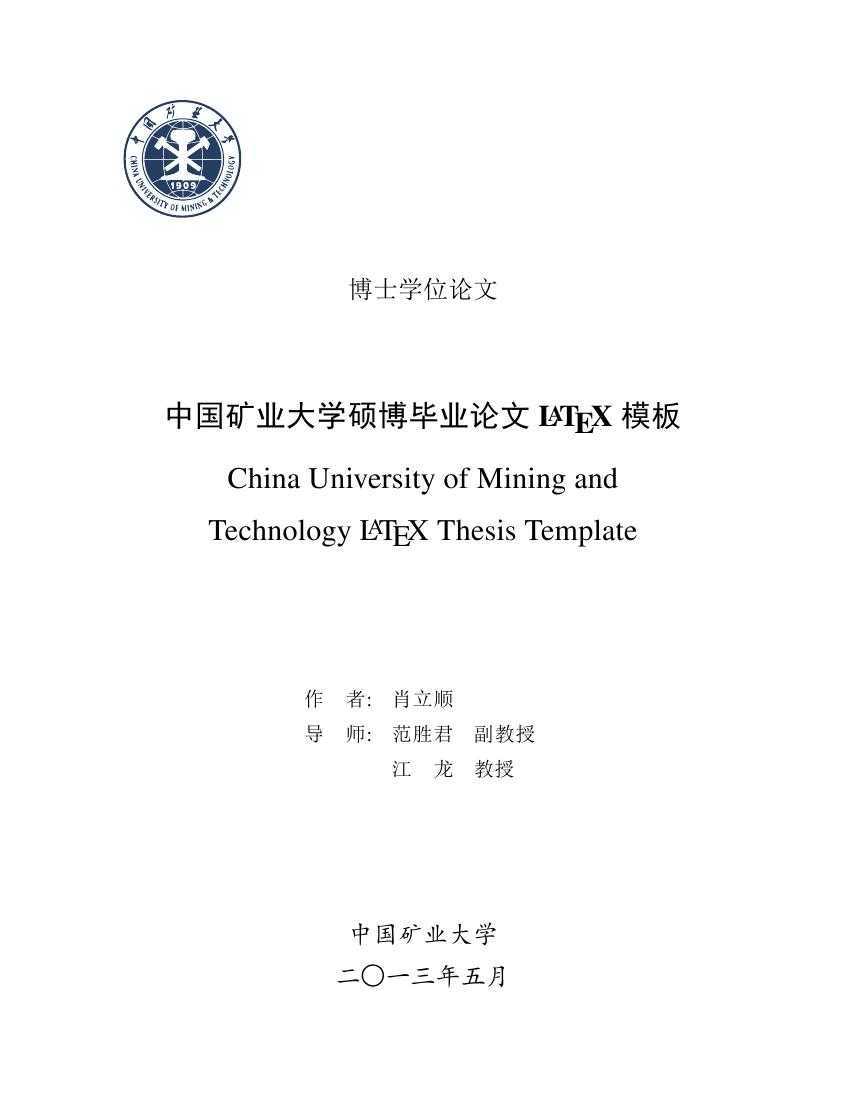
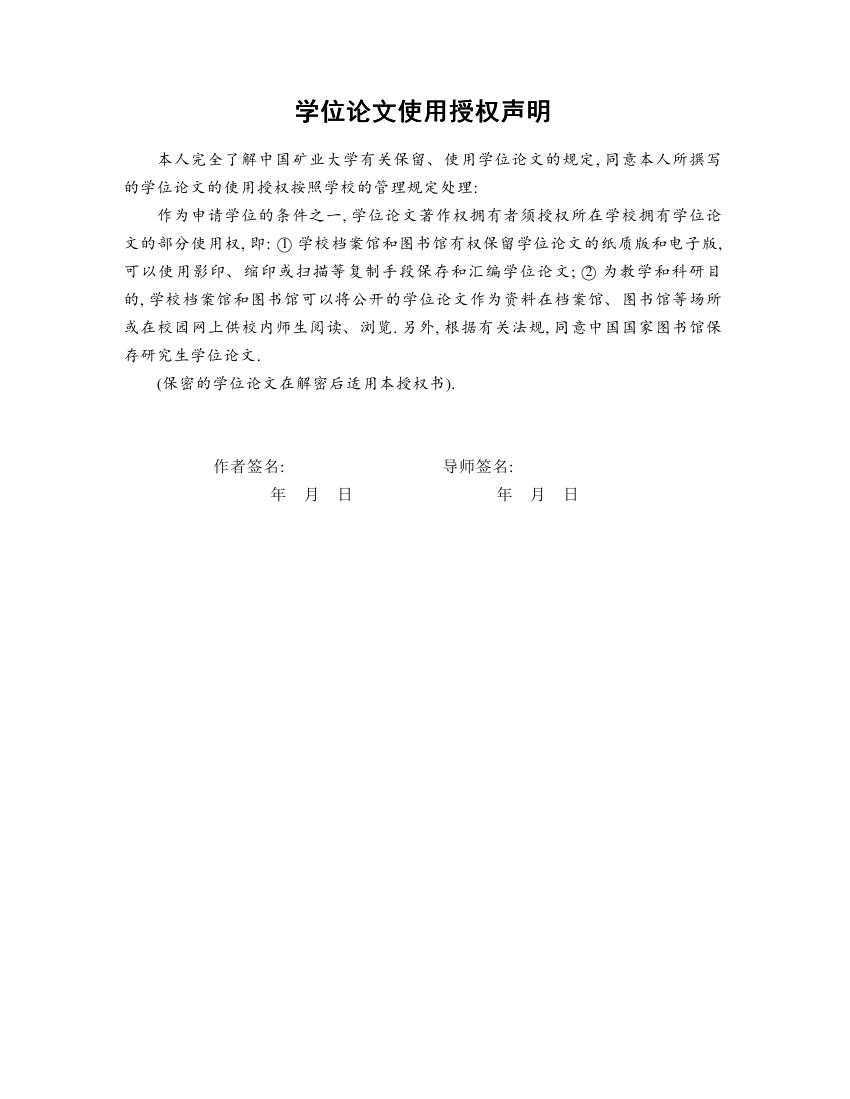
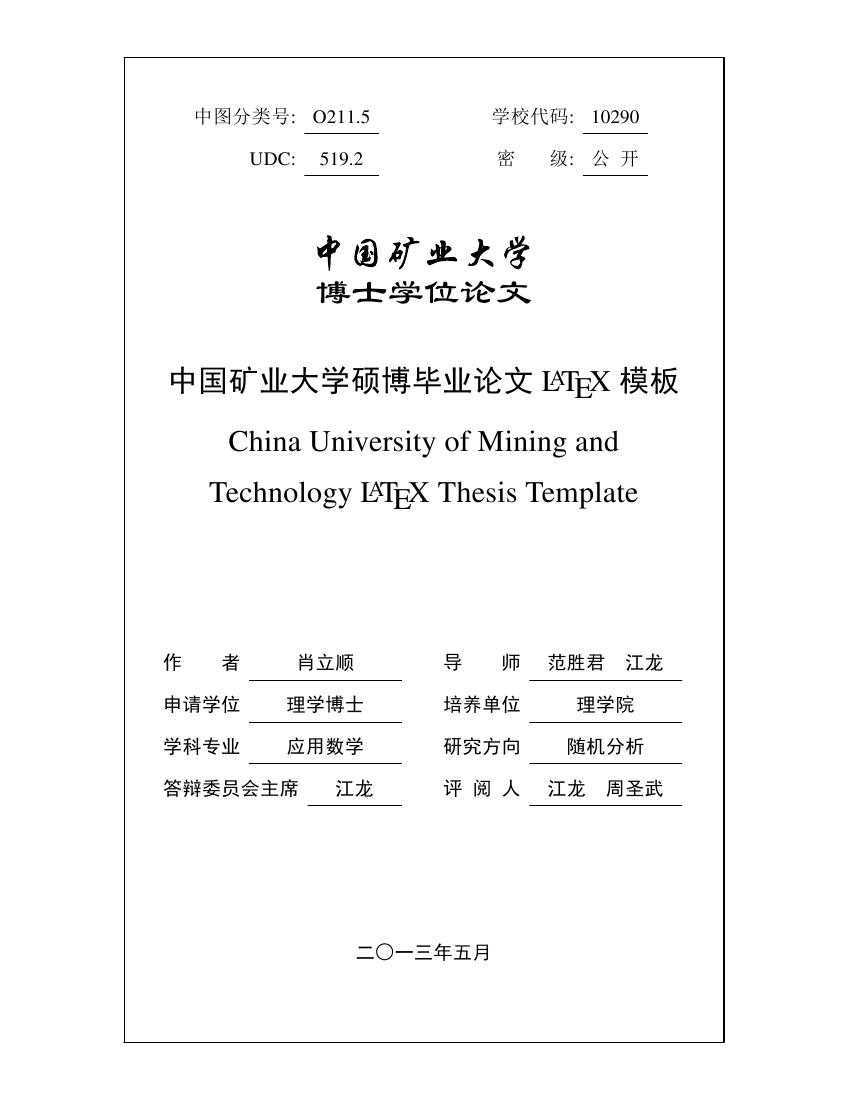
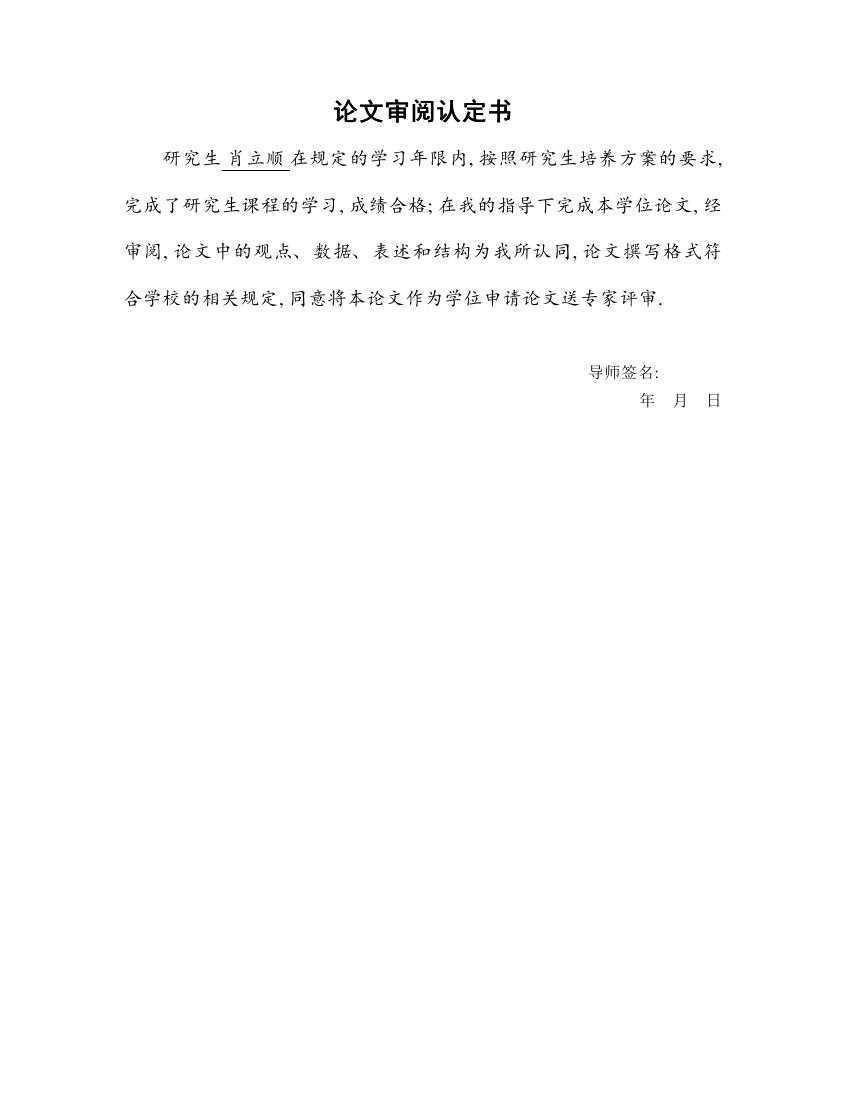
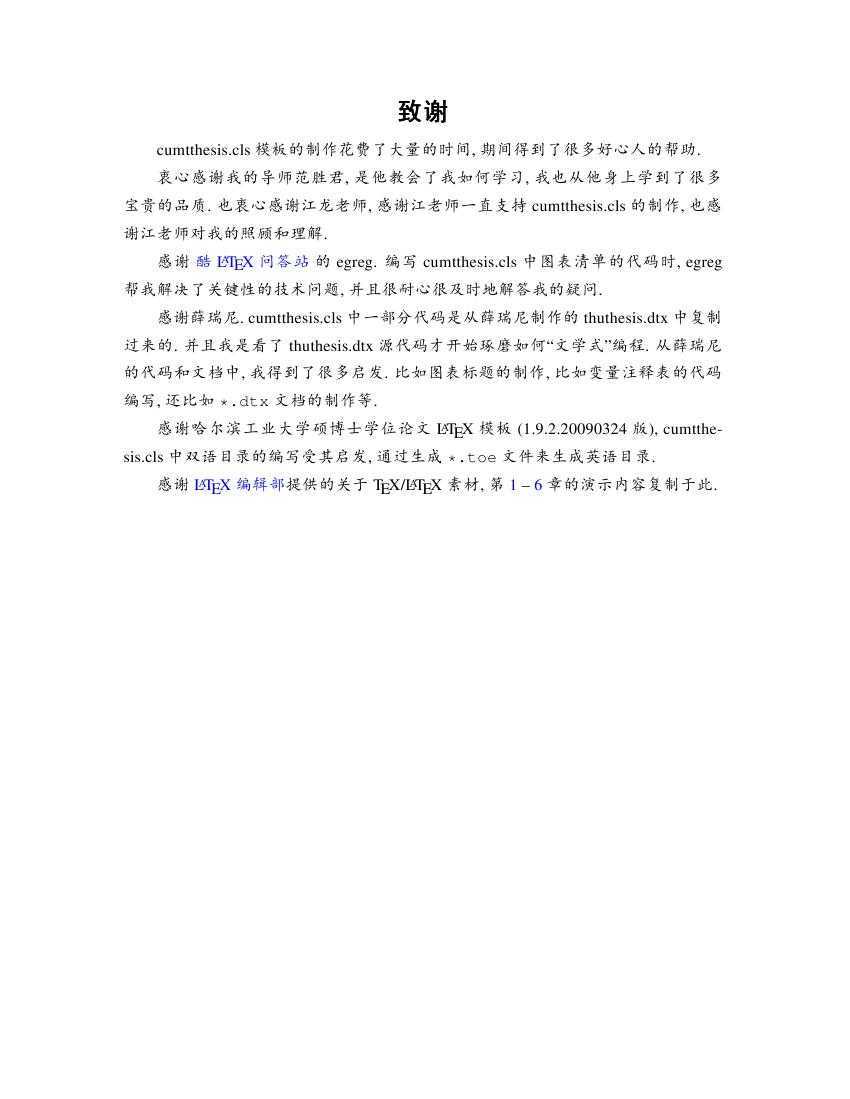
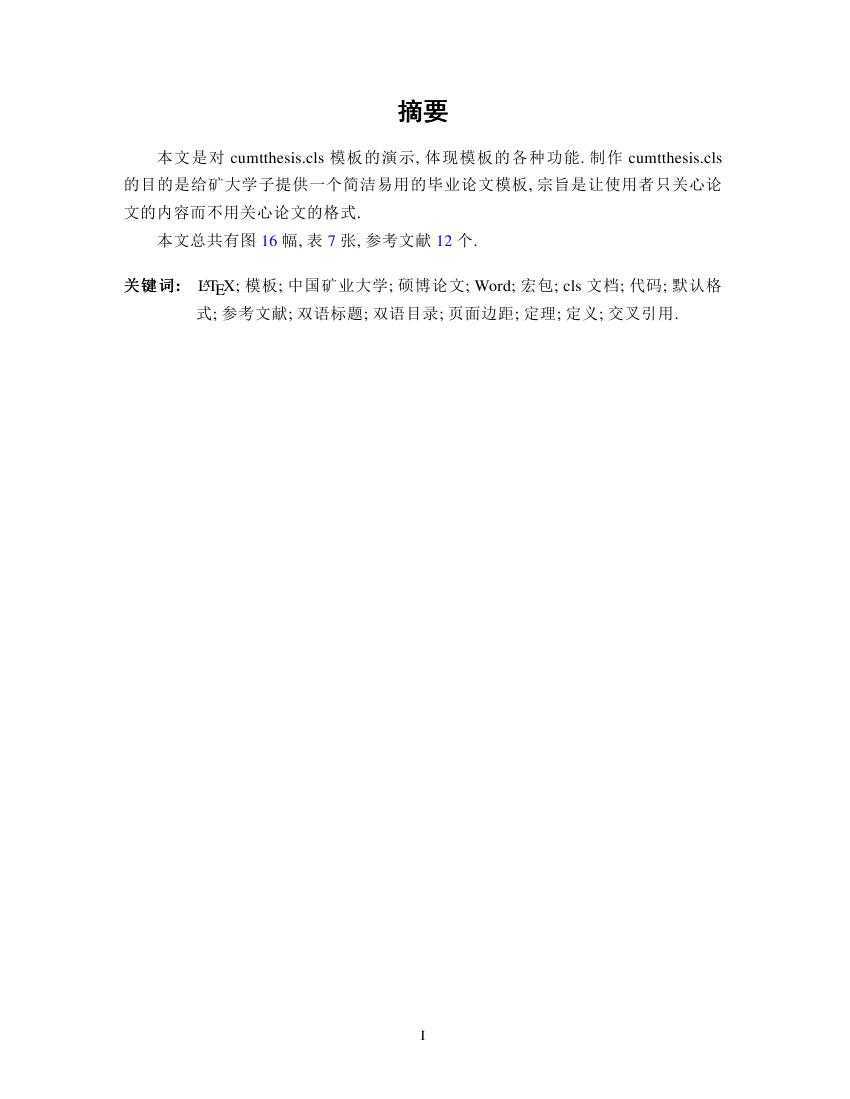
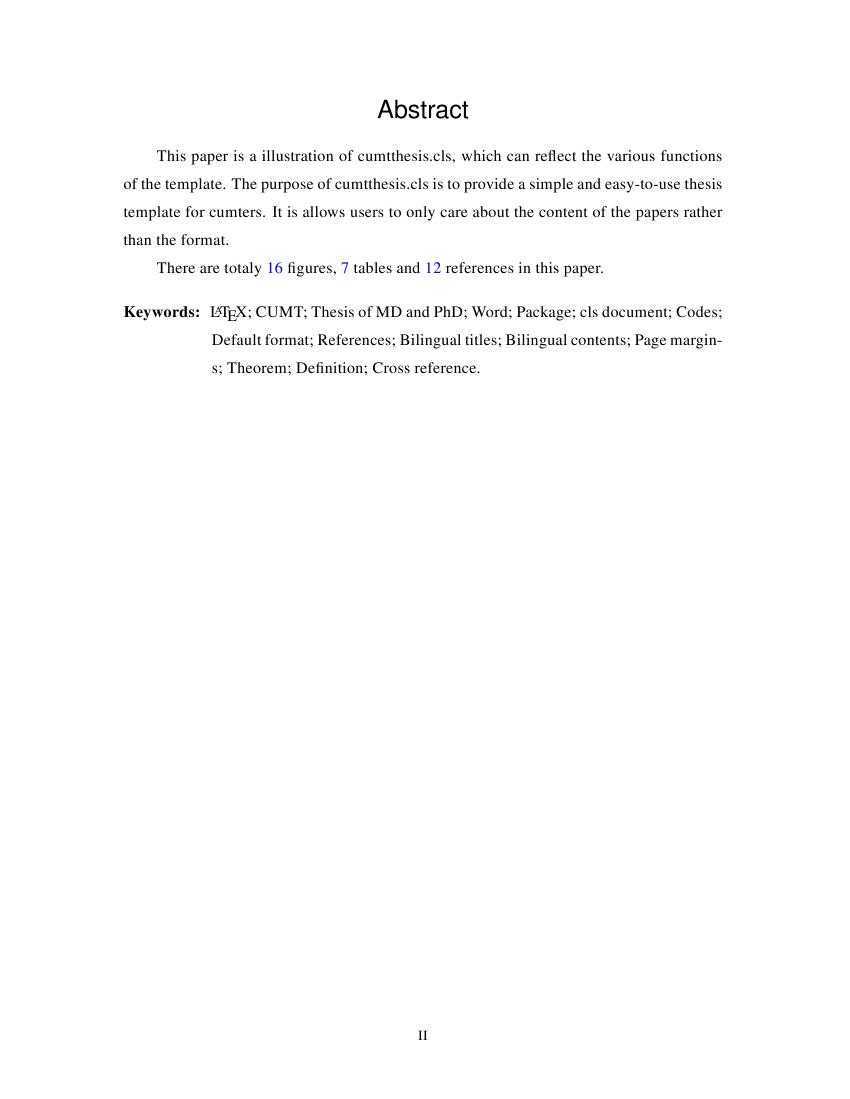
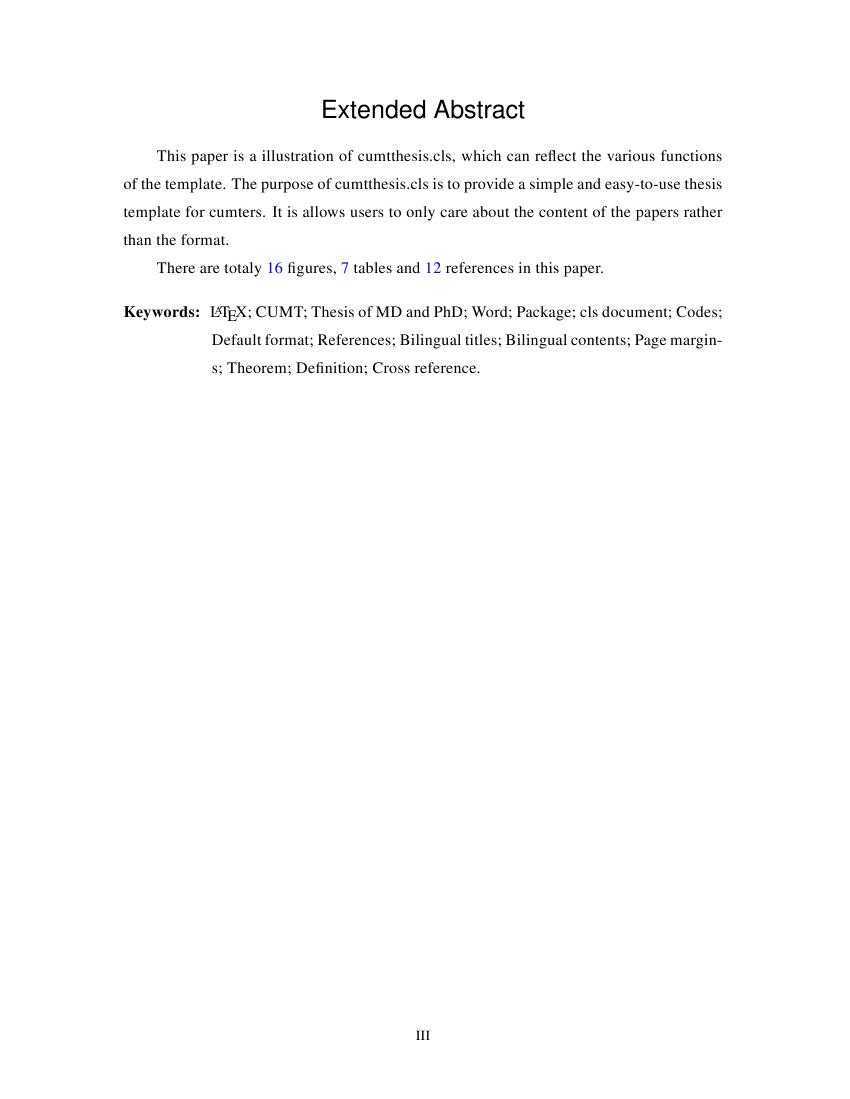
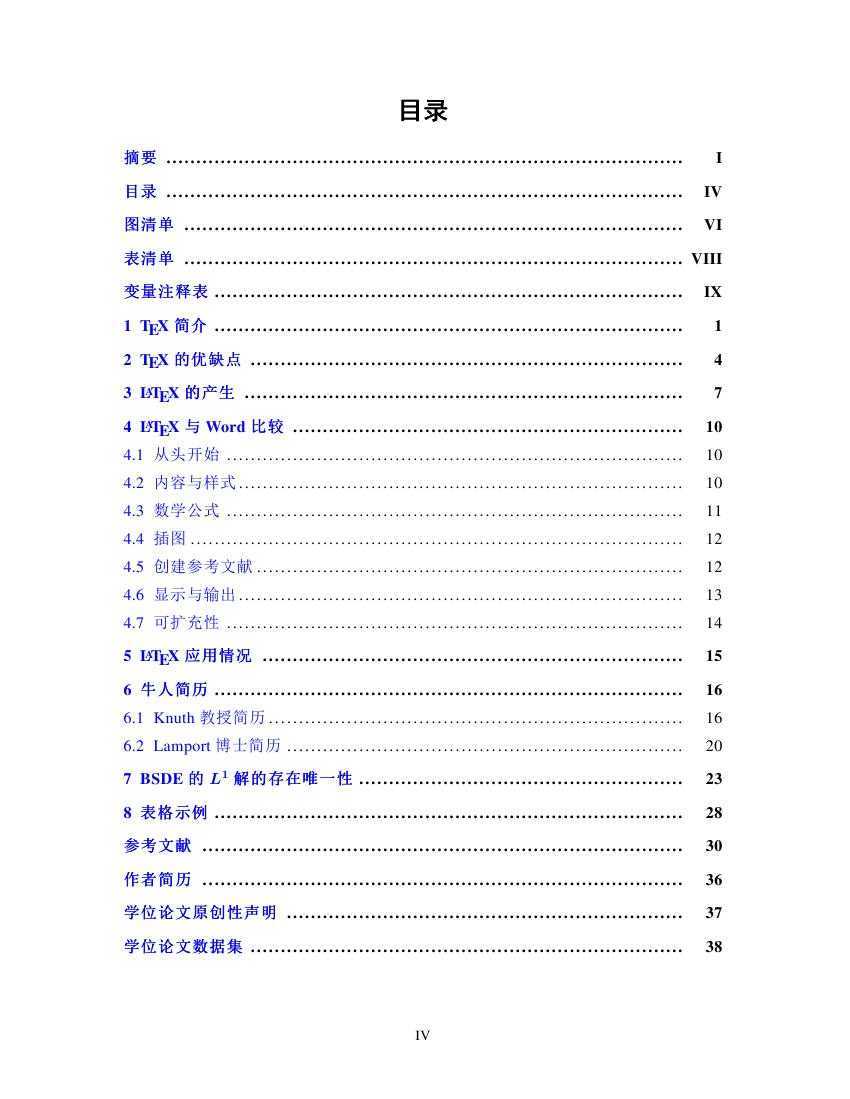
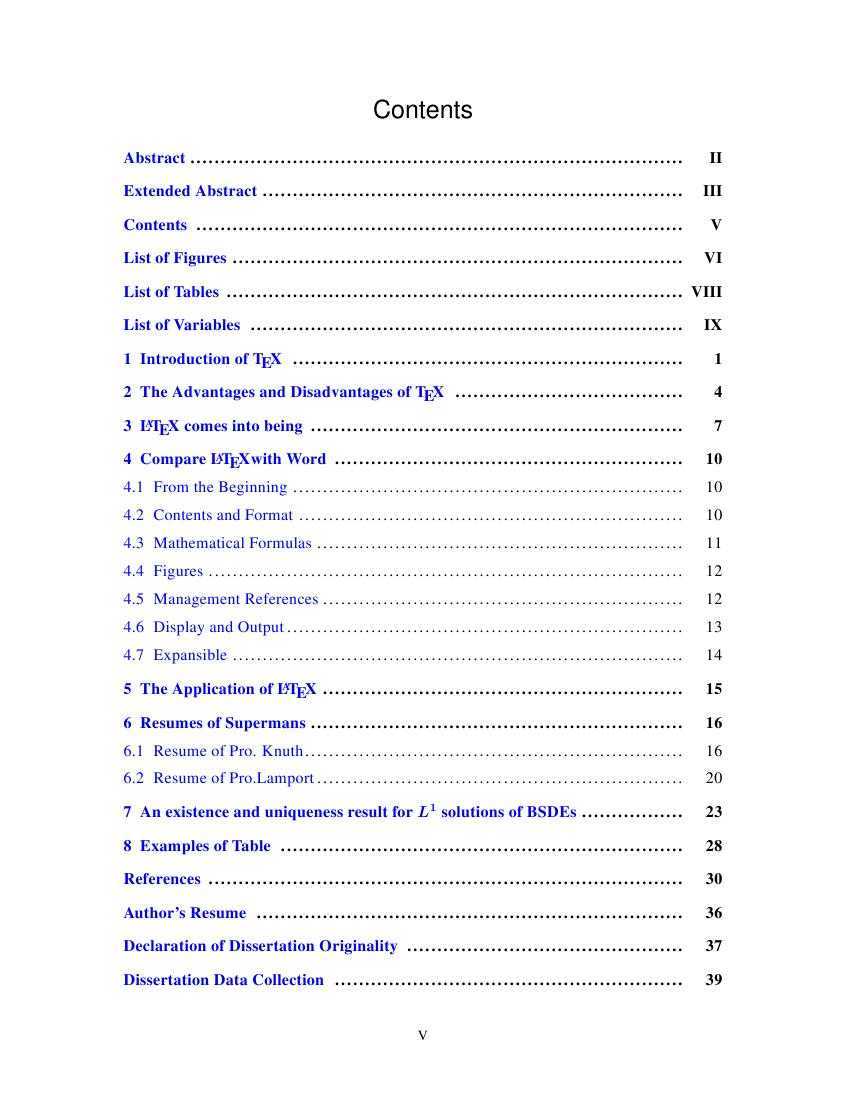

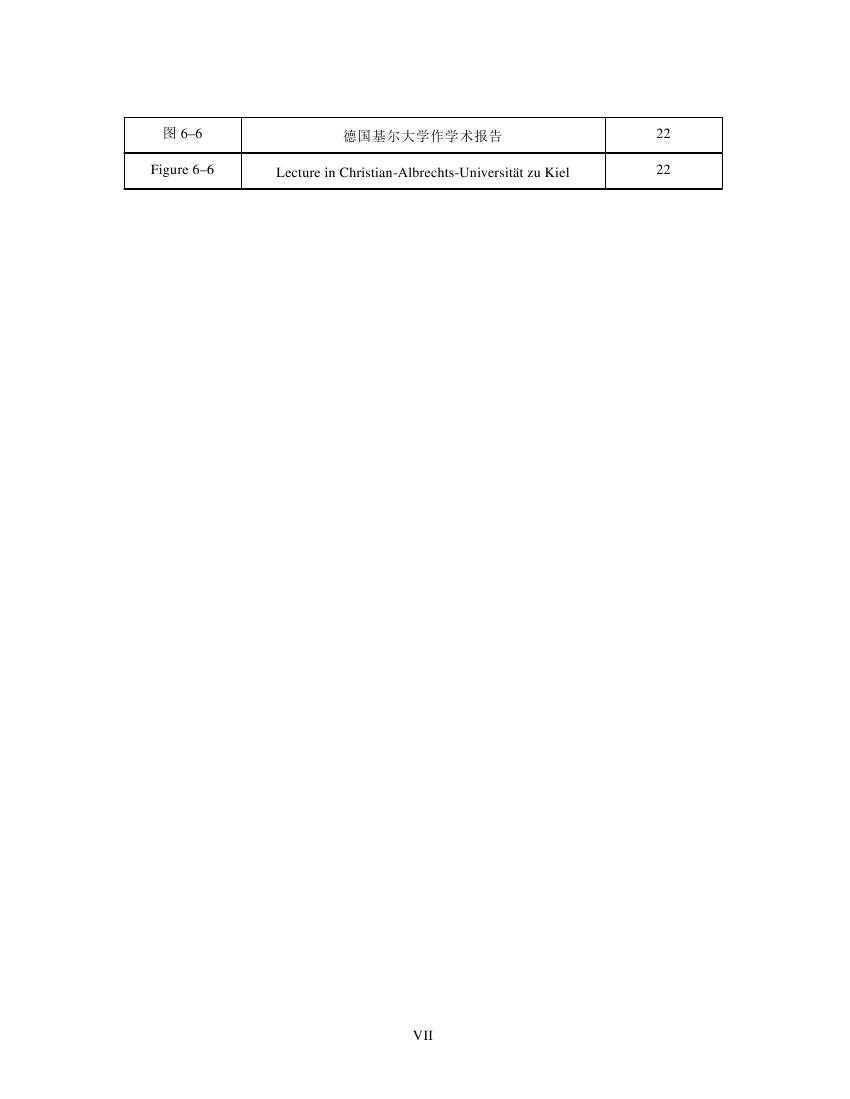
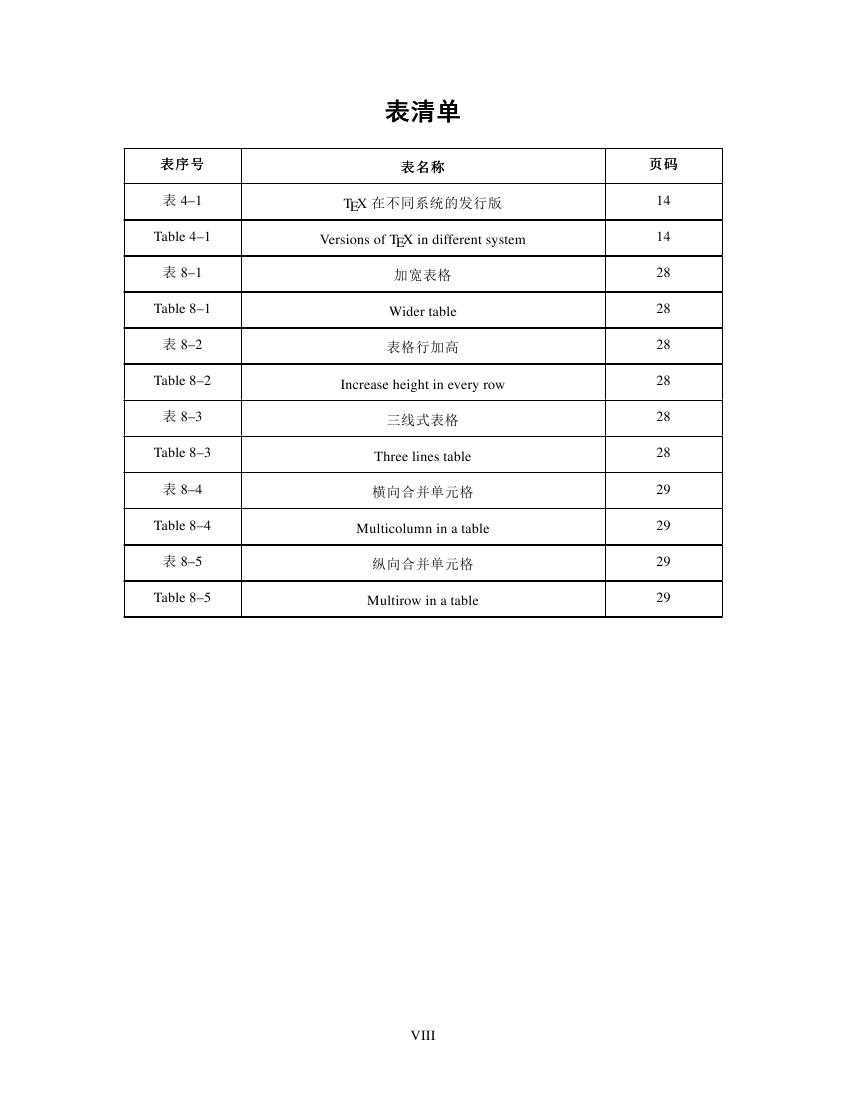
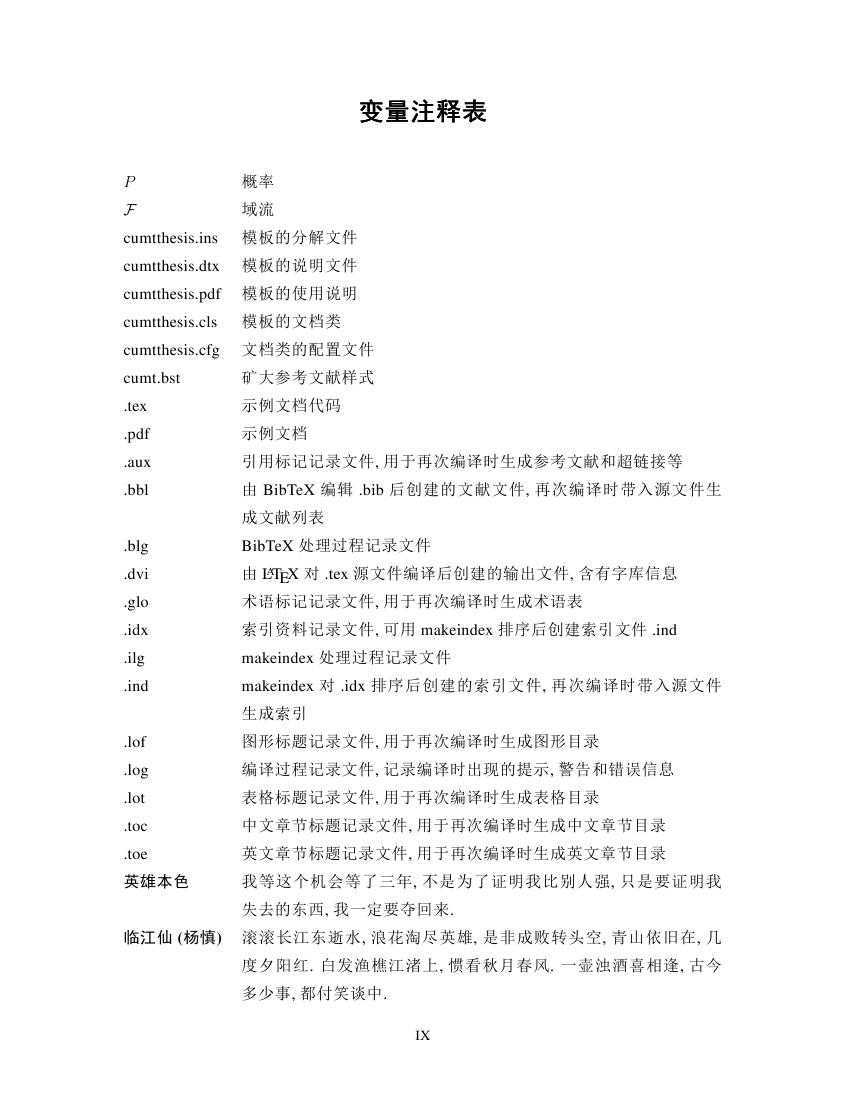
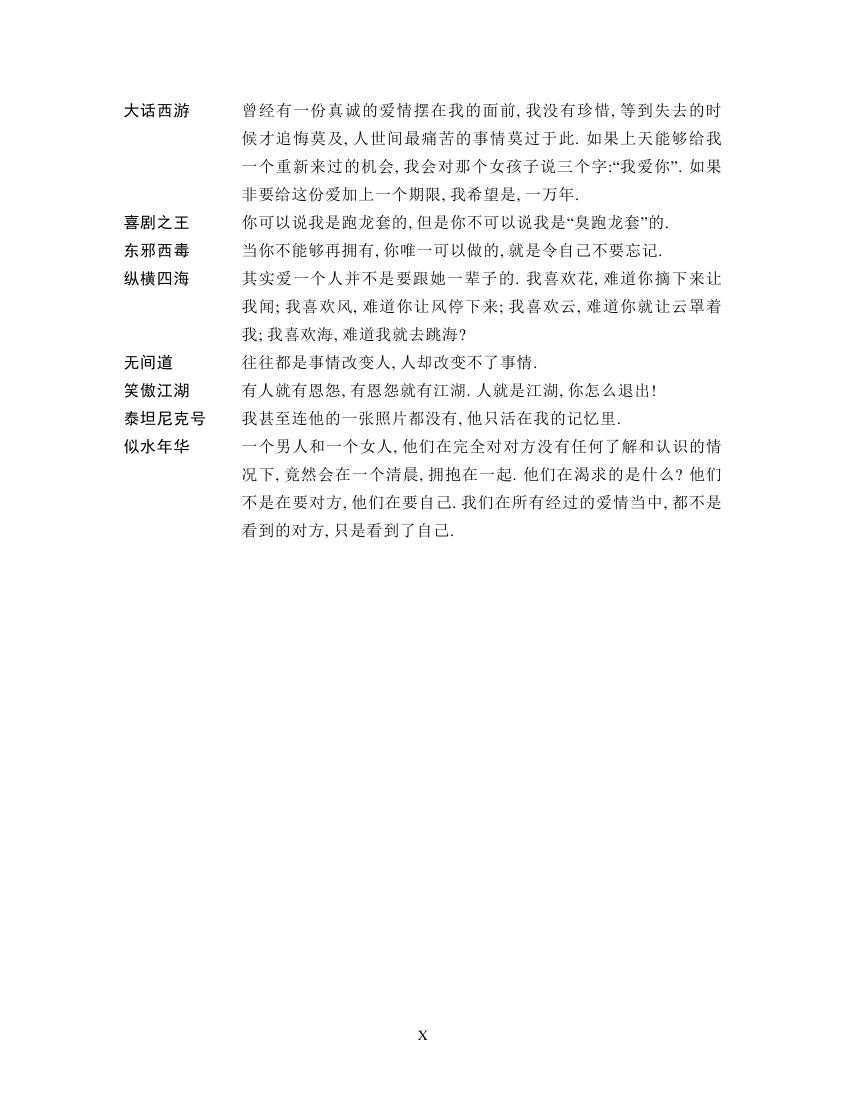
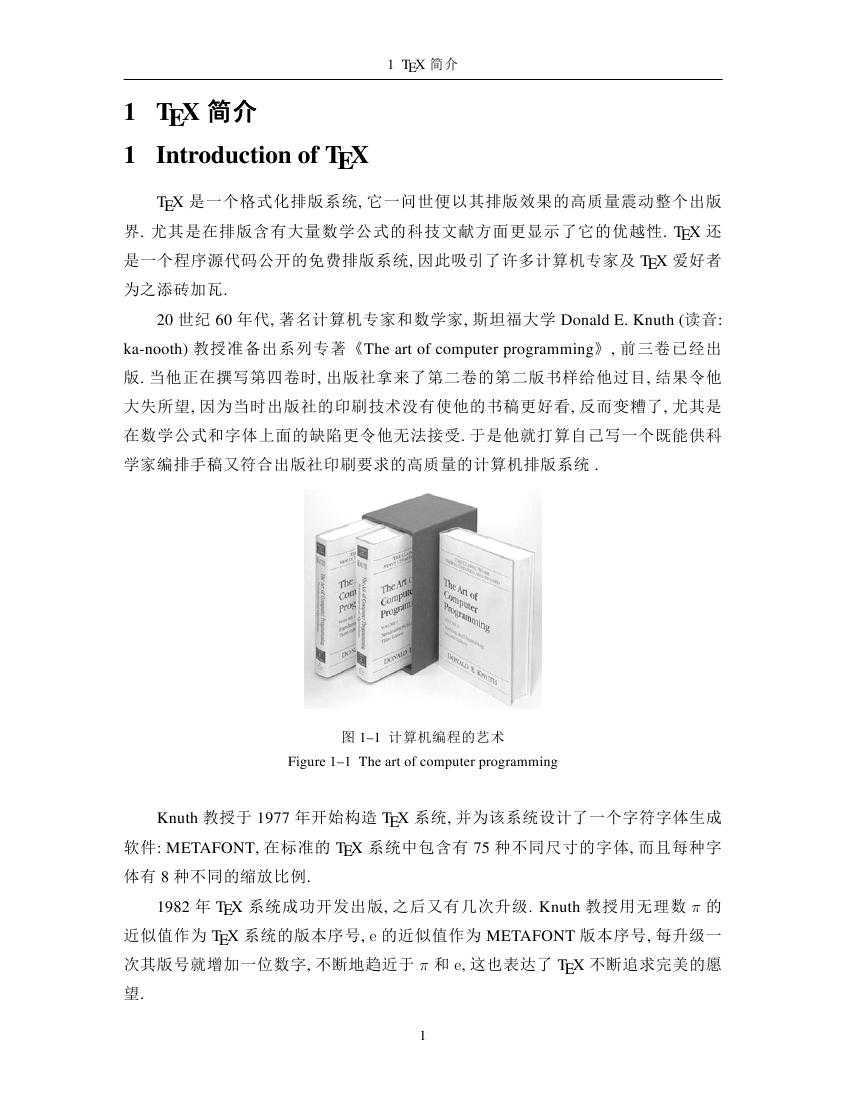
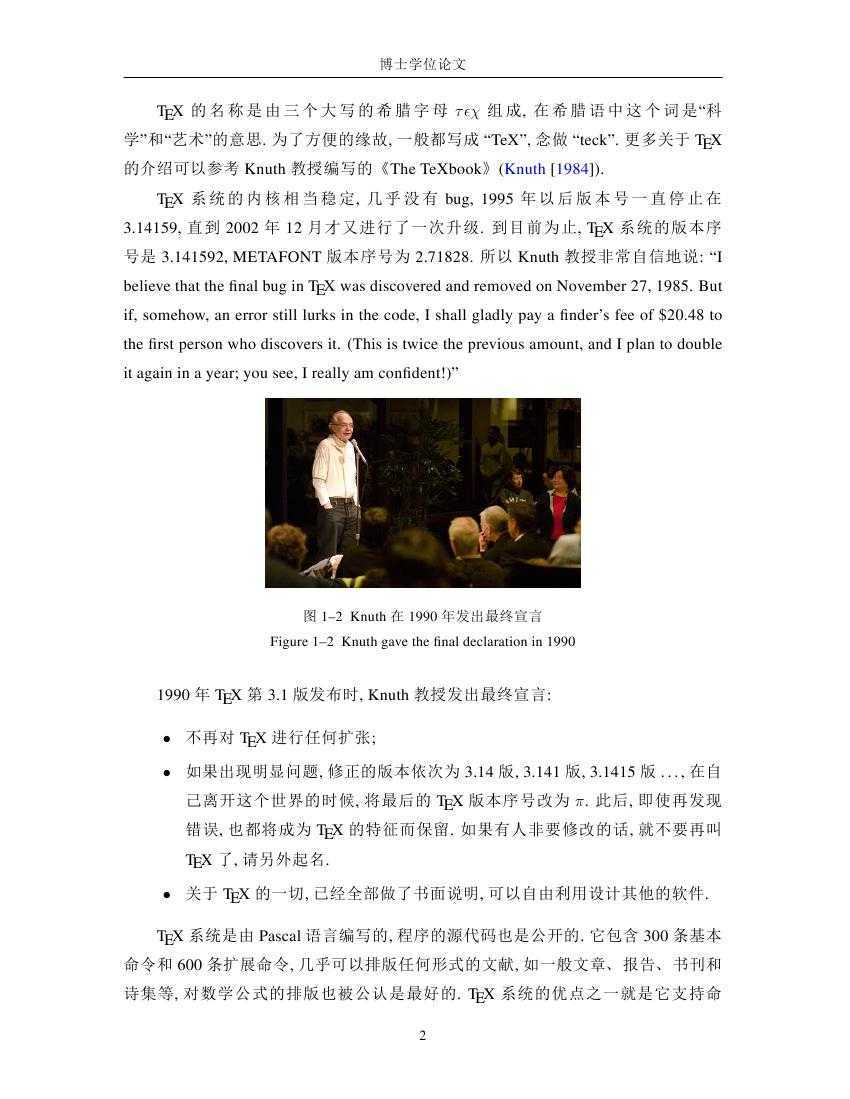

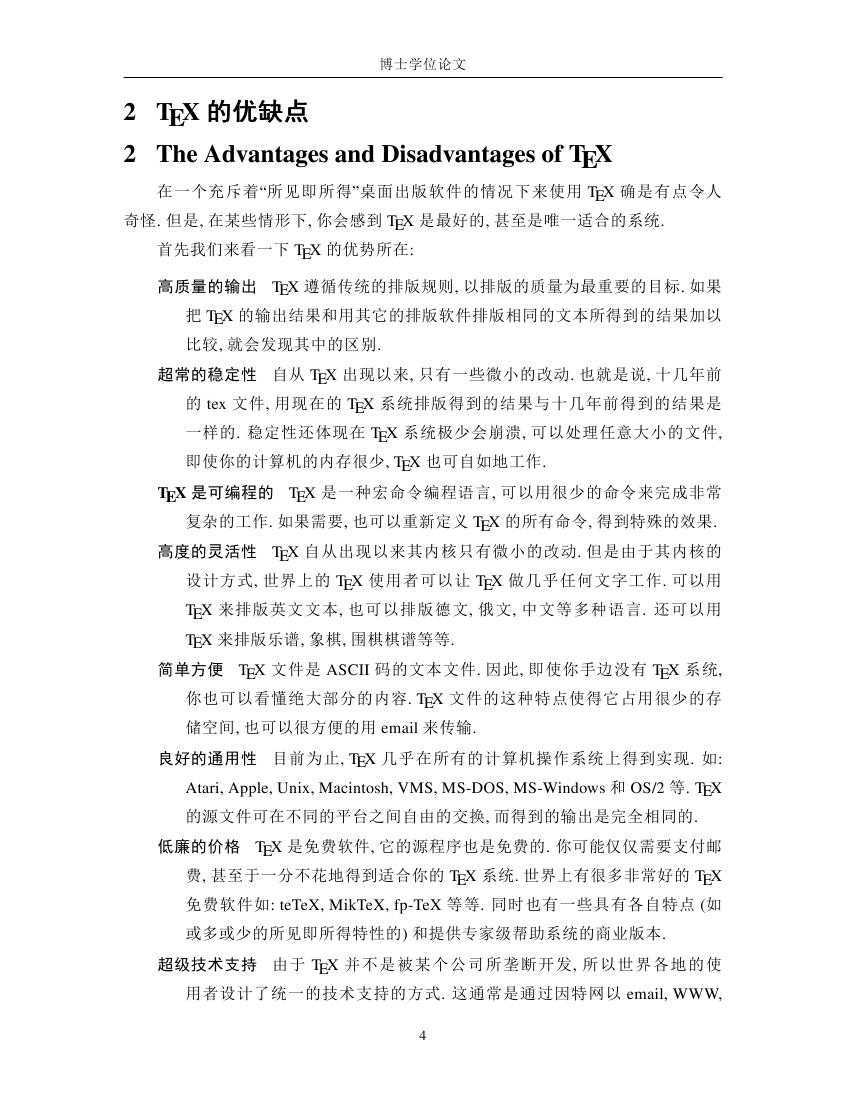
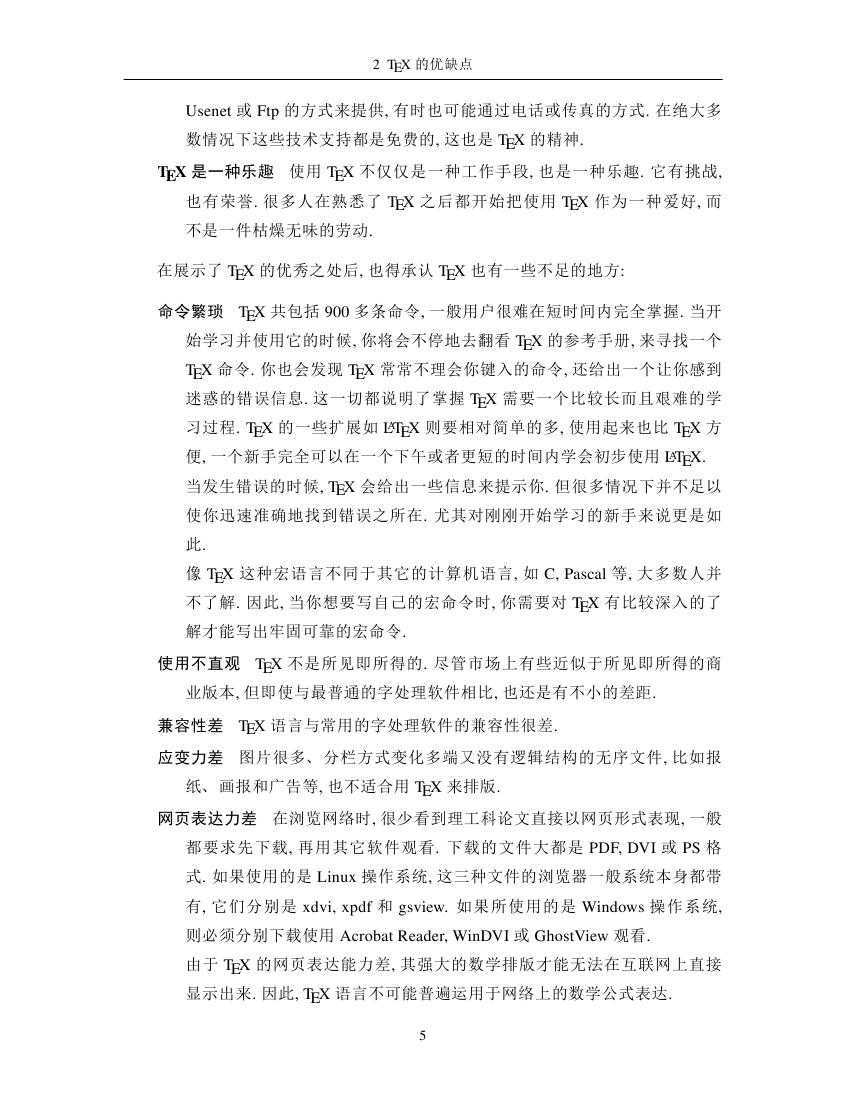

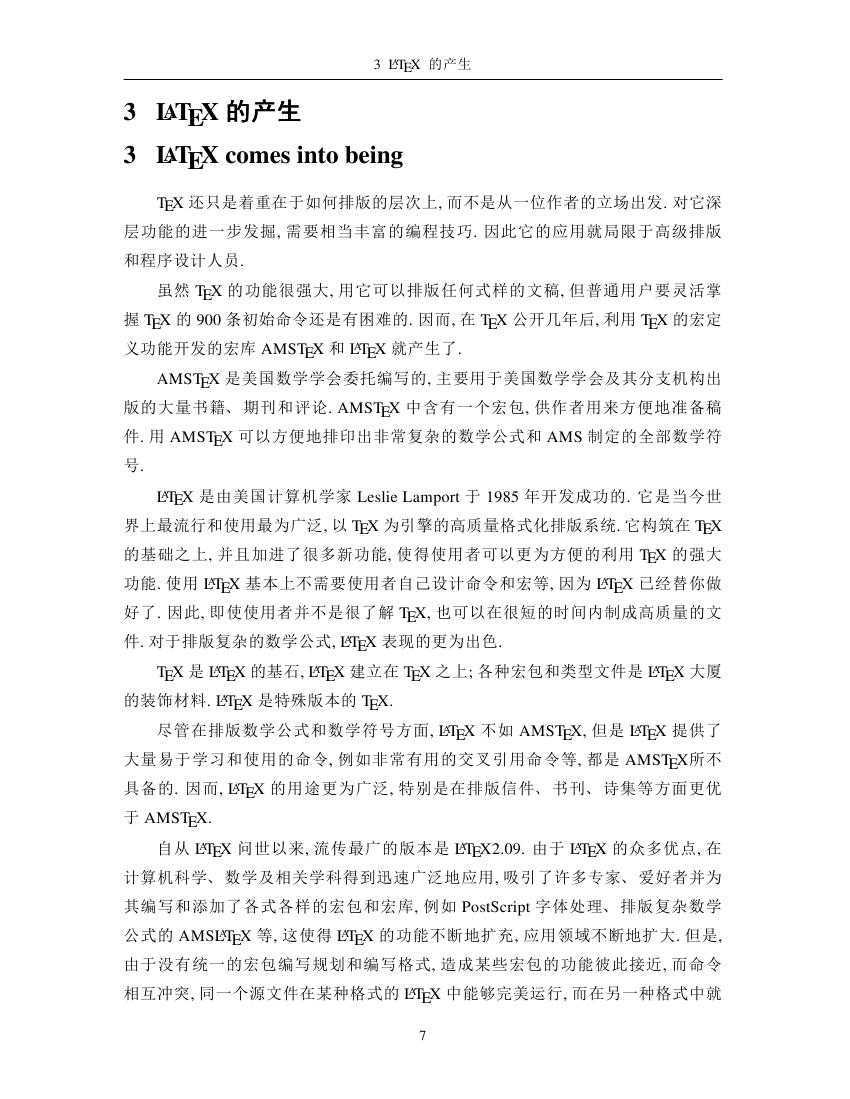
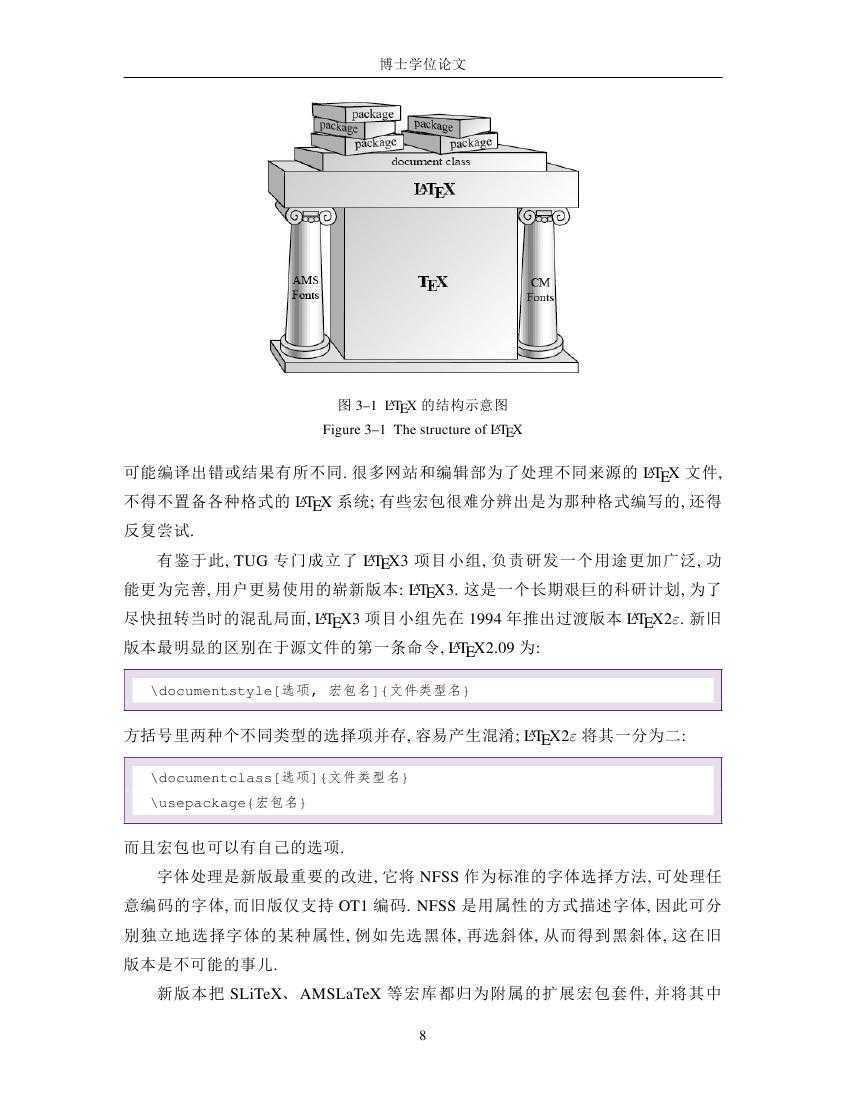
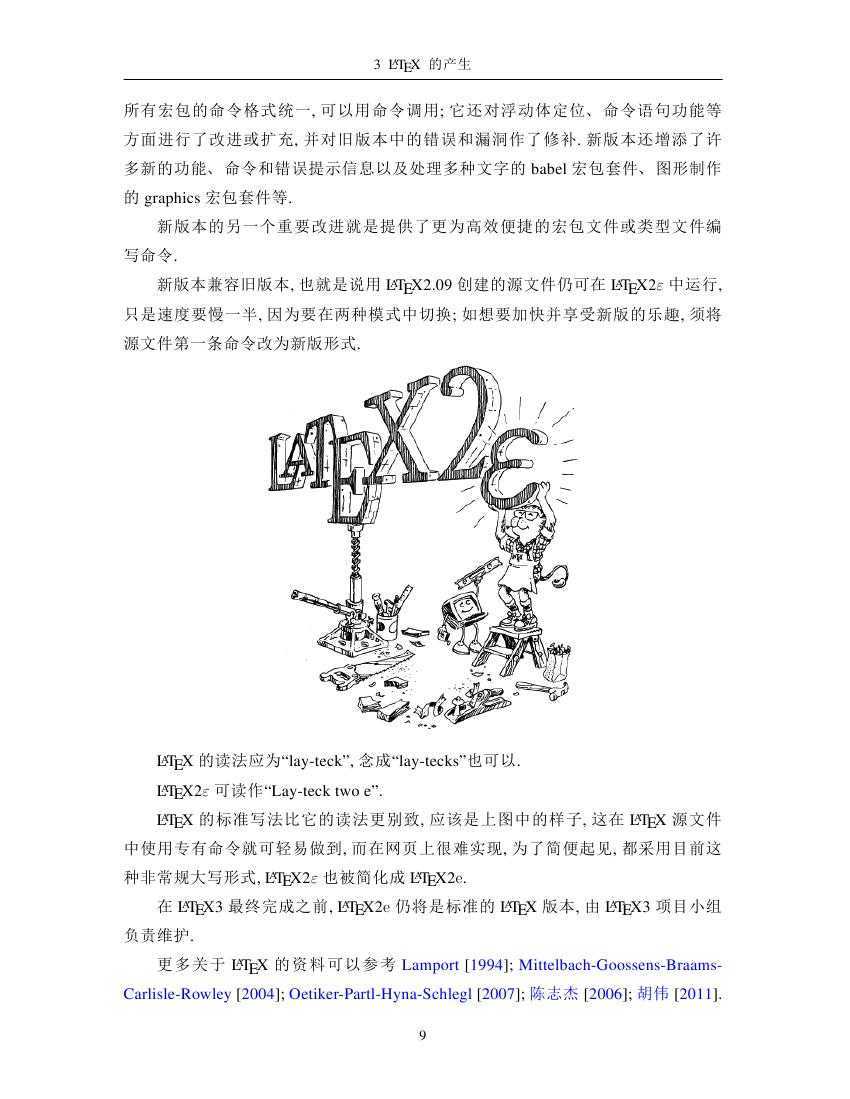
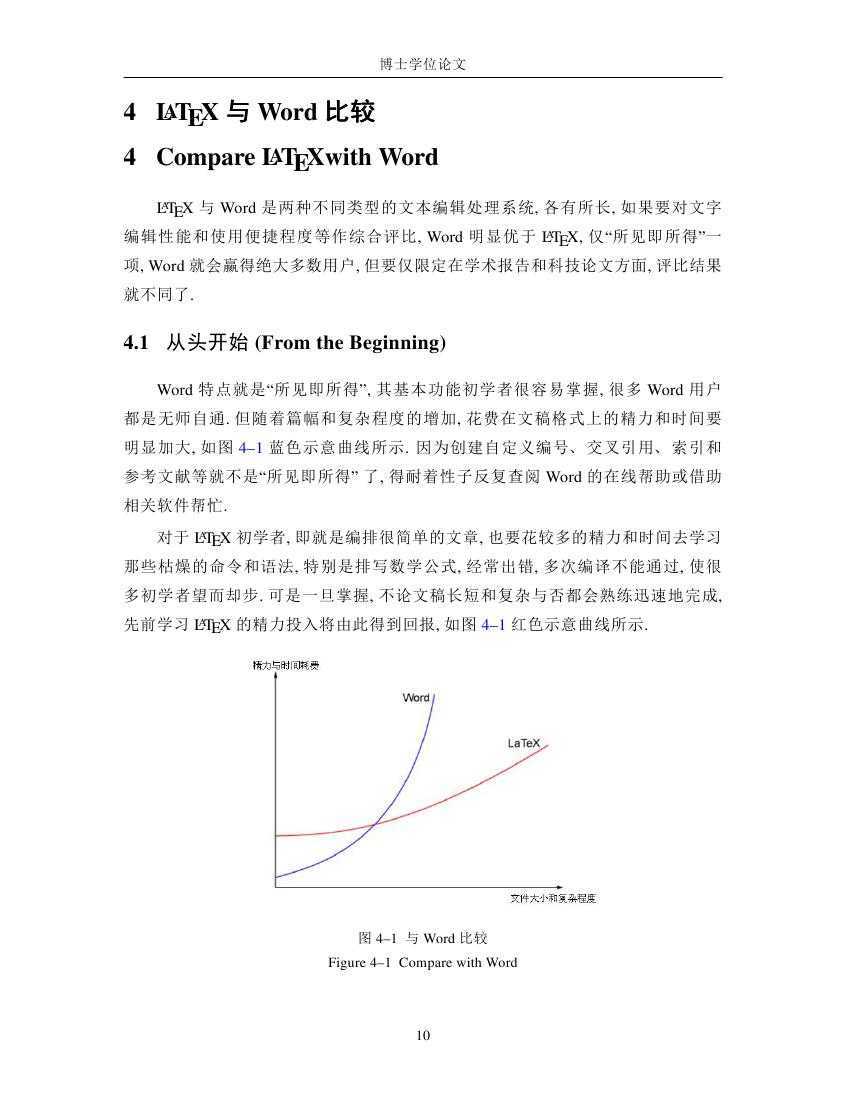
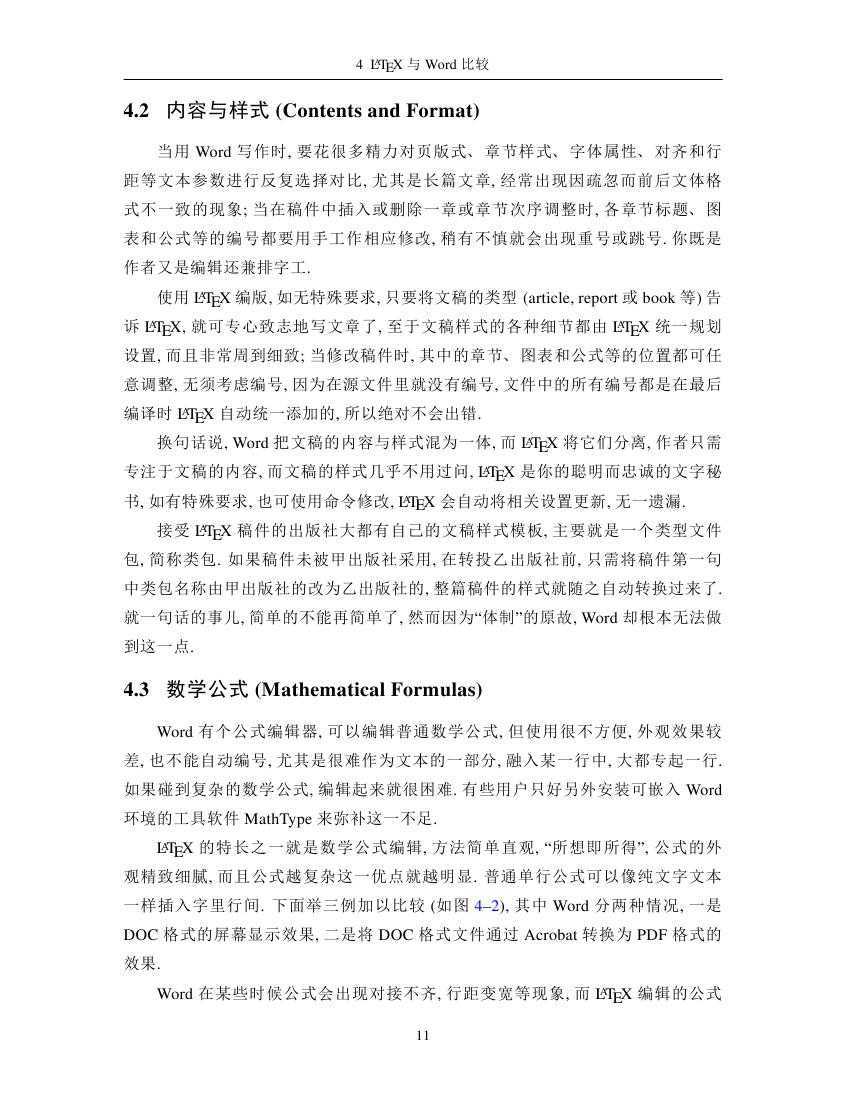

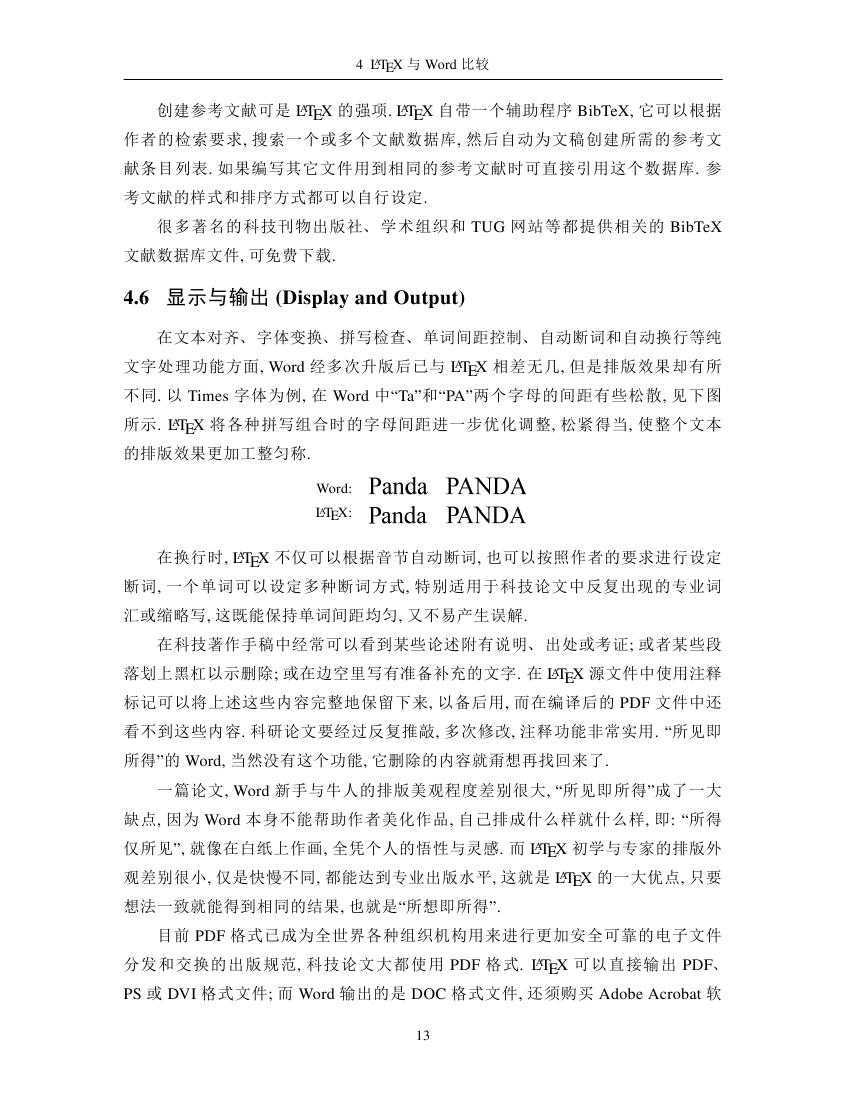
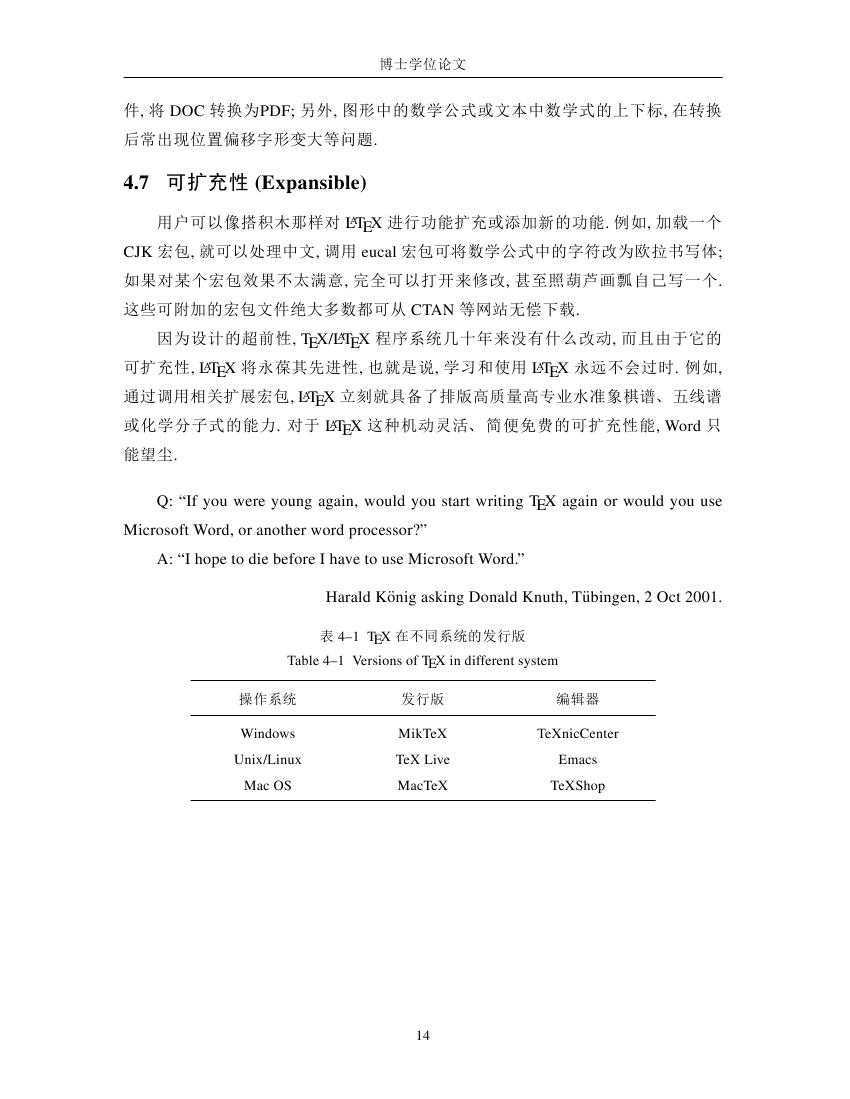

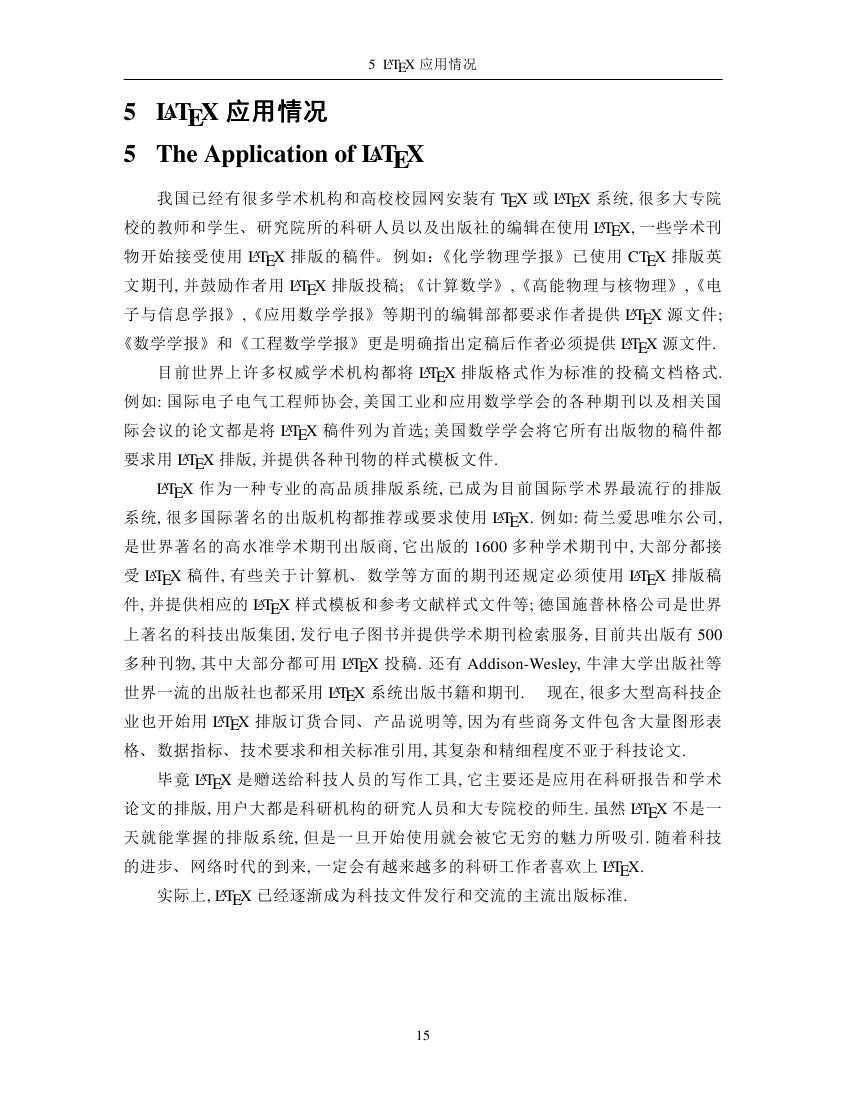
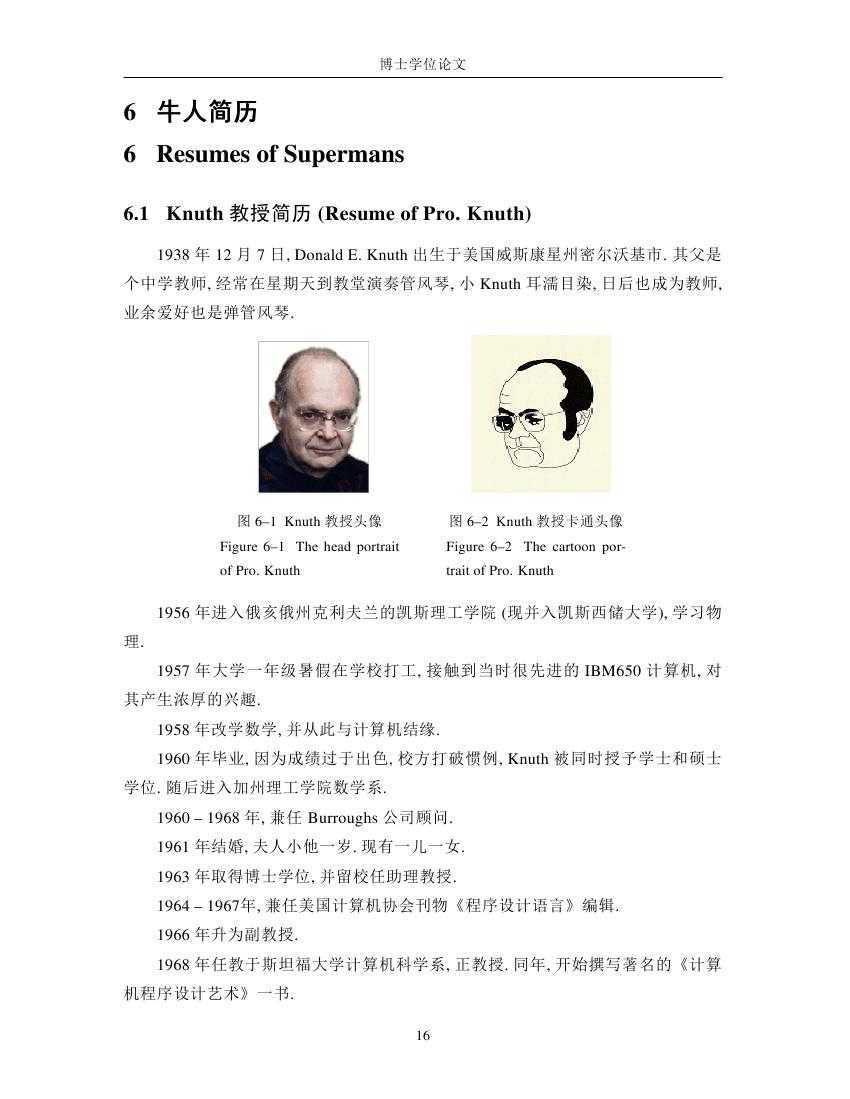
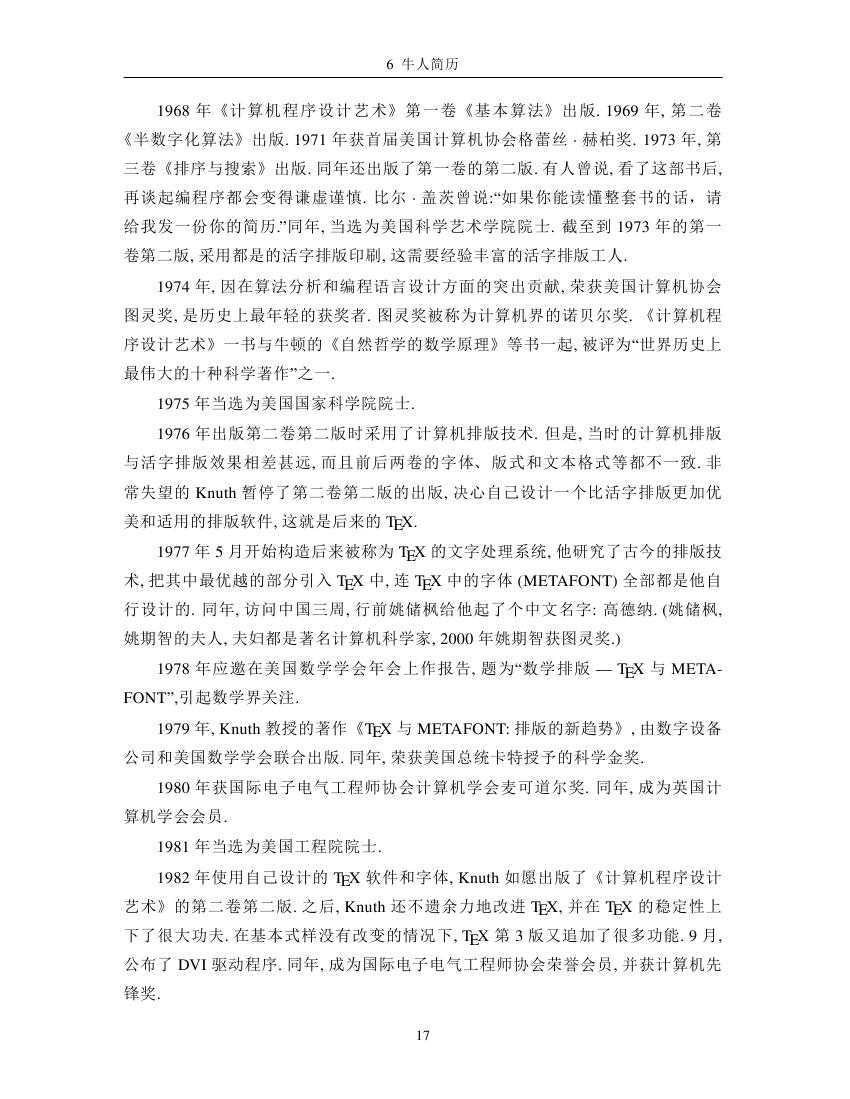
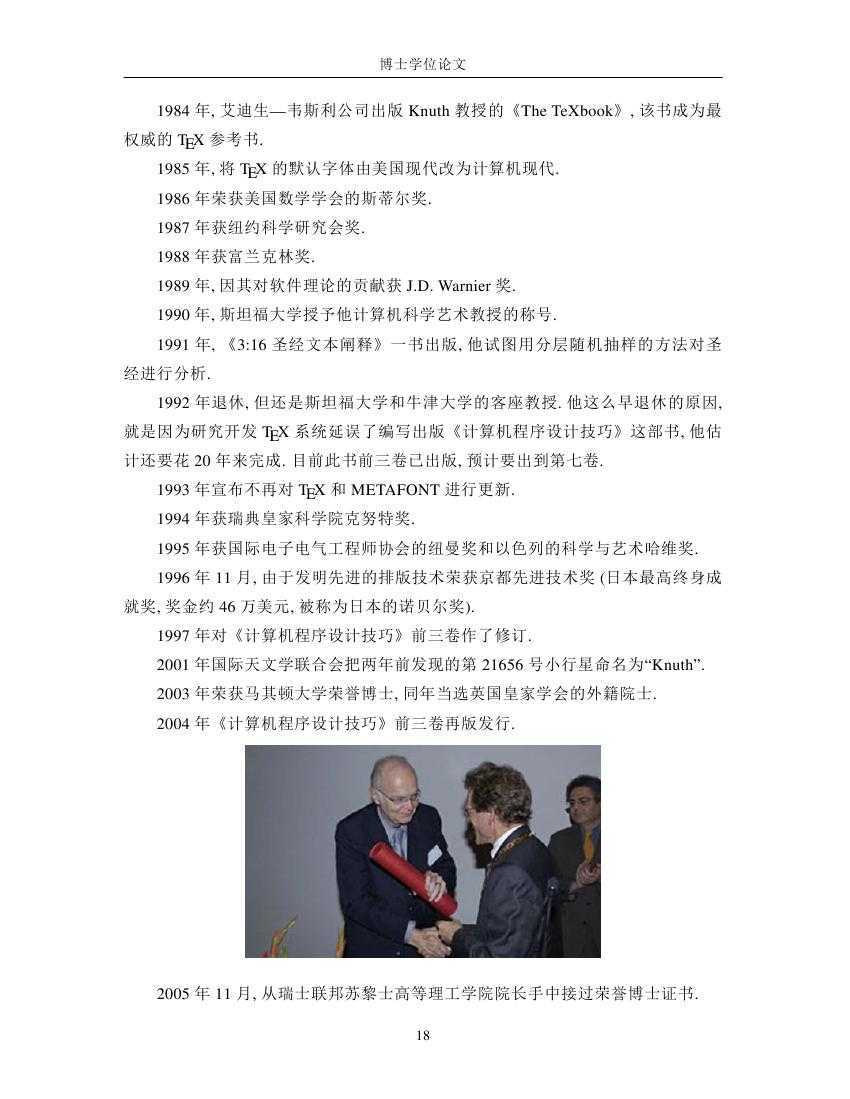

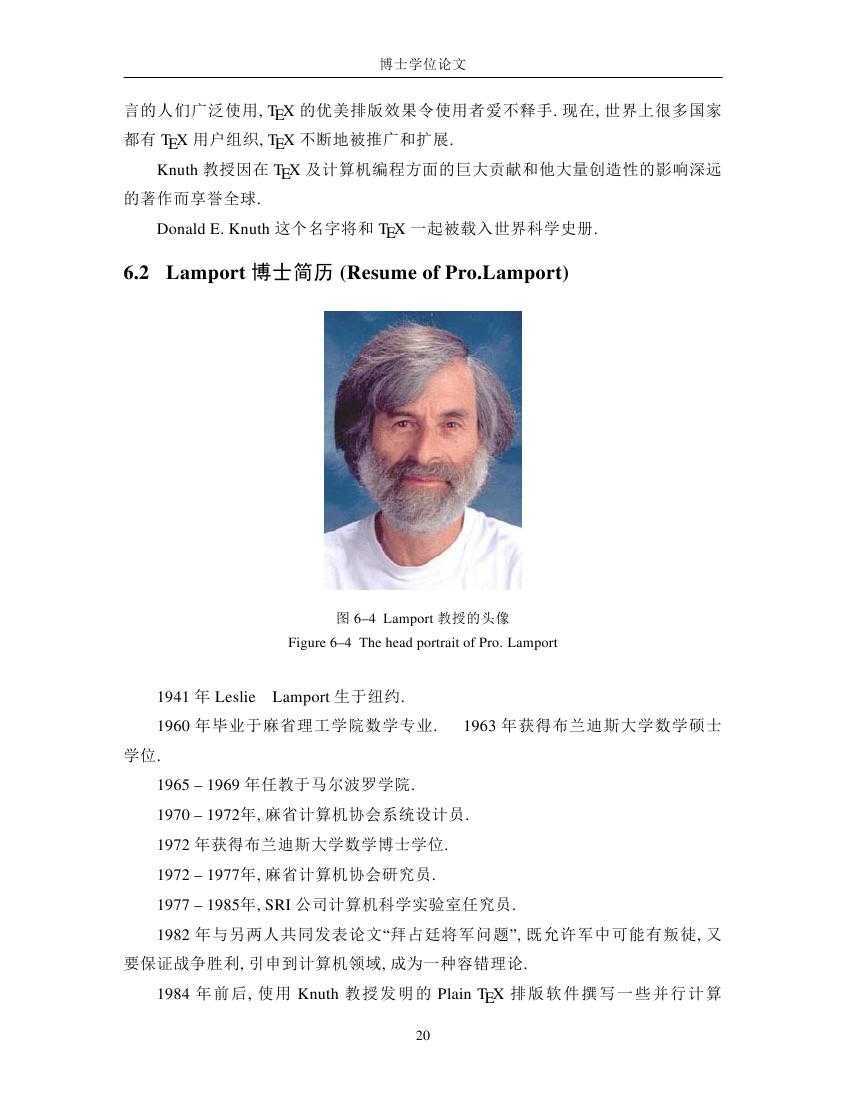
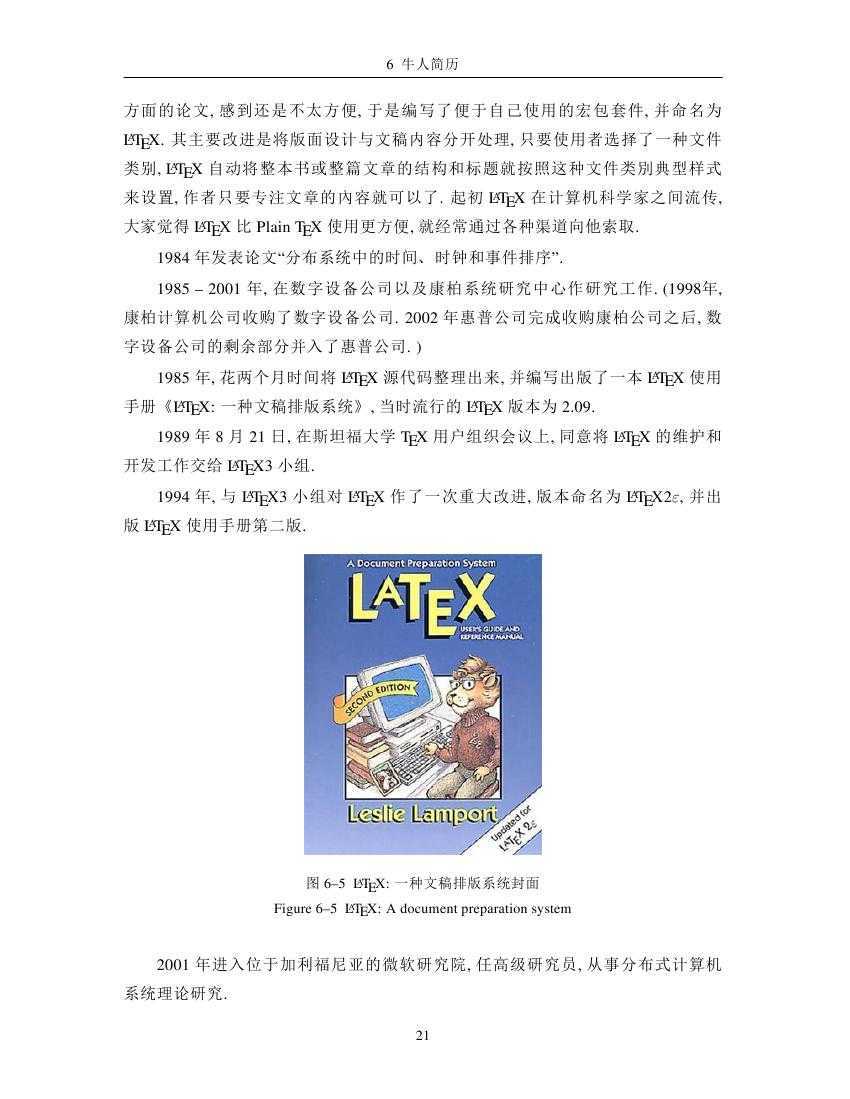

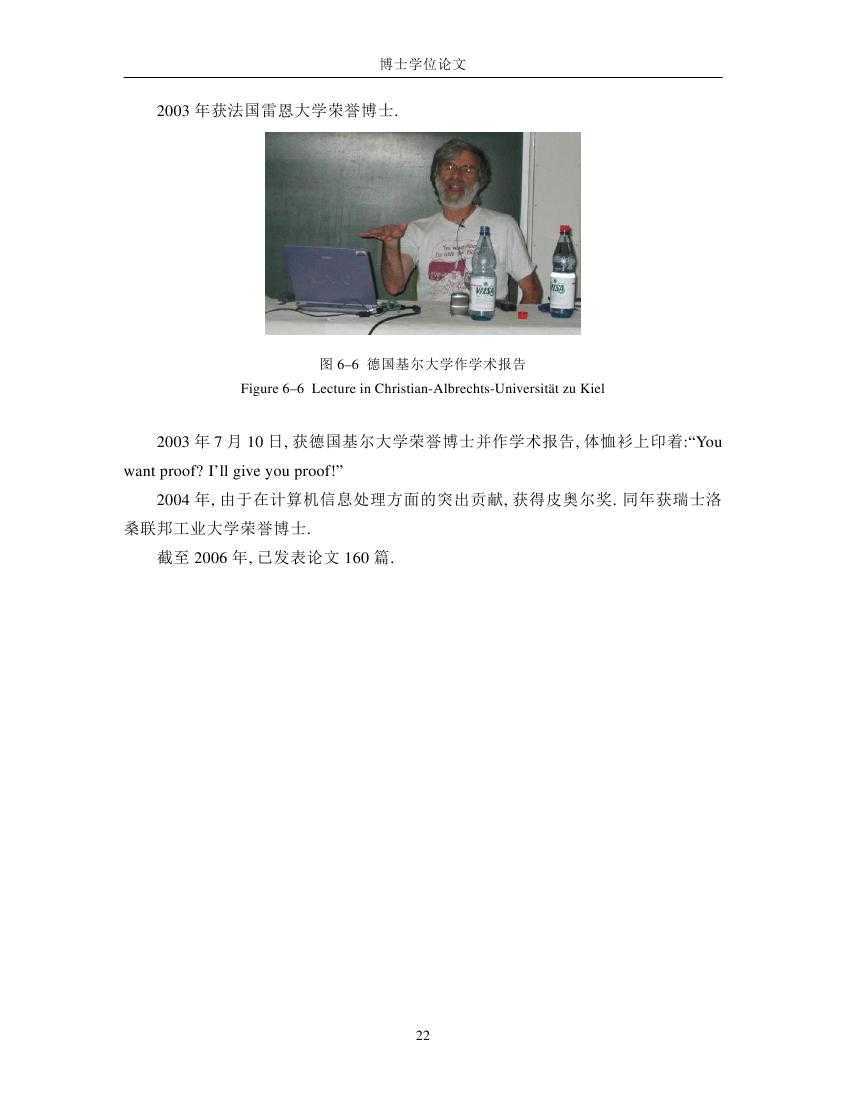


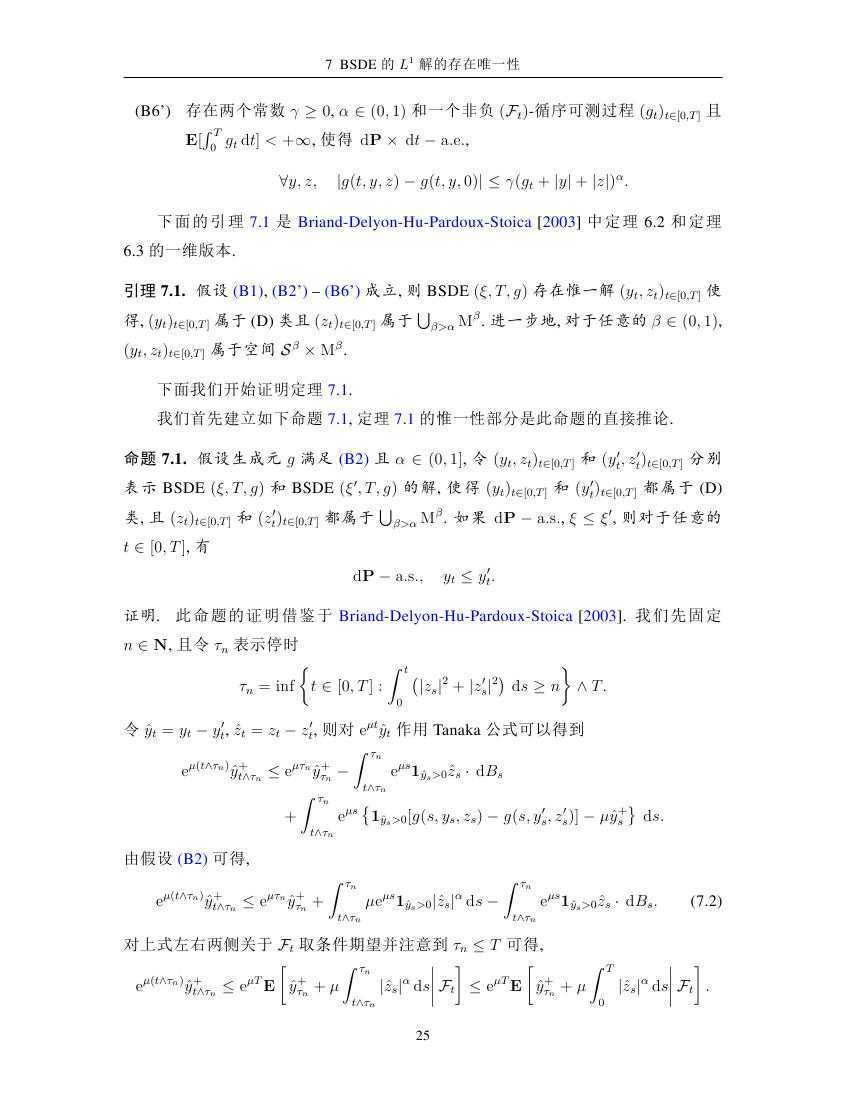
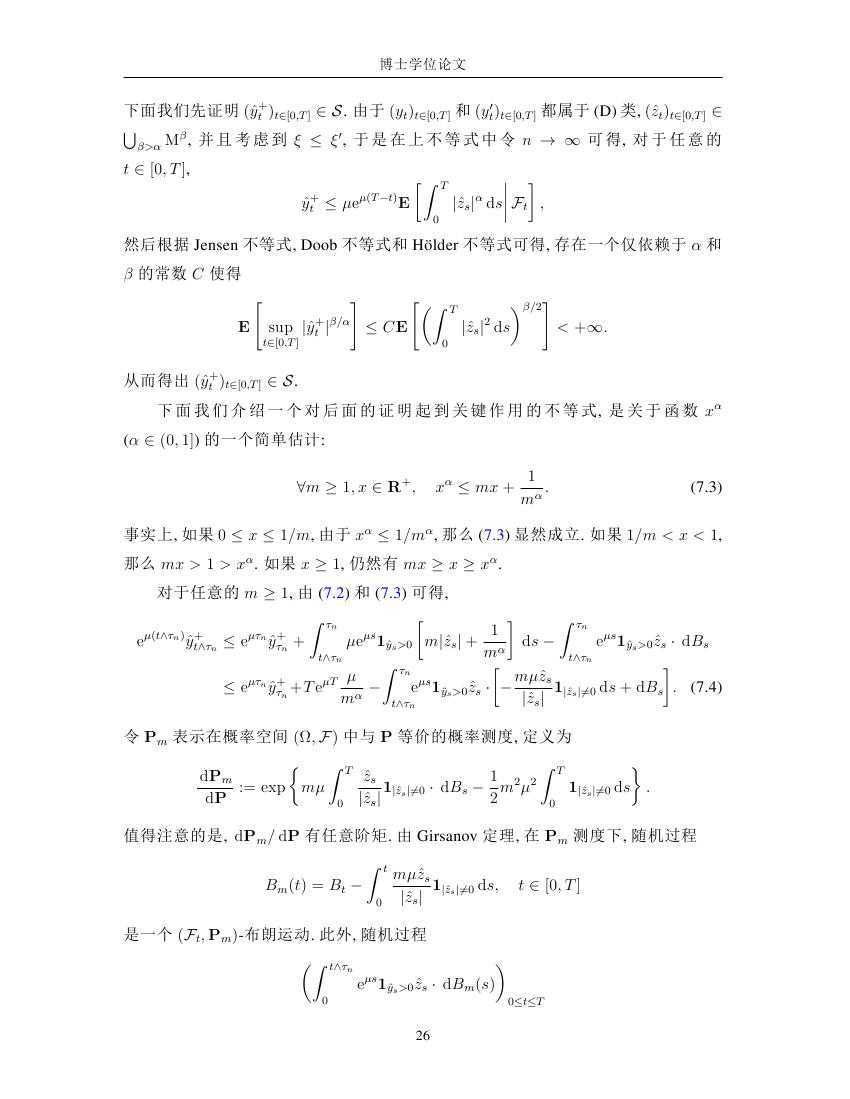

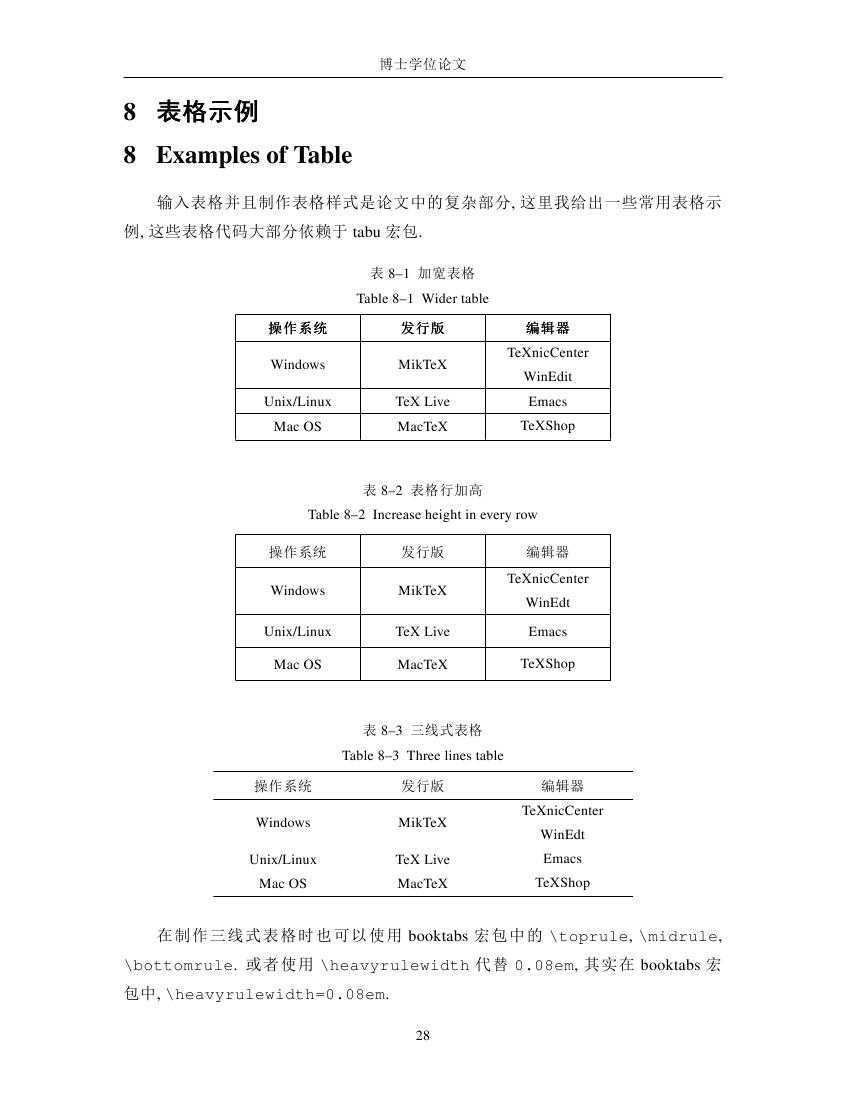
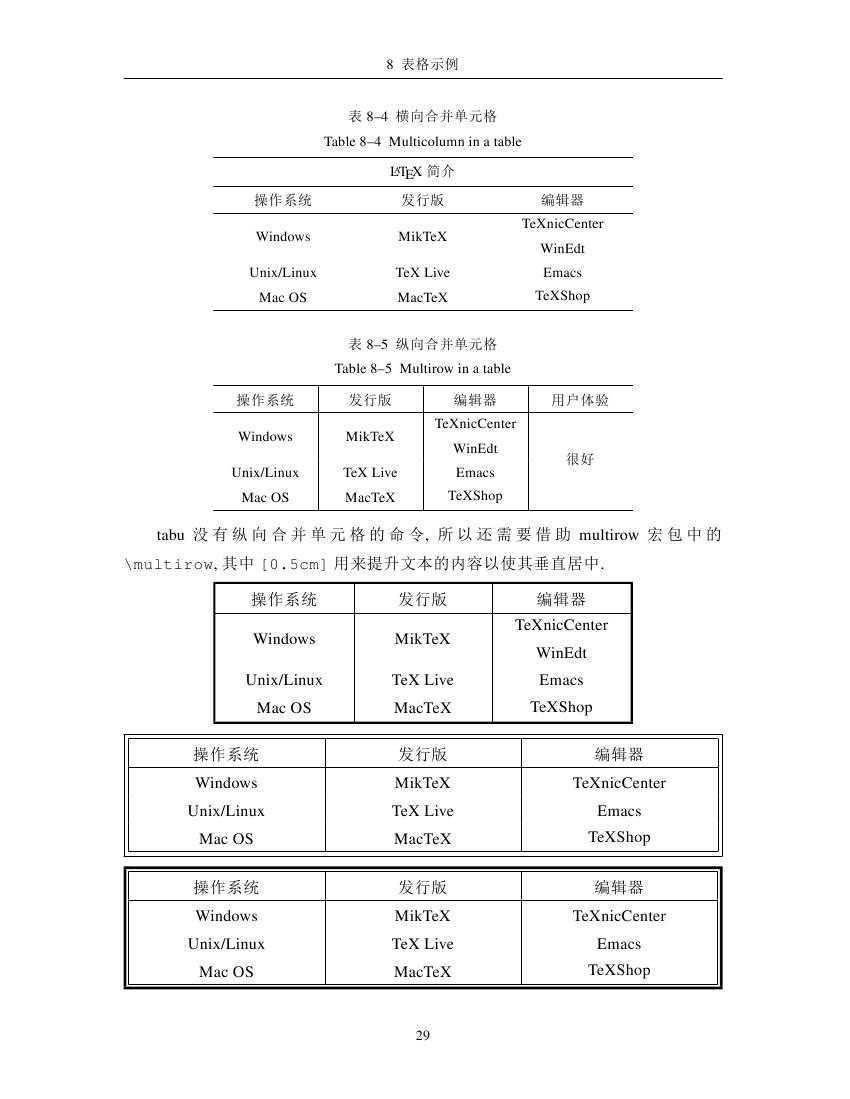
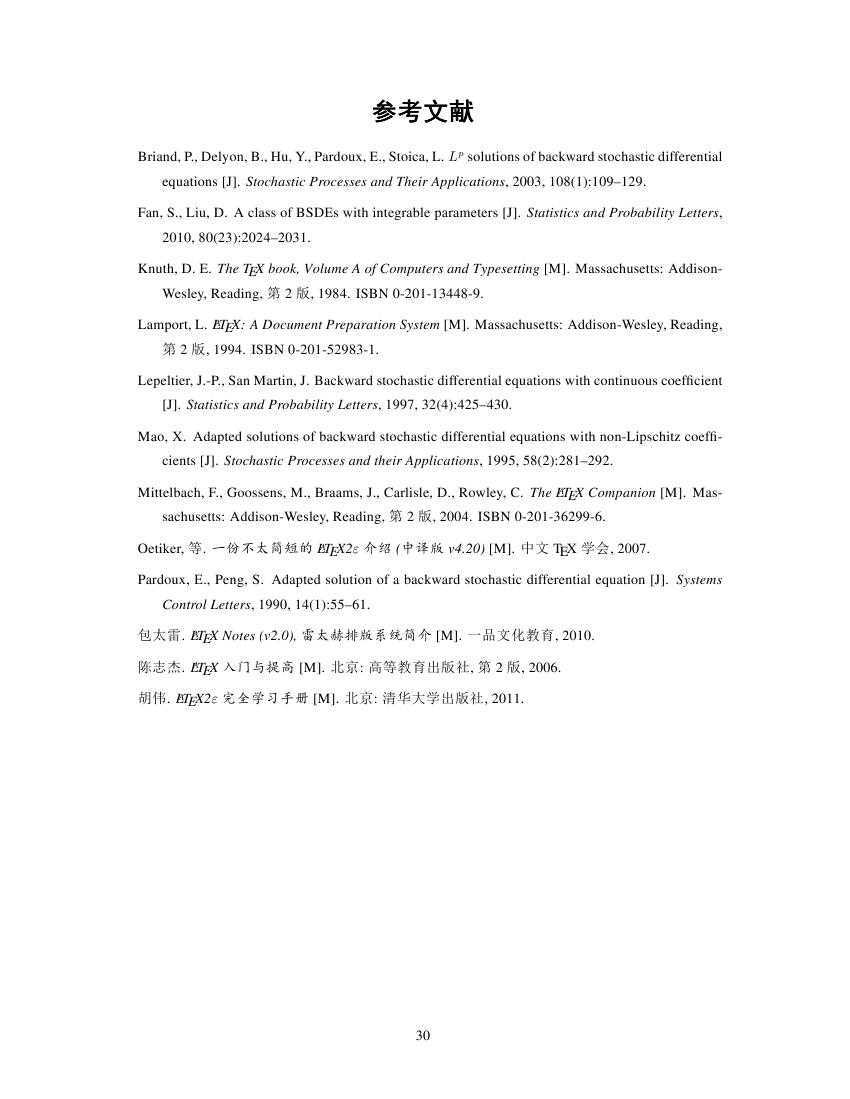
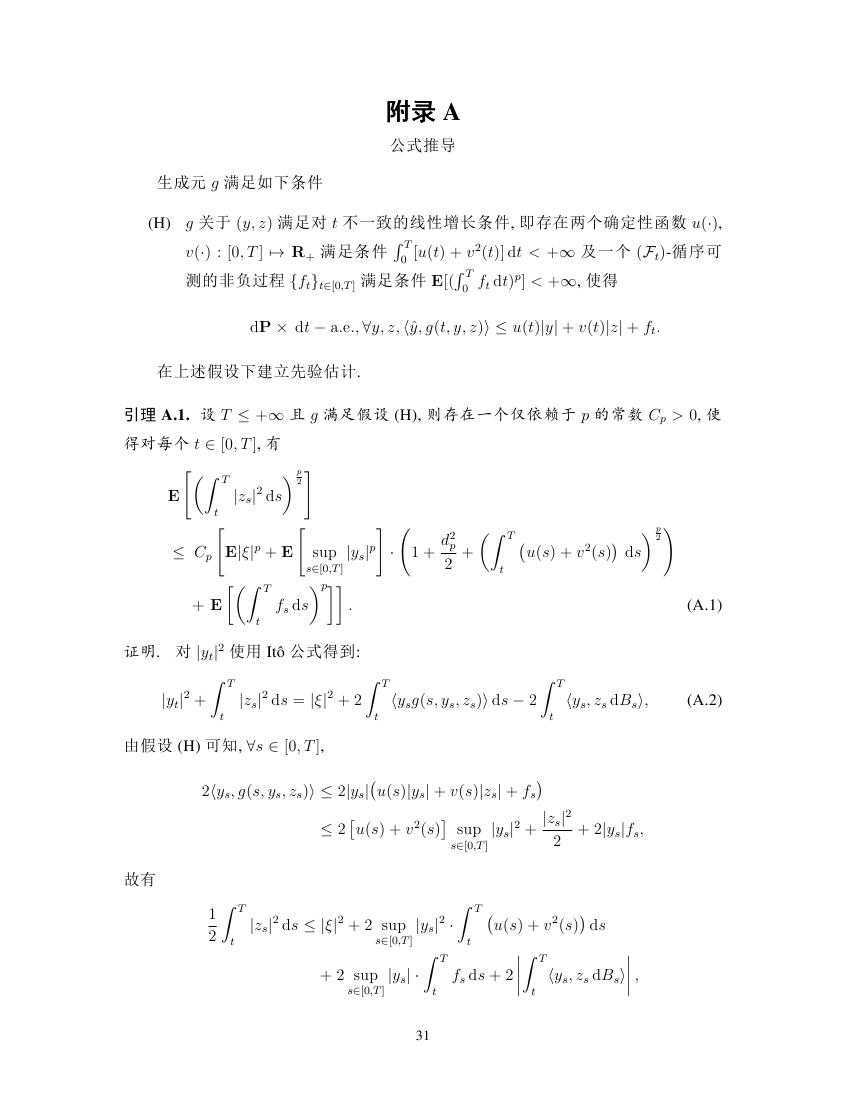
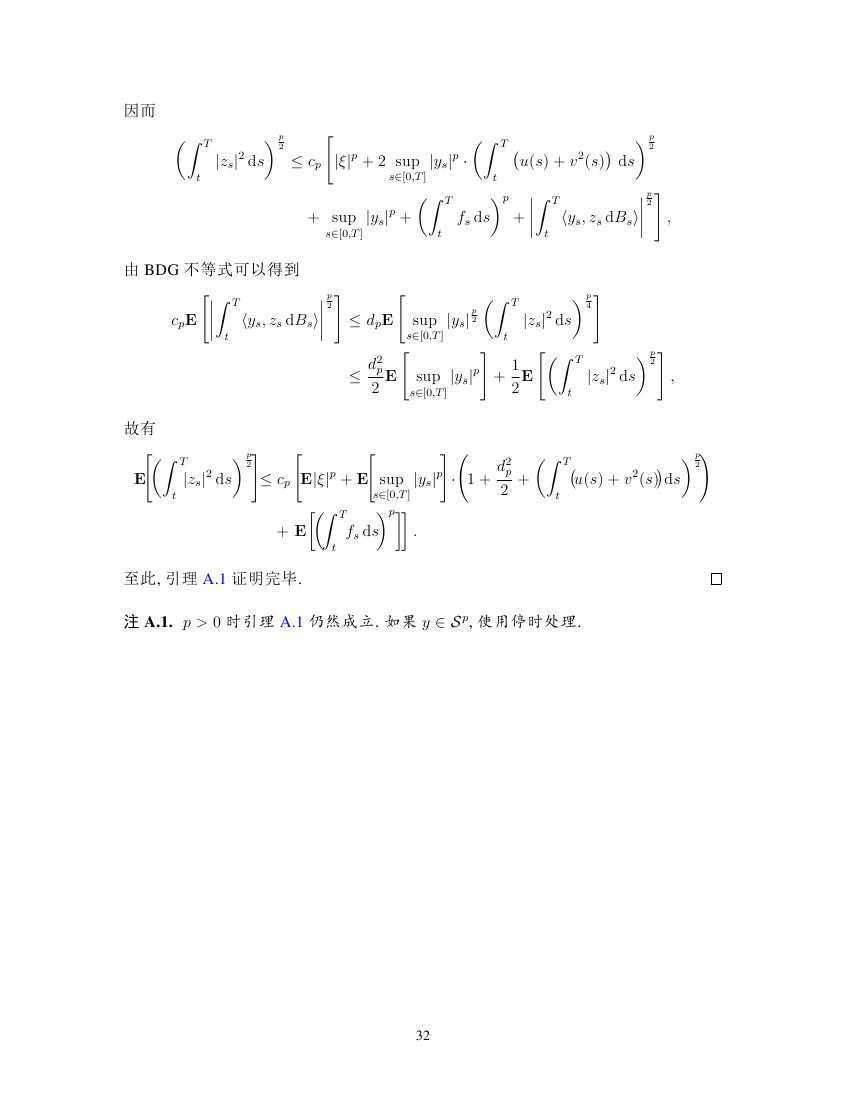

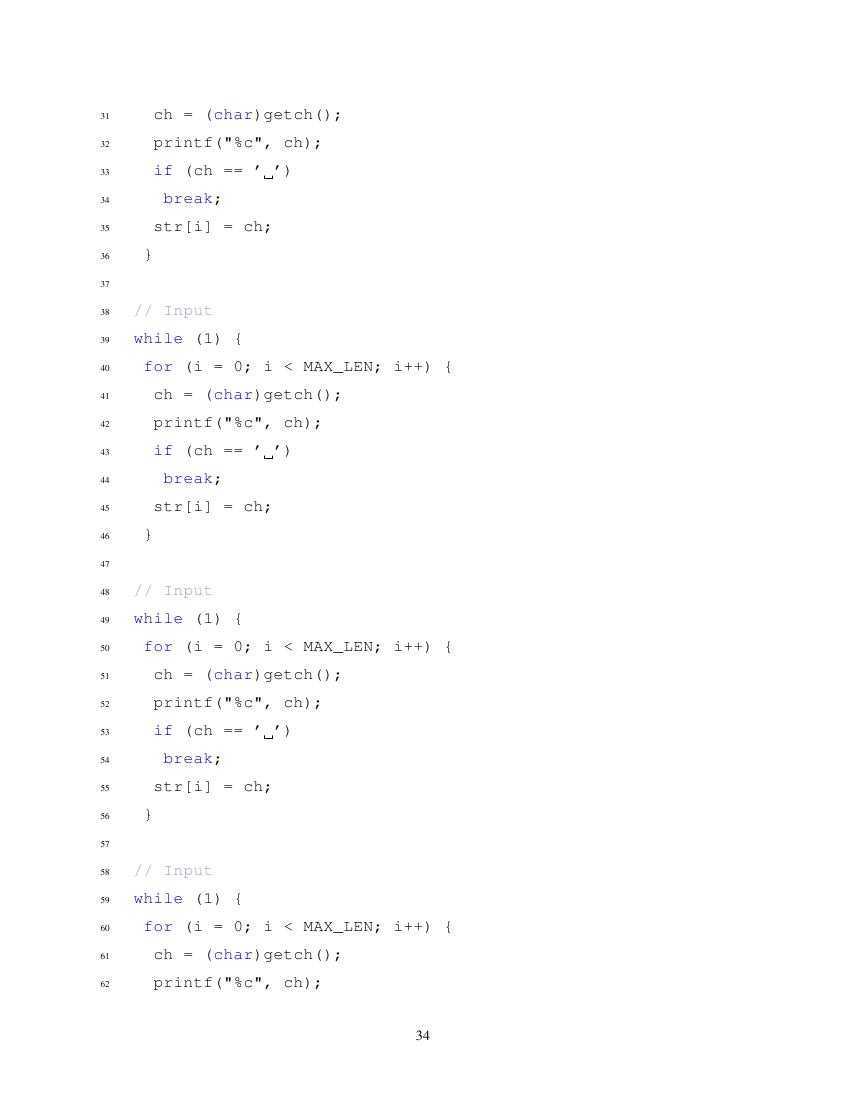
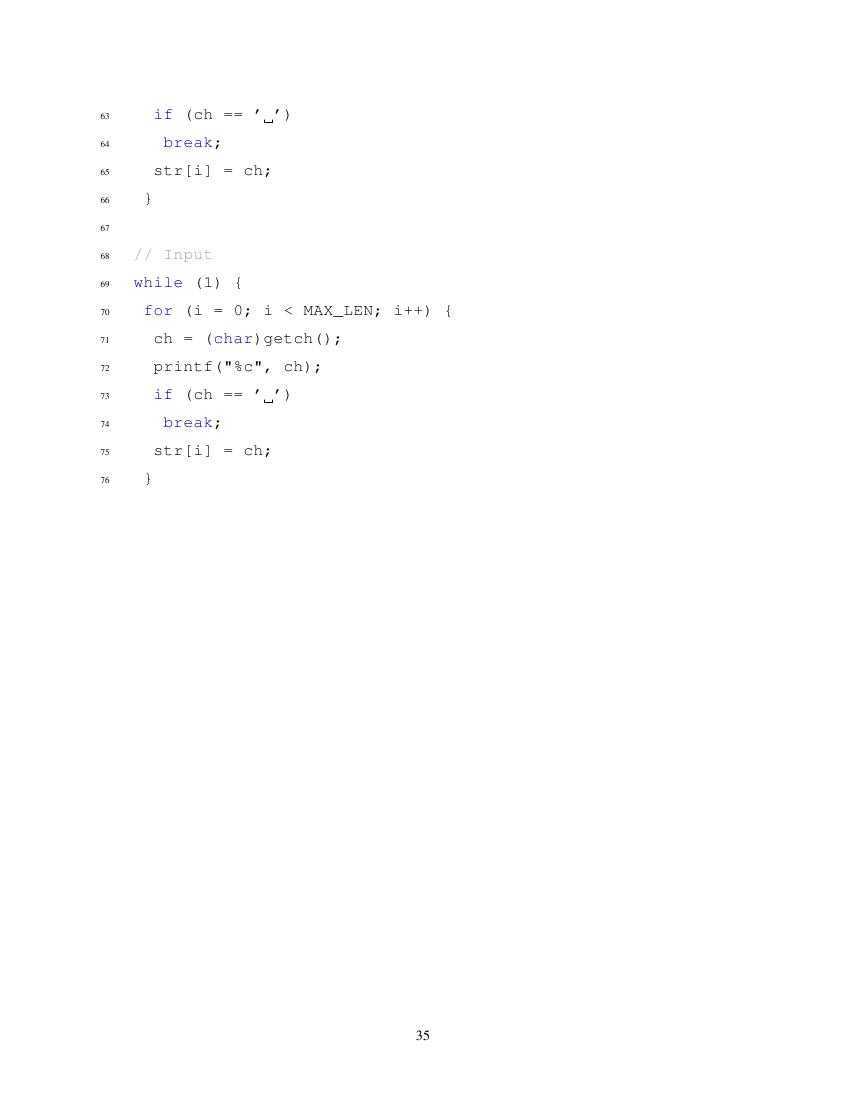

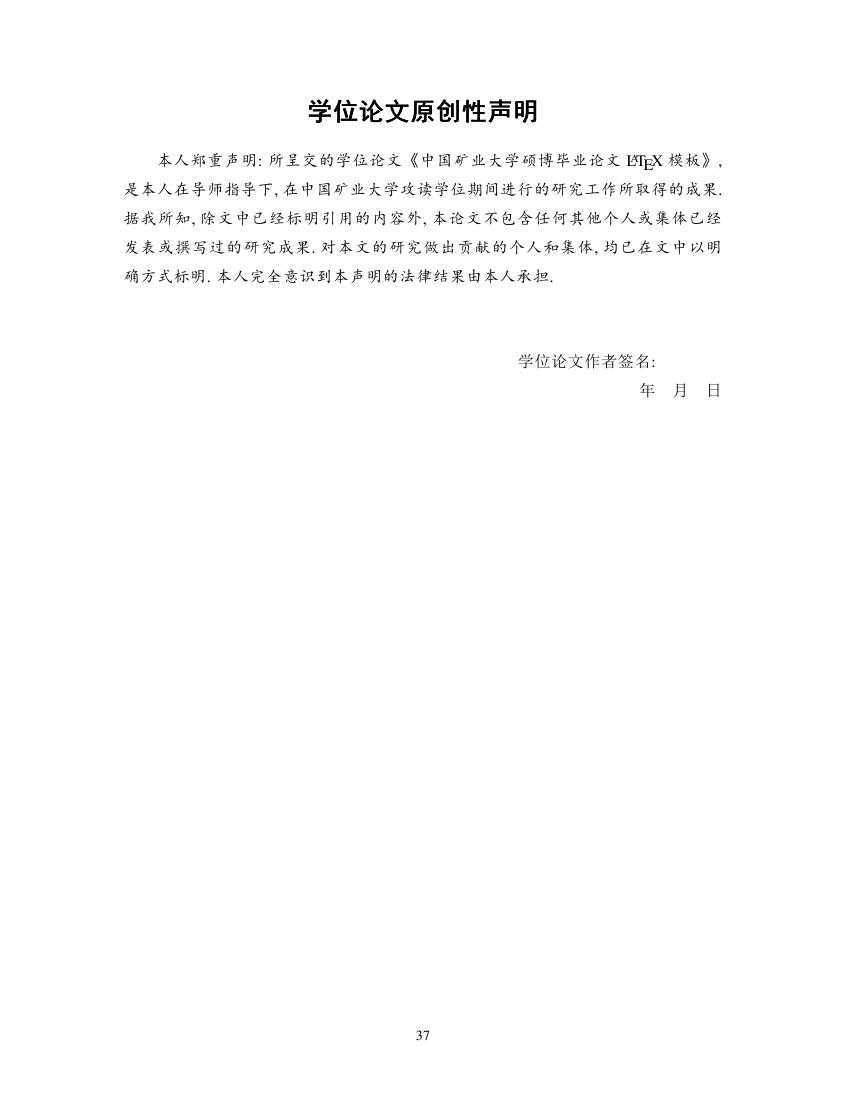

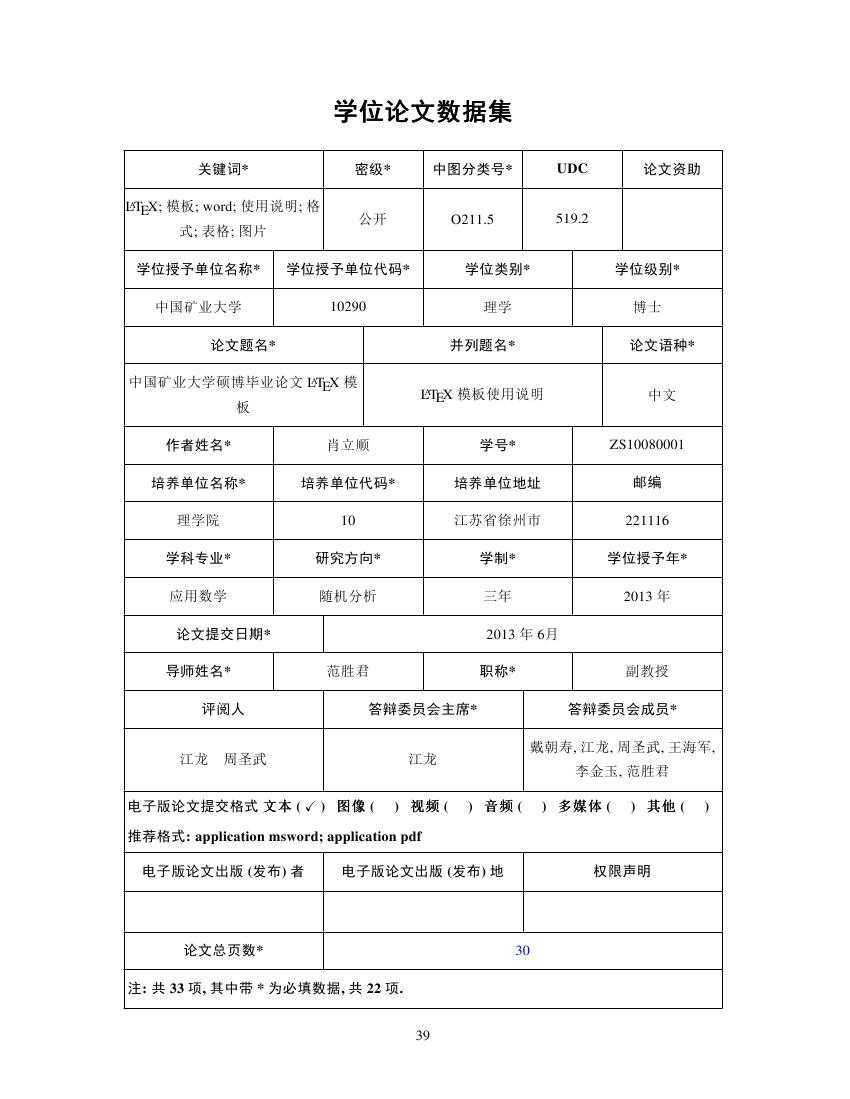
main.tex
1 \documentclass[preprint,authoryear,PhD]{cumtthesis} 2 \usepackage{fancyvrb}%----------------------------------------------------------用于代码排版 3 \DefineVerbatimEnvironment{shell}{Verbatim}% 4 {frame=single,framerule=0.3mm,rulecolor=\color{red!75!green!50!blue}, 5 fillcolor=\color{red!75!green!50!blue!15},framesep=2mm, 6 fontsize=\small} 7 \usepackage{listings} 8 \usepackage{multirow} 9 %=================================== 数学符号 =================================% 10 \newcommand{\rtn}{\mathrm{\mathbf{R}}} 11 \newcommand{\N}{\mathrm{\mathbf{N}}} 12 \newcommand{\AS}{~\mathrm{a.s.}} 13 \newcommand*{\PR}{\mathrm{\mathbf{P}}} 14 \newcommand*{\EX}{\mathrm{\mathbf{E}}} 15 \newcommand*{\dif}{\,\mathrm{d}} 16 \newcommand*{\F}{\mathcal{F}} 17 \newcommand*{\prs}{\dif\PR-\mathrm{a.s.}} 18 \newcommand*{\pts}{\dif\PR\times\dif t-\mathrm{a.e.}} 19 \newcommand{\Ito}{It\^{o}} 20 \newcommand{\tT}[1][0]{[#1,T]} 21 \newcommand{\intT}[2][T]{\int^{#1}_{#2}} 22 \newcommand{\s}{\mathcal{S}} 23 \newcommand{\me}{\mathrm{e}} 24 \newcommand{\one}[1]{{\bf 1}_{#1}} 25 \newcommand{\M}{{\rm M}} 26 \DeclareMathOperator*{\sgn}{sgn} 27 %=================================== 数学符号 =================================% 28 29 \makeindex 30 31 \begin{document} 32 33 % 定义所有的eps文件在 figures 子目录下 34 \graphicspath{{figures/}} 35 36 \frontmatter 37 38 %--------输入中文论文题目 39 \CLunWenTiMu{中国矿业大学硕博毕业论文 \LaTeX{} 模板} 40 41 %--------输入英文论文题目 42 \ELunWenTiMu{China University of Mining and Technology \LaTeX{} Thesis Template} 43 44 %--------输入论文作者 45 \ZuoZhe{肖立顺} 46 47 %--------输入导师职称,导师姓名 48 \DaoShi[副教授]{范胜君} 49 \DiErDaoShi[教授]{江龙} 50 51 %--------输入毕业时间 52 \BiYeShiJian{2013}{5} 53 54 %--------输入中图分类号 55 \ZhongTuFenLeiHao{O211.5} 56 57 %--------输入UDC 58 \UDC{519.2} 59 60 %--------输入密级 61 \MiJi{公开} 62 63 %--------输入毕业学校, 默认是中国矿业大学 64 %\BiYeXueXiao{} 65 66 %--------输入学校代码, 默认是10290 67 %\XueXiaoDaiMa{} 68 69 %--------输入学位类别 70 \XueWeiLeiBie{理学} 71 72 %--------输入培养单位 73 \PeiYangDanWei{理学院} 74 75 %--------输入学科专业 76 \XueKeZhuanYe{应用数学} 77 78 %--------输入研究方向 79 \YanJiuFangXiang{随机分析} 80 81 %--------输入答辩委员会主席 82 \DaBianWeiYuanHuiZhuXi{江龙} 83 84 %--------输入评阅人 85 \PingYueRen{江龙\quad 周圣武} 86 87 %--------致谢 88 \begin{acknowledgements} 89 cumtthesis.cls 模板的制作花费了大量的时间, 期间得到了很多好心人的帮助. 90 91 衷心感谢我的导师\daoshi, 是他教会了我如何学习, 我也从他身上学到了很多宝贵的品质. 92 也衷心感谢江龙老师, 感谢江老师一直支持 cumtthesis.cls 的制作, 也感谢江老师对我 93 的照顾和理解. 94 95 感谢 \href{http://tex.stackexchange.com/}{酷 \LaTeX{} 问答站} 的 egreg. 96 编写 cumtthesis.cls 中图表清单的代码时, egreg 帮我解决了关键性的技术问题, 并且很耐心很 97 及时地解答我的疑问. 98 99 感谢薛瑞尼. cumtthesis.cls 中一部分代码是从薛瑞尼制作的 thuthesis.dtx 中复制过来的. 并 100 且我是看了 thuthesis.dtx 源代码才开始琢磨如何``文学式"编程. 从薛瑞尼的代码和 101 文档中, 我得到了很多启发. 比如图表标题的制作, 比如变量注释表的代码编写, 还比如 102 \verb|*.dtx| 文档的制作等. 103 104 感谢哈尔滨工业大学硕博士学位论文 \LaTeX{} 模板 (1.9.2.20090324 版), cumtthesis.cls 中 105 双语目录的编写受其启发, 通过生成 \verb|*.toe| 文件来生成英语目录. 106 107 感谢 \href{http://zzg34b.w3.c361.com/}{\LaTeX{} 编辑部}提供的关于 \TeX/\LaTeX{} 素材, 第 \ref{cha:IntroductionOfTeX} -- 108 \ref{cha:ResumesOfSupermans} 章的演示内容复制于此. 109 \end{acknowledgements} 110 111 %--------中文摘要 112 \begin{cabstract} 113 本文是对 cumtthesis.cls 模板的演示, 体现模板的各种功能. 制作 cumtthesis.cls 114 的目的是给矿大学子提供一个简洁易用的毕业论文模板, 宗旨是让使用者只关心论文的内容 115 而不用关心论文的格式. 116 117 本文总共有图 \ref{totalfigure} 幅, 表 \ref{totaltable} 张, 参考文献 \ref{totalbib} 个. 118 \end{cabstract} 119 120 %--------中文关键词 121 \CKeyWords{ 122 \LaTeX; 模板; 中国矿业大学; 硕博论文; Word; 宏包; 123 cls 文档; 代码; 默认格式; 参考文献; 双语标题; 双语目录; 页面边距; 定理; 124 定义; 交叉引用.} 125 126 %--------英文摘要 127 \begin{eabstract} 128 This paper is a illustration of cumtthesis.cls, which can reflect the various 129 functions of the template. The purpose of cumtthesis.cls is to provide a 130 simple and easy-to-use thesis template for cumters. It is allows users to only 131 care about the content of the papers rather than the format. 132 133 There are totaly \ref{totalfigure} figures, \ref{totaltable} tables and \ref{totalbib} references 134 in this paper. 135 \end{eabstract} 136 137 %--------英文关键词 138 \EKeyWords{\LaTeX; CUMT; Thesis of MD and PhD; Word; Package; cls document; 139 Codes; Default format; References; Bilingual titles; Bilingual contents; 140 Page margins; Theorem; Definition; Cross reference.} 141 142 %--------英文拓展摘要 143 \begin{exabstract} 144 This paper is a illustration of cumtthesis.cls, which can reflect the various 145 functions of the template. The purpose of cumtthesis.cls is to provide a 146 simple and easy-to-use thesis template for cumters. It is allows users to only 147 care about the content of the papers rather than the format. 148 149 There are totaly \ref{totalfigure} figures, \ref{totaltable} tables and \ref{totalbib} references 150 in this paper. 151 \end{exabstract} 152 153 %--------英文拓展关键词 154 \EXKeyWords{ 155 \LaTeX; CUMT; Thesis of MD and PhD; Word; Package; cls document; 156 Codes; Default format; References; Bilingual titles; Bilingual contents; 157 Page margins; Theorem; Definition; Cross reference. 158 } 159 160 %--------制作封面命令 161 \makecover 162 163 %--------插入中文目录 164 \tableofcontents 165 %--------插入英文目录 166 \tableofecontents 167 168 %--------插入图清单 169 \listoffigures 170 %--------插入表清单 171 \listoftables 172 %--------变量注释表 173 174 \begin{notation}[2.5cm] 175 \item[$P$] 概率 176 \item[$\mathcal{F}$] 域流 177 \item[cumtthesis.ins] 模板的分解文件 178 \item[cumtthesis.dtx] 模板的说明文件 179 \item[cumtthesis.pdf] 模板的使用说明 180 \item[cumtthesis.cls] 模板的文档类 181 \item[cumtthesis.cfg] 文档类的配置文件 182 \item[cumt.bst] 矿大参考文献样式 183 \item[.tex] 示例文档代码 184 \item[.pdf] 示例文档 185 \item[.aux] 引用标记记录文件, 用于再次编译时生成参考文献和超链接等 186 \item[.bbl] 由 BibTeX 编辑 .bib 后创建的文献文件, 再次编译时带入源文件生成文献列表 187 \item[.blg] BibTeX 处理过程记录文件 188 \item[.dvi] 由 \LaTeX{} 对 .tex 源文件编译后创建的输出文件, 含有字库信息 189 \item[.glo] 术语标记记录文件, 用于再次编译时生成术语表 190 \item[.idx] 索引资料记录文件, 可用 makeindex 排序后创建索引文件 .ind 191 \item[.ilg] makeindex 处理过程记录文件 192 \item[.ind] makeindex 对 .idx 排序后创建的索引文件, 再次编译时带入源文件生成索引 193 \item[.lof] 图形标题记录文件, 用于再次编译时生成图形目录 194 \item[.log] 编译过程记录文件, 记录编译时出现的提示, 警告和错误信息 195 \item[.lot] 表格标题记录文件, 用于再次编译时生成表格目录 196 \item[.toc] 中文章节标题记录文件, 用于再次编译时生成中文章节目录 197 \item[.toe] 英文章节标题记录文件, 用于再次编译时生成英文章节目录 198 \item[\bf 英雄本色] 我等这个机会等了三年, 不是为了证明我比别人强, 只是要证明我失去的 199 东西, 我一定要夺回来. 200 \item[\bf 临江仙 (杨慎)]滚滚长江东逝水, 浪花淘尽英雄, 是非成败转头空, 青山依旧在, 几度 201 夕阳红. 白发渔樵江渚上, 惯看秋月春风. 一壶浊酒喜相逢, 古今多少事, 都付笑谈中. 202 \item[\bf 大话西游] 曾经有一份真诚的爱情摆在我的面前, 我没有珍惜, 等到失去的时候才追悔 203 莫及, 人世间最痛苦的事情莫过于此. 如果上天能够给我一个重新来过的机会, 我会对那 204 个女孩子说三个字:``我爱你". 如果非要给这份爱加上一个期限, 我希望是, 一万年. 205 \item[\bf 喜剧之王] 你可以说我是跑龙套的, 但是你不可以说我是``臭跑龙套"的. 206 \item[\bf 东邪西毒] 当你不能够再拥有, 你唯一可以做的, 就是令自己不要忘记. 207 \item[\bf 纵横四海] 其实爱一个人并不是要跟她一辈子的. 我喜欢花, 难道你摘下来让我闻; 208 我喜欢风, 难道你让风停下来; 我喜欢云, 难道你就让云罩着我; 我喜欢海, 难道我就去 209 跳海? 210 \item[\bf 无间道] 往往都是事情改变人, 人却改变不了事情. 211 \item[\bf 笑傲江湖] 有人就有恩怨, 有恩怨就有江湖. 人就是江湖, 你怎么退出! 212 \item[\bf 泰坦尼克号] 我甚至连他的一张照片都没有, 他只活在我的记忆里. 213 \item[\bf 似水年华] 一个男人和一个女人, 他们在完全对对方没有任何了解和认识的情况下, 214 竟然会在一个清晨, 拥抱在一起. 他们在渴求的是什么? 他们不是在要对方, 他们在要自 215 己. 我们在所有经过的爱情当中, 都不是看到的对方, 只是看到了自己. 216 \end{notation} 217 218 %================================== 正文开始 ==================================% 219 \mainmatter 220 221 \chapter{\TeX{} 简介}{Introduction of \TeX} 222 \label{cha:IntroductionOfTeX} 223 224 \TeX{} \index{\TeX} 是一个格式化排版系统, 它一问世便以其排版效果的高质量震动整个 225 出版界. 尤其是在排版含有大量数学公式的科技文献方面更显示了它的优越性. \TeX{} 226 \index{\TeX} 还是一个程序源代码公开的免费排版系统, 因此吸引了许多计算机专家及 227 \TeX{} \index{\TeX} 爱好者为之添砖加瓦. 228 229 20 世纪 60 年代, 著名计算机专家和数学家, 斯坦福大学 Donald E. Knuth \index{Knuth} 230 (读音: ka-nooth) 教授准备出系列专著《The art of computer programming》, 前三卷已 231 经出版. 当他正在撰写第四卷时, 出版社拿来了第二卷的第二版书样给他过目, 结果令他大 232 失所望, 因为当时出版社的印刷技术没有使他的书稿更好看, 反而变糟了, 尤其是在数学公 233 式和字体上面的缺陷更令他无法接受. 于是他就打算自己写一个既能供科学家编排手稿又符 234 合出版社印刷要求的高质量的计算机排版系统 \index{计算机排版系统}. 235 236 \begin{figure} 237 \centering 238 \includegraphics[width=6cm]{TheArtOfComputerProgramming.jpg}\ 239 \caption{计算机编程的艺术}{The art of computer programming} 240 \label{fig:TheArtOfComputerProgramming} 241 \end{figure} 242 243 Knuth \index{Knuth} 教授于 1977 年开始构造 \TeX{} \index{\TeX} 系统, 并为该系统 244 设计了一个字符字体生成软件: METAFONT\index{METAFONT}, 在标准的 \TeX{} \index{\TeX} 245 系统中包含有 75 种不同尺寸的字体, 而且每种字体有 8 种不同的缩放比例. 246 247 1982 年 \TeX{} \index{\TeX} 系统成功开发出版, 之后又有几次升级. Knuth \index{Knuth} 248 教授用无理数 $\pi$ 的近似值作为 \TeX{} \index{\TeX} 系统的版本序号, $\mathrm{e}$ 249 的近似值作为 METAFONT \index{METAFONT} 版本序号, 每升级一次其版号就增加一位数字, 250 不断地趋近于 $\pi$ 和 $\mathrm{e}$, 这也表达了 \TeX{} \index{\TeX} 不断追求完美 251 的愿望. 252 253 \TeX{} \index{\TeX} 的名称是由三个大写的希腊字母 $\tau\epsilon\chi$ 组成, 在希腊 254 语中这个词是``科学"和``艺术"的意思. 为了方便的缘故, 一般都写成 ``TeX", 念做 255 ``teck". 更多关于 \TeX{} \index{\TeX} 的介绍可以参考 Knuth \index{Knuth} 教授编 256 写的《The TeXbook》(\cite{Knuth1984}). 257 258 \TeX{} \index{\TeX} 系统的内核相当稳定, 几乎没有 bug, 1995 年以后版本号一直停止 259 在 3.14159, 直到 2002 年 12 月才又进行了一次升级. 到目前为止, \TeX{} \index{\TeX} 260 系统的版本序号是 3.141592, METAFONT \index{METAFONT} 版本序号为 2.71828. 所以 261 Knuth \index{Knuth} 教授非常自信地说: ``I believe that the final bug in \TeX{} 262 \index{\TeX} was discovered and removed on November 27, 1985. But if, 263 somehow, an error still lurks in the code, I shall gladly pay a finder‘s fee of 264 \$20.48 to the first person who discovers it. (This is twice the previous amount, 265 and I plan to double it again in a year; you see, I really am confident!)" 266 267 \begin{figure} 268 \centering 269 \includegraphics[width=8cm]{KnuthSpeech1990.jpg}\ 270 \caption{Knuth \index{Knuth} 在 1990 年发出最终宣言}{Knuth gave the final declaration in 1990} 271 \label{fig:KnuthSpeech1990} 272 \end{figure} 273 274 275 1990 年 \TeX{} \index{\TeX} 第 3.1 版发布时, Knuth \index{Knuth} 教授发出最终宣言: 276 \begin{itemize} 277 \item 不再对 \TeX{} \index{\TeX} 进行任何扩张; 278 \item 如果出现明显问题, 修正的版本依次为 3.14 版, 3.141 版, 3.1415 版 \ldots, 279 在自己离开这个世界的时候, 将最后的 \TeX{} \index{\TeX} 版本序号改为 $\pi$. 280 此后, 即使再发现错误, 也都将成为 \TeX{} \index{\TeX} 的特征而保留. 如果 281 有人非要修改的话, 就不要再叫 \TeX{} \index{\TeX} 了, 请另外起名. 282 \item 关于 \TeX{} \index{\TeX} 的一切, 已经全部做了书面说明, 可以自由利用设计 283 其他的软件. 284 \end{itemize} 285 286 \TeX{} \index{\TeX} 系统是由 Pascal \index{Pascal} 语言编写的, 程序的源代码也是 287 公开的. 它包含 300 条基本命令和 600 条扩展命令, 几乎可以排版任何形式的文献, 如一 288 般文章、报告、书刊和诗集等, 对数学公式的排版也被公认是最好的. \TeX{} \index{\TeX} 289 系统的优点之一就是它支持命令宏, 这使得使用 \TeX{} \index{\TeX} 成为一种乐趣, 用户 290 可以自己编写宏包来定义更多、更方便的新命令, 这也是 \TeX{} \index{\TeX} 能得以迅速 291 发展的原因. 而且, \TeX{} \index{\TeX} 是一个可移植的软件系统, 它可以运行于所有类 292 型的计算机 (如苹果机、IBM PC 机及大型工作站) 和各种操作系统 (如 DOS、Windows、 293 Unix 等). 294 295 \TeX{} \index{\TeX} 另一个重要特征就是它的输出是与设备无关. \TeX{} \index{\TeX} 296 的输出文件称为 DVI 文件, 即是``设备无关". 一旦 \TeX{} \index{\TeX} 处理了你的文 297 件, 所得到的 DVI 文件就可以被送到任何输出设备如打印机、屏幕等, 并且总会得到相同 298 的结果, 而这与这些输出设备的限制没有任何关系. 这说明 DVI 文件中所有的元素, 从页 299 面设置到文本中字符的位置都被固定, 不能更改. 300 301 最基本的 \TeX{} \index{\TeX} 程序只是由一些很原始的命令组成, 它们可以完成简单的 302 排版操作和程序设计功能. 然而, \TeX{} \index{\TeX} 也允许用这些原始命令定义一些更 303 复杂的高级命令. 这样就可以利用低级的块结构, 形成一个用户界面相当友好的环境. 304 305 虽然 \TeX{} \index{\TeX} 在过去的二十多年中没有大的变化, 但它开放的设计使得它能 306 够很容易适应新的要求. 例如, 在没有改动内核的情况下, \TeX{} \index{\TeX} 很容易 307 地实现了对 PostScript\index{PostScript} 字体和外部图形的支持; \TeX{} \index{\TeX} 308 是第一个能够自动生成 HTML 的字处理软件; 现在, \TeX{} \index{\TeX} 还可以在不 309 借助其它工具 (如 Adobe Distiller) 的条件下生成 PDF 格式文件. 310 311 \TeX{} \index{\TeX} 不仅是一个排版程序, 而且是一种程序语言. \LaTeX{} \index{\TeX} 312 就是使用这种语言写成的一个``\TeX{} \index{\TeX} 宏包", 它扩展了 \TeX{} \index{\TeX} 313 的功能, 使我们很方便地进行富于逻辑性的创作而不是专心于字体、缩进等这些烦人的东西. 314 315 \TeX{} \index{\TeX} 源文件是 ASCII 码文件, 可以方便地在网络上传播. 目前, 大多数 316 学术部分和校园网上都安装有 \TeX{} \index{\TeX} 系统. 国际上许多出版机构也采用 317 \TeX{} \index{\TeX} 系统来排版书刊, 不少出版社还要求作者提供稿件的 \TeX{} \index{\TeX} 318 源文件. 319 320 \chapter{\TeX{} 的优缺点}{The Advantages and Disadvantages of \TeX} 321 322 在一个充斥着``所见即所得"桌面出版软件的情况下来使用 \TeX{} \index{\TeX} 确是有点 323 令人奇怪. 但是, 在某些情形下, 你会感到 \TeX{} \index{\TeX} 是最好的, 甚至是唯一 324 适合的系统. 325 326 首先我们来看一下 \TeX{} \index{\TeX} 的优势所在: 327 328 \begin{description} 329 \item[高质量的输出] \TeX{} \index{\TeX} 遵循传统的排版规则, 以排版的质量为最重 330 要的目标. 如果把 \TeX{} \index{\TeX} 的输出结果和用其它的排版软件排版相同 331 的文本所得到的结果加以比较, 就会发现其中的区别. 332 \item[超常的稳定性] 自从 \TeX{} \index{\TeX} 出现以来, 只有一些微小的改动. 也就 333 是说, 十几年前的 tex 文件, 用现在的 \TeX{} \index{\TeX} 系统排版得到的结 334 果与十几年前得到的结果是一样的. 稳定性还体现在 \TeX{} \index{\TeX} 系统极 335 少会崩溃, 可以处理任意大小的文件, 即使你的计算机的内存很少, 336 \TeX{} \index{\TeX} 也可自如地工作. 337 \item[\TeX{} 是可编程的] \TeX{} \index{\TeX} 是一种宏命令编程语言, 338 可以用很少的命令来完成非常复杂的工作. 如果需要, 也可以重新定义 339 \TeX{} \index{\TeX} 的所有命令, 得到特殊的效果. 340 \item[高度的灵活性] \TeX{} \index{\TeX} 自从出现以来其内核只有微小的改动. 但是 341 由于其内核的设计方式, 世界上的 \TeX{} \index{\TeX} 使用者可以让 342 \TeX{} \index{\TeX} 做几乎任何文字工作. 可以用 \TeX{}\index{\TeX} 来排版英 343 文文本, 也可以排版德文, 俄文, 中文等多种语言. 还可以用 \TeX{}\index{\TeX} 344 来排版乐谱, 象棋, 围棋棋谱等等. 345 \item[简单方便] \TeX{} \index{\TeX} 文件是 ASCII 码的文本文件. 因此, 即使你手 346 边没有 \TeX{} \index{\TeX} 系统, 你也可以看懂绝大部分的内容. 347 \TeX{} \index{\TeX} 文件的这种特点使得它占用很少的存储空间, 也可以很方便 348 的用 email 来传输. 349 \item[良好的通用性] 目前为止, \TeX{} \index{\TeX} 几乎在所有的计算机操作系统上 350 得到实现. 如: Atari, Apple, Unix, Macintosh, VMS, MS-DOS, MS-Windows 和 351 OS/2 等. \TeX{}\index{\TeX} 的源文件可在不同的平台之间自由的交换, 而得到 352 的输出是完全相同的. 353 \item[低廉的价格] \TeX{} \index{\TeX} 是免费软件, 它的源程序也是免费的. 你可能 354 仅仅需要支付邮费, 甚至于一分不花地得到适合你的 \TeX{} \index{\TeX} 系统. 355 世界上有很多非常好的 \TeX{} \index{\TeX} 免费软件如: teTeX, MikTeX, fp-TeX 356 等等. 同时也有一些具有各自特点 (如或多或少的所见即所得特性的) 和提供专家级 357 帮助系统的商业版本. 358 \item[超级技术支持] 由于 \TeX{} \index{\TeX} 并不是被某个公司所垄断开发, 所以 359 世界各地的使用者设计了统一的技术支持的方式. 这通常是通过因特网以 email, 360 WWW, Usenet 或 Ftp 的方式来提供, 有时也可能通过电话或传真的方式. 在绝大多 361 数情况下这些技术支持都是免费的, 这也是 \TeX{} \index{\TeX} 的精神. 362 \item[\TeX{} 是一种乐趣] 使用 \TeX{} \index{\TeX} 不仅仅是一种工作手段, 也是一种乐趣. 它有挑 363 战, 也有荣誉. 很多人在熟悉了 \TeX{} \index{\TeX} 之后都开始把使用 \TeX{} \index{\TeX} 作为一种爱好, 364 而不是一件枯燥无味的劳动. 365 \end{description} 366 367 368 在展示了 \TeX{}\index{\TeX} 的优秀之处后, 也得承认 \TeX{}\index{\TeX} 也有一些不足的地方: 369 370 \begin{description} 371 \item[命令繁琐] \TeX{}\index{\TeX} 共包括 900 多条命令, 一般用户很难在短时间内完全掌握. 当开 372 始学习并使用它的时候, 你将会不停地去翻看 \TeX{}\index{\TeX} 的参考手册, 来寻找一个 \TeX{}\index{\TeX} 373 命令. 你也会发现 \TeX{}\index{\TeX} 常常不理会你键入的命令, 还给出一个让你感到迷惑的错 374 误信息. 这一切都说明了掌握 \TeX{}\index{\TeX} 需要一个比较长而且艰难的学习过程. \TeX{}\index{\TeX} 375 的一些扩展如 \LaTeX{} \index{\LaTeX} 则要相对简单的多, 使用起来也比 \TeX{} \index{\TeX} 方便, 一个新手 376 完全可以在一个下午或者更短的时间内学会初步使用 \LaTeX\index{\LaTeX}. 377 378 当发生错误的时候, \TeX{} \index{\TeX} 会给出一些信息来提示你. 但很多情况下并不足以使你迅 379 速准确地找到错误之所在. 尤其对刚刚开始学习的新手来说更是如此. 380 381 像 \TeX{}\index{\TeX} 这种宏语言不同于其它的计算机语言, 如 C, Pascal 等, 大多数人并不了 382 解. 因此, 当你想要写自己的宏命令时, 你需要对 \TeX{}\index{\TeX} 有比较深入的了解才能写 383 出牢固可靠的宏命令. 384 \item[使用不直观] \TeX{}\index{\TeX} 不是所见即所得的. 尽管市场上有些近似于所见即所得的商业 385 版本, 但即使与最普通的字处理软件相比, 也还是有不小的差距. 386 \item[兼容性差] \TeX{}\index{\TeX} 语言与常用的字处理软件的兼容性很差. 387 \item[应变力差] 图片很多、分栏方式变化多端又没有逻辑结构的无序文件, 比如报纸、 388 画报和广告等, 也不适合用 \TeX{}\index{\TeX} 来排版. 389 \item[网页表达力差] 在浏览网络时, 很少看到理工科论文直接以网页形式表现, 一般都要 390 求先下载, 再用其它软件观看. 下载的文件大都是 PDF, DVI 或 PS 格式. 如果使用 391 的是 Linux 操作系统, 这三种文件的浏览器一般系统本身都带有, 它们分别是 xdvi, 392 xpdf 和 gsview. 如果所使用的是 Windows 操作系统, 则必须分别下载使用 Acrobat 393 Reader, WinDVI 或 GhostView 观看. 394 395 由于 \TeX{}\index{\TeX} 的网页表达能力差, 其强大的数学排版才能无法在互联网上直接显示出来. 396 因此, \TeX{}\index{\TeX} 语言不可能普遍运用于网络上的数学公式表达. 397 398 一种既有 \TeX{}\index{\TeX} 的强大数学公式表达能力又能与互联网良好结合的表达语言: MathML, 399 正在孕育之中. 400 \item[无官方支持] 由于 \TeX{}\index{\TeX} 不是某个软件公司的产品, 缺乏技术支持, 在使用过程中 401 若出现问题, 找不到能对其负责的机构, 只有自己查找相关书籍资料或向论坛、用户 402 组织等民间网站求助. 403 \end{description} 404 405 \chapter{\LaTeX{} \index{\LaTeX} 的产生}{\LaTeX{} comes into being} 406 \TeX{} \index{\TeX} 还只是着重在于如何排版的层次上, 而不是从一位作者的立场出发. 对它深层功能的 407 进一步发掘, 需要相当丰富的编程技巧. 因此它的应用就局限于高级排版和程序设计人员. 408 409 虽然 \TeX{} \index{\TeX} 的功能很强大, 用它可以排版任何式样的文稿, 但普通用户要灵活掌握 \TeX{} \index{\TeX} 410 的 900 条初始命令还是有困难的. 因而, 在 \TeX{} \index{\TeX} 公开几年后, 利用 \TeX{} \index{\TeX} 的宏定义功能 411 开发的宏库 AMS\TeX{} 和 \LaTeX{} \index{\LaTeX} 就产生了. 412 413 AMS\TeX{} 是美国数学学会委托编写的, 主要用于美国数学学会及其分支机构出版的大量书籍、 414 期刊和评论. AMS\TeX{} 中含有一个宏包, 供作者用来方便地准备稿件. 用 AMS\TeX{} 可以 415 方便地排印出非常复杂的数学公式和 AMS 制定的全部数学符号. 416 417 \LaTeX{} \index{\LaTeX} 是由美国计算机学家 Leslie Lamport 于 1985 年开发成功的. 它是当今世界上最 418 流行和使用最为广泛, 以 \TeX{}\index{\TeX} 为引擎的高质量格式化排版系统. 它构筑在 \TeX{} 的基础 419 之上, 并且加进了很多新功能, 使得使用者可以更为方便的利用 \TeX{}\index{\TeX} 的强大功能. 使用 420 \LaTeX{}\index{\LaTeX} 基本上不需要使用者自己设计命令和宏等, 因为 \LaTeX{}\index{\LaTeX} 已经替你做好了. 因此, 421 即使使用者并不是很了解 \TeX\index{\TeX}, 也可以在很短的时间内制成高质量的文件. 对于排版复杂的 422 数学公式, \LaTeX{}\index{\LaTeX} 表现的更为出色. 423 424 \begin{figure} 425 \centering 426 \includegraphics[width=8cm]{TexStone.png}\ 427 \caption{\LaTeX{}\index{\LaTeX} 的结构示意图}{The structure of \LaTeX} 428 \label{fig:TheStructureOfLaTeX} 429 \end{figure} 430 431 432 \TeX{}\index{\TeX} 是 \LaTeX{}\index{\LaTeX} 的基石, \LaTeX{}\index{\LaTeX} 建立在 \TeX{}\index{\TeX} 之上; 各种宏包和类型文件是 \LaTeX{}\index{\LaTeX} 433 大厦的装饰材料. \LaTeX{}\index{\LaTeX} 是特殊版本的 \TeX\index{\TeX}. 434 435 尽管在排版数学公式和数学符号方面, \LaTeX{}\index{\LaTeX} 不如 AMS\TeX, 但是 \LaTeX{}\index{\LaTeX} 提供了大量 436 易于学习和使用的命令, 例如非常有用的交叉引用命令等, 都是 AMS\TeX 所不具备的. 因而, 437 \LaTeX{}\index{\LaTeX} 的用途更为广泛, 特别是在排版信件、书刊、诗集等方面更优于 AMS\TeX. 438 439 自从 \LaTeX{}\index{\LaTeX} 问世以来, 流传最广的版本是 \LaTeX{}2.09\index{\LaTeX}. 由于 \LaTeX{}\index{\LaTeX} 的众多优点, 440 在计算机科学、数学及相关学科得到迅速广泛地应用, 吸引了许多专家、爱好者并为其编写和 441 添加了各式各样的宏包和宏库, 例如 PostScript 字体处理、排版复杂数学公式的 AMS\LaTeX{} 等, 442 这使得 \LaTeX{}\index{\LaTeX} 的功能不断地扩充, 应用领域不断地扩大. 但是, 由于没有统一的宏包编写 443 规划和编写格式, 造成某些宏包的功能彼此接近, 而命令相互冲突, 同一个源文件在某种格式 444 的 \LaTeX{}\index{\LaTeX} 中能够完美运行, 而在另一种格式中就可能编译出错或结果有所不同. 很多网站 445 和编辑部为了处理不同来源的 \LaTeX{}\index{\LaTeX} 文件, 不得不置备各种格式的 \LaTeX{}\index{\LaTeX} 系统; 有些 446 宏包很难分辨出是为那种格式编写的, 还得反复尝试. 447 448 有鉴于此, TUG 专门成立了 \LaTeX{}3\index{\LaTeX} 项目小组, 负责研发一个用途更加广泛, 功能更为完 449 善, 用户更易使用的崭新版本: \LaTeX{}3\index{\LaTeX}. 这是一个长期艰巨的科研计划, 为了尽快扭转当 450 时的混乱局面, \LaTeX{}3\index{\LaTeX} 项目小组先在 1994 年推出过渡版本 \LaTeX{}2$\varepsilon$\index{\LaTeX}. 451 新旧版本最明显的区别在于源文件的第一条命令, \LaTeX{}2.09 \index{\LaTeX} 为: 452 \begin{shell} 453 \documentstyle[选项, 宏包名]{文件类型名} 454 \end{shell} 455 \vspace{-8pt} 456 方括号里两种个不同类型的选择项并存, 容易产生混淆; \LaTeX{}2$\varepsilon$ \index{\LaTeX} 将其一分为二: 457 \begin{shell} 458 \documentclass[选项]{文件类型名} 459 \usepackage{宏包名} 460 \end{shell} 461 \vspace{-8pt} 462 而且宏包也可以有自己的选项. 463 464 字体处理是新版最重要的改进, 它将 NFSS 作为标准的字体选择方法, 可处理任意编码的字体, 465 而旧版仅支持 OT1 编码. NFSS 是用属性的方式描述字体, 因此可分别独立地选择字体的某种 466 属性, 例如先选黑体, 再选斜体, 从而得到黑斜体, 这在旧版本是不可能的事儿. 467 468 新版本把 SLiTeX、AMSLaTeX 等宏库都归为附属的扩展宏包套件, 并将其中所有宏包的命令格 469 式统一, 可以用命令调用; 它还对浮动体定位、命令语句功能等方面进行了改进或扩充, 并对 470 旧版本中的错误和漏洞作了修补. 新版本还增添了许多新的功能、命令和错误提示信息以及处 471 理多种文字的 babel 宏包套件、图形制作的 graphics 宏包套件等. 472 473 新版本的另一个重要改进就是提供了更为高效便捷的宏包文件或类型文件编写命令. 474 475 新版本兼容旧版本, 也就是说用 \LaTeX{}2.09 \index{\LaTeX} 创建的源文件仍可在 \LaTeX{}2$\varepsilon$ \index{\LaTeX} 476 中运行, 只是速度要慢一半, 因为要在两种模式中切换; 如想要加快并享受新版的乐趣, 须将 477 源文件第一条命令改为新版形式. 478 479 \begin{figure} 480 \centering 481 \includegraphics[width=8cm]{LaTeX2e.png}\ 482 \end{figure} 483 484 \LaTeX{} \index{\LaTeX}的读法应为``lay-teck", 念成``lay-tecks"也可以. 485 486 \LaTeX{}2$\varepsilon$ \index{\LaTeX}可读作``Lay-teck two e". 487 488 \LaTeX{} \index{\LaTeX}的标准写法比它的读法更别致, 应该是上图中的样子, 这在 \LaTeX{}\index{\LaTeX} 源文件中使用 489 专有命令就可轻易做到, 而在网页上很难实现, 为了简便起见, 都采用目前这种非常规大写形 490 式, \LaTeX{}2$\varepsilon$ \index{\LaTeX}也被简化成 \LaTeX{}2$\mathrm{e}$\index{\LaTeX}. 491 492 在 \LaTeX{}3 \index{\LaTeX}最终完成之前, \LaTeX{}2$\mathrm{e}$ \index{\LaTeX}仍将是标准的 \LaTeX{}\index{\LaTeX} 版本, 由 493 \LaTeX{}3 \index{\LaTeX}项目小组负责维护. 494 495 更多关于 \LaTeX{} \index{\LaTeX}的资料可以参考 496 \citet*{OetikerPartlHynaSchlegl2007,Leslie1994,MittelbachGoossensBraamsCarlisleRowley2004,ChenZhiJie2006,HuWei2011}. 497 498 \chapter{\LaTeX{} 与 Word 比较}{Compare \LaTeX with Word} 499 \LaTeX{}\index{\LaTeX} 与 Word 是两种不同类型的文本编辑处理系统, 各有所长, 如果要对文字编辑性能 500 和使用便捷程度等作综合评比, Word 明显优于 \LaTeX\index{\LaTeX}, 仅``所见即所得"一项, Word 就会 501 赢得绝大多数用户, 但要仅限定在学术报告和科技论文方面, 评比结果就不同了. 502 503 \section{从头开始}{From the Beginning} 504 505 Word 特点就是``所见即所得", 其基本功能初学者很容易掌握, 很多 Word 用户都是无师自 506 通. 但随着篇幅和复杂程度的增加, 花费在文稿格式上的精力和时间要明显加大, 如图 507 \ref{fig:CompareWithWord} 蓝 508 色示意曲线所示. 因为创建自定义编号、交叉引用、索引和参考文献等就不是``所见即所得" 509 了, 得耐着性子反复查阅 Word 的在线帮助或借助相关软件帮忙. 510 511 对于 \LaTeX{}\index{\LaTeX} 初学者, 即就是编排很简单的文章, 也要花较多的精力和时间去学习那些 512 枯燥的命令和语法, 特别是排写数学公式, 经常出错, 多次编译不能通过, 使很多初学者望 513 而却步. 可是一旦掌握, 不论文稿长短和复杂与否都会熟练迅速地完成, 先前学习 \LaTeX{}\index{\LaTeX} 514 的精力投入将由此得到回报, 如图 \ref{fig:CompareWithWord} 红色示意曲线所示. 515 516 \begin{figure} 517 \centering 518 \includegraphics[width=9cm]{CompareWithWord.jpg}\ 519 \caption{与 Word 比较}{Compare with Word}\label{fig:CompareWithWord} 520 \end{figure} 521 522 \section{内容与样式}{Contents and Format} 523 当用 Word 写作时, 要花很多精力对页版式、章节样式、字体属性、对齐和行距等文本参数进 524 行反复选择对比, 尤其是长篇文章, 经常出现因疏忽而前后文体格式不一致的现象; 当在稿件 525 中插入或删除一章或章节次序调整时, 各章节标题、图表和公式等的编号都要用手工作相应修 526 改, 稍有不慎就会出现重号或跳号. 你既是作者又是编辑还兼排字工. 527 528 使用 \LaTeX{}\index{\LaTeX} 编版, 如无特殊要求, 只要将文稿的类型 (article, report 或 book 等) 告 529 诉 \LaTeX\index{\LaTeX}, 就可专心致志地写文章了, 至于文稿样式的各种细节都由 \LaTeX{}\index{\LaTeX} 统一规划设 530 置, 而且非常周到细致; 当修改稿件时, 其中的章节、图表和公式等的位置都可任意调整, 无 531 须考虑编号, 因为在源文件里就没有编号, 文件中的所有编号都是在最后编译时 \LaTeX{}\index{\LaTeX} 自 532 动统一添加的, 所以绝对不会出错. 533 534 换句话说, Word 把文稿的内容与样式混为一体, 而 \LaTeX{}\index{\LaTeX} 将它们分离, 作者只需专注于 535 文稿的内容, 而文稿的样式几乎不用过问, \LaTeX{}\index{\LaTeX} 是你的聪明而忠诚的文字秘书, 如有特 536 殊要求, 也可使用命令修改, \LaTeX{}\index{\LaTeX} 会自动将相关设置更新, 无一遗漏. 537 538 接受 \LaTeX{}\index{\LaTeX} 稿件的出版社大都有自己的文稿样式模板, 主要就是一个类型文件包, 简称类 539 包. 如果稿件未被甲出版社采用, 在转投乙出版社前, 只需将稿件第一句中类包名称由甲出版 540 社的改为乙出版社的, 整篇稿件的样式就随之自动转换过来了. 就一句话的事儿, 简单的不能 541 再简单了, 然而因为``体制"的原故, Word 却根本无法做到这一点. 542 543 \section{数学公式}{Mathematical Formulas} 544 Word 有个公式编辑器, 可以编辑普通数学公式, 但使用很不方便, 外观效果较差, 也不能自 545 动编号, 尤其是很难作为文本的一部分, 融入某一行中, 大都专起一行. 如果碰到复杂的数学 546 公式, 编辑起来就很困难. 有些用户只好另外安装可嵌入 Word 环境的工具软件 MathType 来 547 弥补这一不足. 548 549 \LaTeX{}\index{\LaTeX} 的特长之一就是数学公式编辑, 方法简单直观, ``所想即所得", 公式的外观精致细 550 腻, 而且公式越复杂这一优点就越明显. 普通单行公式可以像纯文字文本一样插入字里行间. 551 下面举三例加以比较 (如图 \ref{fig:CompareTheDisplayOfWordAndLaTeX}), 其中 Word 分两 552 种情况, 一是 DOC 格式的屏幕显示效果, 二是将 DOC 格式文件通过 Acrobat 转换为 PDF 格 553 式的效果. 554 555 \begin{figure} 556 \centering 557 \begin{tabu}to.7\linewidth{X[1rm]X[1.5lm]} 558 Word: & \includegraphics[width=5cm]{WordFormula.png}\ 559 Word 转化为 PDF: & \includegraphics[width=5cm]{WordFormulaInPDF.png}\ 560 \LaTeX{}: & $s_1$, $\displaystyle s_2=-\frac{B}{2G}\pm\sqrt{\left(\frac{B}{2G}\right)^2-\frac{B}{C}}$\ 561 \end{tabu} 562 \caption{Word 与 \LaTeX{}\index{\LaTeX} 公式显示效果对比}{Compare the display of Word and \LaTeX} 563 \label{fig:CompareTheDisplayOfWordAndLaTeX} 564 \end{figure} 565 566 Word 在某些时候公式会出现对接不齐, 行距变宽等现象, 而 \LaTeX{}\index{\LaTeX} 编辑的公式在整个文档 567 中一直对接工整, 行距不变, 如图 \ref{fig:CompareTheAlignOfWordAndLaTeX}. 568 569 \begin{figure} 570 \centering 571 \includegraphics[width=9cm]{WordFormulaNotAlign.png}\ 572 \includegraphics[width=9cm]{WordFormulaNotAlignInPDF.png}\ 573 \includegraphics[width=9cm]{LatexFormulaAlign.png}\ 574 \caption{Word 与 \LaTeX{}\index{\LaTeX} 公式的对齐比较}{Compare the align of Word and \LaTeX{}} 575 \label{fig:CompareTheAlignOfWordAndLaTeX} 576 \end{figure} 577 578 尽管在默认状态下, 就能将数学公式编排的非常精致美观, \LaTeX{}\index{\LaTeX} 仍然还提供了很多调节 579 命令, 可以对公式的外观作更加细微的调整, 使其尽善尽美. 580 581 \section{插图}{Figures} 582 583 Word 有个绘图工具, 简易直观, 但功能有限效果不佳. 论文中的复杂图形大都用功能强大的 584 Visio、Photoshop 等绘图软件绘制, 然后插入 Word. 585 586 \LaTeX{}\index{\LaTeX} 自身也具有简单的绘图功能, 如调用各种绘图宏包, 可画出非常复杂的图形, 缺点 587 是不直观, 命令格式繁琐, 不易熟练掌握, 名曰画图, 实为编程. 可同样先使用 Visio 绘图, 588 然后粘贴到 Adobe Illustrator, 对图形的细节作进一步处理后, 存储为 PDF 或 EPS 格式, 589 最后用插图命令调入 \LaTeX{}\index{\LaTeX} 源文件即可, 其效果更为精致. 590 591 \section{创建参考文献}{Management References} 592 593 Word 目前还不具备管理参考文献的功能, 用户一般都是采用 Reference Manager 或是 594 NoteExpress 等外部工具软件来解决这一问题. 595 596 创建参考文献可是 \LaTeX{}\index{\LaTeX} 的强项. \LaTeX{}\index{\LaTeX} 自带一个辅助程序 BibTeX, 它可以根据作者 597 的检索要求, 搜索一个或多个文献数据库, 然后自动为文稿创建所需的参考文献条目列表. 如 598 果编写其它文件用到相同的参考文献时可直接引用这个数据库. 参考文献的样式和排序方式都 599 可以自行设定. 600 601 很多著名的科技刊物出版社、学术组织和 TUG 网站等都提供相关的 BibTeX 文献数据库文件, 602 可免费下载. 603 604 \section{显示与输出}{Display and Output} 605 606 在文本对齐、字体变换、拼写检查、单词间距控制、自动断词和自动换行等纯文字处理功能方 607 面, Word 经多次升版后已与 \LaTeX{}\index{\LaTeX} 相差无几, 但是排版效果却有所不同. 以 Times 字体 608 为例, 在 Word 中``Ta"和``PA"两个字母的间距有些松散, 见下图所示. \LaTeX{}\index{\LaTeX} 将各种拼写 609 组合时的字母间距进一步优化调整, 松紧得当, 使整个文本的排版效果更加工整匀称. 610 611 \begin{figure} 612 \centering 613 \begin{tabu}spread 1mm{X[-1rm]X[lm]} 614 Word:\par\LaTeX: & \includegraphics[width=4cm]{WordPanda.pdf}\ 615 \end{tabu}\vskip-5pt 616 \end{figure} 617 618 在换行时, \LaTeX{}\index{\LaTeX} 不仅可以根据音节自动断词, 也可以按照作者的要求进行设定断词, 一 619 个单词可以设定多种断词方式, 特别适用于科技论文中反复出现的专业词汇或缩略写, 这既能 620 保持单词间距均匀, 又不易产生误解. 621 622 在科技著作手稿中经常可以看到某些论述附有说明、出处或考证; 或者某些段落划上黑杠以示 623 删除; 或在边空里写有准备补充的文字. 在 \LaTeX{}\index{\LaTeX} 源文件中使用注释标记可以将上述这些 624 内容完整地保留下来, 以备后用, 而在编译后的 PDF 文件中还看不到这些内容. 科研论文要 625 经过反复推敲, 多次修改, 注释功能非常实用. ``所见即所得"的 Word, 当然没有这个功能, 626 它删除的内容就甭想再找回来了. 627 628 一篇论文, Word 新手与牛人的排版美观程度差别很大, ``所见即所得"成了一大缺点, 因为 629 Word 本身不能帮助作者美化作品, 自己排成什么样就什么样, 即: ``所得仅所见", 就像在白 630 纸上作画, 全凭个人的悟性与灵感. 而 \LaTeX{}\index{\LaTeX} 初学与专家的排版外观差别很小, 仅是快慢 631 不同, 都能达到专业出版水平, 这就是 \LaTeX{}\index{\LaTeX} 的一大优点, 只要想法一致就能得到相同的 632 结果, 也就是``所想即所得". 633 634 目前 PDF 格式已成为全世界各种组织机构用来进行更加安全可靠的电子文件分发和交换的出版 635 规范, 科技论文大都使用 PDF 格式. \LaTeX{}\index{\LaTeX} 可以直接输出 PDF、PS 或 DVI 格式文件; 而 636 Word 输出的是 DOC 格式文件, 还须购买 Adobe Acrobat 软件, 将 DOC 转换为PDF; 另外, 图 637 形中的数学公式或文本中数学式的上下标, 在转换后常出现位置偏移字形变大等问题. 638 639 \section{可扩充性}{Expansible} 640 641 用户可以像搭积木那样对 \LaTeX{}\index{\LaTeX} 进行功能扩充或添加新的功能. 例如, 加载一个 CJK 宏 642 包, 就可以处理中文, 调用 eucal 宏包可将数学公式中的字符改为欧拉书写体; 如果对某个 643 宏包效果不太满意, 完全可以打开来修改, 甚至照葫芦画瓢自己写一个. 这些可附加的宏包 644 文件绝大多数都可从 CTAN 等网站无偿下载. 645 646 因为设计的超前性, \TeX/\LaTeX{}\index{\LaTeX} 程序系统几十年来没有什么改动, 而且由于它的可扩充性, 647 \LaTeX{}\index{\LaTeX} 将永葆其先进性, 也就是说, 学习和使用 \LaTeX{}\index{\LaTeX} 永远不会过时. 例如, 通过调用 648 相关扩展宏包, \LaTeX{}\index{\LaTeX} 立刻就具备了排版高质量高专业水准象棋谱、五线谱或化学分子式 649 的能力. 对于 \LaTeX{}\index{\LaTeX} 这种机动灵活、简便免费的可扩充性能, Word 只能望尘. 650 651 \bigskip 652 Q: ``If you were young again, would you start writing \TeX{}\index{\TeX} again or would you 653 use Microsoft Word, or another word processor?" 654 655 A: ``I hope to die before I have to use Microsoft Word." 656 657 \medskip\hfill Harald K\"{o}nig asking Donald Knuth, T\"{u}bingen, 2 Oct 2001. 658 659 \begin{table} 660 \centering 661 \caption{\TeX{} 在不同系统的发行版}{Versions of \TeX{} in different system} 662 \label{tab:VersionsOfTeXInDifferentSystem} 663 \begin{tabular}{m{100pt}<{\centering} m{100pt}<{\centering} m{100pt}<{\centering}} 664 \toprule 665 操作系统 & 发行版 & 编辑器\ 666 \midrule 667 Windows & MikTeX & TeXnicCenter \ 668 Unix/Linux & TeX Live & Emacs \ 669 Mac OS & MacTeX & TeXShop \ 670 \bottomrule 671 \end{tabular} 672 \end{table} 673 674 \chapter{\LaTeX{}\index{\LaTeX} 应用情况}{The Application of \LaTeX} 675 我国已经有很多学术机构和高校校园网安装有 \TeX{}\index{\TeX} 或 \LaTeX{}\index{\LaTeX} 系统, 很多大专院校的教 676 师和学生、研究院所的科研人员以及出版社的编辑在使用 \LaTeX\index{\LaTeX}, 一些学术刊物开始接受使用 677 \LaTeX{}\index{\LaTeX} 排版的稿件。例如:《化学物理学报》已使用 C\TeX{} 排版英文期刊, 并鼓励作者 678 用 \LaTeX{}\index{\LaTeX} 排版投稿; 《计算数学》,《高能物理与核物理》,《电子与信息学报》,《应用数 679 学学报》等期刊的编辑部都要求作者提供 \LaTeX{}\index{\LaTeX} 源文件;《数学学报》和《工程数学学报》 680 更是明确指出定稿后作者必须提供 \LaTeX{}\index{\LaTeX} 源文件. 681 682 目前世界上许多权威学术机构都将 \LaTeX{}\index{\LaTeX} 排版格式作为标准的投稿文档格式. 例如: 国际 683 电子电气工程师协会, 美国工业和应用数学学会的各种期刊以及相关国际会议的论文都是将 684 \LaTeX{}\index{\LaTeX} 稿件列为首选; 美国数学学会将它所有出版物的稿件都要求用 \LaTeX{}\index{\LaTeX} 排版, 并提 685 供各种刊物的样式模板文件. 686 687 \LaTeX{}\index{\LaTeX} 作为一种专业的高品质排版系统, 已成为目前国际学术界最流行的排版系统, 很多 688 国际著名的出版机构都推荐或要求使用 \LaTeX\index{\LaTeX}. 例如: 荷兰爱思唯尔公司, 是世界著名的高 689 水准学术期刊出版商, 它出版的 1600 多种学术期刊中, 大部分都接受 \LaTeX{}\index{\LaTeX} 稿件, 有些 690 关于计算机、数学等方面的期刊还规定必须使用 \LaTeX{}\index{\LaTeX} 排版稿件, 并提供相应的 \LaTeX{}\index{\LaTeX} 691 样式模板和参考文献样式文件等; 德国施普林格公司是世界上著名的科技出版集团, 发行电子 692 图书并提供学术期刊检索服务, 目前共出版有 500 多种刊物, 其中大部分都可用 \LaTeX{}\index{\LaTeX} 投稿. 693 还有 Addison-Wesley, 牛津大学出版社等世界一流的出版社也都采用 \LaTeX{}\index{\LaTeX} 系统出版书籍 694 和期刊. 695 696 现在, 很多大型高科技企业也开始用 \LaTeX{}\index{\LaTeX} 排版订货合同、产品说明等, 因为有些商务文 697 件包含大量图形表格、数据指标、技术要求和相关标准引用, 其复杂和精细程度不亚于科技论 698 文. 699 700 毕竟 \LaTeX{}\index{\LaTeX} 是赠送给科技人员的写作工具, 它主要还是应用在科研报告和学术论文的排版, 701 用户大都是科研机构的研究人员和大专院校的师生. 虽然 \LaTeX{}\index{\LaTeX} 不是一天就能掌握的排版 702 系统, 但是一旦开始使用就会被它无穷的魅力所吸引. 随着科技的进步、网络时代的到来, 703 一定会有越来越多的科研工作者喜欢上 \LaTeX\index{\LaTeX}. 704 705 实际上, \LaTeX{}\index{\LaTeX} 已经逐渐成为科技文件发行和交流的主流出版标准. 706 707 \chapter{牛人简历}{Resumes of Supermans} 708 \label{cha:ResumesOfSupermans} 709 \section{Knuth 教授简历}{Resume of Pro. Knuth} 710 711 1938 年 12 月 7 日, Donald E. Knuth 出生于美国威斯康星州密尔沃基市. 其父是个中学教 712 师, 经常在星期天到教堂演奏管风琴, 小 Knuth 耳濡目染, 日后也成为教师, 业余爱好也是 713 弹管风琴. 714 715 \begin{figure} 716 \centering 717 \begin{minipage}[t]{0.3\textwidth} 718 \centering 719 \includegraphics[width=3cm]{KnuthPhoto.pdf} 720 \caption{Knuth 教授头像}{The head portrait of Pro. Knuth} 721 \end{minipage} 722 \hspace{1cm} 723 \begin{minipage}[t]{0.3\textwidth} 724 \centering 725 \includegraphics[width=3.8cm]{knuthPhotoCartoon.pdf} 726 \caption{Knuth 教授卡通头像}{The cartoon portrait of Pro. Knuth} 727 \end{minipage} 728 \end{figure} 729 730 731 1956 年进入俄亥俄州克利夫兰的凯斯理工学院 (现并入凯斯西储大学), 学习物理. 732 733 1957 年大学一年级暑假在学校打工, 接触到当时很先进的 IBM650 计算机, 对其产生浓厚的兴趣. 734 735 1958 年改学数学, 并从此与计算机结缘. 736 737 1960 年毕业, 因为成绩过于出色, 校方打破惯例, Knuth 被同时授予学士和硕士学位. 随后 738 进入加州理工学院数学系. 739 740 1960 -- 1968 年, 兼任 Burroughs 公司顾问. 741 742 1961 年结婚, 夫人小他一岁. 现有一儿一女. 743 744 1963 年取得博士学位, 并留校任助理教授. 745 746 1964 -- 1967年, 兼任美国计算机协会刊物《程序设计语言》编辑. 747 748 1966 年升为副教授. 749 750 1968 年任教于斯坦福大学计算机科学系, 正教授. 同年, 开始撰写著名的《计算机程序设计 751 艺术》一书. 752 753 1968 年《计算机程序设计艺术》第一卷《基本算法》出版. 754 1969 年, 第二卷《半数字化算法》出版. 755 1971 年获首届美国计算机协会格蕾丝 $\cdot$ 赫柏奖. 756 1973 年, 第三卷《排序与搜索》出版. 同年还出版了第一卷的第二版. 有人曾说, 看了这部 757 书后, 再谈起编程序都会变得谦虚谨慎. 比尔 $\cdot$ 盖茨曾说:``如果你能读懂整套书的 758 话,请给我发一份你的简历."同年, 当选为美国科学艺术学院院士. 截至到 1973 年的第一卷 759 第二版, 采用都是的活字排版印刷, 这需要经验丰富的活字排版工人. 760 761 1974 年, 因在算法分析和编程语言设计方面的突出贡献, 荣获美国计算机协会图灵奖, 是历 762 史上最年轻的获奖者. 图灵奖被称为计算机界的诺贝尔奖. 《计算机程序设计艺术》一书与 763 牛顿的《自然哲学的数学原理》等书一起, 被评为``世界历史上最伟大的十种科学著作"之一. 764 765 1975 年当选为美国国家科学院院士. 766 767 1976 年出版第二卷第二版时采用了计算机排版技术. 但是, 当时的计算机排版与活字排版效 768 果相差甚远, 而且前后两卷的字体、版式和文本格式等都不一致. 非常失望的 Knuth 暂停了 769 第二卷第二版的出版, 决心自己设计一个比活字排版更加优美和适用的排版软件, 这就是后来 770 的 \TeX. 771 772 1977 年 5 月开始构造后来被称为 \TeX{} 的文字处理系统, 他研究了古今的排版技术, 把其 773 中最优越的部分引入 \TeX{} 中, 连 \TeX{} 中的字体 (METAFONT) 全部都是他自行设计的. 774 同年, 访问中国三周, 行前姚储枫给他起了个中文名字: 高德纳. (姚储枫, 姚期智的夫人, 775 夫妇都是著名计算机科学家, 2000 年姚期智获图灵奖.) 776 777 1978 年应邀在美国数学学会年会上作报告, 题为``数学排版 --- \TeX{} 与 METAFONT",引起 778 数学界关注. 779 780 1979 年, Knuth 教授的著作《\TeX{} 与 METAFONT: 排版的新趋势》, 由数字设备公司和美 781 国数学学会联合出版. 同年, 荣获美国总统卡特授予的科学金奖. 782 783 1980 年获国际电子电气工程师协会计算机学会麦可道尔奖. 同年, 成为英国计算机学会会员. 784 785 1981 年当选为美国工程院院士. 786 787 1982 年使用自己设计的 \TeX{} 软件和字体, Knuth 如愿出版了《计算机程序设计艺术》的第 788 二卷第二版. 之后, Knuth 还不遗余力地改进 \TeX, 并在 \TeX{} 的稳定性上下了很大功夫. 789 在基本式样没有改变的情况下, \TeX{} 第 3 版又追加了很多功能. 9 月, 公布了 DVI 驱动 790 程序. 同年, 成为国际电子电气工程师协会荣誉会员, 并获计算机先锋奖. 791 792 1984 年, 艾迪生---韦斯利公司出版 Knuth 教授的《The TeXbook》, 该书成为最权威的 \TeX{} 793 参考书. 794 795 1985 年, 将 \TeX{} 的默认字体由美国现代改为计算机现代. 796 797 1986 年荣获美国数学学会的斯蒂尔奖. 798 799 1987 年获纽约科学研究会奖. 800 801 1988 年获富兰克林奖. 802 803 1989 年, 因其对软件理论的贡献获 J.D. Warnier 奖. 804 805 1990 年, 斯坦福大学授予他计算机科学艺术教授的称号. 806 807 1991 年, 《3:16 圣经文本阐释》一书出版, 他试图用分层随机抽样的方法对圣经进行分析. 808 809 1992 年退休, 但还是斯坦福大学和牛津大学的客座教授. 他这么早退休的原因, 就是因为研究 810 开发 \TeX{} 系统延误了编写出版《计算机程序设计技巧》这部书, 他估计还要花 20 年来完 811 成. 目前此书前三卷已出版, 预计要出到第七卷. 812 813 1993 年宣布不再对 \TeX{} 和 METAFONT 进行更新. 814 815 1994 年获瑞典皇家科学院克努特奖. 816 817 1995 年获国际电子电气工程师协会的纽曼奖和以色列的科学与艺术哈维奖. 818 819 1996 年 11 月, 由于发明先进的排版技术荣获京都先进技术奖 (日本最高终身成就奖, 奖金 820 约 46 万美元, 被称为日本的诺贝尔奖). 821 822 1997 年对《计算机程序设计技巧》前三卷作了修订. 823 824 2001 年国际天文学联合会把两年前发现的第 21656 号小行星命名为``Knuth". 825 826 2003 年荣获马其顿大学荣誉博士, 同年当选英国皇家学会的外籍院士. 827 828 2004 年《计算机程序设计技巧》前三卷再版发行. 829 830 \begin{figure} 831 \centering 832 \includegraphics[width=9cm]{Knuth2005.jpg}\ 833 \end{figure} 834 835 2005 年 11 月, 从瑞士联邦苏黎士高等理工学院院长手中接过荣誉博士证书. 836 837 现在, 正在编写《计算机程序设计技巧》其余几卷. 838 839 他的所有著作都有个奇特``附加效应", 那就是任何人发现书中的错误, 不论是技术上的或是 840 排版上的还是历史上的错误, 都可以向他指出, 并可领取 2.56 美元! 可见其人幽默诙谐而且 841 能够闻过则喜. 842 843 \begin{figure} 844 \centering 845 \includegraphics[width=10cm]{KnuthCheck.jpg}\ 846 \caption{Knuth 教授的支票}{The check of Pro. Knuth} 847 \end{figure} 848 849 850 为什么是 2.56 美元? Knuth 教授的答案是:``256 pennies is one hexadecimal dollar." 851 852 从 1981 年夏至 1996 年 7 月 1 日, Knuth 教授给指出错误的人回信 250 多封, 其中一半 853 以上装有奖励支票. 从奖励支票清单来看, 有一位名叫 Axel B\"{o}ttcher 的人, 曾先后 5 854 次得到两块五毛六的支票, 3 次得到五块一毛二的支票, 真可谓牛人背后有牛人. 855 856 受麦粒与棋盘的故事影响, Knuth 教授宣布, 每发现一个 \TeX{} 程序或 METAFONT 程序中的 857 错误, 奖励从 2.56 美元开始, 每年翻倍, 最高为 327.68 美元. 1995 年有两人领取了这项 858 奖金, 此后至今, 还无人能够认领! 859 860 有网友戏说, 什么是聪明: 在 Knuth 的书中找到错误; 什么是愚蠢: 去兑现那张两块五毛六的 861 支票. 862 863 Knuth 教授是法国、挪威和德国科学院的外籍院士; 还是牛津大学、巴黎大学、斯德哥尔摩皇 864 家理工学院、奥斯陆大学、安特卫普大学、圣彼得堡大学和马其顿大学等十几所大学的荣誉博士. 865 866 Knuth 教授带过 28 个研究生, 拥有 5 项专利, 出版 25 部著作, 发表 160 篇论文; 他的著 867 作已有 6 种文字译本, 发行量超过一百万册. 英文版的《计算机程序设计艺术》一书已再版 868 11 次, 该书前三卷中文版于 1978 年至 1992 年陆续出版, 由苏运霖教授翻译, 他曾在 1977 869 年与来访的 Knuth 教授在北京座谈. 870 871 Knuth 教授爱好音乐, 年轻时曾考虑报考音乐专业. 在他的书房中放了一个特别定制的 84 管 872 的管风琴. 他还会吹萨克斯管和大号. 873 874 \TeX{} 是二十世纪排版技术方面最重大的发明, 历经 20 年的岁月, \TeX{} 在基本没有改动 875 的情况下被世界各地各种语言的人们广泛使用, \TeX{} 的优美排版效果令使用者爱不释手. 876 现在, 世界上很多国家都有 \TeX{} 用户组织, \TeX{} 不断地被推广和扩展. 877 878 Knuth 教授因在 \TeX{} 及计算机编程方面的巨大贡献和他大量创造性的影响深远的著作而享 879 誉全球. 880 881 Donald E. Knuth 这个名字将和 \TeX{} 一起被载入世界科学史册. 882 883 \section{Lamport 博士简历}{Resume of Pro.Lamport} 884 885 \begin{figure} 886 \centering 887 \includegraphics[width=5cm]{LeslieLamport.jpg}\ 888 \caption{Lamport 教授的头像}{The head portrait of Pro. Lamport} 889 \end{figure} 890 891 1941 年 Leslie Lamport 生于纽约. 892 893 1960 年毕业于麻省理工学院数学专业. 894 895 1963 年获得布兰迪斯大学数学硕士学位. 896 897 1965 -- 1969 年任教于马尔波罗学院. 898 899 1970 -- 1972年, 麻省计算机协会系统设计员. 900 901 1972 年获得布兰迪斯大学数学博士学位. 902 903 1972 -- 1977年, 麻省计算机协会研究员. 904 905 1977 -- 1985年, SRI 公司计算机科学实验室任究员. 906 907 1982 年与另两人共同发表论文``拜占廷将军问题", 既允许军中可能有叛徒, 又要保证战争胜 908 利, 引申到计算机领域, 成为一种容错理论. 909 910 1984 年前后, 使用 Knuth 教授发明的 Plain \TeX{} 排版软件撰写一些并行计算方面的论文, 911 感到还是不太方便, 于是编写了便于自己使用的宏包套件, 并命名为 \LaTeX. 其主要改进是将 912 版面设计与文稿内容分开处理, 只要使用者选择了一种文件类别, \LaTeX{} 自动将整本书或整 913 篇文章的结构和标题就按照这种文件类別典型样式来设置, 作者只要专注文章的內容就可以了. 914 起初 \LaTeX{} 在计算机科学家之间流传, 大家觉得 \LaTeX{} 比 Plain \TeX{} 使用更方便, 915 就经常通过各种渠道向他索取. 916 917 1984 年发表论文``分布系统中的时间、时钟和事件排序". 918 919 1985 -- 2001 年, 在数字设备公司以及康柏系统研究中心作研究工作. (1998年, 康柏计算机 920 公司收购了数字设备公司. 2002 年惠普公司完成收购康柏公司之后, 数字设备公司的剩余部分 921 并入了惠普公司. ) 922 923 1985 年, 花两个月时间将 \LaTeX{} 源代码整理出来, 并编写出版了一本 \LaTeX{} 使用手册 924 《\LaTeX: 一种文稿排版系统》, 当时流行的 \LaTeX{} 版本为 2.09. 925 926 1989 年 8 月 21 日, 在斯坦福大学 \TeX{} 用户组织会议上, 同意将 \LaTeX{} 的维护和开 927 发工作交给 \LaTeX{}3 小组. 928 929 1994 年, 与 \LaTeX{}3 小组对 \LaTeX{} 作了一次重大改进, 版本命名为 \LaTeX{}2$\varepsilon$, 930 并出版 \LaTeX{} 使用手册第二版. 931 932 \begin{figure} 933 \centering 934 \includegraphics[width=6cm]{LaTeXADocumentPreparationSystem.jpg}\ 935 \caption{\LaTeX: 一种文稿排版系统封面}{\LaTeX: A document preparation system} 936 \end{figure} 937 938 939 2001 年进入位于加利福尼亚的微软研究院, 任高级研究员, 从事分布式计算机系统理论研究. 940 941 2003 年获法国雷恩大学荣誉博士. 942 943 \begin{figure} 944 \centering 945 \includegraphics[width=8cm]{LamportYouWantProof.jpg}\ 946 \caption{德国基尔大学作学术报告}{Lecture in Christian-Albrechts-Universit\"{a}t zu Kiel} 947 \end{figure} 948 949 2003 年 7 月 10 日, 获德国基尔大学荣誉博士并作学术报告, 体恤衫上印着:``You want proof? 950 I‘ll give you proof!" 951 952 2004 年, 由于在计算机信息处理方面的突出贡献, 获得皮奥尔奖. 同年获瑞士洛桑联邦工业 953 大学荣誉博士. 954 955 截至 2006 年, 已发表论文 160 篇. 956 957 958 \chapter{BSDE 的 $L^1$ 解的存在唯一性}{An existence and 959 uniqueness result for $L^1$ solutions of BSDEs} 960 \label{cha:FiniteTimeInterval} 961 962 在本节中, 我们考虑如下一维倒向随机微分方程: 963 \begin{equation}\label{eq:BSDEsInFiniteTimeInterval} 964 y_t=\xi+\intT{t} g(s,y_s,z_s)\dif s-\intT{t} z_s\cdot\dif B_s,\quad t\in\tT, 965 \end{equation} 966 其中 $\xi$ 在 $\rtn$ 中取值; $T$ 有限, 即 $0\leq T<+\infty$; 生成元 $g$ 定义如下 967 $$g(\omega,t,y,z):\Omega\times\tT\times\rtn\times\rtn^d\mapsto \rtn,$$ 968 且对任意的 $(y,z)\in\rtn\times\rtn^d$, $g(\cdot,\cdot,y,z)$ 为 969 $(\F_t)$-循序可测的随机函数. 即在本节中, 我们总假定 $k=1$. 970 971 \begin{definition}\label{def:DefinitionOfBSDEInFiniteTimeInterval} 972 BSDE \eqref{eq:BSDEsInFiniteTimeInterval} 的解是指一对在空间 $\rtn\times\rtn^d$ 973 中取值的 $(\F_t)$-适应过程 $(y_t,z_t)_{t\in\tT}$, 它们满足 $\prs$, $t\mapsto y_t$ 974 连续, $t\mapsto z_t$ 属于空间 $L^2(0,T)$, $t\mapsto g(t,y_t,z_t)$ 属于空间 $L^1(0,T)$, 975 并且 $\prs$, 对于任意的 $t\in\tT$, BSDE \eqref{eq:BSDEsInFiniteTimeInterval} 恒成立. 976 \end{definition} 977 978 \citet*{PardouxPeng1990SCL} 首先研究了这种方程的非线性形式, 并且在生成元 $g$ 满足 979 Lipschitz 条件下建立了参数平方可积的多维 BSDE 的解的存在惟一性. 从此之后, 980 很多学者致力于减弱生成元 $g$ 的 Lipschitz 条件, 例如, \citet*{Mao1995SPA}, 981 \citet*{LepeltierSanMartin1997SPL} 等. 众所周知, 求解参数仅仅可积的 BSDE 要比求解参 982 数平方可积的 BSDE 困难. 据我们所知, 仅有几篇文章研究了参数仅仅可积的 BSDE, 如 983 \citet*{BriandDelyonHu2003SPA}. 我们主要研究一类终端时 984 间 $T$ 有限且参数仅仅可积的一维 BSDEs 的 $L^1$ 解的存在惟一性, 其中生成元 $g$ 985 关于 $y$ 是 Lipschitz 连续, 关于 $z$ 是 $\alpha$-H\"{o}lder 连续的, 其中 986 $0<\alpha<1$. 此部分结果已发表在 Statistics and Probability Letters, 可见 987 \citet*{FanLiu2010SPL}. 988 989 首先介绍需要用到的假设条件. 990 991 \begin{enumerate} 992 \renewcommand{\theenumi}{(B\arabic{enumi})} 993 \renewcommand{\labelenumi}{\theenumi} 994 995 \item\label{HInFiniteTimeInterval:OnlyIntegrable} 996 $\EX 997 \left[|\xi|+ 998 \intT{0}|g(t,0,0)|\dif t 999 \right]<+\infty$; 1000 \item\label{HInFiniteTimeInterval:LipschitzAndAlphaHolder} 1001 存在两个常数 $\mu$, $\alpha>0$ 满足 $\pts$, 对于任意的 $(y_i,z_i)\in\rtn\times\rtn^d$ $(i=1,2)$, 1002 \begin{equation*} 1003 |g(t,y_1,z_1)-g(t,y_2,z_2)|\leq \mu|y_1-y_2|+\mu|z_1-z_2|^\alpha. 1004 \end{equation*} 1005 \end{enumerate} 1006 1007 \begin{remark} 1008 本节最主要的假设 \ref{HInFiniteTimeInterval:LipschitzAndAlphaHolder} 等价于下 1009 面的两个条件: 1010 \begin{enumerate} 1011 \renewcommand{\theenumi}{(H\arabic{enumi})} 1012 \renewcommand{\labelenumi}{\theenumi} 1013 1014 \item $g$ 关于 $y$ 满足对 $(\omega,t,z)$ 一致的 Lipschitz 连续条件, 即存在一 1015 个常数 $\mu>0$ 使得 $\pts$, 1016 $$\forall y_1,y_2,z, \quad |g(t,y_1,z)-g(t,y_2,z)|\leq\mu|y_1-y_2|;$$ 1017 \item $g$ 关于 $z$ 满足对 $(\omega,t,y)$ 一致的 H\"older 连续条件, 即存在两个 1018 常数 $\mu$, $\alpha>0$ 使得 $\pts$, 1019 $$\forall y,z_1,z_2,\quad |g(t,y,z_1)-g(t,y,z_2)|\leq\mu|z_1-z_2|^\alpha.$$ 1020 \end{enumerate} 1021 \end{remark} 1022 1023 1024 下面的定理 \ref{thm:FiniteTimeIntervalL1Solution} 是本节的主要结果. 1025 1026 \begin{theorem}\label{thm:FiniteTimeIntervalL1Solution} 1027 假设 \ref{HInFiniteTimeInterval:OnlyIntegrable} 和 \ref{HInFiniteTimeInterval:LipschitzAndAlphaHolder} 1028 成立且 $\alpha\in(0,1)$, 则 BSDE \eqref{eq:BSDEsInFiniteTimeInterval} 存在惟一 1029 解 $(y_t,z_t)_{t\in\tT}$ 使得 $(y_t)_{t\in\tT}$ 属于 (D) 类, 且 1030 $(z_t)_{t\in\tT}$ 属于空间 $\bigcup_{\beta>\alpha}\M^\beta$. 进一步地, 对于任意的 1031 $\beta\in(0,1)$, 1032 $(y_t,z_t)_{t\in\tT}$ 属于空间 $\s^\beta\times\M^\beta$. 1033 \end{theorem} 1034 1035 \begin{example} 1036 令 $g(t,y,z)=\sin y+\sqrt{|z|}+|B_t|$. 则由定理 \ref{thm:FiniteTimeIntervalL1Solution} 1037 可得, 对于任意的 $\xi\in L^1(\Omega,\F_T,\PR)$, BSDE \eqref{eq:BSDEsInFiniteTimeInterval} 1038 存在惟一解 $(y_t,z_t)_{t\in\tT}$ 使得 $(y_t)_{t\in\tT}$~ 1039 属于 (D) 类且 1040 $(z_t)_{t\in\tT}$ 属于 $\bigcup_{\beta>1/2}\M^\beta$. 1041 \end{example} 1042 1043 为介绍 \citet*{BriandDelyonHu2003SPA} 中的结果, 我们做如下假设: 1044 \begin{enumerate} 1045 \renewcommand{\theenumi}{(B\arabic{enumi}‘)} 1046 \renewcommand{\labelenumi}{\theenumi} 1047 \setcounter{enumi}{1} 1048 1049 % \item \label{HBriandDelyon:OnlyIntegrable} 1050 % $\EX\left[|\xi|+\intT{0}|g(s,0,0)|\dif s\right]<+\infty$; 1051 \item \label{HBriandDelyon:gContinuousInY} 1052 $\pts$, 对于任意的 $z$, $y\mapsto g(\omega,t,y,z)$ 连续; 1053 \item \label{HBriandDelyon:gMonotonicInY} 1054 $g$ 关于 $y$ 单调, 即存在一个常数 $\mu\geq 0$ 使得 $\pts$, 1055 $$\forall y_1,y_2,z, \quad \big(g(t,y_1,z)-g(t,y_2,z)\big)(y_1-y_2)\leq \mu|y_1-y_2|^2;$$ 1056 \item \label{HBriandDelyon:gGeneralGrowthInY} 1057 $g$ 关于 $y$ 满足一般增长条件, 即对于任意的 $r>0$, 有 1058 $$\varphi_r(t):=\sup_{|y|\leq r}|g(t,y,0)-g(t,0,0)|\in L^1(\tT\times\Omega);$$ 1059 \item \label{HBriandDelyon:gLipschitzContinuousInZ} 1060 $g$ 关于 $z$ 是 Lipschitz 连续的, 且关于 $(\omega,t,y)$ 一致, 即存在 1061 常数 $\lambda\geq 0$ 使得 $\pts$, 1062 $$\forall y,z_1,z_2,\quad |g(t,y,z_1)-g(t,y,z_2)|\leq\lambda|z_1-z_2|;$$ 1063 \item \label{HBriandDelyon:gSublinearGrowthInZ} 1064 存在两个常数 $\gamma\geq 0$, $\alpha\in(0,1)$ 和一个非负 $(\F_t)$-循序 1065 可测过程 $(g_t)_{t\in\tT}$ 且 $\EX[\intT{0}g_t\dif t]<+\infty$, 使得 $\pts$, 1066 $$\forall y,z, \quad |g(t,y,z)-g(t,y,0)|\leq \gamma(g_t+|y|+|z|)^\alpha.$$ 1067 \end{enumerate} 1068 1069 下面的引理 \ref{lem:BriandDelyonL1Solution} 是 \citet*{BriandDelyonHu2003SPA} 中定理 1070 6.2 和定理 6.3 的一维版本. 1071 1072 \begin{lemma}\label{lem:BriandDelyonL1Solution} 1073 假设 \ref{HInFiniteTimeInterval:OnlyIntegrable}, \ref{HBriandDelyon:gContinuousInY} -- \ref{HBriandDelyon:gSublinearGrowthInZ} 1074 成立, 则 BSDE $(\xi,T,g)$ 存在惟一解 $(y_t,z_t)_{t\in\tT}$ 使得, $(y_t)_{t\in\tT}$ 1075 属于 (D) 类且 $(z_t)_{t\in\tT}$ 属于 $\bigcup_{\beta>\alpha}\M^\beta$. 进一步地, 1076 对于任意的 $\beta\in(0,1)$, $(y_t,z_t)_{t\in\tT}$ 属于空间 $\s^\beta\times\M^\beta$. 1077 \end{lemma} 1078 1079 下面我们开始证明定理 \ref{thm:FiniteTimeIntervalL1Solution}. 1080 1081 我们首先建立如下命题 \ref{pro:ComparisonTheoremInFiniteTimeInterval}, 定理 1082 \ref{thm:FiniteTimeIntervalL1Solution} 的惟一性部分是此命题的直接推论. 1083 1084 \begin{proposition}\label{pro:ComparisonTheoremInFiniteTimeInterval} 1085 假设生成元 $g$ 满足 \ref{HInFiniteTimeInterval:LipschitzAndAlphaHolder} 且 1086 $\alpha\in(0,1]$, 令 $(y_t,z_t)_{t\in\tT}$ 和 $(y‘_t,z‘_t)_{t\in\tT}$ 分别表示 1087 BSDE $(\xi,T,g)$ 和 BSDE $(\xi‘,T,g)$ 的解, 使得 $(y_t)_{t\in\tT}$ 和 $(y‘_t)_{t\in\tT}$ 1088 都属于 (D) 类, 且 $(z_t)_{t\in\tT}$ 和 $(z‘_t)_{t\in\tT}$ 都属于 1089 $\bigcup_{\beta>\alpha}\M^\beta$. 如果 $\prs$, $\xi\leq\xi‘$, 则对于任意的 $t\in\tT$, 1090 有 1091 $$\prs, \quad y_t\leq y‘_t.$$ 1092 \end{proposition} 1093 1094 \begin{proof} 1095 此命题的证明借鉴于 \citet*{BriandDelyonHu2003SPA}. 我们先固定 $n\in\N$, 且令 $\tau_n$ 1096 表示停时 1097 \begin{equation*} 1098 \tau_n=\inf\left\{t\in\tT:\int^t_0\left(|z_s|^2+|z‘_s|^2\right)\dif s 1099 \geq n\right\}\wedge T. 1100 \end{equation*} 1101 令 $\hat{y}_t=y_t-y‘_t$, $\hat{z}_t=z_t-z‘_t$, 则对 $\me^{\mu t}\hat{y}_t$ 1102 作用 Tanaka 公式可以得到 1103 \begin{align*} 1104 \me^{\mu(t\wedge\tau_n)}\hat{y}^+_{t\wedge\tau_n} 1105 \leq &\ \me^{\mu\tau_n}\hat{y}^+_{\tau_n} 1106 -\intT[\tau_n]{t\wedge\tau_n}\me^{\mu s} 1107 \one{\hat{y}_s>0}\hat{z}_s\cdot\dif B_s\nonumber\1108 &+\intT[\tau_n]{t\wedge\tau_n}\me^{\mu s} 1109 \left\{ 1110 \one{\hat{y}_s>0} 1111 [g(s,y_s,z_s)-g(s,y‘_s,z‘_s)]-\mu\hat{y}^+_s 1112 \right\}\dif s. 1113 \end{align*} 1114 由假设 \ref{HInFiniteTimeInterval:LipschitzAndAlphaHolder} 可得, 1115 \begin{equation}\label{eq:TanakaResultInProofOfUniquenessFiniteTimeInterval} 1116 \me^{\mu(t\wedge\tau_n)}\hat{y}^+_{t\wedge\tau_n} 1117 \leq \me^{\mu\tau_n}\hat{y}^+_{\tau_n} 1118 +\intT[\tau_n]{t\wedge\tau_n}\mu\me^{\mu s} 1119 \one{\hat{y}_s>0}|\hat{z}_s|^\alpha\dif s 1120 -\intT[\tau_n]{t\wedge\tau_n}\me^{\mu s} 1121 \one{\hat{y}_s>0}\hat{z}_s\cdot\dif B_s. 1122 \end{equation} 1123 对上式左右两侧关于 $\F_t$ 取条件期望并注意到 $\tau_n\leq T$ 可得, 1124 \begin{equation*} 1125 \me^{\mu(t\wedge\tau_n)}\hat{y}^+_{t\wedge\tau_n} 1126 \leq \me^{\mu T}\EX 1127 \left[\left. 1128 \hat{y}^+_{\tau_n} 1129 +\mu\intT[\tau_n]{t\wedge\tau_n}|\hat{z}_s|^\alpha\dif s 1130 \right|\F_t 1131 \right] 1132 \leq \me^{\mu T}\EX 1133 \left[\left. 1134 \hat{y}^+_{\tau_n} 1135 +\mu\intT{0}|\hat{z}_s|^\alpha\dif s 1136 \right|\F_t 1137 \right]. 1138 \end{equation*} 1139 下面我们先证明 $(\hat{y}^+_t)_{t\in\tT}\in\s$. 由于 $(y_t)_{t\in\tT}$ 和 1140 $(y‘_t)_{t\in\tT}$ 都属于 (D) 类, $(\hat{z}_t)_{t\in\tT}\in\bigcup_{\beta>\alpha}\M^\beta$, 1141 并且考虑到 $\xi\leq\xi‘$, 于是在上不等式中令 $n\to\infty$ 可得, 对于任意的 $t\in\tT$, 1142 \begin{equation*} 1143 \hat{y}^+_t\leq\mu\me^{\mu(T-t)}\EX 1144 \left[\left. 1145 \intT{0}|\hat{z}_s|^\alpha\dif s\right|\F_t 1146 \right], 1147 \end{equation*} 1148 然后根据 Jensen 不等式, Doob 不等式和 H\"older 不等式可得, 存在一个仅依赖于 1149 $\alpha$ 和 $\beta$ 的常数 $C$ 使得 1150 \begin{equation*} 1151 \EX 1152 \left[ 1153 \sup_{t\in\tT}|\hat{y}^+_t|^{\beta/\alpha} 1154 \right] 1155 \leq C\EX 1156 \left[ 1157 \left( 1158 \intT{0}|\hat{z}_s|^2\dif s 1159 \right)^{\beta/2} 1160 \right]<+\infty. 1161 \end{equation*} 1162 从而得出 $(\hat{y}^+_t)_{t\in\tT}\in\s$. 1163 1164 下面我们介绍一个对后面的证明起到关键作用的不等式, 是关于函数 1165 $x^\alpha$ ($\alpha\in(0,1]$) 的一个简单估计: 1166 \begin{equation}\label{eq:SimpleEstimateOnXAlpha} 1167 \forall m\geq 1, x\in\rtn^+,\quad x^\alpha\leq mx+\frac{1}{m^\alpha}. 1168 \end{equation} 1169 事实上, 如果 $0\leq x\leq 1/m$, 由于 $x^\alpha\leq 1/m^\alpha$, 那么 1170 \eqref{eq:SimpleEstimateOnXAlpha} 显然成立. 如果 $1/m<x<1$, 那么 $mx>1>x^\alpha$. 1171 如果 $x\geq 1$, 仍然有 $mx\geq x\geq x^\alpha$. 1172 1173 对于任意的 $m\geq 1$, 由 \eqref{eq:TanakaResultInProofOfUniquenessFiniteTimeInterval} 1174 和 \eqref{eq:SimpleEstimateOnXAlpha} 可得, 1175 \begin{align}\label{eq:GirsanovChangeInComparisonTheoremProof} 1176 \me^{\mu(t\wedge\tau_n)}\hat{y}^+_{t\wedge\tau_n} 1177 &\leq \me^{\mu\tau_n}\hat{y}^+_{\tau_n} 1178 +\intT[\tau_n]{t\wedge\tau_n}\mu\me^{\mu s}\one{\hat{y}_s>0} 1179 \left[ 1180 m|\hat{z}_s|+\frac{1}{m^\alpha} 1181 \right]\dif s 1182 -\intT[\tau_n]{t\wedge\tau_n}\me^{\mu s}\one{\hat{y}_s>0}\hat{z}_s\cdot\dif B_s\nonumber\1183 &\leq \me^{\mu\tau_n}\hat{y}^+_{\tau_n} 1184 \!+\!T\me^{\mu T}\frac{\mu}{m^\alpha} 1185 -\!\intT[\tau_n]{t\wedge\tau_n}\!\!\!\me^{\mu s}\one{\hat{y}_s>0}\hat{z}_s\cdot\! 1186 \left[ 1187 -\frac{m\mu\hat{z}_s}{|\hat{z}_s|}\one{|\hat{z}_s|\neq 0}\dif s+\!\dif B_s 1188 \right]\!. 1189 \end{align} 1190 令 $\PR_m$ 表示在概率空间 $(\Omega,\F)$ 中与 $\PR$ 等价的概率测度, 定义为 1191 \begin{equation*} 1192 \frac{\dif \PR_m}{\dif \PR}:=\exp 1193 \left\{ 1194 m\mu\intT{0}\frac{\hat{z}_s}{|\hat{z}_s|}\one{|\hat{z}_s|\neq 0}\cdot\dif B_s 1195 -\frac{1}{2}m^2\mu^2\intT{0}\one{|\hat{z}_s|\neq 0}\dif s 1196 \right\}. 1197 \end{equation*} 1198 值得注意的是, $\dif\PR_m/\dif\PR$ 有任意阶矩. 由 Girsanov 定理, 在 $\PR_m$ 测 1199 度下, 随机过程 1200 $$B_m(t)=B_t-\intT[t]{0}\frac{m\mu\hat{z}_s}{|\hat{z}_s|}\one{|\hat{z}_s|\neq 0}\dif s, \quad t\in\tT$$ 1201 是一个 $(\F_t,\PR_m)$-布朗运动. 此外, 随机过程 1202 $$\left(\intT[t\wedge\tau_n]{0}\me^{\mu s}\one{\hat{y}_s>0}\hat{z}_s\cdot\dif B_m(s)\right)_{0\leq t\leq T}$$ 1203 是一个 $(\F_t,\PR_m)$-鞅. 令 $\EX_m[X|\F_t]$ 表示随机变量 $X$ 关于 $\F_t$ 1204 在 $\PR_m$ 概率下的条件期望. 对~\eqref{eq:GirsanovChangeInComparisonTheoremProof} 1205 两侧关于 $\F_t$ 在 $\PR_m$ 概率下取条件期望, 可以得到, 对于任意的 $m\geq 1$, $t\in\tT$, 1206 \begin{equation}\label{eq:AfterGirsanovChangeInComparisonTheoremProof} 1207 \me^{\mu(t\wedge\tau_n)}\hat{y}^+_{t\wedge\tau_n} 1208 \leq \EX_m 1209 \left[\left. 1210 \me^{\mu\tau_n}\hat{y}^+_{\tau_n}\right|\F_t 1211 \right] 1212 +\frac{T\me^{\mu T}\mu}{m^\alpha}. 1213 \end{equation} 1214 1215 最后, 既然 $(\hat{y}^+_t)_{t\in\tT}\in\s$, 并且考虑到 $\xi\leq\xi‘$, 我们可以 1216 在 \eqref{eq:AfterGirsanovChangeInComparisonTheoremProof} 中令 $n\to\infty$, 1217 于是对于任意的 $m\geq 1$, $t\in\tT$, 1218 \begin{equation*} 1219 \me^{\mu t}\hat{y}^+_{t}\leq T\me^{\mu T}\frac{\mu}{m^\alpha}, 1220 \end{equation*} 1221 因此通过令 $m\to\infty$ 可以得出命题 \ref{pro:ComparisonTheoremInFiniteTimeInterval} 1222 的结论. 1223 \end{proof} 1224 1225 有了命题 \ref{pro:ComparisonTheoremInFiniteTimeInterval}, 定理 \ref{thm:FiniteTimeIntervalL1Solution} 1226 的惟一性部分即可直接得出. 1227 1228 1229 \chapter{表格示例}{Examples of Table} 1230 输入表格并且制作表格样式是论文中的复杂部分, 这里我给出一些常用表格示例, 这些表格 1231 代码大部分依赖于 tabu 宏包. 1232 1233 \begin{table} 1234 \centering 1235 \caption{加宽表格}{Wider table}\label{tab:WiderTable} 1236 \tabulinesep=1.5mm 1237 \begin{tabu}spread 2cm{|X[c,m]|X[c,m]|X[c,m]|} 1238 \hline\rowfont[c]{\bfseries} 1239 操作系统 & 发行版 & 编辑器\\ \hline 1240 Windows & MikTeX & TeXnicCenter\par WinEdit \\ \hline 1241 Unix/Linux & TeX Live & Emacs \\ \hline 1242 Mac OS & MacTeX & TeXShop \\ \hline 1243 \end{tabu} 1244 \end{table} 1245 1246 \begin{table} 1247 \centering 1248 \caption{表格行加高}{Increase height in every row} 1249 \label{tab:IncreaseHeightInEveryRow} 1250 \tabulinesep=1.5mm\extrarowsep=1mm 1251 \begin{tabu}spread 2cm{|X[c,m]|X[c,m]|X[c,m]|} 1252 \hline 1253 操作系统& 发行版& 编辑器\\ \hline 1254 Windows & MikTeX & TeXnicCenter\par WinEdt \\ \hline 1255 Unix/Linux & TeX Live & Emacs \\ \hline 1256 Mac OS & MacTeX & TeXShop \\ \hline 1257 \end{tabu} 1258 \end{table} 1259 1260 \begin{table} 1261 \centering 1262 \caption{三线式表格}{Three lines table} 1263 \label{tab:ThreeLinesTable} 1264 \tabulinesep=1.5mm 1265 \begin{tabu}to 0.7\linewidth{X[c,m]X[c,m]X[c,m]} 1266 \tabucline[0.08em]- 1267 操作系统& 发行版& 编辑器\1268 \tabucline- 1269 Windows & MikTeX & TeXnicCenter\par WinEdt \1270 Unix/Linux & TeX Live & Emacs \1271 Mac OS & MacTeX & TeXShop \1272 \tabucline[0.08em]- 1273 \end{tabu} 1274 \end{table} 1275 1276 在制作三线式表格时也可以使用 booktabs 宏包中的 \verb|\toprule|, \verb|\midrule|, 1277 \verb|\bottomrule|. 或者使用 \verb|\heavyrulewidth| 代替 \verb|0.08em|, 其实在 1278 booktabs 宏包中, \verb|\heavyrulewidth=0.08em|. 1279 1280 \begin{table} 1281 \centering 1282 \caption{横向合并单元格}{Multicolumn in a table} 1283 \label{tab:MulticolumnInATable} 1284 \tabulinesep=1.5mm 1285 \begin{tabu}to 0.7\linewidth{X[c,m]X[c,m]X[c,m]} 1286 \tabucline[0.08em]- 1287 \multicolumn{3}{c}{\LaTeX{} 简介}\1288 \tabucline- 1289 操作系统& 发行版& 编辑器\1290 \tabucline- 1291 Windows & MikTeX & TeXnicCenter\par WinEdt \1292 Unix/Linux & TeX Live & Emacs \1293 Mac OS & MacTeX & TeXShop \1294 \tabucline[0.08em]- 1295 \tabuphantomline 1296 \end{tabu} 1297 \end{table} 1298 1299 \begin{table} 1300 \centering 1301 \caption{纵向合并单元格}{Multirow in a table} 1302 \label{tab:MultirowInATable} 1303 \tabulinesep=1.5mm 1304 \begin{tabu}to 0.7\linewidth{X[c,m]|X[c,m]|X[c,m]|X[c,m]} 1305 \tabucline[0.08em]- 1306 操作系统& 发行版 & 编辑器& 用户体验\1307 \tabucline- 1308 Windows & MikTeX & TeXnicCenter\par WinEdt & \multirow{3}{*}[0.5cm]{很好}\1309 Unix/Linux & TeX Live & Emacs & \1310 Mac OS & MacTeX & TeXShop & \1311 \tabucline[0.08em]- 1312 \end{tabu} 1313 \end{table} 1314 tabu 没有纵向合并单元格的命令, 所以还需要借助 multirow 宏包中的 \verb|\multirow|, 1315 其中 \verb|[0.5cm]| 用来提升文本的内容以使其垂直居中. 1316 1317 1318 \begin{center} 1319 \tabulinesep=1.5mm 1320 \begin{tabu}to 0.7\linewidth{|[1.5pt]X[c,m]|X[c,m]|X[c,m]|[1.5pt]} 1321 \tabucline[1.5pt]- 1322 操作系统& 发行版& 编辑器\1323 \tabucline- 1324 Windows & MikTeX & TeXnicCenter\par WinEdt \1325 Unix/Linux & TeX Live & Emacs \1326 Mac OS & MacTeX & TeXShop \1327 \tabucline[1.5pt]- 1328 \end{tabu} 1329 \end{center} 1330 1331 1332 \begin{center} 1333 \tabulinesep=1mm 1334 \tabcolsep=1mm 1335 \begin{tabu}{|X[c,m]|} 1336 \tabucline- 1337 \begin{tabu}{|X[c,m]|X[c,m]|X[c,m]|} 1338 \tabucline- 1339 操作系统& 发行版& 编辑器\1340 \tabucline- 1341 Windows & MikTeX & TeXnicCenter \1342 Unix/Linux & TeX Live & Emacs \1343 Mac OS & MacTeX & TeXShop \1344 \tabucline- 1345 \end{tabu}\1346 \tabucline- 1347 \end{tabu} 1348 \end{center} 1349 1350 \begin{center} 1351 \tabulinesep=0.5mm 1352 \tabcolsep=0.5mm 1353 \begin{tabu}{|[2pt]X[c,m]|[2pt]} 1354 \tabucline[2pt]- 1355 \begin{tabu}{|X[c,m]|X[c,m]|X[c,m]|} 1356 \tabucline- 1357 操作系统& 发行版& 编辑器\1358 \tabucline- 1359 Windows & MikTeX & TeXnicCenter \1360 Unix/Linux & TeX Live & Emacs \1361 Mac OS & MacTeX & TeXShop \1362 \tabucline- 1363 \end{tabu}\1364 \tabucline[2pt]- 1365 \end{tabu} 1366 \end{center} 1367 1368 \cite{*} 1369 1370 \backmatter 1371 1372 \bibliographystyle{cumt} 1373 \bibliography{RefExam} 1374 1375 1376 \appendix{公式推导} 1377 1378 生成元 $g$ 满足如下条件 1379 \begin{itemize} 1380 \item[(H)] $g$ 关于 $(y,z)$ 满足对 $t$ 不一致的线性增长条件, 即存在两个确定性 1381 函数 $u(\cdot)$, $v(\cdot):[0,T]\mapsto\rtn_+$ 满足条件 1382 $\intT{0}[u(t)+v^2(t)]\dif t<+\infty$ 及一个 $(\F_t)$-循序可测的非 1383 负过程 $\{f_t\}_{t\in[0,T]}$ 满足条件 $\EX[(\int^T_0 f_t\dif t)^p]<+\infty$, 1384 使得 1385 $$\pts,\forall y,z, \langle\hat{y},g(t,y,z)\rangle\leq u(t)|y|+v(t)|z|+f_t.$$ 1386 \end{itemize} 1387 1388 在上述假设下建立先验估计. 1389 1390 \begin{lemma}\label{lemma:i} 1391 设 $T\leq+\infty$ 且 $g$ 满足假设 (H), 则存在一个仅依赖于 $p$ 的常数 $C_p>0$, 1392 使得对每个 $t\in\tT[0]$, 有 1393 \begin{align} 1394 & \EX\left[ 1395 \left( 1396 \int^T_t|z_s|^2\dif s 1397 \right)^{p\over 2} 1398 \right]\nonumber\1399 & \leq \ C_p 1400 \left[ 1401 \EX|\xi|^p+\EX 1402 \left[ 1403 \sup_{s\in\tT}|y_s|^p 1404 \right]\cdot 1405 \left( 1406 1+\frac{d^2_p}{2}+ 1407 \left( 1408 \int^T_t\left(u(s)+v^2(s)\right)\dif s 1409 \right)^{p\over 2} 1410 \right) 1411 \right.\nonumber\1412 &\quad\ +\left.\EX 1413 \left[ 1414 \left(\int^T_t f_s\dif s\right)^p 1415 \right] 1416 \right]. 1417 \end{align} 1418 \end{lemma} 1419 \begin{proof} 1420 对 $|y_t|^2$ 使用 \Ito{} 公式得到: 1421 \begin{equation} 1422 |y_t|^2+\int^T_t |z_s|^2\dif s= 1423 |\xi|^2+ 1424 2\int^T_t\langle y_s g(s,y_s,z_s)\rangle\dif s 1425 -2\int^T_t\langle y_s,z_s\dif B_s\rangle, 1426 \end{equation} 1427 由假设 (H) 可知, $\forall s\in\tT$, 1428 \begin{align*} 1429 2\langle y_s,g(s,y_s,z_s)\rangle & \leq 2|y_s|\big(u(s)|y_s|+v(s)|z_s|+f_s\big)\1430 & \leq 2\left[u(s)+v^2(s)\right]\sup_{s\in\tT}|y_s|^2+\frac{|z_s|^2}{2}+2|y_s|f_s, 1431 \end{align*} 1432 故有 1433 \begin{align*} 1434 \frac{1}{2}\int^T_t |z_s|^2\dif s \leq &\ |\xi|^2+2\sup_{s\in\tT}|y_s|^2\cdot 1435 \int^T_t\big(u(s)+v^2(s)\big)\dif s\1436 & +2\sup_{s\in\tT}|y_s|\cdot\int^T_t f_s\dif s 1437 +2\left|\int^T_t\langle y_s,z_s\dif B_s\rangle\right|, 1438 \end{align*} 1439 因而 1440 \begin{align*} 1441 \left(\int^T_t |z_s|^2\dif s\right)^{p\over 2} \leq &\ c_p\left[|\xi|^p 1442 +2\sup_{s\in\tT}|y_s|^p\cdot\left(\int^T_t\left(u(s)+v^2(s)\right) 1443 \dif s\right)^{p\over 2}\right.\1444 & +\left.\sup_{s\in\tT}|y_s|^p+\left(\int^T_t f_s\dif s\right)^p 1445 +\left|\int^T_t\langle y_s,z_s\dif B_s\rangle\right|^{p\over 2}\right], 1446 \end{align*} 1447 由 BDG 不等式可以得到 1448 \begin{align*} 1449 c_p\EX\left[\left|\int^T_t\langle y_s,z_s\dif B_s\rangle\right|^{p\over 2}\right] 1450 &\leq d_p\EX\left[\sup_{s\in\tT}|y_s|^{p\over 2}\left(\int^T_t|z_s|^2\dif s\right)^{p\over 4}\right]\1451 &\leq {d^2_p\over 2}\EX\left[\sup_{s\in\tT}|y_s|^p\right] 1452 +\frac{1}{2}\EX\left[\left(\int^T_t|z_s|^2\dif s\right)^{p\over 2}\right], 1453 \end{align*} 1454 故有 1455 \begin{align*} 1456 \EX\!\!\left[\! 1457 \left( 1458 \int^T_t\!\!\!|z_s|^2\dif s 1459 \right)^{p\over 2}\! 1460 \right]\!\! 1461 \leq &\ c_p 1462 \left[\! 1463 \EX|\xi|^p+\EX\!\! 1464 \left[\! 1465 \sup_{s\in\tT}|y_s|^p\! 1466 \right]\!\cdot\! 1467 \left(\! 1468 1+\frac{d^2_p}{2}+ 1469 \left( 1470 \int^T_t\!\!\left(\!u(s)+v^2(s)\!\right)\!\!\dif s 1471 \right)^{p\over 2}\! 1472 \right)\! 1473 \right.\1474 & +\left.\EX\! 1475 \left[\! 1476 \left(\!\int^T_t\!\! f_s\dif s\!\right)^p 1477 \right]\! 1478 \right]. 1479 \end{align*} 1480 至此, 引理 \ref{lemma:i} 证明完毕. 1481 \end{proof} 1482 1483 \begin{remark} 1484 $p>0$ 时引理 \ref{lemma:i} 仍然成立. 如果 $y\in\s^p$, 使用停时处理. 1485 \end{remark} 1486 1487 1488 \appendix{编程代码} 1489 1490 \begin{lstlisting}[language={[ANSI]C},numbers=left,numberstyle=\tiny,%frame=shadowbox, 1491 %rulesepcolor=\color{red!20!green!20!blue!20}, 1492 keywordstyle=\color{blue!70!black}, 1493 commentstyle=\color{red!50!green!50!blue!50}, 1494 basicstyle=\ttfamily] 1495 #include <stdio.h> 1496 #include <stdlib.h> 1497 #include <conio.h> 1498 #define MAX_LEN 10 1499 typedef struct _DATA_ { 1500 int value; 1501 _DATA_ *next; 1502 }DATA; 1503 void main() 1504 { 1505 int i; 1506 char ch; 1507 char str[MAX_LEN + 1]; 1508 DATA *pdata, *ptem, *ppre; 1509 pdata = (DATA *)malloc(sizeof(DATA)); 1510 pdata->next = pdata; 1511 1512 // Input 1513 while (1) { 1514 for (i = 0; i < MAX_LEN; i++) { 1515 ch = (char)getch(); 1516 printf("%c", ch); 1517 if (ch == ‘ ‘) 1518 break; 1519 str[i] = ch; 1520 } 1521 1522 // Input 1523 while (1) { 1524 for (i = 0; i < MAX_LEN; i++) { 1525 ch = (char)getch(); 1526 printf("%c", ch); 1527 if (ch == ‘ ‘) 1528 break; 1529 str[i] = ch; 1530 } 1531 1532 // Input 1533 while (1) { 1534 for (i = 0; i < MAX_LEN; i++) { 1535 ch = (char)getch(); 1536 printf("%c", ch); 1537 if (ch == ‘ ‘) 1538 break; 1539 str[i] = ch; 1540 } 1541 1542 // Input 1543 while (1) { 1544 for (i = 0; i < MAX_LEN; i++) { 1545 ch = (char)getch(); 1546 printf("%c", ch); 1547 if (ch == ‘ ‘) 1548 break; 1549 str[i] = ch; 1550 } 1551 1552 // Input 1553 while (1) { 1554 for (i = 0; i < MAX_LEN; i++) { 1555 ch = (char)getch(); 1556 printf("%c", ch); 1557 if (ch == ‘ ‘) 1558 break; 1559 str[i] = ch; 1560 } 1561 1562 // Input 1563 while (1) { 1564 for (i = 0; i < MAX_LEN; i++) { 1565 ch = (char)getch(); 1566 printf("%c", ch); 1567 if (ch == ‘ ‘) 1568 break; 1569 str[i] = ch; 1570 } 1571 \end{lstlisting} 1572 1573 1574 \begin{resume} 1575 1576 \section*{一、基本情况} 1577 1578 1579 姓名: \zuozhe\quad 性别: 男\quad 民族: 汉\quad 出生年月: 1987-09\quad 籍贯: 河北保定 1580 1581 2006-09 --- 2010-07\quad 中国矿业大学理学院理学学士; 1582 1583 2010-09 --- 2013-06\quad 中国矿业大学理学院理学硕士. 1584 1585 \section*{二、学术论文} 1586 1587 \begin{enumerate} 1588 \item \zuozhe, 李慧颖, \daoshi. 1589 1590 \newblock One-dimensional BSDEs with monotonic, H\"older continuous 1591 and integrable parameters. 1592 1593 \newblock 华东师范大学学报 (自然科学版), 2012, 1: 130--137. 1594 \item Lishun XIAO (\zuozhe), Shengjun FAN, Na XU. 1595 1596 \newblock $L^p$ $(p\geq 1)$ solutions of multidimensional BSDEs with a 1597 finite and an infinite time interval and monotonicity 1598 generators. 1599 1600 \newblock Stochastics and Dynamics (SCI), 2012-04 投稿. 1601 \end{enumerate} 1602 1603 1604 \section*{三、获奖情况} 1605 \begin{enumerate} 1606 \item \zuozhe. 2011 年第六届全国数学建模竞赛一等奖; 1607 \item \zuozhe. 2011 年理学院第四届研究生科技创新论坛二等奖; 1608 \item \zuozhe. 2011 年第八届苏北数学建模联赛二等奖. 1609 \end{enumerate} 1610 \section*{四、研究项目} 1611 \begin{enumerate} 1612 \item cumtthesis.cls, 中国矿业大学硕博毕业论文模板制作. 主持人. 2010--2012. 1613 \end{enumerate} 1614 1615 \end{resume} 1616 1617 \GuanJianCi{\LaTeX; 模板; word; 使用说明; 格式; 表格; 图片} 1618 \BingLieTiMing{\LaTeX{} 模板使用说明} 1619 \LunWenYuZhong{中文} 1620 \XueHao{ZS10080001} 1621 \PeiYangDanWeiDaiMa{10} 1622 \PeiYangDanWeiDiZhi{江苏省徐州市} 1623 \XueZhi{三年} 1624 \LunWenTiJiaoRiQi{2013 年 6月} 1625 \DaBianWeiYuanHuiChengYuan{戴朝寿, 江龙, 周圣武, 王海军, 李金玉, 范胜君} 1626 %\LunWenZiZhu{} 1627 %\XueWeiShouYuDanWeiMingCheng{} 1628 %\XueWeiShouYuDanWeiDaiMa{} 1629 %\XueWeiJiBie{} 1630 %\LunWenTiMing{} 1631 %\PeiYangDanWeiMingCheng{} 1632 %\YouBian{} 1633 %\XueWeiShouYuNian{} 1634 1635 \makebackcover 1636 1637 \printindex 1638 1639 1640 \clearpage 1641 1642 \end{document}
cumtthesis.cls
%% %% This is file `cumtthesis.cls‘, %% generated with the docstrip utility. %% %% The original source files were: %% %% cumtthesis.dtx (with options: `cls‘) %% %% This is a generated file. %% %% Copyright (C) 2005-2012 by Xiao Lishun <xiaolishun@cumt.edn.cn> %% %% This file may be distributed and/or modified under the %% conditions of the LaTeX Project Public License, either version 1.0 %% of this license or (at your option) any later version. %% The latest version of this license is in: %% %% http://www.latex-project.org/lppl.txt %% %% and version 1.0 or later is part of all distributions of LaTeX %% version 2004/10/01 or later. %% %% To produce the documentation run the original source files ending with `.dtx‘ %% through LaTeX. %% \NeedsTeXFormat{LaTeX2e}[2004/10/01] \ProvidesClass{cumtthesis} [2012/03/27 v1.0 China University of Mining and Technology Thesis Template] \newif\ifcumt@dvips \DeclareOption{dvips}{\cumt@dvipstrue} \DeclareOption{dvipdfm}{\cumt@dvipsfalse} \newif\ifcumt@preprint\cumt@preprinttrue \DeclareOption{preprint}{\cumt@preprinttrue\cumt@finalfalse} \newif\ifcumt@final\cumt@finalfalse \DeclareOption{final}{\cumt@finaltrue\cumt@preprintfalse} \newif\ifcumt@authoryear\cumt@authoryeartrue \DeclareOption{authoryear}{\global\cumt@authoryeartrue\cumt@numbersfalse} \newif\ifcumt@numbers\cumt@numbersfalse \DeclareOption{numbers}{\global\cumt@numberstrue\cumt@authoryearfalse} \newif\ifcumt@MD\cumt@MDtrue \DeclareOption{MD}{\cumt@MDtrue\cumt@PhDfalse} \newif\ifcumt@PhD\cumt@PhDfalse \DeclareOption{PhD}{\cumt@PhDtrue\cumt@MDfalse} \DeclareOption{times}{\IfFileExists{txfonts.sty}% {\AtEndOfClass{\RequirePackage{txfonts}% \gdef\ttdefault{cmtt}% \let\iint\relax \let\iiint\relax \let\iiiint\relax \let\idotsint\relax \let\openbox\relax}}{\RequirePackage{mathptmx}}} \DeclareOption*{\PassOptionsToClass{\CurrentOption}{ctexbook}} \ExecuteOptions{preprint,numbers,MD} \ProcessOptions\relax \LoadClass[nocap,cs4size,winfonts,nospace,indent]{ctexbook}%TODO:book \RequirePackage{ifpdf} \RequirePackage{graphicx} \RequirePackage{xcolor} \let\latexcontentsline\contentsline \ifpdf \RequirePackage[pdftex]{hyperref} \global\xdef\cumt@picturecumt@format{cumt.pdf} \global\xdef\cumt@picturexk@format{cumtxingkai.pdf} \DeclareGraphicsExtensions{.eps,.mps,.pdf,.jpg,.png,.gif} \else \ifcumt@dvips \RequirePackage[dvips]{hyperref} \global\xdef\cumt@picturecumt@format{cumt.eps} \global\xdef\cumt@picturexk@format{cumtxingkai.eps} \else \RequirePackage[dvipdfm]{hyperref} \global\xdef\cumt@picturecumt@format{cumt.eps} \global\xdef\cumt@picturexk@format{cumtxingkai.eps} \fi \fi \ifcumt@preprint \xdef\cumt@refcolor{blue} \@openrightfalse \overfullrule5\p@ \else \ifcumt@final \xdef\cumt@refcolor{black} \@openrighttrue \overfullrule\z@ \fi \fi \hypersetup{% unicode=true,% CJKbookmarks=true,% bookmarksnumbered=true,% bookmarksopen=open,% bookmarksopenlevel=2,% breaklinks=true,% plainpages=false,% pdfborder=0 0 0,% pdfpagelabels=true,% pdfstartview=FitH,% CJKbookmarks=true,% bookmarksnumbered=true,% colorlinks=true,% linkcolor=\cumt@refcolor,% urlcolor=\cumt@refcolor,% citecolor=\cumt@refcolor} \urlstyle{same} \RequirePackage{array} \RequirePackage{booktabs} \RequirePackage{longtable} \RequirePackage{tabu} \RequirePackage{CJKspace,CJKnumb} \oddsidemargin=17\p@ \evensidemargin=\oddsidemargin \topmargin=-31\p@ \headheight=12\p@ \headsep=19\p@ \textheight=650\p@ \textwidth=433\p@ \marginparsep=7\p@ \marginparwidth=98\p@ \footskip=30\p@ \marginparpush=7\p@ \hoffset=\z@ \voffset=\z@ \paperwidth=614\p@ \paperheight=794\p@ \RequirePackage{times} \RequirePackage{amsfonts,amssymb,amsmath,amsthm} \RequirePackage{fancybox} \RequirePackage{makeidx} \graphicspath{{figures/}} \def\ps@cumt@empty{% \let\@oddhead\@empty% \let\@evenhead\@empty% \let\@oddfoot\@empty% \let\@evenfoot\@empty} \def\ps@cumt@plain{% \let\@oddhead\@empty% \let\@evenhead\@empty% \def\@oddfoot{\hfil\zihao{5}\thepage\hfil}% \let\@evenfoot=\@oddfoot} \def\ps@cumt@headings{% \def\@oddhead{\vbox to\headheight{% \hb@xt@\textwidth{\hfill\zihao{5}\songti\leftmark\hfill}% \vskip5\p@\hbox{\vrule width\textwidth height.4\p@ depth\z@}}} \def\@evenhead{\vbox to\headheight{% \hb@xt@\textwidth{\zihao{5}\songti% \hfill\cumt@xuewei\cumt@xueweilunwen@name\hfill}% \vskip5\p@\hbox{\vrule width\textwidth height.4\p@ depth\z@}}} \def\@oddfoot{\hfil\zihao{5}\thepage\hfil} \let\@evenfoot=\@oddfoot} \renewcommand\frontmatter{% \clearpage \@mainmatterfalse \pagenumbering{Roman} \pagestyle{cumt@empty} \setlength{\baselineskip}{21\p@} \def\baselinestretch{1.4} \sloppy} \renewcommand\mainmatter{% \clearpage \@mainmattertrue \pagenumbering{arabic} \pagestyle{cumt@headings} \setlength{\baselineskip}{21\p@} \def\baselinestretch{1.4} \sloppy} \renewcommand\backmatter{% \clearpage \@mainmatterfalse \pagestyle{cumt@plain} \setlength{\baselineskip}{21\p@} \def\baselinestretch{1.4} \sloppy} \let\cumt@cleardoublepage\cleardoublepage \newcommand{\cumt@clearemptydoublepage}{% \clearpage{\pagestyle{cumt@empty}\cumt@cleardoublepage}} \let\cleardoublepage\cumt@clearemptydoublepage \ifcumt@MD \gdef\cumt@xuewei{\cumt@shuoshi@name} \xdef\cumt@thesis{Thesis} \else \ifcumt@PhD \gdef\cumt@xuewei{\cumt@boshi@name} \xdef\cumt@thesis{Dissertation} \fi \fi \def\CLunWenTiMu#1{\def\cumt@clunwentimu{#1}} \let\cumt@clunwentimu\@empty \def\clunwentimu{\cumt@clunwentimu} \def\ELunWenTiMu#1{\def\cumt@elunwentimu{#1}} \let\cumt@elunwentimu\@empty \def\ZuoZhe#1{\def\cumt@zuozhe{#1}} \let\cumt@zuozhe\@empty \def\zuozhe{\cumt@zuozhe} \def\DaoShi[#1]#2{\def\cumt@daoshizhicheng{#1}\def\cumt@daoshi{#2}} \let\cumt@daoshi\@empty \def\daoshi{\cumt@daoshi} \let\cumt@daoshizhicheng\@empty \def\DiErDaoShi[#1]#2{\def\cumt@dierdaoshizhicheng{#1}\def\cumt@dierdaoshi{#2}} \let\cumt@dierdaoshi\@empty \def\dierdaoshi{\cumt@dierdaoshi} \let\cumt@dierdaoshizhicheng\@empty \def\BiYeShiJian#1#2{\def\cumt@biyeshijiannian{#1}\def\cumt@biyeshijianyue{#2}} \def\cumt@biyeshijiannian{\the\year} \def\cumt@biyeshijianyue{\the\month} \def\cumtyear{\CJKdigits{\cumt@biyeshijiannian}} \def\cumt@month{\CJKdigits{\cumt@biyeshijianyue}} \def\BiYeXueXiao#1{\def\cumt@biyexuexiao{#1}} \def\cumt@biyexuexiao{\cumt@biyexuexiao@name} \newcommand{\cumt@first@titlepage}{ \begin{figure} \includegraphics[width=2.99cm]{\cumt@picturecumt@format}\ \end{figure} \begin{center} \vskip2\p@ {\zihao{-2}\songti\cumt@xuewei\cumt@xueweilunwen@name}\par \vskip2.5cm \parbox[t]{.9\textwidth}{\zihao{2}\bfseries\boldmath\centering\cumt@clunwentimu}\par \bigskip\bigskip \parbox[t]{.9\textwidth}{\zihao{2}\centering\cumt@elunwentimu}\par \end{center} \vfill \begin{table} \centering \zihao{-3} \begin{tabu}spread 0mm{X[c]X[c]X[l]} \makebox[3em][s]{\cumt@zuozhe@name}: & \makebox[3em][s]{\cumt@zuozhe} & \ \makebox[3em][s]{\cumt@daoshi@name}: & \makebox[3em][s]{\cumt@daoshi} & \cumt@daoshizhicheng\ \@ifundefined{cumt@dierdaoshi}{}{ & \makebox[3em][s]{\cumt@dierdaoshi} & \cumt@dierdaoshizhicheng\\} \end{tabu} \end{table} \vfill \begin{center} \kaishu\zihao{-2} \cumt@biyexuexiao\par \cumtyear \cumt@biyeshijiannian@name\cumt@month \cumt@biyeshijianyue@name \end{center} } \newcommand{\makecover}{ \phantomsection \pdfbookmark[-1]{\cumt@clunwentimu}{clunwentimu} \tolerance=10000 \hbadness=10000 \vbadness=10000 \begin{titlepage} \pagestyle{cumt@empty} \cumt@first@titlepage \cumt@authorization \cumt@coverboxed \cumt@authenticate \cumt@acknowledgements \end{titlepage} \cumt@makeabstract } \def\cstostr#1{% \expandafter\@gobble\detokenize\expandafter{\string#1}} \def\make@title@cover#1{% \if@openright\cleardoublepage\else\clearpage\fi \pdfbookmark[0]{#1}{\cstostr{#1}} \parindent\z@\parbox[t]{\textwidth}{\bfseries\heiti\zihao{-2}\centering #1} \par\vskip1em\parindent2em} \newcommand{\cumt@authorization}{ \make@title@cover{\cumt@authorization@title} \zihao{-4}\kaishu\cumt@authorization@neirong \vskip40\p@\parindent\z@\songti \hb@xt@.66\textwidth{ \hfill\cumt@zuozheqianming@name\hskip4em\hfill\cumt@daoshiqianming@name} \hb@xt@\textwidth{ \hfill\cumt@qianmingriqi\hfill\cumt@qianmingriqi\hfill} } \def\ZhongTuFenLeiHao#1{\def\cumt@zhongtufenleihao{#1}} \let\cumt@zhongtufenleihao\@empty \def\UDC#1{\def\cumt@udc{#1}} \let\cumt@udc\@empty \def\XueXiaoDaiMa#1{\def\cumt@xuexiaodaima{#1}} \def\cumt@xuexiaodaima{10290} \def\MiJi#1{\def\cumt@miji{#1}} \let\cumt@miji\@empty \def\XueKeZhuanYe#1{\def\cumt@xuekezhuanye{#1}} \let\cumt@xuekezhuanye\@empty \def\XueWeiLeiBie#1{\def\cumt@xueweileibie{#1}} \let\cumt@xueweileibie\@empty \def\DaBianWeiYuanHuiZhuXi#1{\def\cumt@dabianweiyuanhuizhuxi{#1}} \let\cumt@dabianweiyuanhuizhuxi\@empty \def\PeiYangDanWei#1{\def\cumt@peiyangdanwei{#1}} \let\cumt@peiyangdanwei\@empty \def\YanJiuFangXiang#1{\def\cumt@yanjiufangxiang{#1}} \let\cumt@yanjiufangxiang\@empty \def\PingYueRen#1{\def\cumt@pingyueren{#1}} \let\cumt@pingyueren\@empty \newcommand\cumt@coverboxed{ \if@openright\cleardoublepage\else\clearpage\fi \thisfancypage{}{% \setlength{\fboxsep}{\z@}% \setlength{\fboxrule}{.6\p@}% \setlength{\shadowsize}{\z@}% \shadowbox}{} \begingroup\centering\zihao{4}\hspace{-1em} \begin{tabu}to.8\linewidth{X[-1,l]X[-1,r]} \begin{tabu}spread 0mm{X[r]X[-1,c]} \cumt@zhongtufenleihao@name: & \cumt@zhongtufenleihao\ \tabucline{2-} UDC: & \cumt@udc\rule{\z@}{.8cm}\ \tabucline{2-} \end{tabu} & \begin{tabu}spread0mm{X[r]X[-1,c]} \cumt@xuexiaodaima@name: & \cumt@xuexiaodaima\ \tabucline{2-} \makebox[4em][s]{\cumt@miji@name:} & \makebox[2.5em][s]{\cumt@miji}\rule{\z@}{.8cm}\ \tabucline{2-} \end{tabu}\ \end{tabu} \par\vskip1cm \begin{figure} \centering \includegraphics[width=5.8cm]{\cumt@picturexk@format}\ \end{figure} \vskip-.5em \begingroup\zihao{1}\lishu\cumt@xuewei\cumt@xueweilunwen@name\endgroup\par\vskip1.5cm \parbox[c]{.9\textwidth}{ \centering \setlength{\baselineskip}{30\p@}\zihao{2} \heiti\cumt@clunwentimu\par\medskip \cumt@elunwentimu}\par \vfill\heiti \begin{tabu}to\linewidth{X[-1,r]X[-1,l]} \begin{tabu}spread 0mm{X[1,r]X[-1,l]X[-1,l]} \makebox[4em][s]{\cumt@zuozhe@name} & \multicolumn{2}{c}{\cumt@zuozhe}\ \tabucline{2-} \cumt@shenqingxuewei@name & \multicolumn{2}{c}{\cumt@xueweileibie\cumt@xuewei}\rule{\z@}{.8cm}\ \tabucline{2-} \cumt@xuekezhuanye@name & \multicolumn{2}{c}{\makebox[7em][c]{\cumt@xuekezhuanye}}\rule{\z@}{.8cm}\ \tabucline{2-} \multicolumn{2}{l}{\cumt@dabianweiyuanhuizhuxi@name} & \makebox[4em][c]{\cumt@dabianweiyuanhuizhuxi}\rule{\z@}{.8cm}\ \tabucline{3-} \tabuphantomline \end{tabu} & \begin{tabu}spread 0mm{X[r]X[c]} \makebox[4em][s]{\cumt@daoshi@name} & \cumt@daoshi \@ifundefined{cumt@dierdaoshi}{}{\quad\cumt@dierdaoshi}\ \tabucline{2-} \cumt@peiyangdanwei@name & \cumt@peiyangdanwei\rule{\z@}{.8cm}\ \tabucline{2-} \cumt@yanjiufangxiang@name & \makebox[7em][c]{\cumt@yanjiufangxiang}\rule{\z@}{.8cm}\ \tabucline{2-} \makebox[4em][s]{\cumt@pingyueren@name} & \cumt@pingyueren\rule{\z@}{.8cm}\ \tabucline{2-} \end{tabu}\ \end{tabu}\par \vfill \cumtyear \cumt@biyeshijiannian@name \cumt@month \cumt@biyeshijianyue@name \vskip.2cm\null \endgroup} \newcommand{\cumt@authenticate}{ \make@title@cover{\cumt@authenticate@title} {\parindent\z@\parbox[t]{\textwidth}{ \renewcommand\baselinestretch{2}\parindent2em\kaishu\zihao{4} \cumt@authenticate@neirong}} \par\vskip40\p@ \hb@xt@\textwidth{\songti\hfill\cumt@daoshiqianming@name\hskip3.5em} \hb@xt@\textwidth{\songti\hfill\cumt@qianmingriqi} } \newbox\cumt@acknowledgebox \newenvironment{acknowledgements}{\global\setbox\cumt@acknowledgebox=\vbox\bgroup \hsize=\textwidth% \zihao{-4}\kaishu\parindent2em} {\egroup} \newcommand{\cumt@acknowledgements}{ \make@title@cover{\cumt@acknowledgements@title} \noindent\parbox[t]{\textwidth}{\zihao{-4}\kaishu\parindent2em\box\cumt@acknowledgebox} \par } \newbox\cumt@cabstractbox \newenvironment{cabstract}{\global\setbox\cumt@cabstractbox=\vbox\bgroup \hsize=\textwidth% \zihao{-4}\songti\parindent2em} {\egroup} \def\CKeyWords#1{\def\cumt@ckeywords{#1}} \let\cumt@ckeywords\@empty \newbox\cumt@eabstractbox \newenvironment{eabstract}{\global\setbox\cumt@eabstractbox=\vbox\bgroup \hsize=\textwidth% \zihao{-4}\songti\parindent2em} {\egroup} \def\EKeyWords#1{\def\cumt@ekeywords{#1}} \let\cumt@ekeywords\@empty \newbox\cumt@exabstractbox \newenvironment{exabstract}{\global\setbox\cumt@exabstractbox=\vbox\bgroup \hsize=\textwidth% \zihao{-4}\songti\parindent2em} {\egroup} \def\EXKeyWords#1{\def\cumt@exkeywords{#1}} \def\cumt@exkeywords{} \newcommand{\cumt@makeabstract}{% \ifcumt@final\cleardoublepage\else\clearpage\fi \chapter*{\abstractname} \@mkboth{\abstractname}{\abstractname} \pagestyle{cumt@plain} \pagenumbering{Roman} \setcounter{page}{1} \zihao{-4}\songti\parindent2em \box\cumt@cabstractbox\par\bigskip \sbox\@tempboxa{\bfseries\songti\cumt@ckeywords@name:\space\space\space} \@tempdima=\wd\@tempboxa \hangindent\@tempdima\noindent {\bfseries\songti\cumt@ckeywords@name:\space} \cumt@ckeywords \clearpage \phantomsection \addcontentsline{toe}{chapter}{Abstract} \parindent\z@ \parbox[t]{\textwidth}{\sffamily\zihao{-2}\centering Abstract}\par\vskip1.8em \@mkboth{Abstract}{Abstract} \zihao{-4}\parindent2em \box\cumt@eabstractbox\par\bigskip \sbox\@tempboxa{\bfseries Keywords:\hskip8\p@} \@tempdima=\wd\@tempboxa \hangindent\@tempdima\noindent {\bfseries Keywords:\space} \cumt@ekeywords \ifcumt@PhD \clearpage \phantomsection \addcontentsline{toe}{chapter}{Extended Abstract} \parindent\z@ \parbox[t]{\textwidth}{\sffamily\zihao{-2}\centering Extended Abstract}\par\vskip1.8em \@mkboth{Extended Abstract}{Extended Abstract} \zihao{-4}\parindent2em \box\cumt@exabstractbox\par\bigskip \sbox\@tempboxa{\bfseries Keywords:\hskip8\p@} \@tempdima=\wd\@tempboxa \hangindent\@tempdima\noindent {\bfseries Keywords:\space}\cumt@exkeywords \else \relax \fi } \renewcommand\tableofcontents{ \chapter*{\contentsname}\vskip-10\p@ \@mkboth{\contentsname}{\contentsname}\normalsize \@starttoc{toc}} \newcommand\econtentsname{Contents} \newcommand\tableofecontents{ \clearpage \phantomsection \addcontentsline{toe}{chapter}{\econtentsname} \parindent\z@ \parbox[t]{\textwidth}{\sffamily\zihao{-2}\centering\econtentsname} \par\vskip8\p@\parindent2em \@mkboth{\econtentsname}{\econtentsname} \@starttoc{toe}} \newcommand\addecontents[2]{% \addcontentsline{toe}{#1}{\protect\numberline{\csname the #1\endcsname}#2}}% \setcounter{tocdepth}{1} \def\@dotsep{1} \def\@pnumwidth{2em} \def\@tocrmarg{3em} \def\@dottedtocline#1#2#3#4#5{% \ifnum #1>\c@tocdepth \else \vskip \z@ \@plus .2\p@ {\leftskip #2\relax \rightskip \@tocrmarg \parfillskip -\rightskip \parindent #2\relax\@afterindenttrue \interlinepenalty\@M \leavevmode \@tempdima #3\relax \advance\leftskip \@tempdima \null\nobreak\hskip -\leftskip {#4}\nobreak \leaders\hbox{$\m@th\mkern \@dotsep mu\hbox{.}\mkern \@dotsep mu$}\hfill \nobreak \hb@xt@\@pnumwidth{\hfil\normalfont\normalcolor \ifnum 0=#1 \bf\fi #5}% \par}% \fi} \renewcommand*\l@chapter[2]{% \ifnum \c@tocdepth >\m@ne \addpenalty{-\@highpenalty}% \vskip 4bp \@plus\p@ \setlength\@tempdima{1em}% \begingroup \parindent \z@ \rightskip \@tocrmarg \parfillskip-\@tocrmarg \leavevmode \advance\leftskip\@tempdima \hskip -\leftskip {\bf\songti\boldmath #1} \leaders\hbox{$\m@th\mkern \@dotsep mu\hbox{\bf.}\mkern \@dotsep mu$}\hfill \nobreak \hb@xt@\@pnumwidth{\hfil\normalfont\normalcolor\bf #2}\par \penalty\@highpenalty \endgroup \fi} \renewcommand*\l@section{\@dottedtocline{1}{\z@}{1.8em}} \renewcommand*\l@subsection{\@dottedtocline{2}{\z@}{2.3em}} \renewcommand*\l@subsubsection{\@dottedtocline{3}{\z@}{3em}} \newcounter{cumt@totalfigures} \setcounter{cumt@totalfigures}{0} \newcounter{cumt@totaltables} \setcounter{cumt@totaltables}{0} \renewcommand\listoffigures{% \chapter*{\listfigurename}% \phantomsection \addcontentsline{toe}{chapter}{List of Figures} \@mkboth{\MakeUppercase\listfigurename}% {\MakeUppercase\listfigurename}% \begingroup\let\addvspace\@gobble \raggedbottom\offinterlineskip\parindent\z@\zihao{5} \let\contentsline\latexcontentsline \hrule \vrule\vrule width \z@ height 1.2\ht\strutbox depth 1.2\dp\strutbox \makebox[\dimexpr3cm-.8pt\relax][c]{\bfseries \cumt@figurenumber@name}\vrule \parbox{\dimexpr\textwidth-6cm}{\normalbaselines\centering {\large\strut}\bfseries \cumt@figurename@name{\large\strut}}\vrule \makebox[\dimexpr3cm-.8pt\relax][c]{\bfseries \cumt@pagenumber@name}\vrule \hrule \@starttoc{lof}% \endgroup } \def\l@figure{\cumt@figure} \def\cumt@figure#1{\cumt@figurei#1} \long\def\cumt@figurei\numberline#1#2#3#4{% \vrule\vrule width \z@ height 1.2\ht\strutbox depth 1.2\dp\strutbox \makebox[\dimexpr3cm-.8pt\relax][c]{\zihao{5}#1}\vrule \parbox{\dimexpr\textwidth-6cm}{\normalbaselines\centering {\large\strut}\zihao{5}#2{\large\strut}}\vrule \makebox[\dimexpr3cm-.8pt\relax][c]{\zihao{5}#3}\vrule \hrule \hskip-.4pt \hrule\nobreak } \renewcommand\listoftables{% \chapter*{\listtablename}% \phantomsection \addcontentsline{toe}{chapter}{List of Tables} \@mkboth{\MakeUppercase\listtablename}% {\MakeUppercase\listtablename}% \begingroup\let\addvspace\@gobble \raggedbottom\offinterlineskip\parindent\z@\zihao{5} \let\contentsline\latexcontentsline \hrule \vrule\vrule width \z@ height 1.2\ht\strutbox depth 1.2\dp\strutbox \makebox[\dimexpr3cm-.8pt\relax][c]{\bfseries \cumt@tablenumber@name}\vrule \parbox{\dimexpr\textwidth-6cm}{\normalbaselines\centering {\large\strut}\bfseries \cumt@tablename@name{\large\strut}}\vrule \makebox[\dimexpr3cm-.8pt\relax][c]{\bfseries \cumt@pagenumber@name}\vrule \hrule \@starttoc{lot}% \endgroup } \def\l@table{\cumt@table} \def\cumt@table#1{\cumt@tablei#1} \long\def\cumt@tablei\numberline#1#2#3#4{% \vrule\vrule width \z@ height 1.2\ht\strutbox depth 1.2\dp\strutbox \makebox[\dimexpr3cm-.8pt\relax][c]{\zihao{5}#1}\vrule \parbox{\dimexpr\textwidth-6cm}{\normalbaselines\centering {\large\strut}\zihao{5}#2{\large\strut}}\vrule \makebox[\dimexpr3cm-.8pt\relax][c]{\zihao{5}#3}\vrule \hrule \hskip-.4pt \hrule\nobreak } \renewcommand\thefigure{\ifnum \c@chapter>\z@ \thechapter--\fi \@arabic\c@figure} \def\fps@figure{htbp} \def\ftype@figure{1} \def\ext@figure{lof} \def\fnum@figure{\figurename\nobreakspace\thefigure} \def\figureename{Figure} \renewenvironment{figure} {\@float{figure}\zihao{5}\addtocounter{cumt@totalfigures}{1}} {\end@float} \renewcommand\thetable{\ifnum \c@chapter>\z@ \thechapter--\fi \@arabic\c@table} \def\fps@table{htbp} \def\ftype@table{2} \def\ext@table{lot} \def\fnum@table{\tablename\nobreakspace\thetable} \def\tableename{Table} \renewenvironment{table} {\@float{table}\zihao{5}\addtocounter{cumt@totaltables}{1}} {\end@float} \setlength\abovecaptionskip{7\p@} \setlength\belowcaptionskip{7\p@} \long\def\@caption#1[#2]#3#4{% \par \addcontentsline{\csname ext@#1\endcsname}{#1}% {\protect\numberline{\csname #1name\endcsname\space% \csname the#1\endcsname}{\ignorespaces #2}}% \addcontentsline{\csname ext@#1\endcsname}{#1}% {\protect\numberline{\csname #1ename\endcsname% \space\csname the#1\endcsname}{\ignorespaces #4}}% \begingroup \@parboxrestore \if@minipage \@setminipage \fi \zihao{5}\songti\phantomsection \@makecaption{#1}{\ignorespaces #3}{\ignorespaces #4}\par \endgroup} \long\def\@makecaption#1#2#3{% \vskip\abovecaptionskip \sbox\@tempboxa{\csname #1name\endcsname\nobreakspace% \csname the#1\endcsname\nobreakspace\nobreakspace#2}% \newbox\@tempboxb \setbox\@tempboxb=\hbox{\csname #1ename\endcsname\nobreakspace% \csname the#1\endcsname\nobreakspace\nobreakspace#3}% \ifdim \wd\@tempboxa >\hsize \csname #1name\endcsname\nobreakspace% \csname the#1\endcsname\nobreakspace\nobreakspace#2\par \else \global\@minipagefalse \hb@xt@\hsize{\hfil\box\@tempboxa\hfil}\par% \fi \ifdim \wd\@tempboxb>\hsize \csname #1ename\endcsname\nobreakspace% \csname the#1\endcsname\nobreakspace\nobreakspace#3\par \else \global\@minipagefalse \hb@xt@\hsize{\hfil\box\@tempboxb\hfil} \fi \vskip\belowcaptionskip} \newenvironment{notation}[1][2.5cm]{ \chapter*{\cumt@notation@name} \phantomsection \addcontentsline{toe}{chapter}{List of Variables} \@mkboth{\cumt@notation@name}{\cumt@notation@name} \noindent\zihao{5} \list{}% {\vskip-30bp\zihao{-4}\songti \renewcommand\makelabel[1]{##1\hfil} \labelwidth #1 \labelsep.5cm \itemindent\z@% \leftmargin\labelwidth \advance\leftmargin\labelsep% \rightmargin\z@ \parsep\z@ \itemsep\z@ \listparindent\z@ \topsep\z@% }} {\endlist} \renewcommand{\chaptermark}[1]{\markboth{\thechapter~~#1}{}} \renewcommand\thechapter {\@arabic\c@chapter} \renewcommand\thesection {\thechapter.\@arabic\c@section} \renewcommand\thesubsection {\thesection.\@arabic\c@subsection} \renewcommand\thesubsubsection {\thesubsection.\@arabic\c@subsubsection} \renewcommand\theparagraph {\thesubsubsection.\@arabic\c@paragraph} \renewcommand\thesubparagraph {\theparagraph.\@arabic\c@subparagraph} \renewcommand\chaptername{Chapter} \renewcommand\chapter{ %\if@openright\cleardoublepage\else\clearpage\fi \clearpage \phantomsection \global\@topnum\z@ \@afterindenttrue \secdef\@chapter\@schapter} \def\@chapter[#1]#2#3{% \ifnum \c@secnumdepth>\m@ne \if@mainmatter \refstepcounter{chapter}% \typeout{\@chapapp\space\thechapter.}% \addcontentsline{toc}{chapter}{\protect\numberline{\thechapter}#1} \addcontentsline{toe}{chapter}{\protect\numberline{\thechapter}#3} \else \addcontentsline{toc}{chapter}{#1} \addcontentsline{toe}{chapter}{#3} \fi \else \addcontentsline{toc}{chapter}{#1} \addcontentsline{toe}{chapter}{#3} \fi \chaptermark{#1}% \@makechapterhead{#2} \@makeechapterhead{#3}} \def\@makechapterhead#1{% \begingroup\parindent\z@\raggedright \bf\heiti\boldmath\zihao{-2} \ifnum \c@secnumdepth>\m@ne \sbox\@tempboxa{\thechapter} \@tempdima=\wd\@tempboxa \advance\@tempdima by .8em \hangindent\@tempdima \thechapter{\hskip.8em}#1 \fi \par\nobreak \endgroup} \def\@makeechapterhead#1{% \begingroup\parindent\z@\raggedright \bf\boldmath\zihao{-2} \ifnum \c@secnumdepth>\m@ne \setbox0=\hbox{\thechapter}\dimen0=\wd0 \advance\dimen0 by .8em \hangindent\dimen0 \thechapter{\hskip.8em}#1 \fi \par\nobreak \vskip .5em \@plus .2ex \@minus .5em \endgroup} \def\@schapter#1{% \addcontentsline{toc}{chapter}{#1} \@makeschapterhead{#1} \@afterheading} \def\@makeschapterhead#1{% {\parindent\z@\raggedright \centering\bfseries\heiti\boldmath\zihao{-2} \interlinepenalty\@M #1\par\nobreak\vskip1em }} \renewcommand\section{ \phantomsection \global\@topnum\@ne \@afterindenttrue \secdef\@section\@ssection} \def\@section[#1]#2#3{% \ifnum \c@secnumdepth>\z@ \if@mainmatter \refstepcounter{section}% \typeout{\thesection.}% \addcontentsline{toc}{section}{\protect\numberline{\thesection}#1} \addcontentsline{toe}{section}{\protect\numberline{\thesection}#3} \else \addcontentsline{toc}{section}{#1}% \addcontentsline{toe}{section}{#3}% \fi \else \addcontentsline{toc}{section}{#1}% \addcontentsline{toe}{section}{#3}% \fi \sectionmark{#1}% \@makesectionhead{#2}{#3}} \def\@makesectionhead#1#2{% \begingroup\vskip.5em \@plus .2ex \@minus .2ex \parindent\z@\raggedright\zihao{-3}\bf\boldmath \ifnum \c@secnumdepth>\z@ \sbox\@tempboxa{\thesection} \@tempdima=\wd\@tempboxa \advance\@tempdima by .8em \hangindent\@tempdima \thesection{\hskip.8em}#1~(#2) \fi\par\nobreak\vskip.5em \@plus .2ex \@minus .2ex \endgroup} \def\@ssection#1{% \@makessectionhead{#1} \@afterheading} \def\@makessectionhead#1{% {\parindent\z@\raggedright \bf\boldmath\zihao{-3} \interlinepenalty\@M \vskip.5em #1\par\vskip5\p@\nobreak}} \renewcommand\subsection{\@startsection{subsection}{2}{\z@}% {.5em \@plus .2ex \@minus .2ex}% {.5em \@plus .4ex}% {\zihao{4}\bfseries}} \renewcommand\subsubsection{\@startsection{subsubsection}{3}{\z@}% {.5em \@plus .2ex \@minus .2ex}% {.5em \@plus .4ex}% {\zihao{4}\songti}} \setlength \leftmargini{3.8em} \setlength \labelsep {2ex} \setlength \labelwidth {\leftmargini} \addtolength\labelwidth {-\labelsep} \addtolength\labelwidth {-\itemindent} \setlength\partopsep{\z@ \@plus 1\p@ \@minus 1\p@} \def\@listi{\leftmargin\leftmargini \parsep 2\z@ \@plus2\p@ \@minus\p@ \topsep 8\p@ \@plus2\p@ \@minus4\p@ \itemsep2\p@ \@plus2\p@ \@minus\p@} \let\@listI\@listi \@listi \setlength\leftmarginii {2em} \def\@listii{\leftmargin\leftmarginii \labelwidth\leftmarginii \advance\labelwidth-\labelsep \topsep 4.5\p@ \@plus2\p@ \@minus\p@ \parsep 1\z@ \@plus2\p@ \@minus\p@ \itemsep1\p@ \@plus2\p@ \@minus\p@} \renewenvironment{description} {\list{}{\labelwidth\z@ \itemindent-.45\leftmargin \let\makelabel\descriptionlabel}} {\endlist} \ifcumt@authoryear \xdef\cumt@biboptions{square,numbers,sort} \AtEndOfClass{ \def\cumt@authoryear@format{ \advance\leftmargin\bibindent \itemindent -\bibindent \listparindent \itemindent \parsep5\p@}} \else \ifcumt@numbers \xdef\cumt@biboptions{square,numbers,sort&compress} \let\cumt@authoryear@format\@empty \fi \fi \@ifundefined{cumt@biboptions}{\xdef\cumt@biboptions{square,numbers,sort}}{} \InputIfFileExists{\jobname.spl}{}{} \RequirePackage[\cumt@biboptions]{natbib} \newwrite\splwrite \immediate\openout\splwrite=\jobname.spl \def\biboptions#1{\def\next{#1}\immediate\write\splwrite{% \string\g@addto@macro\string\@biboptions{% ,\expandafter\strip@prefix\meaning\next}}} \renewenvironment{thebibliography}[1] {\chapter*{\bibname}\vskip-6\p@% \phantomsection \addcontentsline{toe}{chapter}{References} \zihao{5}\normalfont \list{\@biblabel{\@arabic\c@enumiv}}% {\settowidth\labelwidth{\@biblabel{#1}}% \leftmargin\labelwidth \advance\leftmargin\labelsep \parsep\z@ \itemsep\z@ \topsep\z@% \cumt@authoryear@format \usecounter{enumiv}% \let\p@enumiv\@empty \renewcommand\theenumiv{\@arabic\c@enumiv} }% \sloppy \clubpenalty4000 \@clubpenalty \clubpenalty \widowpenalty4000% \sfcode`\.\@m} {\def\@noitemerr {\@latex@warning{Empty `thebibliography‘ environment}}% \endlist \label{totalpage} \addtocounter{cumt@totaltables}{-1} \refstepcounter{cumt@totaltables} \label{totaltable} \addtocounter{cumt@totalfigures}{-1} \refstepcounter{cumt@totalfigures} \label{totalfigure} \addtocounter{NAT@ctr}{-1} \refstepcounter{NAT@ctr} \label{totalbib} } \newcount\c@appendix \c@appendix=0 \def\appendix#1{% \advance\c@appendix by1 \def\thechapter{\@Alph\c@appendix} \clearpage {\parindent\z@\centerline{\bf\heiti\zihao{-2} \appendixname{~\@Alph\c@appendix}}} \par\vskip.3ex\centerline{\songti\zihao{-4}#1} \par\nobreak\vskip .5em \@plus .2ex \@minus .5em } \newenvironment{resume}{% \chapter*{\cumt@resume@title}\vskip-15\p@ \phantomsection \addcontentsline{toe}{chapter}{Author‘s Resume} \@mkboth{\cumt@resume@title}{\cumt@resume@title} \zihao{5}\setlength\leftmargini{3.2em} \setlength\labelsep{1ex}}{} \newcommand{\cumt@declaration}{ \chapter*{\cumt@declaration@title}\vskip-6\p@% \phantomsection \addcontentsline{toe}{chapter}{Declaration of \cumt@thesis{} Originality} {\kaishu\parindent2em\cumt@declaration@neirong} \par\vskip40\p@ \hb@xt@\textwidth{\songti\hfill\cumt@xueweilunwenzuozheqianming@name\hskip4em} \hb@xt@\textwidth{\songti\hfill\cumt@qianmingriqi} } \newcommand{\makebackcover}{ \tolerance=10000 \hbadness=10000 \vbadness=10000 \cumt@declaration \cumt@datacollection} \def\GuanJianCi#1{\def\cumt@guanjianci{#1}} \let\cumt@guanjianci\@empty \def\LunWenZiZhu#1{\def\cumt@lunwenzizhu{#1}} \let\cumt@lunwenzizhu\@empty \def\XueWeiShouYuDanWeiMingCheng#1{\def\cumt@xueweishouyudanweimingcheng{#1}} \def\cumt@xueweishouyudanweimingcheng{\cumt@biyexuexiao} \def\XueWeiShouYuDanWeiDaiMa#1{\def\cumt@xueweishouyudanweidaima{#1}} \def\cumt@xueweishouyudanweidaima{\cumt@xuexiaodaima} \def\XueWeiJiBie#1{\def\cumt@xueweijibie{#1}} \def\cumt@xueweijibie{\cumt@xuewei} \def\LunWenTiMing#1{\def\cumt@lunwentiming{#1}} \def\cumt@lunwentiming{\cumt@clunwentimu} \def\BingLieTiMing#1{\def\cumt@binglietiming{#1}} \let\cumt@binglietiming\@empty \def\LunWenYuZhong#1{\def\cumt@lunwenyuzhong{#1}} \let\cumt@lunwenyuzhong\@empty \def\XueHao#1{\def\cumt@xuehao{#1}} \let\cumt@xuehao\@empty \def\PeiYangDanWeiMingCheng#1{\def\cumt@peiyangdanweimingcheng{#1}} \def\cumt@peiyangdanweimingcheng{\cumt@peiyangdanwei} \def\PeiYangDanWeiDaiMa#1{\def\cumt@peiyangdanweidaima{#1}} \let\cumt@peiyangdanweidaima\@empty \def\PeiYangDanWeiDiZhi#1{\def\cumt@peiyangdanweidizhi{#1}} \let\cumt@peiyangdanweidizhi\@empty \def\YouBian#1{\def\cumt@youbian{#1}} \def\cumt@youbian{221116} \def\XueZhi#1{\def\cumt@xuezhi{#1}} \let\cumt@xuezhi\@empty \def\XueWeiShouYuNian#1{\def\cumt@xueweishouyunian{#1}} \def\cumt@xueweishouyunian{\cumt@biyeshijiannian} \def\LunWenTiJiaoRiQi#1{\def\cumt@lunwentijiaoriqi{#1}} \def\cumt@lunwentijiaoriqi{\cumt@biyeshijiannian{} \cumt@biyeshijiannian@name{} \cumt@biyeshijianyue{} \cumt@biyeshijianyue@name} \def\DaBianWeiYuanHuiChengYuan#1{\def\cumt@dabianweiyuanhuichengyuan{#1}} \let\cumt@dabianweiyuanhuichengyuan\@empty \def\DianZiLunWenChuBanZhe#1{\def\cumt@dianzilunwenchubanzhe{#1}} \let\cumt@dianzilunwenchubanzhe\@empty \def\DianZiLunWenChuBanDi#1{\def\cumt@dianzilunwenchubandi{#1}} \let\cumt@dianzilunwenchubandi\@empty \def\QuanXianShengMing#1{\def\cumt@quanxianshengming{#1}} \let\cumt@quanxianshengming\@empty \newcommand{\cumt@datacollection}{ \chapter*{\cumt@datacollection@title} \phantomsection \addcontentsline{toe}{chapter}{\cumt@thesis{} Data Collection} \begingroup \centering\parindent\z@\zihao{5} \setlength{\tabcolsep}{\z@} \tabulinesep=0mm \begin{tabu}to\linewidth{|X[c,m]|} \hline \tabulinesep=3mm \begin{tabu}to\linewidth{X[-2,c,m]|X[1,c,m]|X[1,c,m]|X[1,c,m]|X[1,c,m]}%[2pt,white][1.5pt,white] \rowfont\bf \cumt@ckeywords@name* & \cumt@miji@name* & \cumt@zhongtufenleihao@name* & UDC & \cumt@lunwenzizhu@name\ \hline \cumt@guanjianci & \cumt@miji & \cumt@zhongtufenleihao & \cumt@udc & \cumt@lunwenzizhu\ \end{tabu}\ \hline \tabulinesep=3mm \begin{tabu}to\linewidth{X[1,c,m]|X[1,c,m]|X[1,c,m]|X[1,c,m]} \rowfont\bf \cumt@xueweishouyudanweimingcheng@name* & \cumt@xueweishouyudanweidaima@name* & \cumt@xueweileibie@name* & \cumt@xueweijibie@name*\ \hline \cumt@xueweishouyudanweimingcheng & \cumt@xueweishouyudanweidaima & \cumt@xueweileibie & \cumt@xueweijibie\ \end{tabu}\ \hline \tabulinesep=3mm \begin{tabu}to\linewidth{X[2,c,m]|X[2,c,m]|X[1,c,m]}%|[2pt,white]|[1.5pt,white] \rowfont\bf \cumt@lunwentiming@name* & \cumt@binglietiming@name* & \cumt@lunwenyuzhong@name*\ \hline \cumt@lunwentiming & \cumt@binglietiming & \cumt@lunwenyuzhong\ \end{tabu}\ \hline \tabulinesep=3mm \begin{tabu}to\linewidth{X[1,c,m]|X[1,c,m]|X[1,c,m]|X[1,c,m]} {\bf\cumt@zuozhexingming@name*} & \cumt@zuozhe & {\bf\cumt@xuehao@name*} & \cumt@xuehao\ \hline \rowfont\bf \cumt@peiyangdanweimingcheng@name* & \cumt@peiyangdanweidaima@name* & \cumt@peiyangdanweidizhi@name & \cumt@youbian@name\ \hline \cumt@peiyangdanweimingcheng & \cumt@peiyangdanweidaima & \cumt@peiyangdanweidizhi & \cumt@youbian\ \hline \rowfont\bf \cumt@xuekezhuanye@name* & \cumt@yanjiufangxiang@name* & \cumt@xuezhi@name* & \cumt@xueweishouyunian@name*\ \hline \cumt@xuekezhuanye & \cumt@yanjiufangxiang & \cumt@xuezhi & \cumt@xueweishouyunian{} \cumt@biyeshijiannian@name\ \end{tabu}\ \hline \tabulinesep=3mm \begin{tabu}to\linewidth{X[1,c,m]|X[2,c,m]} {\bf\cumt@lunwentijiaoriqi@name*} & \cumt@lunwentijiaoriqi\ \end{tabu}\ \hline \tabulinesep=3mm \begin{tabu}to\linewidth{X[1,c,m]|X[1,c,m]|X[1,c,m]|X[1,c,m]} {\bf\cumt@daoshixingming@name*} & \cumt@daoshi & {\bf\cumt@zhicheng@name*} & \cumt@daoshizhicheng\ \end{tabu}\ \hline \tabulinesep=3mm \begin{tabu}to\linewidth{X[1,c,m]|X[1,c,m]|X[1,c,m]} \rowfont\bf \cumt@pingyueren@name & \cumt@dabianweiyuanhuizhuxi@name* & \cumt@dabianweiyuanhuichengyuan@name* \ \end{tabu}\ \hline \tabulinesep=3mm \begin{tabu}to\linewidth{X[1,c,m]|X[1,c,m]|X[1,c,m]} \cumt@pingyueren & \cumt@dabianweiyuanhuizhuxi & \cumt@dabianweiyuanhuichengyuan\ \end{tabu}\ \hline \tabulinesep=2mm \begin{tabu}to\linewidth{X[-1,m]X[l,m]}%|[2pt,white]|[2pt,white]|[2pt,white] ~{\bf\cumt@dianzibanlunwentijiaogeshi@name}~ & ~\bf\songti \cumt@wenben@name~(~\checkmark~)~~ ~\cumt@tuxiang@name~(~\textcolor[rgb]{1.00,1.00,1.00}{\checkmark}~)~~ ~\cumt@shipin@name~(~\textcolor[rgb]{1.00,1.00,1.00}{\checkmark}~)~~ ~\cumt@yinpin@name~(~\textcolor[rgb]{1.00,1.00,1.00}{\checkmark}~)~~ ~\cumt@duomeiti@name~(~\textcolor[rgb]{1.00,1.00,1.00}{\checkmark}~)~~ ~\cumt@qita@name~(~\textcolor[rgb]{1.00,1.00,1.00}{\checkmark}~)\ \end{tabu}\ \tabulinesep=2mm \begin{tabu}to\linewidth{X[l,m]}%|[2pt,white] \rowfont\bf ~\cumt@tuijiangeshi@name: application msword; application pdf\\ \end{tabu}\ \hline \tabulinesep=3mm \begin{tabu}to\linewidth{X[1,c,m]|X[1,c,m]|X[1,c,m]} \rowfont\bf \cumt@dianzibanlunwenchubanzhe@name & \cumt@dianzibanlunwenchubandi@name & \cumt@quanxianshengming@name\ \end{tabu}\ \hline \extrarowsep=2mm \begin{tabu}to\linewidth{X[1,c,m]|X[1,c,m]|X[1,c,m]} \cumt@dianzilunwenchubanzhe & \cumt@dianzilunwenchubandi & \cumt@quanxianshengming \ \end{tabu}\ \hline \tabulinesep=3mm \begin{tabu}to\linewidth{X[1,c,m]|X[2,c,m]} {\bf\cumt@lunwenzongyeshu@name*} & \pageref{totalpage}\ \end{tabu}\ \hline \tabulinesep=3mm \begin{tabu}to\linewidth{X[l,m]}%|[2pt,white] \rowfont\bf ~\cumt@beizhu@name.\ \end{tabu}\ \hline \end{tabu} \endgroup} \newtheoremstyle{cumt} % <name> {10\p@ \@minus 4\p@ \@plus 2\p@} % <Space above> {10\p@ \@minus 4\p@ \@plus 2\p@} % <Space below> {\kaishu} % <Body font> {} % <Indent amounti> {\bf} % <Theorem head font> {.} % <Punctuation after theorem head> {.6em} % <Space after theorem head> {} % <Theorem head spec (can be left empty)> \theoremstyle{cumt} \newtheorem{definition}{\cumt@def@name~}[chapter] \newtheorem{theorem}{\cumt@thm@name~}[chapter] \newtheorem{lemma}{\cumt@lem@name~}[chapter] \newtheorem{corollary}{\cumt@cly@name~}[chapter] \newtheorem{proposition}{\cumt@pro@name~}[chapter] \newtheorem{remark}{\cumt@rem@name~}[chapter] \newtheorem{example}{\cumt@exm@name~}[chapter] \allowdisplaybreaks[4] \renewcommand{\textfraction}{.15} \renewcommand{\topfraction}{.85} \renewcommand{\bottomfraction}{.65} \renewcommand{\floatpagefraction}{.6} \setlength{\floatsep}{10\p@ \@plus 3\p@ \@minus 2\p@} \setlength{\textfloatsep}{10\p@ \@plus 3\p@ \@minus 2\p@} \setlength{\intextsep}{10\p@ \@plus 3\p@ \@minus 2\p@} \def\cumt@setup@pdfinfo{% \hypersetup{% pdftitle={\cumt@elunwentimu}, pdfauthor={\cumt@zuozhe}, pdfsubject={\cumt@xuewei\cumt@xueweilunwen@name}, pdfkeywords={\cumt@guanjianci}, pdfcreator={\cumt@zuozhe}, pdfproducer={CUMTThesis.cls by Xiao Lishun}}} \AtBeginDocument{% \begin{CJK*}{GBK}{song}% \sloppy \cumt@setup@pdfinfo} \AtEndDocument{\clearpage\end{CJK*}} \def\cumt@active@cjk{ % Activate all >128 characters. \count@=127 \@whilenum\count@<255 \do{% \advance\count@ by 1 \lccode`\~=\count@ \catcode\count@=\active \lowercase{\def~{\kern1ex}}}} \AtEndOfClass{\cumt@active@cjk\input{cumtthesis.cfg}}% \endinput %% %% End of file `cumtthesis.cls‘.
cumtthesis.cfg
1 %% 2 %% This is file `cumtthesis.cfg‘, 3 %% generated with the docstrip utility. 4 %% 5 %% The original source files were: 6 %% 7 %% cumtthesis.dtx (with options: `cfg‘) 8 %% 9 %% This is a generated file. 10 %% 11 %% Copyright (C) 2012-2012 by Xiao Lishun <xiaolishun@cumt.edn.cn> 12 %% 13 %% This file may be distributed and/or modified under the 14 %% conditions of the LaTeX Project Public License, either version 1.0 15 %% of this license or (at your option) any later version. 16 %% The latest version of this license is in: 17 %% 18 %% http://www.latex-project.org/lppl.txt 19 %% 20 %% and version 1.0 or later is part of all distributions of LaTeX 21 %% version 2004/10/01 or later. 22 %% 23 %% 24 %% This is the configuration file of the cumtthesis package with LaTeX2e. 25 %% 26 27 \ProvidesFile{cumtthesis.cfg} 28 [2012/03/27 v1.0 China University of Mining and Technology Thesis Template] 29 \def\cumt@biyexuexiao@name{中国矿业大学} 30 \def\cumt@shuoshi@name{硕士} 31 \def\cumt@boshi@name{博士} 32 \def\cumt@xueweilunwen@name{学位论文} 33 \def\cumt@zuozhe@name{作者} 34 \def\cumt@daoshi@name{导师} 35 \def\cumt@biyeshijiannian@name{年} 36 \def\cumt@biyeshijianyue@name{月} 37 \def\cumt@authorization@title{学位论文使用授权声明} 38 \newcommand{\cumt@authorization@neirong}{ 39 本人完全了解中国矿业大学有关保留、使用学位论文的规定, 同意本人所撰写的学位论文的 40 使用授权按照学校的管理规定处理: 41 42 作为申请学位的条件之一, 学位论文著作权拥有者须授权所在学校拥有学位论文的部分使用 43 权, 即: \textcircled{\zihao{5}1}~学校档案馆和图书馆有权保留学位论文的纸质版和电 44 子版, 可以使用影印、缩印或扫描等复制手段保存和汇编学位论文; 45 \textcircled{\zihao{5}2}~为教学和科研目的, 学校档案馆和图书馆可以将 46 公开的学位论文作为资料在档案馆、图书馆等场所或在校园网上供校内师生阅读、浏览. 另 47 外, 根据有关法规, 同意中国国家图书馆保存研究生学位论文. 48 49 (保密的学位论文在解密后适用本授权书). 50 } 51 \def\cumt@zuozheqianming@name{作者签名: } 52 \def\cumt@daoshiqianming@name{导师签名: } 53 \def\cumt@qianmingriqi{年\quad 月\quad 日} 54 \def\cumt@zhongtufenleihao@name{中图分类号} 55 \def\cumt@xuexiaodaima@name{学校代码} 56 \def\cumt@miji@name{密级} 57 \def\cumt@shenqingxuewei@name{申请学位} 58 \def\cumt@xuekezhuanye@name{学科专业} 59 \def\cumt@dabianweiyuanhuizhuxi@name{答辩委员会主席} 60 \def\cumt@peiyangdanwei@name{培养单位} 61 \def\cumt@yanjiufangxiang@name{研究方向} 62 \def\cumt@pingyueren@name{评阅人} 63 \def\cumt@authenticate@title{论文审阅认定书} 64 \newcommand{\cumt@authenticate@neirong}{ 65 研究生\underline{~\cumt@zuozhe~}在规定的学习年限内, 按照研究生培养方案的要求, 66 完成了研究生课程的学习, 成绩合格; 在我的指导下完成本学位论文, 经审阅, 论文中的观 67 点、数据、表述和结构为我所认同, 论文撰写格式符合学校的相关规定, 同意将本论文作为 68 学位申请论文送专家评审. 69 } 70 \def\cumt@acknowledgements@title{致谢} 71 \def\abstractname{摘要} 72 \def\cumt@ckeywords@name{关键词} 73 \def\contentsname{目录} 74 \def\listfigurename{图清单} 75 \def\listtablename{表清单} 76 \def\figurename{图} 77 \def\tablename{表} 78 \def\cumt@figurenumber@name{图序号} 79 \def\cumt@figurename@name{图名称} 80 \def\cumt@pagenumber@name{页码} 81 \def\cumt@tablenumber@name{表序号} 82 \def\cumt@tablename@name{表名称} 83 \def\cumt@notation@name{变量注释表} 84 \def\bibname{参考文献} 85 \def\appendixname{附录} 86 \def\cumt@resume@title{作者简历} 87 \def\cumt@declaration@title{学位论文原创性声明} 88 \def\cumt@xueweilunwenzuozheqianming@name{学位论文作者签名:} 89 \newcommand{\cumt@declaration@neirong}{ 90 本人郑重声明: 所呈交的学位论文《\cumt@clunwentimu 》, 是本人在导师指导下, 91 在中国矿业大学攻读学位期间进行的研究工作所取得的成果. 据我所知, 除文中已经标明引 92 用的内容外, 本论文不包含任何其他个人或集体已经发表或撰写过的研究成果. 对本文的研 93 究做出贡献的个人和集体, 均已在文中以明确方式标明. 本人完全意识到本声明的法律结果 94 由本人承担. 95 } 96 \def\cumt@datacollection@title{学位论文数据集} 97 \def\cumt@lunwenzizhu@name{论文资助} 98 \def\cumt@xueweishouyudanweimingcheng@name{学位授予单位名称} 99 \def\cumt@xueweishouyudanweidaima@name{学位授予单位代码} 100 \def\cumt@xueweileibie@name{学位类别} 101 \def\cumt@xueweijibie@name{学位级别} 102 \def\cumt@lunwentiming@name{论文题名} 103 \def\cumt@binglietiming@name{并列题名} 104 \def\cumt@lunwenyuzhong@name{论文语种} 105 \def\cumt@zuozhexingming@name{作者姓名} 106 \def\cumt@xuehao@name{学号} 107 \def\cumt@peiyangdanweimingcheng@name{培养单位名称} 108 \def\cumt@peiyangdanweidaima@name{培养单位代码} 109 \def\cumt@peiyangdanweidizhi@name{培养单位地址} 110 \def\cumt@youbian@name{邮编} 111 \def\cumt@xuezhi@name{学制} 112 \def\cumt@xueweishouyunian@name{学位授予年} 113 \def\cumt@lunwentijiaoriqi@name{论文提交日期} 114 \def\cumt@daoshixingming@name{导师姓名} 115 \def\cumt@zhicheng@name{职称} 116 \def\cumt@dabianweiyuanhuichengyuan@name{答辩委员会成员} 117 \def\cumt@dianzibanlunwentijiaogeshi@name{电子版论文提交格式} 118 \def\cumt@wenben@name{文本} 119 \def\cumt@tuxiang@name{图像} 120 \def\cumt@shipin@name{视频} 121 \def\cumt@yinpin@name{音频} 122 \def\cumt@duomeiti@name{多媒体} 123 \def\cumt@qita@name{其他} 124 \def\cumt@tuijiangeshi@name{推荐格式} 125 \def\cumt@dianzibanlunwenchubanzhe@name{电子版论文出版 (发布) 者} 126 \def\cumt@dianzibanlunwenchubandi@name{电子版论文出版 (发布) 地} 127 \def\cumt@quanxianshengming@name{权限声明} 128 \def\cumt@lunwenzongyeshu@name{论文总页数} 129 \def\cumt@beizhu@name{注: 共 33 项, 其中带 * 为必填数据, 共 22 项} 130 \def\cumt@def@name{定义} 131 \def\cumt@thm@name{定理} 132 \def\cumt@lem@name{引理} 133 \def\cumt@cly@name{推论} 134 \def\cumt@pro@name{命题} 135 \def\cumt@rem@name{注} 136 \def\cumt@exm@name{例} 137 \def\proofname{证明} 138 \def\indexname{索引} 139 \endinput 140 %% 141 %% End of file `cumtthesis.cfg‘.
xiao.sty
1 \ProvidesPackage{xiao} 2 \RequirePackage[framemethod=tikz]{mdframed} 3 \RequirePackage{eso-pic} 4 \RequirePackage{tikz} 5 \usetikzlibrary{% 6 %arrows,% 7 %calc,% 8 %fit,% 9 %patterns,% 10 %plotmarks,% 11 %shapes.geometric,% 12 %shapes.misc,% 13 %shapes.symbols,% 14 %shapes.arrows,% 15 backgrounds,% 16 %topaths,% 17 %trees,% 18 %matrix,% 19 %folding,% 20 fadings,% 21 %through,% 22 %positioning,% 23 %scopes,% 24 %decorations.shapes,% 25 %decorations.text,% 26 %decorations.pathreplacing,% 27 %decorations.pathmorphing,% 28 %decorations.markings,% 29 shadows} 30 31 \RequirePackage{pxfonts}%charter 32 33 \pagecolor{GhostWhite} 34 \definecolor{darkgrey}{cmyk}{0,0,0,0.63}%{0,0,0,63} 35 \definecolor{lightgrey}{cmyk}{0,0,0,0.32}%{0,0,0,32} 36 37 \hypersetup{% 38 pdftitle={China University of Mining and Technology Thesis Template},% 39 pdfsubject={China University of Mining and Technology},% 40 pdfauthor={Xiao Lishun},% 41 pdfkeywords={LaTeX, Template},% 42 pdfstartview=FitH,% 43 CJKbookmarks=true,% 44 bookmarksnumbered=true,% 45 bookmarksopen=false,% 46 colorlinks=true, linkcolor=Sepia, urlcolor=Sepia, citecolor=Sepia, % 47 } 48 49 50 \def\abstractname{摘要} 51 \def\contentsname{目录} 52 \def\refname{参考文献} 53 \def\tablename{表} 54 \setcounter{tocdepth}{2} 55 56 \long\def\myentry#1{\vskip5pt\par\noindent\llap{{\color{blue}\fangsong #1}}\marginpar{\strut}\hskip\parindent} 57 \def\DescribeMacro{\Describe@Macro} 58 \def\Describe@Macro#1{\PrintDescribeMacro{#1}\SpecialUsageIndex{#1}} 59 \def\PrintDescribeMacro#1{\noindent{\color{Sepia}\MacroFont \string #1}\hskip\parindent} 60 61 \def\DescribeEnv{\Describe@Env} 62 \def\Describe@Env#1{\PrintDescribeEnv{#1}\SpecialUsageIndex{#1}} 63 \def\PrintDescribeEnv#1{\noindent{\color{Sepia}\MacroFont \string #1}\hskip\parindent} 64 65 \newbox\absbox 66 \renewenvironment{abstract}{\global\setbox\absbox=\vbox\bgroup 67 \hsize=0.8\textwidth\def\baselinestretch{1.4}% 68 \large 69 \noindent\unskip\textbf{\abstractname:}\space\space 70 {\vskip6\p@\color{Peach}\hrule height5\p@ depth\z@ width.8\textwidth\vskip6\p@} 71 \sbox\@tempboxa{\textbf{\abstractname:}\space\space} 72 \@tempdima=\wd\@tempboxa 73 \hangindent\@tempdima 74 \hangafter=0 75 \noindent 76 \unskip\ignorespaces\fangsong} 77 {\egroup} 78 79 \renewcommand\maketitle{% 80 \begin{titlepage} 81 \AddToShipoutPicture*{% 82 \setlength\unitlength{1mm} 83 \begin{tikzpicture}[remember picture,overlay] 84 \draw[fill=Peach!10,Peach!10] (current page.south west) rectangle (current page.north east); 85 \draw[fill=Peach!80,Peach!80] (3cm,0.8\paperheight) rectangle (\paperwidth,0.9\paperheight); 86 \shade[shading=axis,top color=Peach!80,bottom color=Peach!10] 87 (3cm,0.8\paperheight) rectangle (\paperwidth,0.79\paperheight); 88 \shade[shading=axis,left color=Peach!70!black,right color=Peach!80] 89 (current page.south west) rectangle 90 (3cm,\paperheight); 91 \node[rotate=90] at (1.5cm,.5\paperheight) 92 {\color{white}\Huge\bfseries cumtthesis.cls: A Better Way to Format Your CUMT Thesis}; 93 \node[anchor=west,white] (title) at (4cm,0.85\paperheight) 94 {\huge\bfseries cumtthesis.cls: \@title}; 95 \end{tikzpicture} 96 \put(80,30){% 97 \begin{pgfpicture} 98 \pgfmathdeclarerandomlist{color}{{Peach}{Orange}{Red}{Brown}} 99 \foreach \a in {1,...,5}{% 100 \pgfmathrandominteger{\x}{1}{200} 101 \pgfmathrandominteger{\y}{1}{200} 102 \pgfmathrandominteger{\r}{20}{60} 103 \pgfmathrandominteger{\s}{5}{95} 104 \pgfmathrandominteger{\o}{50}{80} 105 \pgfmathrandomitem{\c}{color} 106 \pgfdeclareradialshading{ballshading}{\pgfpoint{-10bp}{10bp}} 107 {color(0bp)=(\c!15!white); color(9bp)=(\c!75!white); 108 color(18bp)=(\c!70!black); color(25bp)=(\c!50!black); color(50bp)=(black)} 109 \pgfsetfillopacity{\o/100} 110 \pgfpathcircle{\pgfpoint{+\x pt}{+\y pt}}{+\r pt} 111 \pgfshadepath{ballshading}{\s} 112 \pgfusepath{} 113 }% 114 \end{pgfpicture}} 115 } 116 117 \begin{flushright} 118 \null 119 \vskip100\p@ 120 {\Large China University of Mining and Technology \LaTeX{} Thesis Template\par} 121 \bigskip 122 {\large\lineskip .75em\normalsize\ttfamily\@author\par}% 123 \bigskip% 124 {\small \@date \par}% 125 \vskip30\p@ 126 \hfill\box\absbox\par 127 \vskip12\p@ 128 \end{flushright}\par 129 \vfil\null 130 \end{titlepage} 131 } 132 133 \tolerance=10000 134 \vbadness=10000 135 \hbadness=10000 136 \hfuzz=60\p@ 137 138 \def\ps@xiaoheadings{ 139 \hfuzz=5pt 140 \vfuzz=5pt 141 \def\@oddhead{\vbox to\headheight{% 142 \begin{tikzpicture}[remember picture,overlay]% 143 \draw[top color=Peach!80,bottom color=Peach!70!black,draw=none] 144 (current page.north west) rectangle (\paperwidth,-.5cm);% 145 \draw[top color=Peach!70!black,bottom color=GhostWhite,draw=none] 146 (\paperwidth,-.5cm) rectangle (-1.3in,-.7cm); 147 \node[anchor=west,rectangle,line width=0mm,draw=none,color=white] at 148 (-2cm,.5\headheight) {\large\bfseries\rightmark};% 149 \node[anchor=east,rectangle,line width=0mm,draw=none,color=white] at 150 (.8\paperwidth,.5\headheight) {\large\bfseries cumtthesis.cls};% 151 \end{tikzpicture} 152 } 153 } 154 \let\@evenhead=\@oddhead 155 \def\@oddfoot{ 156 \begin{tikzpicture}[remember picture,overlay]% 157 \draw[top color=Peach!80,bottom color=Peach!80!black,draw=none] 158 (current page.south west) rectangle (\paperwidth,.2cm);% 159 \node[anchor=east,rectangle,%ball color=orange!50,%fill=lightgrey,%circle,%fill=lightgrey,text height=5mm,text depth=8mm,text width=5ex 160 text=white,text width=4ex,text centered] 161 at ([xshift=-.47\paperwidth,yshift=1\footskip]current page.south east) {\Large\thepage}; 162 \end{tikzpicture} 163 } 164 \let\@evenfoot=\@oddfoot 165 \let\@mkboth\markboth 166 \def\sectionmark##1{% 167 \markright{\ifnum \c@secnumdepth >\m@ne 168 \thesection\quad 169 \fi 170 ##1}} 171 \def\subsectionmark##1{% 172 \markright{\ifnum \c@secnumdepth >\m@ne 173 \thesubsection\quad 174 \fi 175 ##1}} 176 } 177 178 \renewcommand\tableofcontents{% 179 \null\vskip20\p@ 180 \section*{\contentsname} 181 %{\noindent\Large\bfseries\contentsname} 182 %{\vskip6\p@\color{Peach}\hrule height3\p@ depth\z@ width\textwidth\vskip6\p@} 183 \@mkboth{\MakeUppercase\contentsname}{\MakeUppercase\contentsname}% 184 \vskip5ex% 185 \@starttoc{toc}% 186 } 187 188 \renewcommand*\descriptionlabel[1]{\hspace\labelsep\normalfont\color{Sepia}\bfseries #1} 189 \renewenvironment{description} 190 {\list{}{\labelwidth\z@\itemindent-\leftmargin 191 \let\makelabel\descriptionlabel}} 192 {\endlist} 193 194 \DefineVerbatimEnvironment{example}{Verbatim}% 195 {frame=single, framerule=0mm,framesep=0mm, %baselinestretch=1, 196 formatcom=\color{Sepia},fontsize=\small, gobble=1} 197 198 \newmdenv[ 199 apptotikzsetting={\tikzset{mdfbackground/.append style =% 200 {top color=white!5,bottom color=cyan!8}, 201 mdfframetitlebackground/.append style =%purple!10!white,purple!40!white 202 {top color=Peach!10!white,bottom color=Peach!90!black,shape=quotedbox} 203 } 204 }, 205 roundcorner=5pt,middlelinewidth=.4pt,middlelinecolor=orange, 206 shadow=false,frametitlerule=true,frametitlerulewidth=.4pt, 207 frametitlefont={\small\itshape}, 208 innertopmargin=5pt,innerbottommargin=0pt,backgroundcolor=blue!10, 209 skipabove=.5em,skipbelow=.5em]{framed} 210 211 \mdfsetup{% 212 apptotikzsetting={\tikzset{mdfbackground/.append style =% 213 {top color=white!5,bottom color=cyan!8}}}, 214 roundcorner=5pt,middlelinewidth=.4pt,middlelinecolor=orange, 215 shadow=false,backgroundcolor=blue!10, 216 skipabove=.5em,skipbelow=.5em,innertopmargin=5pt,innerbottommargin=\z@,} 217 218 \renewcommand\section{\@startsection{section}{1}{\z@}% 219 {-3.5ex \@plus -1ex \@minus -.2ex}% 220 {2.3ex \@plus.2ex 221 \begingroup 222 \vskip6\p@\color{Peach}\hrule height2\p@ depth\z@ width\textwidth\vskip6\p@ 223 \endgroup}% 224 {\normalfont\Large\bfseries}}
cumt.bst
1 %% File: `abbrvnat.bst‘ 2 %% A modification of `abbrv.bst‘ for use with natbib package 3 %% 4 %% Copyright 1993-2007 Patrick W Daly 5 %% Max-Planck-Institut f\"ur Sonnensystemforschung 6 %% Max-Planck-Str. 2 7 %% D-37191 Katlenburg-Lindau 8 %% Germany 9 %% E-mail: daly@mps.mpg.de 10 %% 11 %% This program can be redistributed and/or modified under the terms 12 %% of the LaTeX Project Public License Distributed from CTAN 13 %% archives in directory macros/latex/base/lppl.txt; either 14 %% version 1 of the License, or any later version. 15 %% 16 % Version and source file information: 17 % \ProvidesFile{natbst.mbs}[2007/11/26 1.93 (PWD)] 18 % 19 % BibTeX `plainnat‘ family 20 % version 0.99b for BibTeX versions 0.99a or later, 21 % for LaTeX versions 2.09 and 2e. 22 % 23 % For use with the `natbib.sty‘ package; emulates the corresponding 24 % member of the `plain‘ family, but with author-year citations. 25 % 26 % With version 6.0 of `natbib.sty‘, it may also be used for numerical 27 % citations, while retaining the commands \citeauthor, \citefullauthor, 28 % and \citeyear to print the corresponding information. 29 % 30 % For version 7.0 of `natbib.sty‘, the KEY field replaces missing 31 % authors/editors, and the date is left blank in \bibitem. 32 % 33 % Includes field EID for the sequence/citation number of electronic journals 34 % which is used instead of page numbers. 35 % 36 % Includes fields ISBN and ISSN. 37 % 38 % Includes field URL for Internet addresses. 39 % 40 % Includes field DOI for Digital Object Idenfifiers. 41 % 42 % Works best with the url.sty package of Donald Arseneau. 43 % 44 % Works with identical authors and year are further sorted by 45 % citation key, to preserve any natural sequence. 46 % 47 ENTRY 48 { address 49 author 50 booktitle 51 chapter 52 doi 53 eid 54 edition 55 editor 56 howpublished 57 institution 58 isbn 59 issn 60 journal 61 key 62 month 63 note 64 number 65 organization 66 pages 67 publisher 68 school 69 series 70 title 71 type 72 url 73 volume 74 year 75 englishnames 76 language 77 } 78 {} 79 { label extra.label sort.label short.list } 80 81 INTEGERS { output.state before.all mid.sentence after.sentence after.block } 82 83 FUNCTION {init.state.consts} 84 { #0 ‘before.all := 85 #1 ‘mid.sentence := 86 #2 ‘after.sentence := 87 #3 ‘after.block := 88 } 89 90 STRINGS { s t } 91 92 FUNCTION {output.nonnull} 93 { ‘s := 94 output.state mid.sentence = 95 { ", " * write$ } 96 { output.state after.block = 97 { add.period$ write$ 98 newline$ 99 "\newblock " write$ 100 } 101 { output.state before.all = 102 ‘write$ 103 { add.period$ " " * write$ } 104 if$ 105 } 106 if$ 107 mid.sentence ‘output.state := 108 } 109 if$ 110 s 111 } 112 113 FUNCTION {output} 114 { duplicate$ empty$ 115 ‘pop$ 116 ‘output.nonnull 117 if$ 118 } 119 120 FUNCTION {output.check} 121 { ‘t := 122 duplicate$ empty$ 123 { pop$ "empty " t * " in " * cite$ * warning$ } 124 ‘output.nonnull 125 if$ 126 } 127 128 FUNCTION {fin.entry} 129 { add.period$ 130 write$ newline$ 131 "\laughcrysortkey{" sort.key$ * "}" * %% -- added by laughcry 132 write$ newline$ %% -- added by laughcry 133 "\laughcrysortlabel{" sort.label * "}" * %% -- added by laughcry 134 write$ newline$ %% -- added by laughcry 135 "\laughcrylabel{" label * "}" * %% -- added by laughcry 136 write$ newline$ %% -- added by laughcry 137 "\laughcryshortlist{" short.list * "}" * %% -- added by laughcry 138 write$ newline$ %% -- added by laughcry 139 "\laughcrycite{" cite$ * "}" * %% -- added by laughcry 140 write$ newline$ %% -- added by laughcry 141 } 142 143 144 FUNCTION {new.block} 145 { output.state before.all = 146 ‘skip$ 147 { after.block ‘output.state := } 148 if$ 149 } 150 151 FUNCTION {new.sentence} 152 { output.state after.block = 153 ‘skip$ 154 { output.state before.all = 155 ‘skip$ 156 { after.sentence ‘output.state := } 157 if$ 158 } 159 if$ 160 } 161 162 FUNCTION {not} 163 { { #0 } 164 { #1 } 165 if$ 166 } 167 168 FUNCTION {and} 169 { ‘skip$ 170 { pop$ #0 } 171 if$ 172 } 173 174 FUNCTION {or} 175 { { pop$ #1 } 176 ‘skip$ 177 if$ 178 } 179 180 FUNCTION {new.block.checka} 181 { empty$ 182 ‘skip$ 183 ‘new.block 184 if$ 185 } 186 187 FUNCTION {new.block.checkb} 188 { empty$ 189 swap$ empty$ 190 and 191 ‘skip$ 192 ‘new.block 193 if$ 194 } 195 196 FUNCTION {new.sentence.checka} 197 { empty$ 198 ‘skip$ 199 ‘new.sentence 200 if$ 201 } 202 203 FUNCTION {new.sentence.checkb} 204 { empty$ 205 swap$ empty$ 206 and 207 ‘skip$ 208 ‘new.sentence 209 if$ 210 } 211 212 FUNCTION {field.or.null} 213 { duplicate$ empty$ 214 { pop$ "" } 215 ‘skip$ 216 if$ 217 } 218 219 FUNCTION {emphasize} 220 { duplicate$ empty$ 221 { pop$ "" } 222 { "\emph{" swap$ * "}" * } 223 if$ 224 } 225 226 INTEGERS { nameptr namesleft numnames } 227 228 FUNCTION {format.names} 229 { ‘s := 230 #1 ‘nameptr := 231 s num.names$ ‘numnames := 232 numnames ‘namesleft := 233 { namesleft #0 > } 234 { s nameptr "{vv~}{ll, }{f.}{, jj}" format.name$ ‘t := 235 nameptr #1 > 236 { namesleft #1 > 237 { ", " * t * } 238 { numnames #2 > 239 { "" * } 240 ‘skip$ 241 if$ 242 t "others" = 243 { " et~al." * } 244 { ", " * t * } 245 if$ 246 } 247 if$ 248 } 249 ‘t 250 if$ 251 nameptr #1 + ‘nameptr := 252 namesleft #1 - ‘namesleft := 253 } 254 while$ 255 } 256 257 FUNCTION {format.key} 258 { empty$ 259 { key field.or.null } 260 { "" } 261 if$ 262 } 263 264 %% --- added by laughcry begin 265 FUNCTION {chn.format.lab.names} 266 { ‘s := 267 "" ‘t := 268 s #1 "{vv~}{ll}" format.name$ 269 s num.names$ duplicate$ 270 #2 > 271 { pop$ 272 ", 等" * 273 } 274 { #2 < 275 ‘skip$ 276 { s #2 "{ff }{vv }{ll}{ jj}" format.name$ "others" = 277 { "等" * } 278 { ", " * s #2 "{vv~}{ll}" format.name$ * } 279 if$ 280 } 281 if$ 282 } 283 if$ 284 } 285 286 FUNCTION {bibinfo.check} 287 { swap$ 288 duplicate$ missing$ 289 { 290 pop$ pop$ 291 "" 292 } 293 { duplicate$ empty$ 294 { 295 swap$ pop$ 296 } 297 { swap$ 298 pop$ 299 } 300 if$ 301 } 302 if$ 303 } 304 305 FUNCTION {is.chinese.language} 306 { language "language" bibinfo.check "l" change.case$ "chinese" = } 307 308 %% --- added by laughcry end 309 310 FUNCTION {format.authors} 311 { author empty$ 312 { "" } 313 { author is.chinese.language {chn.format.lab.names} {format.names} if$ } 314 if$ 315 } 316 317 FUNCTION {format.editors} 318 { editor empty$ 319 { "" } 320 { editor format.names 321 editor num.names$ #1 > 322 { ", editors" * } 323 { ", editor" * } 324 if$ 325 } 326 if$ 327 } 328 329 FUNCTION {format.isbn} 330 { isbn empty$ 331 { "" } 332 { new.block "ISBN " isbn * } 333 if$ 334 } 335 336 FUNCTION {format.issn} 337 { issn empty$ 338 { "" } 339 { new.block "ISSN " issn * } 340 if$ 341 } 342 343 FUNCTION {format.url} 344 { url empty$ 345 { "" } 346 { new.block "URL \url{" url * "}" * } 347 if$ 348 } 349 350 FUNCTION {format.doi} 351 { doi empty$ 352 { "" } 353 { new.block "\doi{" doi * "}" * } 354 if$ 355 } 356 357 FUNCTION {format.title} 358 { title empty$ 359 { "" } 360 { title "t" change.case$ } 361 if$ 362 } 363 364 FUNCTION {format.full.names} 365 {‘s := 366 #1 ‘nameptr := 367 s num.names$ ‘numnames := 368 numnames ‘namesleft := 369 { namesleft #0 > } 370 { s nameptr 371 "{vv~}{ll}" format.name$ ‘t := 372 nameptr #1 > 373 { 374 namesleft #1 > 375 { "-" * t * } 376 { 377 %numnames #2 > 378 %{ "," * } 379 %‘skip$ 380 %if$ 381 t "others" = 382 { " et~al." * } 383 { "-" * t * } 384 if$ 385 } 386 if$ 387 } 388 ‘t 389 if$ 390 nameptr #1 + ‘nameptr := 391 namesleft #1 - ‘namesleft := 392 } 393 while$ 394 } 395 396 FUNCTION {author.editor.full} 397 { author empty$ 398 { editor empty$ 399 { "" } 400 { editor format.full.names } 401 if$ 402 } 403 { author format.full.names } 404 if$ 405 } 406 407 FUNCTION {author.full} 408 { author empty$ 409 { "" } 410 { author format.full.names } 411 if$ 412 } 413 414 FUNCTION {editor.full} 415 { editor empty$ 416 { "" } 417 { editor format.full.names } 418 if$ 419 } 420 421 FUNCTION {make.full.names} 422 { type$ "book" = 423 type$ "inbook" = 424 or 425 ‘author.editor.full 426 { type$ "proceedings" = 427 ‘editor.full 428 ‘author.full 429 if$ 430 } 431 if$ 432 } 433 434 FUNCTION {output.bibitem} 435 { newline$ 436 "\bibitem[" write$ 437 label write$ 438 ")" make.full.names duplicate$ short.list = 439 { pop$ } 440 { * } 441 if$ 442 "]{" * write$ 443 cite$ write$ 444 "}" write$ 445 newline$ 446 "" 447 before.all ‘output.state := 448 } 449 450 FUNCTION {n.dashify} 451 { ‘t := 452 "" 453 { t empty$ not } 454 { t #1 #1 substring$ "-" = 455 { t #1 #2 substring$ "--" = not 456 { "--" * 457 t #2 global.max$ substring$ ‘t := 458 } 459 { { t #1 #1 substring$ "-" = } 460 { "-" * 461 t #2 global.max$ substring$ ‘t := 462 } 463 while$ 464 } 465 if$ 466 } 467 { t #1 #1 substring$ * 468 t #2 global.max$ substring$ ‘t := 469 } 470 if$ 471 } 472 while$ 473 } 474 475 FUNCTION {format.date} 476 { year duplicate$ empty$ 477 { "empty year in " cite$ * warning$ 478 pop$ "" } 479 ‘skip$ 480 if$ 481 month empty$ 482 ‘skip$ 483 { month 484 " " * swap$ * 485 } 486 if$ 487 extra.label * 488 } 489 490 FUNCTION {format.btitle} 491 { title emphasize 492 } 493 494 FUNCTION {tie.or.space.connect} 495 { duplicate$ text.length$ #3 < 496 { "~" } 497 { " " } 498 if$ 499 swap$ * * 500 } 501 502 FUNCTION {either.or.check} 503 { empty$ 504 ‘pop$ 505 { "can‘t use both " swap$ * " fields in " * cite$ * warning$ } 506 if$ 507 } 508 509 FUNCTION {format.bvolume} 510 { volume empty$ 511 { "" } 512 { "volume" volume tie.or.space.connect 513 series empty$ 514 ‘skip$ 515 { " of " * series emphasize * } 516 if$ 517 "volume and number" number either.or.check 518 } 519 if$ 520 } 521 522 FUNCTION {format.number.series} 523 { volume empty$ 524 { number empty$ 525 { series field.or.null } 526 { output.state mid.sentence = 527 { "number" } 528 { "Number" } 529 if$ 530 number tie.or.space.connect 531 series empty$ 532 { "there‘s a number but no series in " cite$ * warning$ } 533 { " in " * series * } 534 if$ 535 } 536 if$ 537 } 538 { "" } 539 if$ 540 } 541 542 FUNCTION {format.edition} 543 { edition empty$ 544 { "" } 545 { output.state mid.sentence = 546 { "第~" edition * "~版" *} 547 { "第~" edition * "~版" *} 548 if$ 549 } 550 if$ 551 } 552 553 INTEGERS { multiresult } 554 555 FUNCTION {multi.page.check} 556 { ‘t := 557 #0 ‘multiresult := 558 { multiresult not 559 t empty$ not 560 and 561 } 562 { t #1 #1 substring$ 563 duplicate$ "-" = 564 swap$ duplicate$ "," = 565 swap$ "+" = 566 or or 567 { #1 ‘multiresult := } 568 { t #2 global.max$ substring$ ‘t := } 569 if$ 570 } 571 while$ 572 multiresult 573 } 574 575 FUNCTION {format.pages} 576 { pages empty$ 577 { "" } 578 { pages multi.page.check 579 { "pages" pages n.dashify tie.or.space.connect } 580 { "page" pages tie.or.space.connect } 581 if$ 582 } 583 if$ 584 } 585 586 FUNCTION {format.eid} 587 { eid empty$ 588 { "" } 589 { "art." eid tie.or.space.connect } 590 if$ 591 } 592 593 FUNCTION {format.vol.num.pages} 594 { volume field.or.null 595 number empty$ 596 ‘skip$ 597 { "\penalty0 (" number * ")" * * 598 volume empty$ 599 { "there‘s a number but no volume in " cite$ * warning$ } 600 ‘skip$ 601 if$ 602 } 603 if$ 604 pages empty$ 605 ‘skip$ 606 { duplicate$ empty$ 607 { pop$ format.pages } 608 { ":\penalty0 " * pages n.dashify * } 609 if$ 610 } 611 if$ 612 } 613 614 FUNCTION {format.vol.num.eid} 615 { volume field.or.null 616 number empty$ 617 ‘skip$ 618 { "\penalty0 (" number * ")" * * 619 volume empty$ 620 { "there‘s a number but no volume in " cite$ * warning$ } 621 ‘skip$ 622 if$ 623 } 624 if$ 625 eid empty$ 626 ‘skip$ 627 { duplicate$ empty$ 628 { pop$ format.eid } 629 { ":\penalty0 " * eid * } 630 if$ 631 } 632 if$ 633 } 634 635 FUNCTION {format.chapter.pages} 636 { chapter empty$ 637 ‘format.pages 638 { type empty$ 639 { "chapter" } 640 { type "l" change.case$ } 641 if$ 642 chapter tie.or.space.connect 643 pages empty$ 644 ‘skip$ 645 { ", " * format.pages * } 646 if$ 647 } 648 if$ 649 } 650 651 FUNCTION {format.in.ed.booktitle} 652 { booktitle empty$ 653 { "" } 654 { editor empty$ 655 { "In " booktitle emphasize * } 656 { "In " format.editors * ", " * booktitle emphasize * } 657 if$ 658 } 659 if$ 660 } 661 662 FUNCTION {empty.misc.check} 663 { author empty$ title empty$ howpublished empty$ 664 month empty$ year empty$ note empty$ 665 and and and and and 666 key empty$ not and 667 { "all relevant fields are empty in " cite$ * warning$ } 668 ‘skip$ 669 if$ 670 } 671 672 FUNCTION {format.thesis.type} 673 { type empty$ 674 ‘skip$ 675 { pop$ 676 type "t" change.case$ 677 } 678 if$ 679 } 680 681 FUNCTION {format.tr.number} 682 { type empty$ 683 { "Technical Report" } 684 ‘type 685 if$ 686 number empty$ 687 { "t" change.case$ } 688 { number tie.or.space.connect } 689 if$ 690 } 691 692 FUNCTION {format.article.crossref} 693 { key empty$ 694 { journal empty$ 695 { "need key or journal for " cite$ * " to crossref " * crossref * 696 warning$ 697 "" 698 } 699 { "In \emph{" journal * "}" * } 700 if$ 701 } 702 { "In " } 703 if$ 704 " \citet{" * crossref * "}" * 705 } 706 707 FUNCTION {format.book.crossref} 708 { volume empty$ 709 { "empty volume in " cite$ * "‘s crossref of " * crossref * warning$ 710 "In " 711 } 712 { "Volume" volume tie.or.space.connect 713 " of " * 714 } 715 if$ 716 editor empty$ 717 editor field.or.null author field.or.null = 718 or 719 { key empty$ 720 { series empty$ 721 { "need editor, key, or series for " cite$ * " to crossref " * 722 crossref * warning$ 723 "" * 724 } 725 { "\emph{" * series * "}" * } 726 if$ 727 } 728 ‘skip$ 729 if$ 730 } 731 ‘skip$ 732 if$ 733 " \citet{" * crossref * "}" * 734 } 735 736 FUNCTION {format.incoll.inproc.crossref} 737 { editor empty$ 738 editor field.or.null author field.or.null = 739 or 740 { key empty$ 741 { booktitle empty$ 742 { "need editor, key, or booktitle for " cite$ * " to crossref " * 743 crossref * warning$ 744 "" 745 } 746 { "In \emph{" booktitle * "}" * } 747 if$ 748 } 749 { "In " } 750 if$ 751 } 752 { "In " } 753 if$ 754 " \citet{" * crossref * "}" * 755 } 756 757 FUNCTION {article} 758 { output.bibitem 759 format.authors "author" output.check 760 author format.key output 761 new.block 762 format.title "~[J]" * "title" output.check 763 new.block 764 crossref missing$ 765 { journal emphasize "journal" output.check 766 format.date "year" output.check 767 eid empty$ 768 { format.vol.num.pages output } 769 { format.vol.num.eid output } 770 if$ 771 } 772 { format.article.crossref output.nonnull 773 eid empty$ 774 { format.pages output } 775 { format.eid output } 776 if$ 777 } 778 if$ 779 format.issn output 780 format.doi output 781 format.url output 782 new.block 783 note output 784 fin.entry 785 } 786 787 FUNCTION {address.format} 788 { address empty$ 789 { publisher } 790 { address ": " * publisher * } 791 if$ 792 } 793 794 FUNCTION {book} 795 { output.bibitem 796 author empty$ 797 { format.editors "author and editor" output.check 798 editor format.key output 799 } 800 { format.authors output.nonnull 801 crossref missing$ 802 { "author and editor" editor either.or.check } 803 ‘skip$ 804 if$ 805 } 806 if$ 807 new.block 808 format.btitle "~[M]" * "title" output.check 809 crossref missing$ 810 { format.bvolume output 811 new.block 812 format.number.series output 813 new.sentence 814 address.format output 815 %publisher "publisher" output.check 816 %address output 817 } 818 { new.block 819 format.book.crossref output.nonnull 820 } 821 if$ 822 format.edition output 823 format.date "year" output.check 824 format.isbn output 825 format.doi output 826 format.url output 827 new.block 828 note output 829 fin.entry 830 } 831 832 FUNCTION {booklet} 833 { output.bibitem 834 format.authors output 835 author format.key output 836 new.block 837 format.title "title" output.check 838 howpublished address new.block.checkb 839 howpublished output 840 address output 841 format.date output 842 format.isbn output 843 format.doi output 844 format.url output 845 new.block 846 note output 847 fin.entry 848 } 849 850 FUNCTION {inbook} 851 { output.bibitem 852 author empty$ 853 { format.editors "author and editor" output.check 854 editor format.key output 855 } 856 { format.authors output.nonnull 857 crossref missing$ 858 { "author and editor" editor either.or.check } 859 ‘skip$ 860 if$ 861 } 862 if$ 863 new.block 864 format.btitle "title" output.check 865 crossref missing$ 866 { format.bvolume output 867 format.chapter.pages "chapter and pages" output.check 868 new.block 869 format.number.series output 870 new.sentence 871 publisher "publisher" output.check 872 address output 873 } 874 { format.chapter.pages "chapter and pages" output.check 875 new.block 876 format.book.crossref output.nonnull 877 } 878 if$ 879 format.edition output 880 format.date "year" output.check 881 format.isbn output 882 format.doi output 883 format.url output 884 new.block 885 note output 886 fin.entry 887 } 888 889 FUNCTION {incollection} 890 { output.bibitem 891 format.authors "author" output.check 892 author format.key output 893 new.block 894 format.title "~[C]" * "title" output.check 895 new.block 896 crossref missing$ 897 { format.in.ed.booktitle "booktitle" output.check 898 format.bvolume output 899 format.number.series output 900 format.chapter.pages output 901 new.sentence 902 publisher "publisher" output.check 903 address output 904 format.edition output 905 format.date "year" output.check 906 } 907 { format.incoll.inproc.crossref output.nonnull 908 format.chapter.pages output 909 } 910 if$ 911 format.isbn output 912 format.doi output 913 format.url output 914 new.block 915 note output 916 fin.entry 917 } 918 919 FUNCTION {inproceedings} 920 { output.bibitem 921 format.authors "author" output.check 922 author format.key output 923 new.block 924 format.title "title" output.check 925 new.block 926 crossref missing$ 927 { format.in.ed.booktitle "booktitle" output.check 928 format.bvolume output 929 format.number.series output 930 format.pages output 931 address empty$ 932 { organization publisher new.sentence.checkb 933 organization output 934 publisher output 935 format.date "year" output.check 936 } 937 { address output.nonnull 938 format.date "year" output.check 939 new.sentence 940 organization output 941 publisher output 942 } 943 if$ 944 } 945 { format.incoll.inproc.crossref output.nonnull 946 format.pages output 947 } 948 if$ 949 format.isbn output 950 format.doi output 951 format.url output 952 new.block 953 note output 954 fin.entry 955 } 956 957 FUNCTION {conference} { inproceedings } 958 959 FUNCTION {manual} 960 { output.bibitem 961 format.authors output 962 author format.key output 963 new.block 964 format.btitle "title" output.check 965 organization address new.block.checkb 966 organization output 967 address output 968 format.edition output 969 format.date output 970 format.url output 971 new.block 972 note output 973 fin.entry 974 } 975 976 FUNCTION {mastersthesis} 977 { output.bibitem 978 format.authors "author" output.check 979 author format.key output 980 new.block 981 format.title "~[D]" * "title" output.check 982 new.block 983 "硕士毕业论文" format.thesis.type output.nonnull 984 school "school" output.check 985 address output 986 format.date "year" output.check 987 format.url output 988 new.block 989 note output 990 fin.entry 991 } 992 993 FUNCTION {misc} 994 { output.bibitem 995 format.authors output 996 author format.key output 997 title howpublished new.block.checkb 998 format.title output 999 howpublished new.block.checka 1000 howpublished output 1001 format.date output 1002 format.issn output 1003 format.url output 1004 new.block 1005 note output 1006 fin.entry 1007 empty.misc.check 1008 } 1009 1010 FUNCTION {phdthesis} 1011 { output.bibitem 1012 format.authors "author" output.check 1013 author format.key output 1014 new.block 1015 format.btitle "~[D]" * "title" output.check 1016 new.block 1017 "博士毕业论文" format.thesis.type output.nonnull 1018 school "school" output.check 1019 address output 1020 format.date "year" output.check 1021 format.url output 1022 new.block 1023 note output 1024 fin.entry 1025 } 1026 1027 FUNCTION {proceedings} 1028 { output.bibitem 1029 format.editors output 1030 editor format.key output 1031 new.block 1032 format.btitle "title" output.check 1033 format.bvolume output 1034 format.number.series output 1035 address output 1036 format.date "year" output.check 1037 new.sentence 1038 organization output 1039 publisher output 1040 format.isbn output 1041 format.doi output 1042 format.url output 1043 new.block 1044 note output 1045 fin.entry 1046 } 1047 1048 FUNCTION {techreport} 1049 { output.bibitem 1050 format.authors "author" output.check 1051 author format.key output 1052 new.block 1053 format.title "title" output.check 1054 new.block 1055 format.tr.number output.nonnull 1056 institution "institution" output.check 1057 address output 1058 format.date "year" output.check 1059 format.url output 1060 new.block 1061 note output 1062 fin.entry 1063 } 1064 1065 FUNCTION {unpublished} 1066 { output.bibitem 1067 format.authors "author" output.check 1068 author format.key output 1069 new.block 1070 format.title "~[H]" * "title" output.check 1071 new.block 1072 note "note" output.check 1073 format.date output 1074 format.url output 1075 fin.entry 1076 } 1077 1078 FUNCTION {default.type} { misc } 1079 1080 1081 MACRO {jan} {"Jan."} 1082 1083 MACRO {feb} {"Feb."} 1084 1085 MACRO {mar} {"Mar."} 1086 1087 MACRO {apr} {"Apr."} 1088 1089 MACRO {may} {"May"} 1090 1091 MACRO {jun} {"June"} 1092 1093 MACRO {jul} {"July"} 1094 1095 MACRO {aug} {"Aug."} 1096 1097 MACRO {sep} {"Sept."} 1098 1099 MACRO {oct} {"Oct."} 1100 1101 MACRO {nov} {"Nov."} 1102 1103 MACRO {dec} {"Dec."} 1104 1105 1106 1107 MACRO {acmcs} {"ACM Comput. Surv."} 1108 1109 MACRO {acta} {"Acta Inf."} 1110 1111 MACRO {cacm} {"Commun. ACM"} 1112 1113 MACRO {ibmjrd} {"IBM J. Res. Dev."} 1114 1115 MACRO {ibmsj} {"IBM Syst.~J."} 1116 1117 MACRO {ieeese} {"IEEE Trans. Softw. Eng."} 1118 1119 MACRO {ieeetc} {"IEEE Trans. Comput."} 1120 1121 MACRO {ieeetcad} 1122 {"IEEE Trans. Comput.-Aided Design Integrated Circuits"} 1123 1124 MACRO {ipl} {"Inf. Process. Lett."} 1125 1126 MACRO {jacm} {"J.~ACM"} 1127 1128 MACRO {jcss} {"J.~Comput. Syst. Sci."} 1129 1130 MACRO {scp} {"Sci. Comput. Programming"} 1131 1132 MACRO {sicomp} {"SIAM J. Comput."} 1133 1134 MACRO {tocs} {"ACM Trans. Comput. Syst."} 1135 1136 MACRO {tods} {"ACM Trans. Database Syst."} 1137 1138 MACRO {tog} {"ACM Trans. Gr."} 1139 1140 MACRO {toms} {"ACM Trans. Math. Softw."} 1141 1142 MACRO {toois} {"ACM Trans. Office Inf. Syst."} 1143 1144 MACRO {toplas} {"ACM Trans. Prog. Lang. Syst."} 1145 1146 MACRO {tcs} {"Theoretical Comput. Sci."} 1147 1148 1149 READ 1150 1151 %% --- added by laughcry begin 1152 integers{ strlenptr } 1153 FUNCTION{string.length} 1154 { 1155 duplicate$ empty$ 1156 { pop$ #0 } 1157 { #1 ‘strlenptr := 1158 { duplicate$ duplicate$ #1 strlenptr substring$ = not } 1159 { 1160 strlenptr #1 + ‘strlenptr := 1161 } 1162 while$ 1163 pop$ strlenptr 1164 } 1165 if$ 1166 } 1167 strings{purify_text} 1168 integers{ purify_len purify_pos ascii} 1169 function{chs.purify} 1170 { 1171 ‘purify_text := 1172 purify_text string.length ‘purify_len := 1173 1174 "" 1175 #1 ‘purify_pos := 1176 1177 { purify_pos purify_len > not } 1178 { 1179 purify_text purify_pos #1 substring$ 1180 1181 duplicate$ chr.to.int$ ‘ascii := 1182 1183 ascii "0" chr.to.int$ < 1184 ascii "9" chr.to.int$ > or not 1185 ascii "a" chr.to.int$ < 1186 ascii "z" chr.to.int$ > or not or 1187 ascii "A" chr.to.int$ < 1188 ascii "Z" chr.to.int$ > or not or 1189 ascii #160 > or 1190 1191 { * } 1192 { 1193 ascii " " chr.to.int$ = 1194 ascii "-" chr.to.int$ = or 1195 ascii "~" chr.to.int$ = or 1196 ascii #9 = or 1197 { pop$ " " * } 1198 { pop$ } 1199 if$ 1200 } 1201 if$ 1202 1203 purify_pos #1 + ‘purify_pos := 1204 } 1205 while$ 1206 } 1207 1208 FUNCTION {sortify} 1209 { 1210 chs.purify "l" change.case$ 1211 } 1212 %% --- added by laughcry end 1213 1214 %FUNCTION {sortify} 1215 %{ purify$ 1216 % "l" change.case$ 1217 %} 1218 1219 INTEGERS { len } 1220 1221 FUNCTION {chop.word} 1222 { ‘s := 1223 ‘len := 1224 s #1 len substring$ = 1225 { s len #1 + global.max$ substring$ } 1226 ‘s 1227 if$ 1228 } 1229 1230 FUNCTION {format.lab.names} 1231 { ‘s := 1232 s #1 "{vv~}{ll}" format.name$ 1233 s num.names$ duplicate$ 1234 #2 > 1235 { pop$ " et~al." * } 1236 { #2 < 1237 ‘skip$ 1238 { s #2 "{ff }{vv }{ll}{ jj}" format.name$ "others" = 1239 { " et~al." * } 1240 { " and " * s #2 "{vv~}{ll}" format.name$ * } 1241 if$ 1242 } 1243 if$ 1244 } 1245 if$ 1246 } 1247 1248 1249 FUNCTION {author.key.label} 1250 { author empty$ 1251 { key empty$ 1252 { cite$ #1 #3 substring$ } 1253 ‘key 1254 if$ 1255 } 1256 { author format.lab.names } 1257 if$ 1258 } 1259 1260 FUNCTION {author.editor.key.label} 1261 { author empty$ 1262 { editor empty$ 1263 { key empty$ 1264 { cite$ #1 #3 substring$ } 1265 ‘key 1266 if$ 1267 } 1268 { editor format.lab.names } 1269 if$ 1270 } 1271 { author format.lab.names } 1272 if$ 1273 } 1274 1275 FUNCTION {author.key.organization.label} 1276 { author empty$ 1277 { key empty$ 1278 { organization empty$ 1279 { cite$ #1 #3 substring$ } 1280 { "The " #4 organization chop.word #3 text.prefix$ } 1281 if$ 1282 } 1283 ‘key 1284 if$ 1285 } 1286 { author format.lab.names } 1287 if$ 1288 } 1289 1290 FUNCTION {editor.key.organization.label} 1291 { editor empty$ 1292 { key empty$ 1293 { organization empty$ 1294 { cite$ #1 #3 substring$ } 1295 { "The " #4 organization chop.word #3 text.prefix$ } 1296 if$ 1297 } 1298 ‘key 1299 if$ 1300 } 1301 { editor format.lab.names } 1302 if$ 1303 } 1304 1305 FUNCTION {calc.short.authors} 1306 { type$ "book" = 1307 type$ "inbook" = 1308 or 1309 ‘author.editor.key.label 1310 { type$ "proceedings" = 1311 ‘editor.key.organization.label 1312 { type$ "manual" = 1313 ‘author.key.organization.label 1314 ‘author.key.label 1315 if$ 1316 } 1317 if$ 1318 } 1319 if$ 1320 ‘short.list := 1321 } 1322 1323 FUNCTION {calc.label} 1324 { calc.short.authors 1325 short.list 1326 "(" 1327 * 1328 year duplicate$ empty$ 1329 short.list key field.or.null = or 1330 { pop$ "" } 1331 ‘skip$ 1332 if$ 1333 * 1334 ‘label := 1335 } 1336 1337 FUNCTION {sort.format.names} 1338 { ‘s := 1339 #1 ‘nameptr := 1340 "" 1341 s num.names$ ‘numnames := 1342 numnames ‘namesleft := 1343 { namesleft #0 > } 1344 { 1345 s nameptr "{vv{ } }{ll{ }}{ f{ }}{ jj{ }}" format.name$ ‘t := 1346 nameptr #1 > 1347 { 1348 " " * 1349 namesleft #1 = t "others" = and 1350 { "zzzzz" * } 1351 { numnames #2 > nameptr #2 = and 1352 { "zz" * year field.or.null * " " * } 1353 ‘skip$ 1354 if$ 1355 t sortify * 1356 } 1357 if$ 1358 } 1359 { t sortify * } 1360 if$ 1361 nameptr #1 + ‘nameptr := 1362 namesleft #1 - ‘namesleft := 1363 } 1364 while$ 1365 } 1366 1367 FUNCTION {sort.format.title} 1368 { ‘t := 1369 "A " #2 1370 "An " #3 1371 "The " #4 t chop.word 1372 chop.word 1373 chop.word 1374 sortify 1375 #1 global.max$ substring$ 1376 } 1377 1378 %% --- added by laughcry begin 1379 FUNCTION {englishnames.sort} 1380 { englishnames empty$ 1381 { key empty$ 1382 { "to sort, need englishnames or key in " cite$ * warning$ 1383 "" 1384 } 1385 { key sortify } 1386 if$ 1387 } 1388 { englishnames sort.format.names } 1389 if$ 1390 } 1391 %% --- added by laughcry end 1392 1393 1394 FUNCTION {author.sort} 1395 { author empty$ 1396 { key empty$ 1397 { "to sort, need author or key in " cite$ * warning$ 1398 "" 1399 } 1400 { key sortify } 1401 if$ 1402 } 1403 { author sort.format.names } 1404 if$ 1405 } 1406 1407 FUNCTION {author.editor.sort} 1408 { author empty$ 1409 { editor empty$ 1410 { key empty$ 1411 { "to sort, need author, editor, or key in " cite$ * warning$ 1412 "" 1413 } 1414 { key sortify } 1415 if$ 1416 } 1417 { editor sort.format.names } 1418 if$ 1419 } 1420 { author sort.format.names } 1421 if$ 1422 } 1423 1424 FUNCTION {author.organization.sort} 1425 { author empty$ 1426 { organization empty$ 1427 { key empty$ 1428 { "to sort, need author, organization, or key in " cite$ * warning$ 1429 "" 1430 } 1431 { key sortify } 1432 if$ 1433 } 1434 { "The " #4 organization chop.word sortify } 1435 if$ 1436 } 1437 { author sort.format.names } 1438 if$ 1439 } 1440 1441 FUNCTION {editor.organization.sort} 1442 { editor empty$ 1443 { organization empty$ 1444 { key empty$ 1445 { "to sort, need editor, organization, or key in " cite$ * warning$ 1446 "" 1447 } 1448 { key sortify } 1449 if$ 1450 } 1451 { "The " #4 organization chop.word sortify } 1452 if$ 1453 } 1454 { editor sort.format.names } 1455 if$ 1456 } 1457 1458 1459 FUNCTION {presort} 1460 { calc.label 1461 label sortify 1462 " " 1463 * 1464 type$ "book" = 1465 type$ "inbook" = 1466 or 1467 ‘author.editor.sort 1468 { type$ "proceedings" = 1469 ‘editor.organization.sort 1470 { type$ "manual" = 1471 ‘author.organization.sort 1472 ‘author.sort 1473 if$ 1474 } 1475 if$ 1476 } 1477 if$ 1478 " " 1479 * 1480 year field.or.null sortify 1481 * 1482 " " 1483 * 1484 cite$ 1485 * 1486 #1 entry.max$ substring$ 1487 ‘sort.label := 1488 sort.label * 1489 #1 entry.max$ substring$ 1490 ‘sort.key$ := 1491 } 1492 1493 ITERATE {presort} 1494 1495 SORT 1496 1497 STRINGS { longest.label last.label next.extra } 1498 1499 INTEGERS { longest.label.width last.extra.num number.label } 1500 1501 FUNCTION {initialize.longest.label} 1502 { "" ‘longest.label := 1503 #0 int.to.chr$ ‘last.label := 1504 "" ‘next.extra := 1505 #0 ‘longest.label.width := 1506 #0 ‘last.extra.num := 1507 #0 ‘number.label := 1508 } 1509 1510 FUNCTION {forward.pass} 1511 { last.label label = 1512 { last.extra.num #1 + ‘last.extra.num := 1513 last.extra.num int.to.chr$ ‘extra.label := 1514 } 1515 { "a" chr.to.int$ ‘last.extra.num := 1516 "" ‘extra.label := 1517 label ‘last.label := 1518 } 1519 if$ 1520 number.label #1 + ‘number.label := 1521 } 1522 1523 FUNCTION {reverse.pass} 1524 { next.extra "b" = 1525 { "a" ‘extra.label := } 1526 ‘skip$ 1527 if$ 1528 extra.label ‘next.extra := 1529 extra.label 1530 duplicate$ empty$ 1531 ‘skip$ 1532 { "{\natexlab{" swap$ * "}}" * } 1533 if$ 1534 ‘extra.label := 1535 label extra.label * ‘label := 1536 } 1537 1538 EXECUTE {initialize.longest.label} 1539 1540 ITERATE {forward.pass} 1541 1542 REVERSE {reverse.pass} 1543 1544 FUNCTION {bib.sort.order} 1545 { sort.label ‘sort.key$ := 1546 } 1547 1548 ITERATE {bib.sort.order} 1549 1550 SORT 1551 1552 FUNCTION {begin.bib} 1553 { preamble$ empty$ 1554 ‘skip$ 1555 { preamble$ write$ newline$ } 1556 if$ 1557 "\begin{thebibliography}{" number.label int.to.str$ * "}" * 1558 write$ newline$ 1559 "\providecommand{\natexlab}[1]{#1}" 1560 write$ newline$ 1561 "\providecommand{\laughcrysortlabel}[1]{}" %% -- added by laughcry 1562 write$ newline$ %% -- added by laughcry 1563 "\providecommand{\laughcrysortkey}[1]{}" %% -- added by laughcry 1564 write$ newline$ %% -- added by laughcry 1565 "\providecommand{\laughcryshortlist}[1]{}" %% -- added by laughcry 1566 write$ newline$ %% -- added by laughcry 1567 "\providecommand{\laughcrylabel}[1]{}" %% -- added by laughcry 1568 write$ newline$ %% -- added by laughcry 1569 "\providecommand{\laughcrycite}[1]{}" %% -- added by laughcry 1570 write$ newline$ %% -- added by laughcry 1571 "\providecommand{\url}[1]{\texttt{#1}}" 1572 write$ newline$ 1573 "\expandafter\ifx\csname urlstyle\endcsname\relax" 1574 write$ newline$ 1575 " \providecommand{\doi}[1]{doi: #1}\else" 1576 write$ newline$ 1577 " \providecommand{\doi}{doi: \begingroup \urlstyle{rm}\Url}\fi" 1578 write$ newline$ 1579 } 1580 1581 EXECUTE {begin.bib} 1582 1583 EXECUTE {init.state.consts} 1584 1585 ITERATE {call.type$} 1586 1587 FUNCTION {end.bib} 1588 { newline$ 1589 "\end{thebibliography}" write$ newline$ 1590 } 1591 1592 EXECUTE {end.bib}
main.toe
1 \contentsline {chapter}{Abstract}{II}{section*.3} 2 \contentsline {chapter}{Extended Abstract}{III}{section*.4} 3 \contentsline {chapter}{Contents}{V}{section*.6} 4 \contentsline {chapter}{List of Figures}{VI}{section*.8} 5 \contentsline {chapter}{List of Tables}{VIII}{section*.10} 6 \contentsline {chapter}{List of Variables}{IX}{section*.12} 7 \contentsline {chapter}{\numberline {1}Introduction of T\kern -.1667em\lower .5ex\hbox {E}\kern -.125emX\spacefactor \@m }{1}{chapter.1} 8 \contentsline {chapter}{\numberline {2}The Advantages and Disadvantages of T\kern -.1667em\lower .5ex\hbox {E}\kern -.125emX\spacefactor \@m }{4}{chapter.2} 9 \contentsline {chapter}{\numberline {3}\LaTeX {} comes into being}{7}{chapter.3} 10 \contentsline {chapter}{\numberline {4}Compare \LaTeX with Word}{10}{chapter.4} 11 \contentsline {section}{\numberline {4.1}From the Beginning}{10}{section.4.1} 12 \contentsline {section}{\numberline {4.2}Contents and Format}{10}{section.4.2} 13 \contentsline {section}{\numberline {4.3}Mathematical Formulas}{11}{section.4.3} 14 \contentsline {section}{\numberline {4.4}Figures}{12}{section.4.4} 15 \contentsline {section}{\numberline {4.5}Management References}{12}{section.4.5} 16 \contentsline {section}{\numberline {4.6}Display and Output}{13}{section.4.6} 17 \contentsline {section}{\numberline {4.7}Expansible}{14}{section.4.7} 18 \contentsline {chapter}{\numberline {5}The Application of \LaTeX }{15}{chapter.5} 19 \contentsline {chapter}{\numberline {6}Resumes of Supermans}{16}{chapter.6} 20 \contentsline {section}{\numberline {6.1}Resume of Pro. Knuth}{16}{section.6.1} 21 \contentsline {section}{\numberline {6.2}Resume of Pro.Lamport}{20}{section.6.2} 22 \contentsline {chapter}{\numberline {7}An existence and uniqueness result for $L^1$ solutions of BSDEs}{23}{chapter.7} 23 \contentsline {chapter}{\numberline {8}Examples of Table}{28}{chapter.8} 24 \contentsline {chapter}{References}{30}{section*.49} 25 \contentsline {chapter}{Author‘s Resume}{36}{section*.51} 26 \contentsline {chapter}{Declaration of Dissertation{} Originality}{37}{section*.57} 27 \contentsline {chapter}{Dissertation{} Data Collection}{39}{section*.59}
RefExam.bib
1 @BOOK{BaoTaiLei2008, 2 AUTHOR = {包太雷}, 3 editor = {}, 4 TITLE = {\LaTeX{} Notes (v2.0), 雷太赫排版系统简介}, 5 PUBLISHER = {一品文化教育}, 6 YEAR = {2010}, 7 volume = {}, 8 number = {}, 9 series = {}, 10 address = {}, 11 edition = {}, 12 month = {}, 13 note = {}, 14 abstract = {}, 15 isbn = {}, 16 price = {}, 17 keywords = {}, 18 source = {}, 19 language = {chinese}, 20 englishnames = {Bao, Tailei}, 21 } 22 23 @BOOK{OetikerPartlHynaSchlegl2007, 24 AUTHOR = {Oetiker, Tobias and Partl, Hubert and Hyna, Irene and Schlegl, Elisabeth}, 25 editor = {}, 26 TITLE = {一份不太简短的 \LaTeX{}2$\varepsilon$ 介绍 (中译版 v4.20)}, 27 PUBLISHER = {中文 \TeX{} 学会}, 28 YEAR = {2007}, 29 volume = {}, 30 number = {}, 31 series = {}, 32 address = {}, 33 edition = {}, 34 month = {}, 35 note = {}, 36 abstract = {}, 37 isbn = {}, 38 price = {}, 39 keywords = {}, 40 source = {}, 41 language = {chinese}, 42 englishnames = {OetikerPartlHynaSchlegl}, 43 } 44 45 @BOOK{Leslie1994, 46 AUTHOR = {Lamport, Leslie}, 47 editor = {}, 48 TITLE = {\LaTeX{}: A Document Preparation System}, 49 PUBLISHER = {Addison-Wesley, Reading}, 50 YEAR = {1994}, 51 volume = {}, 52 number = {}, 53 series = {}, 54 address = {Massachusetts}, 55 edition = {2}, 56 month = {}, 57 note = {}, 58 abstract = {}, 59 isbn = {0-201-52983-1}, 60 price = {}, 61 keywords = {}, 62 source = {}, 63 } 64 65 @BOOK{Knuth1984, 66 AUTHOR = {Knuth, Donald E.}, 67 editor = {}, 68 TITLE = {The \TeX{} book, {V}olume {A} of {C}omputers and {T}ypesetting}, 69 PUBLISHER = {Addison-Wesley, Reading}, 70 YEAR = {1984}, 71 volume = {}, 72 number = {}, 73 series = {}, 74 address = {Massachusetts}, 75 edition = {2}, 76 month = {}, 77 note = {}, 78 abstract = {}, 79 isbn = {0-201-13448-9}, 80 price = {}, 81 keywords = {}, 82 source = {}, 83 } 84 85 @BOOK{MittelbachGoossensBraamsCarlisleRowley2004, 86 AUTHOR = {Mittelbach, Frank and Goossens, Michel and Braams, Johannes and 87 Carlisle, David and Rowley, Chris}, 88 editor = {}, 89 TITLE = {The \LaTeX{} Companion}, 90 PUBLISHER = {Addison-Wesley, Reading}, 91 YEAR = {2004}, 92 volume = {}, 93 number = {}, 94 series = {}, 95 address = {Massachusetts}, 96 edition = {2}, 97 month = {}, 98 note = {}, 99 abstract = {}, 100 isbn = {0-201-36299-6}, 101 price = {}, 102 keywords = {}, 103 source = {}, 104 } 105 106 @BOOK{ChenZhiJie2006, 107 AUTHOR = {陈志杰}, 108 editor = {}, 109 TITLE = {\LaTeX{} 入门与提高}, 110 PUBLISHER = {高等教育出版社}, 111 YEAR = {2006}, 112 volume = {}, 113 number = {}, 114 series = {}, 115 address = {北京}, 116 edition = {2}, 117 month = {}, 118 note = {}, 119 abstract = {}, 120 isbn = {}, 121 price = {}, 122 keywords = {}, 123 source = {}, 124 language = {chinese}, 125 englishnames = {Chen, Zhijie}, 126 } 127 128 @BOOK{HuWei2011, 129 AUTHOR = {胡伟}, 130 editor = {}, 131 TITLE = {\LaTeX{}2$\varepsilon$ 完全学习手册}, 132 PUBLISHER = {清华大学出版社}, 133 YEAR = {2011}, 134 volume = {}, 135 number = {}, 136 series = {}, 137 address = {北京}, 138 edition = {}, 139 month = {}, 140 note = {}, 141 abstract = {}, 142 isbn = {}, 143 price = {}, 144 keywords = {}, 145 source = {}, 146 language = {chinese}, 147 englishnames = {Hu, Wei}, 148 } 149 150 @ARTICLE{PardouxPeng1990SCL, 151 AUTHOR = {Pardoux, Etienne and Peng, Shige}, 152 TITLE = {Adapted solution of a backward stochastic differential equation}, 153 JOURNAL = {Systems Control Letters}, 154 YEAR = {1990}, 155 volume = {14}, 156 number = {1}, 157 pages = {55--61}, 158 } 159 160 @ARTICLE{LepeltierSanMartin1997SPL, 161 AUTHOR = {Lepeltier, Jean-Pierre and San Martin, Jaime}, 162 TITLE = {Backward stochastic differential equations with continuous coefficient}, 163 JOURNAL = {Statistics and Probability Letters}, 164 YEAR = {1997}, 165 volume = {32}, 166 number = {4}, 167 pages = {425--430}, 168 month = {}, 169 note = {}, 170 abstract = {}, 171 keywords = {}, 172 source = {Elsevier}, 173 } 174 175 @ARTICLE{Mao1995SPA, 176 AUTHOR = {Mao, Xuerong}, 177 TITLE = {Adapted solutions of backward stochastic differential equations with non-{L}ipschitz coefficients}, 178 JOURNAL = {Stochastic Processes and their Applications}, 179 YEAR = {1995}, 180 volume = {58}, 181 number = {2}, 182 pages = {281--292}, 183 month = {}, 184 note = {}, 185 abstract = {}, 186 keywords = {}, 187 source = {Elsevier}, 188 } 189 190 @ARTICLE{BriandDelyonHu2003SPA, 191 AUTHOR = {Briand, Philippe and Delyon, Bernard and Hu, Ying and Pardoux, Etienne and Stoica, L.}, 192 TITLE = {{$L^p$} solutions of backward stochastic differential equations}, 193 JOURNAL = {Stochastic Processes and Their Applications}, 194 YEAR = {2003}, 195 volume = {108}, 196 number = {1}, 197 pages = {109--129}, 198 month = {}, 199 note = {}, 200 abstract = {}, 201 keywords = {}, 202 source = {Elsevier}, 203 } 204 205 @ARTICLE{FanLiu2010SPL, 206 AUTHOR = {Fan, Shengjun and Liu, Dequn}, 207 TITLE = {A class of {BSDE}s with integrable parameters}, 208 JOURNAL = {Statistics and Probability Letters}, 209 YEAR = {2010}, 210 volume = {80}, 211 number = {23}, 212 pages = {2024--2031}, 213 month = {}, 214 note = {}, 215 abstract = {}, 216 keywords = {}, 217 source = {Elsevier}, 218 }
cumtthesis.dtx
1 % \iffalse meta-comment 2 % 3 % Copyright (C) 2012-2013 by Xiao Lishun <xiaolishun@cumt.edn.cn> 4 % 5 % This file may be distributed and/or modified under the 6 % conditions of the LaTeX Project Public License, either version 1.0 7 % of this license or (at your option) any later version. 8 % The latest version of this license is in: 9 % 10 % http://www.latex-project.org/lppl.txt 11 % 12 % and version 1.0 or later is part of all distributions of LaTeX 13 % version 2004/10/01 or later. 14 % 15 % \fi 16 % 17 % \CheckSum{2822} 18 % \CharacterTable 19 % {Upper-case \A\B\C\D\E\F\G\H\I\J\K\L\M\N\O\P\Q\R\S\T\U\V\W\X\Y\Z 20 % Lower-case \a\b\c\d\e\f\g\h\i\j\k\l\m\n\o\p\q\r\s\t\u\v\w\x\y\z 21 % Digits \0\1\2\3\4\5\6\7\8\9 22 % Exclamation \! Double quote \" Hash (number) \# 23 % Dollar \$ Percent \% Ampersand \& 24 % Acute accent \‘ Left paren \( Right paren \) 25 % Asterisk \* Plus \+ Comma \, 26 % Minus \- Point \. Solidus \/ 27 % Colon \: Semicolon \; Less than \< 28 % Equals \= Greater than \> Question mark \? 29 % Commercial at \@ Left bracket \[ Backslash \ 30 % Right bracket \] Circumflex \^ Underscore \_ 31 % Grave accent \` Left brace \{ Vertical bar \| 32 % Right brace \} Tilde \~} 33 % 34 % 35 % \iffalse 36 %<*driver> 37 \ProvidesFile{cumtthesis.dtx}[2012/03/27 1.0 China University of Mining and Technology Thesis Template by Xiao Lishun] 38 \documentclass[10pt]{ltxdoc} 39 \usepackage{fancybox} 40 \usepackage{fancyvrb} 41 \usepackage[dvipsnames,svgnames,table]{xcolor} 42 \usepackage[left=1.3in,right=1in,top=1.1in,bottom=1in]{geometry} 43 \usepackage[cap,winfonts,nospace,indent,hyperref,fancyhdr]{ctex} 44 \usepackage{CJKspace} 45 \usepackage{longtable} 46 \usepackage{tabu} 47 \usepackage[authoryear,square]{natbib} 48 \usepackage{xiao} 49 \EnableCrossrefs 50 \CodelineIndex 51 \RecordChanges 52 %%\OnlyDescription 53 54 \begin{document} 55 \DocInput{cumtthesis.dtx} 56 \end{document} 57 %</driver> 58 % \fi 59 % 60 % \GetFileInfo{cumtthesis.dtx} 61 % \MakeShortVerb{\|} 62 % 63 % 64 % \def\cumtthesisx{{\color{teal}C}\kern-.4em\lower.5ex 65 % \hbox{\color{DarkGreen}U}\kern-.2em 66 % {\color{blue}M}\kern-.3em\lower-.5ex 67 % \hbox{\color{SaddleBrown}T}\kern-.2ex 68 % \-{\color{orange}Thesis}} 69 % \def\cumtthesis{{\colorbox{blue!70!white}{\color{white}CUMT}}\hskip-.5pt% 70 % {\color{blue!70!white}Thesis}} 71 % \def\cts{{\color{Peach}cumtthesis.cls}} 72 % 73 % 74 % \changes{v0.1}{2010/06/12}{本科毕业论文模板} 75 % \changes{v0.3}{2010/08/24}{硕博毕业论文模板} 76 % \changes{v0.5}{2011/01/10}{\LaTeX{} Dissertation Template of CUMT} 77 % \changes{v0.8}{2011/05/08}{cumtthesis.sty} 78 % 79 % 80 % \DoNotIndex{\begin,\end,\begingroup,\endgroup} 81 % \DoNotIndex{\ifx,\ifdim,\ifnum,\ifcase,\else,\or,\fi} 82 % \DoNotIndex{\let,\def,\xdef,\newcommand,\renewcommand} 83 % \DoNotIndex{\expandafter,\csname,\endcsname,\relax,\protect} 84 % \DoNotIndex{\Huge,\huge,\LARGE,\Large,\large,\normalsize} 85 % \DoNotIndex{\small,\footnotesize,\scriptsize,\tiny} 86 % \DoNotIndex{\normalfont,\bfseries,\slshape,\interlinepenalty} 87 % \DoNotIndex{\hfil,\par,\hskip,\vskip,\vspace,\quad,\makebox} 88 % \DoNotIndex{\centering,\raggedright} 89 % \DoNotIndex{\c@secnumdepth,\@startsection,\@setfontsize} 90 % \DoNotIndex{\ ,\@plus,\@minus,\p@,\z@,\@m,\@M,\@ne,\m@ne} 91 % \DoNotIndex{\@@par,\DeclareOperation,\RequirePackage,\LoadClass} 92 % \DoNotIndex{\AtBeginDocument,\AtEndDocument} 93 % \DoNotIndex{\@empty,\\,\bf,\global,\parindent,\setlength,\sonti,\heiti,\zihao,\hline} 94 % \DoNotIndex{\addcontentsline,\@mkboth,\@tempboxa,\@tempdima,\dimexpr,\textwidth} 95 % \DoNotIndex{\parbox,\vrule,\hb@xt@,\phantomsection,\nobreak,\tabucline,\nobreakspace} 96 % 97 % 98 % \IndexPrologue{\section*{索引}% 99 % \addcontentsline{toc}{section}{索引}} 100 % \GlossaryPrologue{\section*{修改记录} 101 % \addcontentsline{toc}{section}{修改记录}} 102 % \sloppy 103 % \title{中国矿业大学硕博毕业论文模板} 104 % \author{肖立顺\ 105 % 中国矿业大学理学院\ 106 % xiaolishu@cumt.edu.cn} 107 % \date{v\fileversion (\filedate)} 108 % 109 % \begin{abstract} 110 % \cts{} 是一个简洁易用的中国矿业大学硕博毕业论文模板, 包括硕士毕业论文模板, 111 % 博士毕业论文模板, 目前主要以理科为主. \cts{} 的宗旨是让使用者只关心论文的内容 112 % 不关心论文的格式. 113 % \end{abstract} 114 % 115 % \maketitle 116 % 117 % 118 % \pagestyle{xiaoheadings} 119 % 120 % 121 %^^A \begin{multicols}{2}[ 122 %^^A \setlength{\columnseprule}{.4pt} 123 %^^A \setlength{\columnsep}{18pt}] 124 % \tableofcontents 125 %^^A \end{multicols} 126 % 127 % \clearpage 128 % \section{cumtthesis.cls 说明} 129 % \subsection{作者建议} 130 % 这不是一篇介绍 \LaTeX{} 的基础文档. 此文档只是 \cts{} 模板的使用说明. 131 % 如果你不了解 \LaTeX, 建议你先不要盲目使用此模板, 否则习惯了 word 界面的 132 % 你会很不适应 \LaTeX{} 这种以代码形式排版的方式. 你可以先阅读一些 133 % 关于 \LaTeX{} 入门的书籍, 如 134 % \begin{enumerate} 135 % \item Oetiker, 等. 一份不太简短的 \LaTeX{}2$\varepsilon$ 介绍 (中译版 v4.20), 136 % 2007. 137 % \item 包太雷. \LaTeX{} Notes (v2.0), 雷太赫排版系统简介, 2010. 138 % \item 吴凌云. C\TeX{} FAQ (常见问题集) (Version 0.4 beta), 2005. 139 % \item 陈志杰. \LaTeX{} 入门与提高 [M]. 北京: 高等教育出版社, 第 2 版, 2006. 140 % \item 胡伟. \LaTeX{}2$\varepsilon$ 完全学习手册. 清华大学出版社, 2011. 141 % \end{enumerate} 142 % 143 % 前 3 个文档可以在网上自行下载. 后 2 个是书籍, 可以在网店购买. 144 % 其他一些中文资料可以到 \href{http://www.ctex.org}{ C\TeX{} 论坛} 145 % 或者 \href{http://www.chinatex.org}{ China\TeX{}} 中下载. 146 % 147 % 不要觉得有了 \cts{} 就可以很快把毕业论文编辑好. 用 \cts{} 模板编辑好毕业论文的 148 % 前提是你对 \LaTeX{} 有一定的了解. 如果你对 \LaTeX{} 的排版机制还处于一无所知的 149 % 状态, 那么你在编辑毕业论文之前最好先读一下前 2 个文档之一. 否则你只能自己面对 150 % 那些未知的困难. 如果在编辑论文时遇到一些困难, 我有三个建议 (按先后顺序): 151 % \begin{itemize} 152 % \item 使用 Google 搜索自己遇到的问题. 你遇到的问题肯定已经有人遇到 153 % 过了, 很可能有高手在网上给出了答案; 154 % \item 阅读相应的宏包文档. 你使用某些宏包时出了问题, 要究其原因, 只能从宏包的 155 % 说明文档开始找起. 通读一遍文档之后, 也许你会恍然大悟; 156 % \item 前面两个办法没有效果的话, 你可以开新贴提问, 找高手来解答, 157 % \href{http://tex.stackexchange.com/}{酷 \LaTeX{} 问答站} 里的人都很 158 % nice, 一般来说提问会在 2 小时之内回复 (不过要注意时差). 159 % \end{itemize} 160 % 161 % \cts{} 不完全符合中国矿业大学硕博毕业论文 word 模板. Word 有自己的编 162 % 码机制, \LaTeX{} 也有自己的一套规则, 不能使两者完全符合. Word 中可以用敲回车的方 163 % 式进行换页 (事实上应该使用 Ctrl+Enter 实现真正的换页), 但是 \LaTeX{} 中使用多 164 % 个回车和使用两个回车的作用是一样的. 按照我个人的意见, 完全没有 165 % 必要去迎合 word 的模板. 166 % 167 % \subsection{版权归属} 168 % \cts{} 中国矿业大学硕博毕业论文模板 (\fileversion) 是由中国矿业大学理学院数学 169 % 系 10 级研究生肖立顺制作, 版权归其所有, 不得用于商业买卖, 所有代码免费公开. 170 % 171 % \subsection{免责声明} 172 % 此模板初步完成未经过长时间测试, 可能有一些不尽如人意的地方, 需要大家指正. 173 % 使用 \cts{} 排版有疑问可以用邮件与我联系. 如果因使用此模板而导致其他非排版上 174 % 的问题, 后果请自行负责, 与我无关. 175 % 176 % \section{模板的使用} 177 % 178 % \subsection{文件介绍} 179 % 模板主文件夹 cumtthesis 中主要包含的文件有: 180 % 181 % \begingroup 182 % \centering 183 % \begin{longtabu}spread 1mm{X[-1]X} 184 % \taburowcolors{orange!70 .. orange!70} 185 % 文件 & 作用\ 186 % \taburowcolors{GhostWhite .. GhostWhite} 187 % cumtthesis.ins & 模板的分解文件\ 188 % \taburowcolors2{orange!20 .. GhostWhite} 189 % cumtthesis.dtx & 模板的说明文件\ 190 % cumtthesis.pdf & 模板的使用说明\ 191 % cumtthesis.cls & 模板的文档类\ 192 % cumtthesis.cfg & 文档类的配置文件\ 193 % cumt.pdf (eps) & 矢量化的矿大校徽 \ 194 % cumtxingkai.pdf (eps) & 中国矿业大学字样\ 195 % cumt.bst & 矿大参考文献样式 \ 196 % main.tex & 示例文档代码\ 197 % main.pdf & 示例文档\ 198 % xiao.sty & 编译 cumtthesis. dtx 必备宏包\ 199 % doc & 文件夹内有一些可供阅读的文档\ 200 % figures & 图片文件夹\ 201 % \end{longtabu} 202 % \endgroup 203 % 204 % 其中 cumtthesis.cfg 和 cumtthesis.cls 是通过编译 cumtthesis.ins 得到的, 205 % cumtthesis.pdf 是通过编译 cumtthesis.dtx 得到的. 编译代码如下, |#| 后是注释, 206 % \vspace{5pt} 207 % \begin{mdframed} 208 % \begin{example} 209 % # 生成模板文档类 cumtthesis.cls 和配置文件 cumtthesis.cfg 210 % $ pdflatex cumtthesis.ins 211 % 212 % # 下面的命令用来生成模板使用说明 213 % $ pdflatex cumtthesis.dtx 214 % $ makeindex -s gind.ist -o cumtthesis.ind cumtthesis.idx 215 % $ makeindex -s gglo.ist -o cumtthesis.gls cumtthesis.glo 216 % $ pdflatex cumtthesis.dtx 217 % $ pdflatex cumtthesis.dtx 218 % \end{example} 219 % \end{mdframed} 220 % \cts{} 发布的时候已经自带了编译好的文档, 所以在不必要的情况下无需执行上面的命令. 221 % 下面介绍一下 \LaTeX{} 编译之后得到的各种文件格式, 222 % 223 % \begingroup 224 % \centering 225 % \begin{longtabu}spread 1mm{X[-1]X} 226 % \taburowcolors{orange!70 .. orange!70} 227 % 文件 & 作用\ 228 % \taburowcolors{GhostWhite .. GhostWhite} 229 % .aux & 引用标记记录文件, 用于再次编译时生成参考文献和超链接等\ 230 % \taburowcolors2{orange!20 .. GhostWhite} 231 % .bbl & 由 BibTeX 编辑 .bib 后创建的文献文件, 再次编译时带入源文件生成文献列表\ 232 % .blg & BibTeX 处理过程记录文件\ 233 % .dvi & 由 \LaTeX{} 对 .tex 源文件编译后创建的输出文件, 含有字库信息\ 234 % .glo & 术语标记记录文件, 用于再次编译时生成术语表\ 235 % .idx & 索引资料记录文件, 可用 makeindex 排序后创建索引文件 .ind\ 236 % .ilg & makeindex 处理过程记录文件\ 237 % .ind & makeindex 对 .idx 排序后创建的索引文件, 再次编译时带入源文件生成索引\ 238 % .lof & 图形标题记录文件, 用于再次编译时生成图形目录\ 239 % .log & 编译过程记录文件, 记录编译时出现的提示, 警告和错误信息\ 240 % .lot & 表格标题记录文件, 用于再次编译时生成表格目录\ 241 % .toc & 中文章节标题记录文件, 用于再次编译时生成中文章节目录\ 242 % .toe & 英文章节标题记录文件, 用于再次编译时生成英文章节目录\ 243 % \end{longtabu} 244 % \endgroup 245 % 246 % 247 % 248 % \subsection{安装使用} 249 % 安装 \cts{} 与安装其他宏包的过程一样, 先将 cumtthesis 文件夹复制到宏包文件夹. 250 % 如果使用的是 C\TeX{} 套装, 路径一般为 |C:\CTEX\MiKTeX\tex\latex|. 如果使用 251 % 的是 \TeX Live 2011, 路径一般为 |C:\texlive\2011\texmf-dist\tex\latex|. 252 % 复制完之后还不行, 还要告诉 C\TeX{} 或者 \TeX Live 把 \cts{} 安装在了什么地方. 253 % 254 % 对于 \TeX Live 2011 操作简单, 打开 DOS 界面, 输入 |texhash| 然后敲回车, 等它 255 % 更新完即可. 对于 C\TeX{} 套装, 有点复杂, 选择 Start $\rightarrow$ CTEX 256 % $\rightarrow$ MiKtex $\rightarrow$ Maintenance $\rightarrow$ Settings, 然后在 257 % 弹出的对话框中点击 Refresh FNDB, 对 CTEX 目录进行更新, 最后点击确定即可. 如果 258 % 有必要, 你还需要对 Maintenance(admin) $\rightarrow$ Settings 中的 Refresh FNDB 259 % 进行同样的操作. 260 % 261 % \subsection{装载宏包} 262 % \cts{} 的制作需要一些宏包的支持, 当然我期望使用最少的宏包得到最优的效果, 263 % 不过由于一个人势单力薄, 还未能如愿. 这里简单介绍 \cts{} 已加载的一些宏包, 在 264 % 使用 \cts{} 过程中不需要再加载这些宏包 . 265 % 266 % \begin{center} 267 % \begin{tabu}to.8\textwidth{*6{X[l]}} 268 % \taburowcolors2{orange!20 .. GhostWhite} 269 % ifpdf & graphicx & hyperref & array & booktabs & longtable\ 270 % tabu & CJKspace & CJKnumb & times & amsfonts & amssymb \ 271 % amsmath & amsthm & fancybox & makeidx & natbib & xcolor \ 272 % \end{tabu} 273 % \end{center} 274 % 275 % 276 % \subsection{选项介绍} 277 % 使用 \cts{} 时, 需要在导言区加入如下代码调用 \cts{} 文档类, 278 % 279 % \begin{framed} 280 % \begin{example} 281 % \documentclass[选项]{cumtthesis} 282 % \end{example} 283 % \end{framed} 284 % 285 % 为了能够使 \cts{} 模板更加简洁方便, 给使用者提供了一些选项. 286 % 287 % \begin{description} 288 % \item[dvips] 用于 \LaTeX{} 编译方式生成 |*.dvi| 然后再使用 |dvi2pdf| 转化为 289 % pdf 文件. 由此得到的 pdf 文件对中文来说是可以复制的. 290 % \item[preprint] 草稿选项. 打开此选项时论文不会产生空白页, 并且链接颜色为蓝色, 291 % 以方便查看各项链接. 此是默认选项. 292 % \item[final] 终稿选项. 打开此选项时论文扉页部分会产生空白页, 链接颜色为黑色. 293 % 因此可以直接双面打印使扉页单独成页. 此选项适用于向图书馆提交论文. 294 % 此时注意, preprint 和 final 只能选其一. 295 % \item[authoryear] 打开此选项后参考文献使用 ``Author [Year]" 格式并且自动按照论文作 296 % 者姓氏排序, 依赖于 |natbib| 宏包 和 |*.bib| 参考文献库. 297 % \item[numbers] 打开此选项后参考文献使用序号排序, 而且按照论文引用顺序排序, 298 % 此选项不依赖于 |natbib| 宏包. 此是默认选项. authoryear 和 299 % numbers 只能选其一. 300 % \item[MD] 此选项用于排版硕士毕业论文. 此是默认选项. 301 % \item[PhD] 此选项用于排版博士毕业论文. MD 和 PhD 只能选其一. 302 % \item[times] 此选项打开后, 数学公式使用 Times New Roman 字体. 因为加载的 303 % |times| 宏包只能使英文文字改成 Times New Roman 而对数学公式不起作用. 304 % \end{description} 305 % 306 % 按照自己的格式要求选取适当的选项, 一定要注意不能同时使用的选项. 307 % \subsection{各个环节} 308 % 使用 \cts{} 模板不需要关心每页的格式, 309 % 因为这些都已经在 \cts{} 中设定好. 有一些命令是用来设置固定格式的, 不需要进行 310 % 改动, 也不需要关心其具体规则. 311 % 312 % 需要关心的 \cts{} 中的命令, 都是输入性命令, 我采用中文的汉语拼音形式定义, 个 313 % 别的是英文, 使用方法是 |\MingLing|\marg{需要输入的相应信息}. 314 % 315 % 按照论文从头到尾的顺序逐一介绍. 316 % 317 % \subsubsection{封面}\label{subsubsec:Cover} 318 % 319 % \begin{framed}[frametitle={本节代码总览}] 320 % \begin{minipage}[c]{.45\linewidth} 321 % \begin{example} 322 % \frontmatter 323 % \CLunWenTiMu{中文论文题目} 324 % \ELunWenTiMu{English Title} 325 % \ZuoZhe{作者姓名} 326 % \DaoShi[职称]{导师姓名} 327 % \DiErDaoShi[职称]{导师姓名} 328 % \BiYeShiJian{年}{月} 329 % \ZhongTuFenLeiHao{中图分类号} 330 % \UDC{UDC} 331 % \end{example} 332 % \end{minipage} 333 % \hspace{10pt} 334 % \begin{minipage}[c]{.45\linewidth} 335 % \begin{example} 336 % \MiJi{密级} 337 % \BiYeXueXiao{毕业学校} 338 % \XueXiaoDaiMa{学校代码} 339 % \XueWeiLeiBie{学位类别} 340 % \PeiYangDanWei{学院} 341 % \XueKeZhuanYe{学科专业} 342 % \YanJiuFangXiang{专业方向} 343 % \DaBianWeiYuanHuiZhuXi{答辩委员会主席} 344 % \PingYueRen{评阅人姓名} 345 % \end{example} 346 % \end{minipage} 347 % \end{framed} 348 % 349 % \DescribeMacro{\frontmatter} 350 % 351 % 在输入封面信息之前, |\frontmatter| 命令用于设置封面和扉页格式. 此命令 352 % 勿删勿动, 否则扉页的格式就会错乱. 353 % 354 % 下面这些输入性质的代码是没有先后顺序的, 有些代码有默认设置, 如果符合你的条件, 355 % 可以不输入此代码. 356 % 357 % \DescribeMacro{\CLunWenTiMu} \DescribeMacro{\ELunWenTiMu} 358 % 359 % 输入中英文论文题目, 如 |\CLunWenTiMu{中文论文题目}|, |\ELunWenTiMu{English Title}|. 360 % 361 % \DescribeMacro{\ZuoZhe} 362 % 363 % 输入作者姓名, 如 |\ZuoZhe{作者姓名}|. 使用此命令输入作者姓名, 此后可以在需要 364 % 使用作者姓名时使用命令 |\zuozhe| 代替姓名, 以保证整个文档作者姓名的一致性. 例如 365 % 在输入作者简历时可以用到. 366 % 367 % \DescribeMacro{\DaoShi} \DescribeMacro{\DiErDaoShi} 368 % 369 % 输入第一导师姓名和职称使用命令 |\DaoShi|, 第二导师姓名和职称使用命令 |\DiErDaoShi|. 370 % 如 |\DaoShi[副教授]{范胜君}|, |\DiErDaoShi[教授]{江龙}|. 371 % 其中职称和导师姓名都是必填项, 所以如果想不填职称, 那么必须保留 372 % 方括号, 即输入 |\DaoShi[]|\marg{导师姓名}, 以免编译错误. |\DaoShi| 命令也有 373 % 类似于 |\zuozhe| 的命令 |\daoshi|. 此命令 374 % 375 % \DescribeMacro{\BiYeShiJian} 376 % 377 % 输入毕业时间, 此命令包含两个参数, 第一个是年, 第二个 378 % 是月份, 两个参数都使用阿拉伯数字. 例如毕业时间为 2013 年 5 月只需要输入 379 % |\BiYeShiJian{2013}{5}|. 380 % 381 % \DescribeMacro{\ZhongTuFenLeiHao} 382 % 383 % 输入中图分类号, 如 |\ZhongTuFenLeiHao{O213.06}|. 384 % 385 % \DescribeMacro{\UDC} 386 % 387 % 输入 UDC, 如 |\UDC{519.2}|. UDC 编号可以在网上按照自己的专业自行查找. 388 % 389 % \DescribeMacro{\MiJi} 390 % 391 % 输入密级, 如 |\MiJi{公开}|. 392 % 393 % \DescribeMacro{\BiYeXueXiao} \DescribeMacro{\XueXiaoDaiMa} 394 % 395 % 输入毕业学校和学校代码, \cts{} 默认设置 |\BeYeXueXiao| 命令输入的是中国矿业大学, 396 % 因此 |\BeYeXueXiao| 可以不输入. |\XueXiaoDaiMa| 默认输入的就是矿大代码 10290, 397 % 也可以不输入此命令. 398 % 399 % \DescribeMacro{\XueWeiLeiBie} 400 % 401 % 输入学位类别, |\XueWeiLeiBie{理学}|, 也有可能是工学, 文学. 自己选. 402 % 403 % \DescribeMacro{\PeiYangDanWei} 404 % 405 % 输入培养单位, |\PeiYangDanWei{理学院}|. 406 % 407 % \DescribeMacro{\XueKeZhuanYe} 408 % 409 % 输入学科专业, |\XueKeZhuanYe{应用数学}|. 410 % 411 % \DescribeMacro{\YanJiuFangXiang} 412 % 413 % 输入研究方向, |\YanJiuFangXiang{随机分析}|. 414 % 415 % \DescribeMacro{\DaBianWeiYuanHuiZhuXi} 416 % 417 % 输入答辩委员会主席, |\DaBianWeiYuanHuiZhuXi{江龙}|. 418 % 419 % \DescribeMacro{\PingYueRen} 420 % 421 % 输入评阅人, 评阅人可能有两个, 中间可以用 |\quad|, 空格或者逗号隔开, 如 422 % |\PingYueRen||{江龙\quad 周圣武}|. 423 % 424 % 此处输入的这些信息可能在后面用到, 所以为了保证前后一致, \cts{} 默认将此处输入 425 % 的信息设置到后面需要用到的地方, 比如论文数据集. 426 % \subsubsection{扉页} 427 % \begin{framed}[frametitle={本节代码总览}] 428 % \begin{example} 429 % \begin{acknowledgements} 430 % 这里输入致谢词. 431 % \end{acknowledgements} 432 % \end{example} 433 % \end{framed} 434 % 435 % 扉页是指封面之后到摘要之前的部分. 扉页主要包括 436 % ``学位论文使用授权声明", ``带边框的封面", ``论文审阅认定书", ``致谢" 四个部分. 437 % 扉页没有页码. 每个人的授权声明都一样, 所以我已经将这部分写在 \cts{} 中不需要 438 % 输入. 审阅认定书大部分内容也都是一样的, 只是需要填充作者姓名, 这个我也已经 439 % 写在 \cts{} 中, 只要输入了 |\ZhuoZhe|, 那么作者的名字就会出现在这个部分. 440 % 要处理的带边框的封面, 所有需要输入的信息已经在 \ref{subsubsec:Cover} 的 441 % 小节中完成, 所以这部分也不需要管了. 那么需要负责的就是致谢了. 442 % 443 % \DescribeEnv{acknowledgements} 444 % 445 % 致谢需要在 |acknowledgements| 环境中输入. 输入时不需要注意任何格式问题, 只需要 446 % 分好段落即可. 建议致谢只占一页. 447 % 448 % \subsubsection{论文信息} 449 % \begin{framed}[frametitle={本节代码总览}] 450 % \begin{minipage}[c]{.45\linewidth} 451 % \begin{example} 452 % \begin{cabstract} 453 % 这里输入中文摘要. 454 % \end{cabstract} 455 % \CKeyWords{中文关键词} 456 % \begin{eabstract} 457 % 这里输入英文摘要. 458 % \end{eabstract} 459 % \EKeyWords{English Keywords} 460 % \begin{exabstract} 461 % 英文拓展摘要. 462 % \end{exabstract} 463 % \EXKeyWords{Extended Keywords} 464 % \end{example} 465 % \end{minipage} 466 % \hspace{18pt} 467 % \begin{minipage}[c]{.45\linewidth} 468 % \begin{example} 469 % \ref{totalfigure} 470 % \ref{totaltable} 471 % \ref{totalbib} 472 % \makecover 473 % \tableofcontents 474 % \tableofecontents 475 % \listoffigures 476 % \listoftables 477 % \begin{notation}[间距] 478 % \item[符号] 符号说明 479 % \end{notation} 480 % \end{example} 481 % \end{minipage} 482 % \end{framed} 483 % 484 % 论文信息是指 ``中文摘要和关键词", ``英文摘要和关键词", ``拓展摘要和关键词 (博士需要)", 485 % ``中文目录", ``英文目录", ``图表清单", ``变量注释表"这几个提供论文初步信息的部分. 486 % 此部分需要使用大写罗马数字做页码. 487 % 488 % \DescribeEnv{cabstract} \DescribeMacro{\CKeyWords} \DescribeEnv{eabstract} \DescribeMacro{\EKeyWords} 489 % 490 % 中英文摘要分别在 |cabstract|, |eabstract| 环境中输入, 中英文关键词分别使用命令 491 % |\CKeyWords|, |\EKeyWords| 输入, 关键词之间使用分号隔开. 492 % 493 % 在摘要中有可能要统计 494 % 论文正文使用的图, 表以及引用的参考文献个数, 我已经在 \cts{} 加入了计数器, 可以 495 % 将总数直接引用过来, 分别输入 |\ref{totalfigure}|, |\ref{totaltable}|, |\ref{totalbib}|, 496 % 即可. 需要注意的是这三条命令依赖于参考文献 497 % |thebibliography| 环境, 见 \ref{subsubsec:UseageOfBibTeX} 小节. 498 % 其中图表的计数器分别加在 |figure| 和 |table| 环境中 (见 \ref{subsubsec:FigureAndTable} 小节). 499 % 500 % \DescribeEnv{exabstract} \DescribeMacro{\EXKeyWords} 501 % 502 % 拓展摘要使用方法同上. 博士论文才需要拓展摘要, 而且拓展摘要需要使 503 % 用英文撰写. 504 % 505 % \DescribeMacro{\makecover} 506 % 507 % 上面输入的所有信息需要使用命令 |\makecover| 输出在页面中. 此命令中设置了上面输 508 % 入内容的各种格式, 必须在 |\EXKeyWords| 命令的下面使用 (当然, 如果没有 509 % |\EXKeyWords| 的话就是在 |\EKeyWords| 的下面使用). 此命令最好也不要随便删除或 510 % 移动. 511 % 512 % \DescribeMacro{\tableofcontents} \DescribeMacro{\tableofecontents} 513 % 514 % 接下来的所有信息或命令都必须写在 |\makecover| 命令之后. 此时要做的是生成 515 % 中英文目录. 如果是在 word 中, 制作中英文目录就复杂了. 此处只需要输入 516 % |\tableofcontents| 和 |\tableofecontents| 两条命令即可生成中英文目录. 其他的格 517 % 式都不需要负责. 518 % 519 % \DescribeMacro{\listoffigures} \DescribeMacro{\listoftables} 520 % 521 % 如果论文中插入了图片, 使用了表格, 那么需要在此处制作图清单和表清单. 522 % 只需要使用 |\listoffigures| 和 |\listoftables| 两条命令即可, 如果没有使用图 523 % 表, 则不需要输入这两条命令. 524 % 525 % \DescribeEnv{notation} 526 % 527 % 此处为了能够使变量注释表分页, 我通过列表命令定义了 |notation| 528 % 环境. 首先输入变量注释表需要在 |notation| 环境中输入, 然后符号的输入需要放在 529 % |\item|\oarg{符号} 中, 符号说明紧跟 |]| 之后. 例如想解释概率符号 $\mathrm{P}$, 530 % 需要按照如下格式输入 531 % 532 % \begin{mdframed} 533 % \begin{example} 534 % \begin{notation}[2cm] 535 % \item[$\mathrm{P}$] 概率符号 536 % \item[$X$] 随机变量 537 % \end{notation} 538 % \end{example} 539 % \end{mdframed} 540 % 此外, 可以在 |\begin{notation}| 之后添加一个距离 |[2.5cm]|, 调整符号与说明 541 % 文字之间的间距. 这个间距是一个可选项, 默认是 2.5cm. 542 % 543 % \subsubsection{论文主体} 544 % \begin{framed}[frametitle={本节代码总览}] 545 % \begin{minipage}[c]{.45\linewidth} 546 % \begin{example} 547 % \mainmatter 548 % \chapter{中文一级标题}{英文一级标题} 549 % \section{中文二级标题}{英文二级标题} 550 % \subsection{中文三级标题} 551 % \subsubsection{中文四级标题} 552 % \begin{itemize} 553 % \item 列表条目 554 % \end{itemize} 555 % \end{example} 556 % \end{minipage} 557 % \hspace{18pt} 558 % \begin{minipage}[c]{.45\linewidth} 559 % \begin{example} 560 % \begin{enumerate} 561 % \item 列表条目 562 % \end{enumerate} 563 % \begin{description} 564 % \item[说明文字] 文字解释 565 % \end{description} 566 % \end{example} 567 % \end{minipage} 568 % \end{framed} 569 % 570 % 论文主体是指从论文的第一章开始到论文的最后一章, 参考文献部分比较复杂故单独介绍. 571 % 572 % \DescribeMacro{\mainmatter} 573 % 574 % 论文主体的格式使用命令 |\mainmatter| 进行设置, 此命令需放在 |\end{notation}| 575 % 即变量注释表之后, 放在论文章节开始之前. 576 % 577 % \DescribeMacro{\chapter} \DescribeMacro{\section} 578 % 579 % 正文中的一, 二级标题分别使用命令 |\chapter|\marg{中文一级标题}\marg{Chapter English Tittle} 580 % 和 |\section|\marg{中文二级标题}\marg{Section English Tittle}. 例如输入 581 % \begin{mdframed} 582 % \begin{example} 583 % \chapter{引言}{Introduction} 584 % \section{概率论}{Probability} 585 % \end{example} 586 % \end{mdframed} 587 % 由于矿大要求一, 二级标题必须翻译成英文, 所以 |\chapter|, |section| 后面的两个 588 % 参数不可省, 如果暂时没有想到比较合适的英文标题, 那么也要保留第二对花括号, 即 589 % 输入成 |\chapter{引言}{}|, |\section{概率论}{}|. 如果没有第二对花括号, 编译 590 % 就会出现问题. 591 % 592 % 另外需要注意的是, 带星号的一, 二级标题, 即 |\chapter*{}|, |\section*{}| 仍然保留 593 % 其原用方法, 没有中英文双语标题的作用. 594 % 595 % \DescribeMacro{\subsection} \DescribeMacro{\subsubsection} 596 % 597 % 我还设置了三, 四级标题命令 |\subsection| 和 |\susubbsection|, 不需要翻译成英文, 598 % 所以保持其原来用法. 但是标题到第三级即可, 不建议使用四级标题. 599 % 600 % \DescribeEnv{itemize} \DescribeEnv{enumerate} \DescribeEnv{description} 601 % 602 % 论文中经常用到列表, 与 word 不同, \LaTeX{} 的列表是通过环境实现, 分成三种. 603 % 环境 |itemize| 生成符号式列表, 即每条项目前使用特殊符号区分, 默认是黑圆点; 604 % 环境 |enumerate| 生成数字式列表, 即每条项目前使用数字区分; 605 % 环境 |description| 生成描述式列表, 每条项目前使用文字说明. 每个环境可以进行多层 606 % 嵌套. 我重新定义了三种列表的格式以满足中文排版格式. 607 % 608 % 609 % \subsubsection{图表}\label{subsubsec:FigureAndTable} 610 % \begin{framed}[frametitle={本节代码总览}] 611 % \noindent 612 % \begin{minipage}[c]{.55\linewidth} 613 % \begin{example} 614 % \begin{figure} 615 % \includegraphics[参数]{插入的图片文件名} 616 % \caption{中文图标题}{英文图标题} 617 % \label{唯一标签} 618 % \end{figure} 619 % \end{example} 620 % \end{minipage} 621 % \hspace{5pt} 622 % \begin{minipage}[c]{.55\linewidth} 623 % \begin{example} 624 % \begin{table} 625 % \caption{中文表标题}{英文表标题} 626 % \label{唯一标签} 627 % 输入表格 628 % \end{table} 629 % \end{example} 630 % \end{minipage} 631 % \end{framed} 632 % 633 % 矿大模板要求图表的标题翻译成英文, 为了实现中英文标题并列的效果, 我修改了 \LaTeX{} 634 % 的底层代码, 不知道会不会产生 bug, 如果有问题可以及时反馈. 635 % 636 % \DescribeEnv{figure} \DescribeEnv{table} 637 % 638 % 图表的输入方式相同, 我只以图为例说明. 使用 \LaTeX{} 插入图片需要使用 |figure| 639 % 环境, 然后使用 |\includegraphics|\oarg{width=宽度}\marg{图片文件名} 命令完成. 640 % 可以使用命令 |width=5cm| 设置图片宽度为 5cm. \marg{图片文件名} 必须是图片的文 641 % 件名, 而且必须是英文, 必要时需要带上图片的格式. 比如 642 % \begin{mdframed} 643 % \begin{example} 644 % \includegraphics[width=4cm]{cumt.pdf} 645 % \end{example} 646 % \end{mdframed} 647 % 如果你使用 PDF\LaTeX{} 编译, 那么图片格式必须为 |*.pdf|, |*.jpg|, |*.png|. 如果 648 % 你使用 \LaTeX{} 编译 (即你打开了选项 dvips), 那么图片格式必须为 |*.eps|. 649 % 插入图片之后需要给图片设置标题, 使用 |\caption|\marg{中文标题}\marg{English Tittle} 650 % 命令. 这两个参数同样缺一不可. 如果英文标题暂时没有想好, 那么第二对花括号也要保留, 651 % 即输入 |\caption{中文标题}{}|. 只有使用 |\caption| 设置的标题才能自动插入图表 652 % 清单. 653 % 654 % 需要注意的是, 图的标题应该放在图片的下面, 表的标题应该放在上面, 两个 |\caption| 655 % 输入的先后顺序是不同的. 656 % 657 % \subsection{数学相关} 658 % 一般来说, 使用 \LaTeX{} 排版毕业论文的大多是理学院的同学. 这里着重介绍一些数学 659 % 方面的排版. 660 % 661 % 从定理环境开始说起, 我使用 |amsthm| 宏包定义了一些常用定理环境, 如定义环境 |definition|, 662 % 定理环境 |theorem|, 引理环境 |lemma|, 推论环境 |corollary|, 命题环境 |proposition|, 663 % 备注环境 |remark|, 例题环境 |example|. 这些环境按一级标题各自编号. 664 % 如果想自己定义一个环境, 比如公理环境, 可以使用如下命令 665 % \begin{mdframed} 666 % \begin{example} 667 % \newtheorem{gongli} %调用环境的名称 668 % {公理} %排版输出的名称 669 % [chapter] %按一级标题编号 670 % \end{example} 671 % \end{mdframed} 672 % 此外还有一个重要证明环境 |proof|. 使用 |proof|环境, 证明结束时可以自动添加一个 673 % 方框表示证明结束. 如果证明是以行间公式结束的, 需要在 |\begin{equation} \end{equation}| 674 % 中使用 |\qedhere|, 否则显示不正常. 675 % 676 % 最主要的数学公式的输入, 这里就不做赘述了. 因为 \LaTeX{} 的主要功能就是处理数学 677 % 公式, 这方面的内容实在太多, 根本介绍不完, 所以请自己查找资料. 678 % 679 % \subsection{参考文献}\label{subsec:natbib} 680 % \begin{framed}[frametitle={本节代码总览}] 681 % \begin{example} 682 % \backmatter 683 % \cite{文献标签} \citet*{文献标签} 684 % \begin{thebibliography}{文献个数} 685 % \bibitem{文献标签} 文献各项内容. 686 % \end{thebibliography} 687 % \bibliographystyle{bst格式文件} 688 % \bibliography{bib格式文件} 689 % \end{example} 690 % \end{framed} 691 % 692 % \DescribeMacro{\backmatter} 693 % 694 % 在输入参考文献之前, 使用命令 |\backmatter| 对参考文献及后面的论文格式进行设置. 695 % 696 % 参考文献的模式分为 ``Author [year]" 和 ``[numbers]"两种. 使用``Author [year]" 697 % 模式的方便之处在于, 在自己的研究领域里一看作者和年限就知道这个作者的研究内容了, 698 % 而如果采用序号引用的形式, 很难辨别出这个引用文献的具体内容. 使用``Author [year]" 699 % 模式, 文献需要按照作者姓名进行排序; 使用``[numbers]"模式需要按照文献的引用顺序 700 % 排序. 管理参考文献的方式已经从原来的 |thebibliography| 手工环境发展到 Bib\TeX{} 701 % 自动管理方式. 但是很多同学对 BibTeX 不熟悉, 那么我两种方式都介绍一下, 此两种 702 % 方式都依赖于 |natbib| 宏包. 703 % 704 % \subsubsection{使用参考文献手工环境} 705 % 使用 |thebibliography| 环境而想得到 ``[numbers]" 形式, 需要打开选项 |numbers|, 706 % 直接在环境中按照 ``作者, 论文标题, 期刊杂志, 出版年等顺序" 输入文献. 例如 707 % \begin{mdframed} 708 % \begin{example} 709 % \begin{thebibliography}{9} 710 % \bibitem{PardouxPeng1990SCL} Pardoux, E., Peng, S. Adapted solution of a 711 % backward stochastic differential equation [J]. Systems Control Letters, 712 % 1990, 14(1):55–61. 713 % \bibitem{Chen2006GDJY} 陈志杰. \LaTeX{} 入门与提高 [M]. 北京: 高等教育出版社, 714 % 第 2 版, 2006. 715 % \end{thebibliography} 716 % \end{example} 717 % \end{mdframed} 718 % 其中 |PardouxPeng1990SCL| 是文献的唯一标签, 在文中引用到此文献时只需要使用命令 719 % |\cite{PardouxPeng1990SCL}| 即可, 输出的就是文献的序号. 注意此标签是一个必要参数, 720 % 不能漏掉, 而且每条文献的标签必须唯一. 721 % 722 % 如果使用 |thebibliography| 环境而想得到 ``Author [year]" 形式, 那么需要打开 723 % |authoryear| 选项, 而且在环境中输入参考文献时需要把作者和年单独提取出来以供 724 % |natbib| 宏包选择, 例如上面的两条文献, 按照下面的方式输入, 725 % \begin{mdframed} 726 % \begin{example} 727 % \begin{thebibliography} 728 % \bibitem[Pardoux-Peng (1990)]{PardouxPeng1990SCL} 729 % Pardoux, E., Peng, S. 730 % Adapted solution of a backward stochastic differential equation [J]. 731 % Systems Control Letters, 1990, 14(1):55–61. 732 % \bibitem[Chen (2006)]{Chen2006GDJY} 733 % 陈志杰. 734 % \LaTeX{} 入门与提高 [M]. 北京: 高等教育出版社, 第 2 版, 2006. 735 % \end{thebibliography} 736 % \end{example} 737 % \end{mdframed} 738 % 也就是在标签前将``作者, 年"放在方括号内. 年的外侧一定要使用圆括号, 这不影响输出时的效果. 739 % 740 % 文献的输入顺序就是输出时文献的顺序, 如果想按照引用顺序, 或者作者的姓名进行排序, 741 % 那么只能手动调整输入顺序. 742 % 743 % \subsubsection{使用 BibTeX}\label{subsubsec:UseageOfBibTeX} 744 % 使用 BibTeX, 需要参考文献库 |*.bib| 文件和设置文献格式的文件 |*.bst|. 745 % 我已经制作好了格式文件 |cumt.bst|, 可以直接调用. 使用 BibTeX 时编译顺序为 746 % PDF\LaTeX{} $\rightarrow$ BibTeX $\rightarrow$ PDF\LaTeX{} $\rightarrow$ PDF\LaTeX{}. 747 % 748 % 先将用到的参考文献建立成 |*.bib|. 在 WinEdt 中新建一个空白文档, 通过 749 % |Insert| $\rightarrow$ |BibTeX Items| 选择你的文献样式, 这里有 |Article| (论文), 750 % |Book| (书籍) 等. 比如选择 |Article|, 将会得到如下代码 751 % \begin{mdframed} 752 % \begin{example} 753 % @ARTICLE{*, 754 % AUTHOR = {*}, 755 % TITLE = {*}, 756 % JOURNAL = {*}, 757 % YEAR = {*}, 758 % volume = {*}, 759 % number = {*}, 760 % pages = {*}, 761 % month = {*}, 762 % note = {*}, 763 % abstract = {*}, 764 % keywords = {*}, 765 % source = {*}, 766 % } 767 % \end{example} 768 % \end{mdframed} 769 % 在 |@ARTICLE{| 后输入文献的标签, 后面的代码中, 大写的是必填项, 小写的可以选择 770 % 性地填充. 填完后星号都必须删除. 填入作者名称, 即 |AUTHOR = {}| 时, 英文名应该 771 % 姓前名后且中间有逗号隔开, 比如作者 Khaled Bahlali, 填成 |AUTHOR = {Bahlali, Khaled}|. 772 % 如果有两个或多个作者, 作者之间使用 and 相连, 比如作者 Khaled Bahlali, Philippe Briand, 773 % 应填成 774 % \begin{mdframed} 775 % \begin{example} 776 % AUTHOR = {Bahlali, Khaled and Briand, Philippe}, 777 % \end{example} 778 % \end{mdframed} 779 % 中文作者姓名直接填即可, 780 % 多个作者也用 and 相连. 英文姓名有时会有中间名, 比如 |Donald E. Knuth|, 将中间 781 % 名放在最后面, 即 |Knuth, Donald E.|. 782 % 783 % 在 |TITLE| 中, 无论输入的标题是大写还是小写, 输出时默认都是小写 (除第一个单词 784 % 的首字母是大写外). 那么如果标题中有些单词必须大写时, 需要在此字母外侧用花括号将 785 % 其保护起来. 比如标题 ``BSDE with quadratic growth and unbounded terminal value" 786 % 中 BSDE 需要大写, 则输入成 787 % \begin{mdframed} 788 % \begin{example} 789 % TITLE= {{BSDE} with quadratic growth and unbounded terminal value}, 790 % \end{example} 791 % \end{mdframed} 792 % 793 % 如果参考文献是中文, 则需要再添加两项内容, 语言和英文名称, 用来排序, 794 % \begin{mdframed} 795 % \begin{example} 796 % LANGUAGE = {chinese}, 797 % ENGLISHNAMES = {Peng, Shige}, 798 % \end{example} 799 % \end{mdframed} 800 % 801 % 文献库建立好之后, 将其令保存为 |RefExam.bib| (名称可以自己定义) 与 |main.tex| 文件放在同一 802 % 目录下. 然后在文中需要输入参考文献的地方输入代码 803 % \begin{mdframed} 804 % \begin{example} 805 % \bibliographystyle{cumt} 806 % \bibliography{RefExam} 807 % \end{example} 808 % \end{mdframed} 809 % 即可使用命令 |\cite|\marg{文献标签} 调用. 调用时建议 |main.tex| 和 |RefExam.bib| 810 % 同时用 WinEdt 打开, 在输入 |\cite{| 之后紧接着输入 |}| 就会显示所有文献的标签. 811 % 或者可以使用 |\citet*{}| 命令, 输出时可以显示所有作者, 而 |\cite{}| 最多显示 812 % 两个作者. 813 % 814 % 实际上编译 BibTeX 的目的就是生成 |thebibilography| 环境. 由于图片, 表格, 参考文献 815 % 的计数器 totalfigure, totaltable, totalbib 定义在 |thebibilography| 环境中, 816 % 所以必须在生成该环境后 |\ref{totalfigure}|, |\ref{totaltable}|, |\ref{totalbib}| 817 % 三条命令的内容才会显示出来. 另外需要注意的是, 参考文献的计数器 |totalbib| 使用 818 % 的是 |natbib| 宏包内的计数器. 因此, 参考文献的个数统计依赖于 |natbib| 宏包. 819 % 820 % \subsection{正文之后} 821 % \begin{framed}[frametitle={本节代码总览}] 822 % \begin{example} 823 % \appendix{附录名称} 824 % \begin{resume} 825 % 作者简历情况 826 % \end{resume} 827 % \GuanJianCi{关键词} 828 % \LunWenZiZhu{论文资助} 829 % \BingLieTiMing{并列提名} 830 % \LunWenYuZhong{论文语种} 831 % \XueHao{学号} 832 % \PeiYangDanWeiDaiMa{学院代码} 833 % \PeiYangDanWeiDiZhi{培养单位地址} 834 % \XueZhi{学制} 835 % \LunWenTiJiaoRiQi{论文提交日期} 836 % \DaBianWeiYuanHuiChengYuan{答辩委员会成员} 837 % \DianZiLunWenChuBanZhe{电子版论文出版者} 838 % \DianZiLunWenChuBanDi{电子版论文出版地} 839 % \QuanXianShengMing{权限声明} 840 % \makebackcover 841 % \end{example} 842 % \end{framed} 843 % 844 % 正文之后包括 ``附录", ``作者简历", ``学位论文原创性声明", ``学位论文数据集", 845 % ``索引". 846 % 847 % \DescribeMacro{\appendix} 848 % 849 % 附录使用命令 |\appendix|\marg{附录标题} 输入, 标题不需要翻译成英文, 默认使用大 850 % 写英文字母 A, B 等编号. 附录主要放置编程代码, 证明推导或其他支撑论文主体的东西. 851 % 有没有附录对论文的阅读并不影响. 852 % 853 % \DescribeEnv{resume} 854 % 855 % 作者简历在 |resume| 环境中输入, 分``基本情况", ``学术论文", ``获奖情况", 856 % ``研究项目"四个部分, 这四个小标题都是用 |\section*|\marg{小标题} 输入. 内容自己 857 % 在相应的标题下输入, 没有具体的格式要求. 建议在罗列论文, 获奖时使用 |enumerate| 858 % 罗列环境. 859 % 860 % 每个人的论文原创性声明内容大致一样, 只需要填充论文标题. 只要在前面使用 861 % |\CLunWenTiMu| 输入了中文标题, 那么 \cts{} 会自动填充标题. 862 % 863 % 为了生成学位论文数据集, 需要像生成封面那样输入一些信息. 864 % 865 % \DescribeMacro{\GuanJianCi} 866 % 867 % 使用 |\GuanJianCi| 命令输入一些关键词, 此处的关键词是需要放在表格的一个单元格中, 868 % 所以尽量要精简摘要中的关键词, 编译生成的单元格内容最好不超过三行. 869 % 870 % \DescribeMacro{\LunWenZiZhu} 871 % 872 % 如果有论文资助, 可以使用命令 |\LunWenZiZhu| 输入, 如果没有可以空置或者不输入此命令. 873 % 874 % \DescribeMacro{\BingLieTiMing} 875 % 876 % 我也不太清楚并列提名是什么, 有谁知道可以告诉我一下. 877 % 878 % \DescribeMacro{\LunWenYuZhong} 879 % 880 % 到目前为止大部分毕业论文都是中文, 我希望矿大可以允许使用英文写. 881 % 882 % \DescribeMacro{\XueHao} 883 % 884 % 输入自己的学号. 885 % 886 % \DescribeMacro{\PeiYangDanWeiDaiMa} 887 % 888 % 输入培养单位代码, 就是自己学号去掉英文字母后的前两位数字. 889 % 890 % \DescribeMacro{\PeiYangDanWeiDiZhi} 891 % 892 % 输入培养单位地址, 培养单位默认是中国矿业大学, 地址自己填写. 893 % 894 % \DescribeMacro{\XueZhi} 895 % 896 % 输入自己的培养学制, 有两年的, 有三年的. 897 % 898 % \DescribeMacro{\LunWenTiJiaoRiQi} 899 % 900 % 论文提交日期与答辩日期可能不同, 如时填写即可, 例如 |\LunWenTiJiaoRiQi||{2013 年 6月}|. 901 % 此命令默认是封面填写的日期. 902 % 903 % \DescribeMacro{\DaBianWeiYuanHuiChengYuan} 904 % 905 % 输入答辩委员会成员, 中间用逗号隔开. 如 |\DaBianWeiYuanHuiChengYuan{江龙, 周圣武}|. 906 % 907 % \DescribeMacro{\DianZiLunWenChuBanZhe} \DescribeMacro{\DianZiLunWenChuBanDi} 908 % \DescribeMacro{\QuanXianShengMing} 909 % 这三个内容不是必填的, 可以选填. 不做赘述. 910 % 911 % \DescribeMacro{\makebackcover} 912 % 913 % 此命令用于输出原创性声明和论文数据集. 放在上面输入信息的下面. 914 % 915 % 此外, 论文数据集里还有一些内容, 基本上与封面所填写的内容一致, 但是有些同学可能 916 % 会前后不一致, 这里就介绍一下其他内容输入的代码. 917 % 918 % \begin{mdframed} 919 % \begin{example} 920 % \XueWeiShouYuDanWeiMingCheng{学位授予单位名称} 921 % \XueWeiShouYuDanWeiDaiMa{学位授予单位代码} 922 % \XueWeiJiBie{学位级别} 923 % \LunWenTiMing{论文提名} 924 % \PeiYangDanWeiMingCheng{培养单位名称} 925 % \YouBian{邮编} 926 % \XueWeiShouYuNian{学位授予年} 927 % \end{example} 928 % \end{mdframed} 929 % 930 % \subsection{建立索引} 931 % 其实一本书中最主要的部分就是索引, 可以供读者快速查找信息. 但是矿大 word 模板没有要求 932 % 建立索引. 我建议博士毕业论文都建立索引, 以供读者阅览. 使用 \LaTeX{} 建立索引很简单. 这里 933 % 也只做最基本的介绍, 详细的内容可以参考 \citet*{OetikerPartlHynaSchlegl2007}. 934 % 935 % 为了使用 \LaTeX{} 的索引功能, 需在导言区载入宏包 |makeidx| (已默认加载), 然后 936 % 在导言区输入命令 |\makeindex| 激活索引命令. 索引的内容通过 |\index|\marg{索引项} 937 % 指定, 在需要被索引的地方加入此命令. 表 \ref{tab:IndexDescription} 举例 938 % 解释了 |\index| 命令的使用方法. 939 % 940 % \begingroup 941 % \centering 942 % \begin{table} 943 % \caption{索引命令语法示例}\label{tab:IndexDescription} 944 % \begin{longtabu*}to.8\textwidth{*3{X[-1l]}} 945 % \taburowcolors{orange!70 .. orange!70} 946 % \rowfont\bf 947 % 示例 & 索引项 & 注释\ 948 % \taburowcolors{GhostWhite .. GhostWhite} 949 % \Verb+\index{hello}+ & hello, 1 & 普通格式的索引项\ 950 % \taburowcolors2{orange!20 .. GhostWhite} 951 % \Verb+\index{hello!Peter}+ & \quad Peter, 3 & `hello‘ 下的子项\ 952 % \Verb+\index{Sam@\textsl{Sam}}+ & \textsl{Sam}, 2 & 格式化的索引项\ 953 % \Verb+\index{Lin@\textbf{Lin}}+ & \textbf{Lin}, 7 & 同上 \ 954 % \Verb+\index{Jenn|ytextbf}+ & Jenny, \textbf{3} & 格式化的页码\ 955 % \Verb+\index{Joe|textit}+ & Joe, \textit{5} & 同上\ 956 % \Verb+\index{ecole@\‘ecole}+ & \‘ecolel,4 & 重音标记\ 957 958 % \end{longtabu*} 959 % \end{table} 960 % \endgroup 961 % 962 % 最后在需要输入索引词的地方输入命令 |\printindex|, 一般是在文章的最后面. 使用 963 % 索引后的编译顺序为 PDF\LaTeX{} $\rightarrow$ makeindex $\rightarrow$ PDF\LaTeX{}. 964 % 965 % 966 % \subsection{输入细节} 967 % 鉴于 \LaTeX{} 的排版机制与 word 大不相同, 而且很多人又不喜欢看 \LaTeX{} 的学习 968 % 文档, 所以这里简单介绍一些 \LaTeX{} 的知识, 肯定不全. 事实证明, 使用 \LaTeX{} 969 % 排版之前仔细看过文档的人, 排版速度越快效果越佳. 而不看文档的人, 从头到尾 970 % 会遇到很多意想不到的问题, 排版速度慢效果还很差. 其实他们遇到的``问题"不是问题, 971 % 而是对 \LaTeX{} 机制不了解从而不会处理. 有时候有可能一个空格就能导致编译不通过, 972 % 从而折腾半天时间去寻找错误. 973 % 974 % 虽然 \cts{} 已经设置好了所有格式, 但是为了避免有同学对其进行修改, 介绍一些常用 975 % 格式. \cts{} 基于 |ctexbook| 文档类开发, 所以 |ctex| 宏包的大部分命令都可用于 976 % \cts. 具体可见 |ctex| 宏包的说明文档. 977 % \begin{description} 978 % \item[字号] 字号的命令为 |\zihao{-4}|, |\zihao{4}|, 分别表示{\zihao{-4} 小 979 % 三号字}, {\zihao{4} 三号字}. 其他字体以此类推. 980 % \item[字体] 六种常用字体, {\heiti 黑体}, {\songti 宋体}, {\kaishu 楷书}, 981 % {\fangsong 仿宋}, {\lishu 隶书}, {\youyuan 幼圆}, 命令分别为 982 % \begin{mdframed}\vskip-3pt 983 % \begin{example} 984 % \heiti, \songti, \kaishu, \fangsong, \lishu, \youyuan 985 % \end{example} 986 % \end{mdframed} 987 % 如果想使用粗体需要特别注意一下, 比如使用宋体的粗体, 988 % 应该这样写代码 \verb*|{\bfseries\songti 宋体}|, 效果为 989 % {\bfseries\songti 宋体}, 其他粗体类似. 990 % \item[首行缩进] 首行缩进的命令为 |\CTEXindent|, 取消首行缩进的命令为 991 % |\CTEXnoindent|. 992 % \item[行间距] 行间距的设置与 word 完全不同, 只介绍两条常用命令, 如下 993 % \begin{mdframed}\vskip-3pt 994 % \begin{example} 995 % \setlength{\baselineskip}{20pt}%行间距20磅 996 % \linespread{1.2}%行间距倍数 997 % \end{example} 998 % \end{mdframed} 999 % \item[中英文间距] 中英文间距泛指中文和西文之间的间距, 包括英文, 符号, 公式, 数字 1000 % 等非中文. 我加载了 |CJKspace| 宏包以使调整变得简单点. 1001 % 只需要在中英文之间手动敲入一个空格即可. 例如 1002 % \begin{mdframed}[innerbottommargin=5pt] 1003 % {\color{Sepia}\verb*|三角形边长分别为$a$, $b$, $c$, 则有 $a+b>c$.|} 1004 % 1005 % 三角形边长分别{\color{red}为$a$}, $b$, $c$, 则{\color{red}有 $a+b>c$}. 1006 % \end{mdframed} 1007 % ``为" 和公式 |$a$| 之间没有加空格, 显得很挤. ``有" 和公式 |$a+b>c$| 1008 % 之间加了空格, 间距大方美观. 1009 % \item[标点符号] 建议全部使用英文标点符号, 以保证正文中的标点符号与公式中的 1010 % 标点符号格式和样式统一. 1011 % \item[空白页] 打印或者提交论文时需要对论文中的空白页进行控制. 因为一般来说 1012 % 应该保证每个一级标题输出在奇数页, 这样就可能导致中间有空白页的出现. 1013 % 虽然 \cts{} 已经设置了 |final| 选项调整空白页, 但是不排除某些使用 1014 % 者会自己手动调整. 为了保证一级标题在奇数页, 可以在一级标题开始 1015 % 之前输入 |\cleardoublepage| 命令. 1016 % \end{description} 1017 % 1018 % {\color{Sepia}此说明文档的制作有些粗糙, 有待进一步改进, 希望大家多提建议, 我会尽量更正.} 1019 % 1020 % \nocite{BaoTaiLei2008,OetikerPartlHynaSchlegl2007,Leslie1994,Knuth1984,MittelbachGoossensBraamsCarlisleRowley2004,ChenZhiJie2006,HuWei2011} 1021 % \bibliographystyle{cumt} 1022 % \bibliography{RefExam} 1023 % 1024 % \section*{小结} 1025 % 从 2012 年 3 月 1026 % 27 号开始正式编写 \cts. 我没有太多的空余时间来专门编写代码, 只能挤一些时间 1027 % 来写. 每天午饭后 12 点到 13 点, 晚饭后 18 点到 19 点, 睡觉前 23 点到 0 点, 1028 % 这三个时间段是我编写代码的固定时间. 其实不止这些时间段, 有些时候编写的代码不能 1029 % 实现预期效果, 就上网查资料, 能查到的很好解决, 不能查到的就只能查阅资料研究 1030 % 底层代码自己编写. 不过因为矿大模板的变态性, 大部分网上都没有类似代码. 有时候 1031 % 为了实现某个效果, 脑袋里整天想着如果编写代码实现, 走路, 吃饭, 睡觉前. 有时候兴 1032 % 致激发能够编写一整天. 呵呵, 比我写论文还认真. 因为编写 \cts{} 与写论 1033 % 文相比, 好像前者更能激起我的乐趣. 不过毕竟自己没有那么多时间, 所以只能每天控制 1034 % 那三个固定时间段编写, 也因此编写思路经常被打断, 整个模板的代码具有不连续性. 1035 % 最主要的困难在于我不喜欢在宿舍, 每天跑到教室跟本科生一起抢座位, 背着女友的小 1036 % 笔记本跑来跑去. 吃晚饭回到教室用小本编写代码, 不得不面对越来越嘈杂的自习环境还 1037 % 有学生为集体自习私自占用教室的种种. 小本运行速度很慢, 每次想 1038 % 查看运行效果都折腾老半天. 偶尔为了能够抢到能插笔记本插销的座位要找很多教室, 1039 % 后来为了不找很多次教室, 干脆买个插排随时带在身上. 1040 % 1041 % 对我来说, \cts{} 的编写是一个经历. 完成了 \cts, 我的研究生生涯也就完整了. 最起 1042 % 码, 这可以算做我为理学院做过一个小小的贡献. 我希望能够有人在我毕业之后继续更新 1043 % 维护 \cts, 也希望理学院越来越重视 \LaTeX{} 的使用. \LaTeX{} 不仅是写论文的 1044 % ``笔", 还是锻炼学生动手和动脑能力的一个好工具. 1045 % 1046 % 在使用 \cts{} 时我不建议遇到什么问题就来找别人问. 要先自己思考研究之后再去与别 1047 % 人``讨论". 讨论是学习的最好方式, 自己动手也是每个研究应有的能力. 遇到问题自己还 1048 % 没有思考就找别人代替自己解决, 会使自己的思想变得懒惰. 1049 % 1050 % \section*{致谢} 1051 % 在制作 \cts{} 期间得到了很多好心人的帮助. 从最初的本科毕业论文模板开始, 一直到 1052 % 现在的 \cts, 经历了大概 3 年的时间. 从最开始自己对 \LaTeX{} 的一无所知, 到现在 1053 % 硕士即将毕业. 中间得到过很多人的指点, 帮助和熏陶. 1054 % 1055 % 感谢 \href{http://tex.stackexchange.com/}{酷 \LaTeX{} 问答站} 的 egreg. 1056 % 编写 \cts{} 中图表清单的代码时, egreg 帮我解决了关键性的技术问题, 并且很耐心很 1057 % 及时地解答我的疑问. 1058 % 1059 % 感谢薛瑞尼. \cts{} 中一部分代码是从薛瑞尼制作的 thuthesis.dtx 中复制过来的. 并 1060 % 且我是看了 thuthesis.dtx 源代码才开始琢磨如何``文学式"编程. 从薛瑞尼的代码和 1061 % 文档中, 我得到了很多启发. 比如图表标题的制作, 比如变量注释表的代码编写, 还比如 1062 % |*.dtx| 文档的制作等. 1063 % 1064 % 感谢哈尔滨工业大学硕博士学位论文 \LaTeX{} 模板 (1.9.2.20090324 版), \cts{} 中 1065 % 双语目录的编写受其启发, 通过生成 |*.toe| 文件来生成英语目录. 1066 % 1067 % 衷心感谢我的导师范胜君, 是他教会了我如何学习, 我也从他身上学到了很多宝贵的品质. 1068 % 也衷心感谢江龙老师, 感谢江老师一直支持 \cts{} 的制作, 也感谢江老师对我的照顾和 1069 % 理解. 1070 % 1071 % 1072 % 1073 % \StopEventually{\PrintChanges\PrintIndex} 1074 % \clearpage 1075 % 1076 % \section{实现细节} 1077 % 1078 % \subsection{基本信息} 1079 % \begin{macrocode} 1080 %<cls>\NeedsTeXFormat{LaTeX2e}[2004/10/01] 1081 %<cls>\ProvidesClass{cumtthesis} 1082 %<cfg>\ProvidesFile{cumtthesis.cfg} 1083 %<cls|cfg>[2012/03/27 v1.0 China University of Mining and Technology Thesis Template] 1084 % \end{macrocode} 1085 % 1086 % \subsection{定义选项} 1087 % \label{sec:defoption} 1088 % 1089 % 选择使用 \LaTeX{} 编译还是使用 PDF\LaTeX{} 编译. 1090 % \begin{macrocode} 1091 %<*cls> 1092 \newif\ifcumt@dvips 1093 \DeclareOption{dvips}{\cumt@dvipstrue} 1094 \DeclareOption{dvipdfm}{\cumt@dvipsfalse} 1095 % \end{macrocode} 1096 % 1097 % 草稿选项 preprint, 论文中没有空白页, 链接显示颜色. 1098 % \begin{macrocode} 1099 \newif\ifcumt@preprint\cumt@preprinttrue 1100 \DeclareOption{preprint}{\cumt@preprinttrue\cumt@finalfalse} 1101 % \end{macrocode} 1102 % 1103 % 终稿选项 final, 论文每章右页开始, 链接显示黑色. 1104 % \begin{macrocode} 1105 \newif\ifcumt@final\cumt@finalfalse 1106 \DeclareOption{final}{\cumt@finaltrue\cumt@preprintfalse} 1107 % \end{macrocode} 1108 % 1109 % 参考文献使用 authoryear 模式, 显示作者年份并按作者姓名排序. 1110 % \begin{macrocode} 1111 \newif\ifcumt@authoryear\cumt@authoryeartrue 1112 \DeclareOption{authoryear}{\global\cumt@authoryeartrue\cumt@numbersfalse} 1113 % \end{macrocode} 1114 % 1115 % 参考文献使用 numbers 模式, 显示数字并按文献引用顺序排序. 1116 % \begin{macrocode} 1117 \newif\ifcumt@numbers\cumt@numbersfalse 1118 \DeclareOption{numbers}{\global\cumt@numberstrue\cumt@authoryearfalse} 1119 % \end{macrocode} 1120 % 1121 % 硕士毕业论文选项 MD. 1122 % \begin{macrocode} 1123 \newif\ifcumt@MD\cumt@MDtrue 1124 \DeclareOption{MD}{\cumt@MDtrue\cumt@PhDfalse} 1125 % \end{macrocode} 1126 % 1127 % 博士毕业论文选项 PhD. 1128 % \begin{macrocode} 1129 \newif\ifcumt@PhD\cumt@PhDfalse 1130 \DeclareOption{PhD}{\cumt@PhDtrue\cumt@MDfalse} 1131 % \end{macrocode} 1132 % 1133 % times 选项打开, 公式也使用 New Times Roman 字体. 1134 % \begin{macrocode} 1135 \DeclareOption{times}{\IfFileExists{txfonts.sty}% 1136 {\AtEndOfClass{\RequirePackage{txfonts}% 1137 \gdef\ttdefault{cmtt}% 1138 \let\iint\relax 1139 \let\iiint\relax 1140 \let\iiiint\relax 1141 \let\idotsint\relax 1142 \let\openbox\relax}}{\RequirePackage{mathptmx}}} 1143 % \end{macrocode} 1144 % 1145 % 将选项传递给 ctexbook 类. 1146 % \begin{macrocode} 1147 \DeclareOption*{\PassOptionsToClass{\CurrentOption}{ctexbook}} 1148 % \end{macrocode} 1149 % 1150 % 设置默认选项. 1151 % \begin{macrocode} 1152 \ExecuteOptions{preprint,numbers,MD} 1153 \ProcessOptions\relax 1154 % \end{macrocode} 1155 % 1156 % 基于 ctexbook 类. 1157 % \begin{macrocode} 1158 \LoadClass[nocap,cs4size,winfonts,nospace,indent]{ctexbook}%TODO:book 1159 % \end{macrocode} 1160 % \subsection{装载宏包} 1161 % \label{sec:loadpackage} 1162 % 1163 % 加载一些常用宏包. 1164 % \begin{macrocode} 1165 \RequirePackage{ifpdf} 1166 \RequirePackage{graphicx} 1167 \RequirePackage{xcolor} 1168 % \end{macrocode} 1169 % 1170 % 命令 |\latexcontentsline| 使得图表清单中没有链接, 没办法, 因为按照矿大模板的要求, 1171 % 实现图表清单之后, 代码与 |hyperref| 冲突, 只能去掉链接. 1172 % \begin{macrocode} 1173 \let\latexcontentsline\contentsline 1174 % \end{macrocode} 1175 % 1176 % 使用 PDF\LaTeX{} 编译, 矿大图标和矿大行书字样的图片使用 pdf 格式, |hyperref| 1177 % 宏包开启适用于 PDF\LaTeX{} 编译的设置, 如果使用 \LaTeX{} 编译, 图片格式必须为 1178 % eps, |hyperref| 宏包也开启相应设置. 1179 % \begin{macrocode} 1180 \ifpdf 1181 \RequirePackage[pdftex]{hyperref} 1182 \global\xdef\cumt@picturecumt@format{cumt.pdf} 1183 \global\xdef\cumt@picturexk@format{cumtxingkai.pdf} 1184 \DeclareGraphicsExtensions{.eps,.mps,.pdf,.jpg,.png,.gif} 1185 \else 1186 \ifcumt@dvips 1187 \RequirePackage[dvips]{hyperref} 1188 \global\xdef\cumt@picturecumt@format{cumt.eps} 1189 \global\xdef\cumt@picturexk@format{cumtxingkai.eps} 1190 \else 1191 \RequirePackage[dvipdfm]{hyperref} 1192 \global\xdef\cumt@picturecumt@format{cumt.eps} 1193 \global\xdef\cumt@picturexk@format{cumtxingkai.eps} 1194 \fi 1195 \fi 1196 % \end{macrocode} 1197 % 1198 % 设置 preprint 选项, 链接颜色为蓝色, 关闭 openright 选项, 并且对超出页面范围的 1199 % 排版内容给出黑色方块提示. 1200 % \begin{macrocode} 1201 \ifcumt@preprint 1202 \xdef\cumt@refcolor{blue} 1203 \@openrightfalse 1204 \overfullrule5\p@ 1205 \else 1206 % \end{macrocode} 1207 % 1208 % 设置 final 选项, 链接为黑色, 打开 openright 选项, 关闭黑色方块提示. 1209 % \begin{macrocode} 1210 \ifcumt@final 1211 \xdef\cumt@refcolor{black} 1212 \@openrighttrue 1213 \overfullrule\z@ 1214 \fi 1215 \fi 1216 % \end{macrocode} 1217 % 1218 % 设置 |hyperref| 宏包. 1219 % \begin{macrocode} 1220 \hypersetup{% 1221 unicode=true,% 1222 CJKbookmarks=true,% 1223 bookmarksnumbered=true,% 1224 bookmarksopen=open,% 1225 bookmarksopenlevel=2,% 1226 breaklinks=true,% 1227 plainpages=false,% 1228 pdfborder=0 0 0,% 1229 pdfpagelabels=true,% 1230 pdfstartview=FitH,% 1231 CJKbookmarks=true,% 1232 bookmarksnumbered=true,% 1233 colorlinks=true,% 1234 linkcolor=\cumt@refcolor,% 1235 urlcolor=\cumt@refcolor,% 1236 citecolor=\cumt@refcolor} 1237 % \end{macrocode} 1238 % 1239 % 设置 url 样式, 与上下文一致. 1240 % \begin{macrocode} 1241 \urlstyle{same} 1242 % \end{macrocode} 1243 % 1244 % 使用 |tabu| 宏包设置表格. 1245 % \begin{macrocode} 1246 \RequirePackage{array} 1247 \RequirePackage{booktabs} 1248 \RequirePackage{longtable} 1249 \RequirePackage{tabu} 1250 % \end{macrocode} 1251 % 1252 % 使用 |CJKspace| 宏包调节中英文间距, 使用 |CJKnumnb| 数字宏包. 1253 % \begin{macrocode} 1254 \RequirePackage{CJKspace,CJKnumb} 1255 % \end{macrocode} 1256 % 1257 % 设置页边距, 矿大模板要求上下页边距 2.54cm, 左右 3.17cm. (这其实是 word 的默认设置, 1258 % 制作 word 模板的人就没改). 1259 % \begin{macrocode} 1260 \oddsidemargin=17\p@ 1261 \evensidemargin=\oddsidemargin 1262 \topmargin=-31\p@ 1263 \headheight=12\p@ 1264 \headsep=19\p@ 1265 \textheight=650\p@ 1266 \textwidth=433\p@ 1267 \marginparsep=7\p@ 1268 \marginparwidth=98\p@ 1269 \footskip=30\p@ 1270 \marginparpush=7\p@ 1271 \hoffset=\z@ 1272 \voffset=\z@ 1273 \paperwidth=614\p@ 1274 \paperheight=794\p@ 1275 % \end{macrocode} 1276 % 1277 % 使用 New Roman Times 字体, 对公式不起作用. 1278 % \begin{macrocode} 1279 \RequirePackage{times} 1280 % \end{macrocode} 1281 % 1282 % 加载常用的数学宏包. 1283 % \begin{macrocode} 1284 \RequirePackage{amsfonts,amssymb,amsmath,amsthm} 1285 % \end{macrocode} 1286 % 1287 % 给页面加边框. 1288 % \begin{macrocode} 1289 \RequirePackage{fancybox} 1290 % \end{macrocode} 1291 % 1292 % 加入索引宏包, 建议博士论文加入索引. 一本书最有用的地方就是索引, 博士论文 100 1293 % 多页没有索引, 对读者检索信息造成很大麻烦. 矿大模板为什么没有索引, 我很想问问 1294 % word 模板制作者. 1295 % \begin{macrocode} 1296 \RequirePackage{makeidx} 1297 % \end{macrocode} 1298 % 1299 % 设置图片目录, 将图片都放在 figures 文件夹内 1300 % \begin{macrocode} 1301 \graphicspath{{figures/}} 1302 % \end{macrocode} 1303 % 1304 % \subsection{页眉页脚} 1305 % 页眉页脚的格式分成三种, 一种页眉页脚都为空, 主要用于封面, 使用 |cumt@empty| 1306 % 设置; 一种页眉为空页脚显示页码, 主要用于参考文献之后, 使用 |cumt@plain| 1307 % 设置; 一种奇数页页眉显示章名称, 偶数页显示学位论文, 并有横线, 页脚显示页码, 1308 % 主要用于论文正文, 使用 |cumt@headings| 设置. 1309 % \begin{macrocode} 1310 \def\ps@cumt@empty{% 1311 \let\@oddhead\@empty% 1312 \let\@evenhead\@empty% 1313 \let\@oddfoot\@empty% 1314 \let\@evenfoot\@empty} 1315 \def\ps@cumt@plain{% 1316 \let\@oddhead\@empty% 1317 \let\@evenhead\@empty% 1318 \def\@oddfoot{\hfil\zihao{5}\thepage\hfil}% 1319 \let\@evenfoot=\@oddfoot} 1320 \def\ps@cumt@headings{% 1321 \def\@oddhead{\vbox to\headheight{% 1322 \hb@xt@\textwidth{\hfill\zihao{5}\songti\leftmark\hfill}% 1323 \vskip5\p@\hbox{\vrule width\textwidth height.4\p@ depth\z@}}} 1324 \def\@evenhead{\vbox to\headheight{% 1325 \hb@xt@\textwidth{\zihao{5}\songti% 1326 \hfill\cumt@xuewei\cumt@xueweilunwen@name\hfill}% 1327 \vskip5\p@\hbox{\vrule width\textwidth height.4\p@ depth\z@}}} 1328 \def\@oddfoot{\hfil\zihao{5}\thepage\hfil} 1329 \let\@evenfoot=\@oddfoot} 1330 % \end{macrocode} 1331 % 1332 % 命令 |\frontmatter| 用于设置扉页的格式 (从封面到变量注释表). 1333 % \begin{macrocode} 1334 \renewcommand\frontmatter{% 1335 \clearpage 1336 \@mainmatterfalse 1337 \pagenumbering{Roman} 1338 \pagestyle{cumt@empty} 1339 \setlength{\baselineskip}{21\p@} 1340 \def\baselinestretch{1.4} 1341 \sloppy} 1342 % \end{macrocode} 1343 % 1344 % 命令 |\mainmatter| 用于设置正文的格式. 1345 % \begin{macrocode} 1346 \renewcommand\mainmatter{% 1347 \clearpage 1348 \@mainmattertrue 1349 \pagenumbering{arabic} 1350 \pagestyle{cumt@headings} 1351 \setlength{\baselineskip}{21\p@} 1352 \def\baselinestretch{1.4} 1353 \sloppy} 1354 % \end{macrocode} 1355 % 1356 % 命令 |\backmatter| 用于设置正文之后的格式 (从参考文献开始). 1357 % \begin{macrocode} 1358 \renewcommand\backmatter{% 1359 \clearpage 1360 \@mainmatterfalse 1361 \pagestyle{cumt@plain} 1362 \setlength{\baselineskip}{21\p@} 1363 \def\baselinestretch{1.4} 1364 \sloppy} 1365 % \end{macrocode} 1366 % 1367 % 修改 |\cleardoublepage|, 使空白页完全空白. 1368 % \begin{macrocode} 1369 \let\cumt@cleardoublepage\cleardoublepage 1370 \newcommand{\cumt@clearemptydoublepage}{% 1371 \clearpage{\pagestyle{cumt@empty}\cumt@cleardoublepage}} 1372 \let\cleardoublepage\cumt@clearemptydoublepage 1373 % \end{macrocode} 1374 % 1375 % 设置 MD 和 PhD 选项. 1376 % \begin{macrocode} 1377 \ifcumt@MD 1378 \gdef\cumt@xuewei{\cumt@shuoshi@name} 1379 \xdef\cumt@thesis{Thesis} 1380 \else 1381 \ifcumt@PhD 1382 \gdef\cumt@xuewei{\cumt@boshi@name} 1383 \xdef\cumt@thesis{Dissertation} 1384 \fi 1385 \fi 1386 % \end{macrocode} 1387 % 1388 % \subsection{各个部分} 1389 % \subsubsection{封面} 1390 % 制作封面 (不带边框), 先添加封面信息, 设置输入封面信息的一些代码, 如中英文题目等. 1391 % \begin{macro}{\CLunWenTiMu} 1392 % 设置输入中文论文题目命令. 1393 % \begin{macrocode} 1394 \def\CLunWenTiMu#1{\def\cumt@clunwentimu{#1}} 1395 \let\cumt@clunwentimu\@empty 1396 \def\clunwentimu{\cumt@clunwentimu} 1397 % \end{macrocode} 1398 % \end{macro} 1399 % \begin{macro}{\ELunWenTiMu} 1400 % 设置输入英文论文题目命令. 1401 % \begin{macrocode} 1402 \def\ELunWenTiMu#1{\def\cumt@elunwentimu{#1}} 1403 \let\cumt@elunwentimu\@empty 1404 % \end{macrocode} 1405 % \end{macro} 1406 % \begin{macro}{\ZuoZhe} 1407 % 设置输入论文作者姓名命令. 1408 % \begin{macrocode} 1409 \def\ZuoZhe#1{\def\cumt@zuozhe{#1}} 1410 \let\cumt@zuozhe\@empty 1411 \def\zuozhe{\cumt@zuozhe} 1412 % \end{macrocode} 1413 % \end{macro} 1414 % \begin{macro}{\DaoShi} 1415 % 设置输入第一导师姓名命令. 1416 % \begin{macrocode} 1417 \def\DaoShi[#1]#2{\def\cumt@daoshizhicheng{#1}\def\cumt@daoshi{#2}} 1418 \let\cumt@daoshi\@empty 1419 \def\daoshi{\cumt@daoshi} 1420 \let\cumt@daoshizhicheng\@empty 1421 % \end{macrocode} 1422 % \end{macro} 1423 % \begin{macro}{\DiErDaoShi} 1424 % 设置输入第二导师姓名命令. 1425 % \begin{macrocode} 1426 \def\DiErDaoShi[#1]#2{\def\cumt@dierdaoshizhicheng{#1}\def\cumt@dierdaoshi{#2}} 1427 \let\cumt@dierdaoshi\@empty 1428 \def\dierdaoshi{\cumt@dierdaoshi} 1429 \let\cumt@dierdaoshizhicheng\@empty 1430 % \end{macrocode} 1431 % \end{macro} 1432 % \begin{macro}{\BiYeShiJian} 1433 % 设置输入毕业时间命令, 默认为当前电脑的年和月. 1434 % \begin{macrocode} 1435 \def\BiYeShiJian#1#2{\def\cumt@biyeshijiannian{#1}\def\cumt@biyeshijianyue{#2}} 1436 \def\cumt@biyeshijiannian{\the\year} 1437 \def\cumt@biyeshijianyue{\the\month} 1438 \def\cumtyear{\CJKdigits{\cumt@biyeshijiannian}} 1439 \def\cumt@month{\CJKdigits{\cumt@biyeshijianyue}} 1440 % \end{macrocode} 1441 % \end{macro} 1442 % \begin{macro}{\BiYeXueXiao} 1443 % 设置输入毕业学校命令, 默认为中国矿业大学. 1444 % \begin{macrocode} 1445 \def\BiYeXueXiao#1{\def\cumt@biyexuexiao{#1}} 1446 \def\cumt@biyexuexiao{\cumt@biyexuexiao@name} 1447 %</cls> 1448 % \end{macrocode} 1449 % \end{macro} 1450 % \begin{macrocode} 1451 %<*cfg> 1452 \def\cumt@biyexuexiao@name{中国矿业大学} 1453 \def\cumt@shuoshi@name{硕士} 1454 \def\cumt@boshi@name{博士} 1455 \def\cumt@xueweilunwen@name{学位论文} 1456 \def\cumt@zuozhe@name{作者} 1457 \def\cumt@daoshi@name{导师} 1458 \def\cumt@biyeshijiannian@name{年} 1459 \def\cumt@biyeshijianyue@name{月} 1460 %</cfg> 1461 % \end{macrocode} 1462 % 1463 % 制作封面格式, 使用命令 |\cumt@first@titlepage|. 1464 % \begin{macrocode} 1465 %<*cls> 1466 \newcommand{\cumt@first@titlepage}{ 1467 % \end{macrocode} 1468 % 1469 % 插入中国矿业大学的校徽, 校徽已经通过 potrace 软件矢量化, 无论图片放大多少倍, 1470 % 都不会产生锯齿, 打印效果也非常好. 1471 % \begin{macrocode} 1472 \begin{figure} 1473 \includegraphics[width=2.99cm]{\cumt@picturecumt@format}\1474 \end{figure} 1475 % \end{macrocode} 1476 % 1477 % 输入博士或硕士毕业论文字样, 宋体小二号居中. 1478 % \begin{macrocode} 1479 \begin{center} 1480 \vskip2\p@ 1481 {\zihao{-2}\songti\cumt@xuewei\cumt@xueweilunwen@name}\par 1482 \vskip2.5cm 1483 % \end{macrocode} 1484 % 1485 % 输入中英文标题, 中文黑体二号, 居中; 英文 Times New Roman 二号, 实词首字母大写. 1486 % \begin{macrocode} 1487 \parbox[t]{.9\textwidth}{\zihao{2}\bfseries\boldmath\centering\cumt@clunwentimu}\par 1488 \bigskip\bigskip 1489 \parbox[t]{.9\textwidth}{\zihao{2}\centering\cumt@elunwentimu}\par 1490 \end{center} 1491 % \end{macrocode} 1492 % 1493 % 设置作者, 导师姓名的格式, 要求宋体小三号, 居中. 默认放置第一导师, 如果定义了 1494 % 第二导师, 那么就放在第一导师的下面. 1495 % \begin{macrocode} 1496 \vfill 1497 \begin{table} 1498 \centering 1499 \zihao{-3} 1500 \begin{tabu}spread 0mm{X[c]X[c]X[l]} 1501 \makebox[3em][s]{\cumt@zuozhe@name}: & \makebox[3em][s]{\cumt@zuozhe} & \1502 \makebox[3em][s]{\cumt@daoshi@name}: & \makebox[3em][s]{\cumt@daoshi} 1503 & \cumt@daoshizhicheng\1504 \@ifundefined{cumt@dierdaoshi}{}{ & \makebox[3em][s]{\cumt@dierdaoshi} 1505 & \cumt@dierdaoshizhicheng\\} 1506 \end{tabu} 1507 \end{table} 1508 % \end{macrocode} 1509 % 1510 % 设置毕业时间, 要求楷体小二号, 居中. 楷体汉字``〇"在有些电脑上不显示, 所以开放 1511 % 代码 |\cumtyear|, 以防万一. 1512 % \begin{macrocode} 1513 \vfill 1514 \begin{center} 1515 \kaishu\zihao{-2} 1516 \cumt@biyexuexiao\par 1517 \cumtyear \cumt@biyeshijiannian@name\cumt@month \cumt@biyeshijianyue@name 1518 \end{center} 1519 } 1520 % \end{macrocode} 1521 % 1522 % 制作封面命令 |\makecover|, 在此处设置一个 PDF 书签. 1523 % \begin{macrocode} 1524 \newcommand{\makecover}{ 1525 \phantomsection 1526 \pdfbookmark[-1]{\cumt@clunwentimu}{clunwentimu} 1527 \tolerance=10000 1528 \hbadness=10000 1529 \vbadness=10000 1530 \begin{titlepage} 1531 \pagestyle{cumt@empty} 1532 % \end{macrocode} 1533 % 1534 % 插入论文封面第一页 1535 % \begin{macrocode} 1536 \cumt@first@titlepage 1537 % \end{macrocode} 1538 % 1539 % 插入学位论文使用授权声明 1540 % \begin{macrocode} 1541 \cumt@authorization 1542 % \end{macrocode} 1543 % 1544 % 插入带边框的封面 1545 % \begin{macrocode} 1546 \cumt@coverboxed 1547 % \end{macrocode} 1548 % 1549 % 插入论文审阅认定书 1550 % \begin{macrocode} 1551 \cumt@authenticate 1552 % \end{macrocode} 1553 % 1554 % 插入致谢 1555 % \begin{macrocode} 1556 \cumt@acknowledgements 1557 \end{titlepage} 1558 % \end{macrocode} 1559 % 1560 % 插入摘要 1561 % \begin{macrocode} 1562 \cumt@makeabstract 1563 } 1564 %</cls> 1565 % \end{macrocode} 1566 % 1567 % 1568 % \subsubsection{学位论文使用授权声明} 1569 % 标题黑体小二加粗居中, 单倍行距, 段前 0.5 行, 段后 0 行; 1570 % 内容要求楷体小四号, 固定行距 20 磅. 1571 % \begin{macrocode} 1572 %<*cfg> 1573 \def\cumt@authorization@title{学位论文使用授权声明} 1574 \newcommand{\cumt@authorization@neirong}{ 1575 本人完全了解中国矿业大学有关保留、使用学位论文的规定, 同意本人所撰写的学位论文的 1576 使用授权按照学校的管理规定处理: 1577 1578 作为申请学位的条件之一, 学位论文著作权拥有者须授权所在学校拥有学位论文的部分使用 1579 权, 即: \textcircled{\zihao{5}1}~学校档案馆和图书馆有权保留学位论文的纸质版和电 1580 子版, 可以使用影印、缩印或扫描等复制手段保存和汇编学位论文; 1581 \textcircled{\zihao{5}2}~为教学和科研目的, 学校档案馆和图书馆可以将 1582 公开的学位论文作为资料在档案馆、图书馆等场所或在校园网上供校内师生阅读、浏览. 另 1583 外, 根据有关法规, 同意中国国家图书馆保存研究生学位论文. 1584 1585 (保密的学位论文在解密后适用本授权书). 1586 } 1587 \def\cumt@zuozheqianming@name{作者签名: } 1588 \def\cumt@daoshiqianming@name{导师签名: } 1589 \def\cumt@qianmingriqi{年\quad 月\quad 日} 1590 %</cfg> 1591 % \end{macrocode} 1592 % 1593 % 命令 |\cstostr| 用于将带 ``|\|" 的命令转化为字符, 并去掉 ``|\|". 1594 % \begin{macrocode} 1595 %<*cls> 1596 \def\cstostr#1{% 1597 \expandafter\@gobble\detokenize\expandafter{\string#1}} 1598 % \end{macrocode} 1599 % 1600 % 定义一个标题命令 |\make@title@cover|, 制作一个标题不被插入目录, 但是插入 PDF 书签. 1601 % 标题的格式是统一的, 黑体小二加粗居中, 单倍行距, 段前 0.5 行, 段后 0 行. 1602 % \begin{macrocode} 1603 \def\make@title@cover#1{% 1604 \if@openright\cleardoublepage\else\clearpage\fi 1605 \pdfbookmark[0]{#1}{\cstostr{#1}} 1606 \parindent\z@\parbox[t]{\textwidth}{\bfseries\heiti\zihao{-2}\centering #1} 1607 \par\vskip1em\parindent2em} 1608 % \end{macrocode} 1609 % 1610 % 生成学位论文使用授权声明命令 |\cumt@authorization|. 1611 % \begin{macrocode} 1612 \newcommand{\cumt@authorization}{ 1613 \make@title@cover{\cumt@authorization@title} 1614 \zihao{-4}\kaishu\cumt@authorization@neirong 1615 \vskip40\p@\parindent\z@\songti 1616 \hb@xt@.66\textwidth{ 1617 \hfill\cumt@zuozheqianming@name\hskip4em\hfill\cumt@daoshiqianming@name} 1618 \hb@xt@\textwidth{ 1619 \hfill\cumt@qianmingriqi\hfill\cumt@qianmingriqi\hfill} 1620 } 1621 % \end{macrocode} 1622 % 1623 % \subsubsection{带有边框的封面} 1624 % 带边框的封面是第一个封面的信息完善. 1625 % \begin{macro}{\ZhongTuFenLeiHao} 1626 % 设置输入中图分类号命令. 1627 % \begin{macrocode} 1628 \def\ZhongTuFenLeiHao#1{\def\cumt@zhongtufenleihao{#1}} 1629 \let\cumt@zhongtufenleihao\@empty 1630 % \end{macrocode} 1631 % \end{macro} 1632 % \begin{macro}{\UDC} 1633 % 设置输入 UDC 命令. 1634 % \begin{macrocode} 1635 \def\UDC#1{\def\cumt@udc{#1}} 1636 \let\cumt@udc\@empty 1637 % \end{macrocode} 1638 % \end{macro} 1639 % \begin{macro}{\XueXiaoDaiMa} 1640 % 设置输入学校代码命令, 默认是 10290. 1641 % \begin{macrocode} 1642 \def\XueXiaoDaiMa#1{\def\cumt@xuexiaodaima{#1}} 1643 \def\cumt@xuexiaodaima{10290} 1644 % \end{macrocode} 1645 % \end{macro} 1646 % \begin{macro}{\MiJi} 1647 % 设置输入密级命令. 1648 % \begin{macrocode} 1649 \def\MiJi#1{\def\cumt@miji{#1}} 1650 \let\cumt@miji\@empty 1651 % \end{macrocode} 1652 % \end{macro} 1653 % \begin{macro}{\XueKeZhuanYe} 1654 % 设置输入学科专业命令. 1655 % \begin{macrocode} 1656 \def\XueKeZhuanYe#1{\def\cumt@xuekezhuanye{#1}} 1657 \let\cumt@xuekezhuanye\@empty 1658 % \end{macrocode} 1659 % \end{macro} 1660 % \begin{macro}{\XueWeiLeiBie} 1661 % 设置输入学位类别, 理学, 工学, 文学三种. 1662 % \begin{macrocode} 1663 \def\XueWeiLeiBie#1{\def\cumt@xueweileibie{#1}} 1664 \let\cumt@xueweileibie\@empty 1665 % \end{macrocode} 1666 % \end{macro} 1667 % \begin{macro}{\DaBianWeiYuan-} 1668 % \begin{macro}{HuiZhuXi} 1669 % 设置输入答辩委员会主席命令. 1670 % \begin{macrocode} 1671 \def\DaBianWeiYuanHuiZhuXi#1{\def\cumt@dabianweiyuanhuizhuxi{#1}} 1672 \let\cumt@dabianweiyuanhuizhuxi\@empty 1673 % \end{macrocode} 1674 % \end{macro} 1675 % \end{macro} 1676 % \begin{macro}{\PeiYangDanWei} 1677 % 设置输入培养单位命令. 1678 % \begin{macrocode} 1679 \def\PeiYangDanWei#1{\def\cumt@peiyangdanwei{#1}} 1680 \let\cumt@peiyangdanwei\@empty 1681 % \end{macrocode} 1682 % \end{macro} 1683 % \begin{macro}{\YanJiuFangXiang} 1684 % 设置输入研究方向命令. 1685 % \begin{macrocode} 1686 \def\YanJiuFangXiang#1{\def\cumt@yanjiufangxiang{#1}} 1687 \let\cumt@yanjiufangxiang\@empty 1688 % \end{macrocode} 1689 % \end{macro} 1690 % \begin{macro}{\PingYueRen} 1691 % 设置输入评阅人命令. 1692 % \begin{macrocode} 1693 \def\PingYueRen#1{\def\cumt@pingyueren{#1}} 1694 \let\cumt@pingyueren\@empty 1695 %</cls> 1696 % \end{macrocode} 1697 % \end{macro} 1698 % 1699 % \begin{macrocode} 1700 %<*cfg> 1701 \def\cumt@zhongtufenleihao@name{中图分类号} 1702 \def\cumt@xuexiaodaima@name{学校代码} 1703 \def\cumt@miji@name{密级} 1704 \def\cumt@shenqingxuewei@name{申请学位} 1705 \def\cumt@xuekezhuanye@name{学科专业} 1706 \def\cumt@dabianweiyuanhuizhuxi@name{答辩委员会主席} 1707 \def\cumt@peiyangdanwei@name{培养单位} 1708 \def\cumt@yanjiufangxiang@name{研究方向} 1709 \def\cumt@pingyueren@name{评阅人} 1710 %</cfg> 1711 % \end{macrocode} 1712 % 1713 % 给本页添加边框, 使用宏包 |fancybox|. 目前还不知道在不加载宏包 |fancybox| 的 1714 % 情况下如何给页面加边框, 所以还是默认加载此宏包. 1715 % \begin{macrocode} 1716 %<*cls> 1717 \newcommand\cumt@coverboxed{ 1718 \if@openright\cleardoublepage\else\clearpage\fi 1719 \thisfancypage{}{% 1720 \setlength{\fboxsep}{\z@}% 1721 \setlength{\fboxrule}{.6\p@}% 1722 \setlength{\shadowsize}{\z@}% 1723 \shadowbox}{} 1724 % \end{macrocode} 1725 % 1726 % 设置中图分类号, 学校代码, UDC, 密级格式, 要求宋体, 四号. 1727 % \begin{macrocode} 1728 \begingroup\centering\zihao{4}\hspace{-1em} 1729 \begin{tabu}to.8\linewidth{X[-1,l]X[-1,r]} 1730 \begin{tabu}spread 0mm{X[r]X[-1,c]} 1731 \cumt@zhongtufenleihao@name: & \cumt@zhongtufenleihao\1732 \tabucline{2-} 1733 UDC: & \cumt@udc\rule{\z@}{.8cm}\1734 \tabucline{2-} 1735 \end{tabu} 1736 & 1737 \begin{tabu}spread0mm{X[r]X[-1,c]} 1738 \cumt@xuexiaodaima@name: & \cumt@xuexiaodaima\1739 \tabucline{2-} 1740 \makebox[4em][s]{\cumt@miji@name:} & \makebox[2.5em][s]{\cumt@miji}\rule{\z@}{.8cm}\1741 \tabucline{2-} 1742 \end{tabu}\1743 \end{tabu} 1744 \par\vskip1cm 1745 % \end{macrocode} 1746 % 1747 % 输入中国矿业大学字样, 要求华文行楷, 一号. 由于 PDF\LaTeX{} 不支持华文行楷, 故 1748 % 此处使用图片替代. 1749 % \begin{macrocode} 1750 \begin{figure} 1751 \centering 1752 \includegraphics[width=5.8cm]{\cumt@picturexk@format}\1753 \end{figure} 1754 \vskip-.5em 1755 % \end{macrocode} 1756 % 1757 % 输入硕士, 博士毕业论文字样, 要求隶书, 一号. 1758 % \begin{macrocode} 1759 \begingroup\zihao{1}\lishu\cumt@xuewei\cumt@xueweilunwen@name\endgroup\par\vskip1.5cm 1760 % \end{macrocode} 1761 % 1762 % 再次输入中英文标题, 中文黑体二号, 居中; 英文 Times New Roman 二号, 实词首字母 1763 % 大写. 1764 % \begin{macrocode} 1765 \parbox[c]{.9\textwidth}{ 1766 \centering 1767 \setlength{\baselineskip}{30\p@}\zihao{2} 1768 \heiti\cumt@clunwentimu\par\medskip 1769 \cumt@elunwentimu}\par 1770 % \end{macrocode} 1771 % 1772 % 输入作者, 导师, 申请学位, 培养单位, 学科专业, 研究方向, 答辩委员会主席, 评阅人等 1773 % 信息. 要求: 黑体, 四号. 1774 % \begin{macrocode} 1775 \vfill\heiti 1776 \begin{tabu}to\linewidth{X[-1,r]X[-1,l]} 1777 \begin{tabu}spread 0mm{X[1,r]X[-1,l]X[-1,l]} 1778 \makebox[4em][s]{\cumt@zuozhe@name} & \multicolumn{2}{c}{\cumt@zuozhe}\1779 \tabucline{2-} 1780 \cumt@shenqingxuewei@name & 1781 \multicolumn{2}{c}{\cumt@xueweileibie\cumt@xuewei}\rule{\z@}{.8cm}\1782 \tabucline{2-} 1783 \cumt@xuekezhuanye@name & 1784 \multicolumn{2}{c}{\makebox[7em][c]{\cumt@xuekezhuanye}}\rule{\z@}{.8cm}\1785 \tabucline{2-} 1786 \multicolumn{2}{l}{\cumt@dabianweiyuanhuizhuxi@name} & 1787 \makebox[4em][c]{\cumt@dabianweiyuanhuizhuxi}\rule{\z@}{.8cm}\1788 \tabucline{3-} 1789 \tabuphantomline 1790 \end{tabu} 1791 & 1792 \begin{tabu}spread 0mm{X[r]X[c]} 1793 \makebox[4em][s]{\cumt@daoshi@name} & \cumt@daoshi 1794 \@ifundefined{cumt@dierdaoshi}{}{\quad\cumt@dierdaoshi}\1795 \tabucline{2-} 1796 \cumt@peiyangdanwei@name & \cumt@peiyangdanwei\rule{\z@}{.8cm}\1797 \tabucline{2-} 1798 \cumt@yanjiufangxiang@name & \makebox[7em][c]{\cumt@yanjiufangxiang}\rule{\z@}{.8cm}\1799 \tabucline{2-} 1800 \makebox[4em][s]{\cumt@pingyueren@name} & \cumt@pingyueren\rule{\z@}{.8cm}\1801 \tabucline{2-} 1802 \end{tabu}\1803 \end{tabu}\par 1804 \vfill 1805 \cumtyear \cumt@biyeshijiannian@name \cumt@month \cumt@biyeshijianyue@name 1806 \vskip.2cm\null 1807 \endgroup} 1808 %</cls> 1809 % \end{macrocode} 1810 % 1811 % \subsubsection{论文审阅认定书} 1812 % 1813 % \begin{macrocode} 1814 %<*cfg> 1815 \def\cumt@authenticate@title{论文审阅认定书} 1816 \newcommand{\cumt@authenticate@neirong}{ 1817 研究生\underline{~\cumt@zuozhe~}在规定的学习年限内, 按照研究生培养方案的要求, 1818 完成了研究生课程的学习, 成绩合格; 在我的指导下完成本学位论文, 经审阅, 论文中的观 1819 点、数据、表述和结构为我所认同, 论文撰写格式符合学校的相关规定, 同意将本论文作为 1820 学位申请论文送专家评审. 1821 } 1822 %</cfg> 1823 % \end{macrocode} 1824 % 1825 % 设置制作论文审阅认定书命令 |\cumt@authenticate|, 内容格式楷体四号, 单倍行距. 1826 % \begin{macrocode} 1827 %<*cls> 1828 \newcommand{\cumt@authenticate}{ 1829 \make@title@cover{\cumt@authenticate@title} 1830 {\parindent\z@\parbox[t]{\textwidth}{ 1831 \renewcommand\baselinestretch{2}\parindent2em\kaishu\zihao{4} 1832 \cumt@authenticate@neirong}} 1833 \par\vskip40\p@ 1834 \hb@xt@\textwidth{\songti\hfill\cumt@daoshiqianming@name\hskip3.5em} 1835 \hb@xt@\textwidth{\songti\hfill\cumt@qianmingriqi} 1836 } 1837 %</cls> 1838 % \end{macrocode} 1839 % \subsubsection{致谢} 1840 % \begin{macrocode} 1841 %<*cfg> 1842 \def\cumt@acknowledgements@title{致谢} 1843 %</cfg> 1844 % \end{macrocode} 1845 % 1846 % 使用环境设置致谢格式, 因此要将致谢内容放在一个中盒子中. 1847 % \begin{macrocode} 1848 %<*cls> 1849 \newbox\cumt@acknowledgebox 1850 % \end{macrocode} 1851 % \begin{environment}{acknowledgements} 1852 % 设置致谢环境 |acknowledgements|. 1853 % \begin{macrocode} 1854 \newenvironment{acknowledgements}{\global\setbox\cumt@acknowledgebox=\vbox\bgroup 1855 \hsize=\textwidth% 1856 \zihao{-4}\kaishu\parindent2em} 1857 {\egroup} 1858 % \end{macrocode} 1859 % \end{environment} 1860 % 1861 % 制作致谢命令, 内容格式要求楷体小四号, 行距固定值 20 磅. 1862 % \begin{macrocode} 1863 \newcommand{\cumt@acknowledgements}{ 1864 \make@title@cover{\cumt@acknowledgements@title} 1865 \noindent\parbox[t]{\textwidth}{\zihao{-4}\kaishu\parindent2em\box\cumt@acknowledgebox} 1866 \par 1867 } 1868 %</cls> 1869 % \end{macrocode} 1870 % \subsubsection{摘要} 1871 % \begin{macrocode} 1872 %<*cfg> 1873 \def\abstractname{摘要} 1874 \def\cumt@ckeywords@name{关键词} 1875 %</cfg> 1876 % \end{macrocode} 1877 % 1878 % 把中文摘要内容放在盒子中. 1879 % \begin{macrocode} 1880 %<*cls> 1881 \newbox\cumt@cabstractbox 1882 % \end{macrocode} 1883 % 1884 % \begin{environment}{cabstract} 1885 % 通过环境设置中文摘要. 摘要内容格式要求段前 0.5 行, 宋体小四号, 行距固定值 20 磅. 1886 % \begin{macrocode} 1887 \newenvironment{cabstract}{\global\setbox\cumt@cabstractbox=\vbox\bgroup 1888 \hsize=\textwidth% 1889 \zihao{-4}\songti\parindent2em} 1890 {\egroup} 1891 % \end{macrocode} 1892 % \end{environment} 1893 % 1894 % \begin{macro}{\CKeyWords} 1895 % 设置输入中文关键词命令. 1896 % \begin{macrocode} 1897 \def\CKeyWords#1{\def\cumt@ckeywords{#1}} 1898 \let\cumt@ckeywords\@empty 1899 % \end{macrocode} 1900 % \end{macro} 1901 % 1902 % 将英文摘要内容放在盒子中. 1903 % \begin{macrocode} 1904 \newbox\cumt@eabstractbox 1905 % \end{macrocode} 1906 % \begin{environment}{eabstract} 1907 % 通过环境设置英文摘要, 内容要求 Times New Roman 小四号字, 行距固定值 20 磅. 1908 % \begin{macrocode} 1909 \newenvironment{eabstract}{\global\setbox\cumt@eabstractbox=\vbox\bgroup 1910 \hsize=\textwidth% 1911 \zihao{-4}\songti\parindent2em} 1912 {\egroup} 1913 % \end{macrocode} 1914 % \end{environment} 1915 % \begin{macro}{\EKeyWords} 1916 % 设置输入英文关键词命令. 1917 % \begin{macrocode} 1918 \def\EKeyWords#1{\def\cumt@ekeywords{#1}} 1919 \let\cumt@ekeywords\@empty 1920 % \end{macrocode} 1921 % \end{macro} 1922 % 1923 % 将拓展摘要内容放入盒子. 1924 % \begin{macrocode} 1925 \newbox\cumt@exabstractbox 1926 % \end{macrocode} 1927 % \begin{environment}{exabstract} 1928 % 通过环境设置拓展摘要, 同英文摘要格式. 1929 % \begin{macrocode} 1930 \newenvironment{exabstract}{\global\setbox\cumt@exabstractbox=\vbox\bgroup 1931 \hsize=\textwidth% 1932 \zihao{-4}\songti\parindent2em} 1933 {\egroup} 1934 % \end{macrocode} 1935 % \end{environment} 1936 % \begin{macro}{\EXKeyWords} 1937 % 设置输入拓展摘要关键词命令. 1938 % \begin{macrocode} 1939 \def\EXKeyWords#1{\def\cumt@exkeywords{#1}} 1940 \def\cumt@exkeywords{} 1941 % \end{macrocode} 1942 % \end{macro} 1943 % 1944 % 设置制作各种摘要的格式, 从中文摘要开始. 1945 % \begin{macrocode} 1946 \newcommand{\cumt@makeabstract}{% 1947 \ifcumt@final\cleardoublepage\else\clearpage\fi 1948 \chapter*{\abstractname} 1949 \@mkboth{\abstractname}{\abstractname} 1950 \pagestyle{cumt@plain} 1951 % \end{macrocode} 1952 % 1953 % 从中文摘要页开始需要使用页码, 大写罗马字体. 1954 % \begin{macrocode} 1955 \pagenumbering{Roman} 1956 \setcounter{page}{1} 1957 \zihao{-4}\songti\parindent2em 1958 \box\cumt@cabstractbox\par\bigskip 1959 % \end{macrocode} 1960 % 1961 % 设置中文关键词格式, 需要首行悬挂, 关键词三字加粗. 1962 % \begin{macrocode} 1963 \sbox\@tempboxa{\bfseries\songti\cumt@ckeywords@name:\space\space\space} 1964 \@tempdima=\wd\@tempboxa 1965 \hangindent\@tempdima\noindent 1966 {\bfseries\songti\cumt@ckeywords@name:\space} \cumt@ckeywords 1967 % \end{macrocode} 1968 % 1969 % 设置英文摘要格式 1970 % \begin{macrocode} 1971 \clearpage 1972 \phantomsection 1973 \addcontentsline{toe}{chapter}{Abstract} 1974 \parindent\z@ 1975 \parbox[t]{\textwidth}{\sffamily\zihao{-2}\centering Abstract}\par\vskip1.8em 1976 \@mkboth{Abstract}{Abstract} 1977 \zihao{-4}\parindent2em 1978 \box\cumt@eabstractbox\par\bigskip 1979 % \end{macrocode} 1980 % 1981 % 设置英文关键词格式, 需要首行悬挂, 字体加粗. 1982 % \begin{macrocode} 1983 \sbox\@tempboxa{\bfseries Keywords:\hskip8\p@} 1984 \@tempdima=\wd\@tempboxa 1985 \hangindent\@tempdima\noindent 1986 {\bfseries Keywords:\space} \cumt@ekeywords 1987 % \end{macrocode} 1988 % 1989 % 设置拓展摘要, 只在博士毕业论文中有, 硕士论文中没有. 1990 % \begin{macrocode} 1991 \ifcumt@PhD 1992 \clearpage 1993 \phantomsection 1994 \addcontentsline{toe}{chapter}{Extended Abstract} 1995 \parindent\z@ 1996 \parbox[t]{\textwidth}{\sffamily\zihao{-2}\centering Extended Abstract}\par\vskip1.8em 1997 \@mkboth{Extended Abstract}{Extended Abstract} 1998 \zihao{-4}\parindent2em 1999 \box\cumt@exabstractbox\par\bigskip 2000 \sbox\@tempboxa{\bfseries Keywords:\hskip8\p@} 2001 \@tempdima=\wd\@tempboxa 2002 \hangindent\@tempdima\noindent 2003 {\bfseries Keywords:\space}\cumt@exkeywords 2004 \else 2005 \relax 2006 \fi 2007 } 2008 %</cls> 2009 % \end{macrocode} 2010 % \subsubsection{目录} 2011 % \begin{macrocode} 2012 %<*cfg> 2013 \def\contentsname{目录} 2014 %</cfg> 2015 % \end{macrocode} 2016 % 2017 % \begin{macro}{\tableofcontents} 2018 % 设置中文目录命令. 2019 % \begin{macrocode} 2020 %<*cls> 2021 \renewcommand\tableofcontents{ 2022 \chapter*{\contentsname}\vskip-10\p@ 2023 \@mkboth{\contentsname}{\contentsname}\normalsize 2024 \@starttoc{toc}} 2025 % \end{macrocode} 2026 % \end{macro} 2027 % 2028 % \begin{macro}{\tableofecontents} 2029 % 设置英文目录命令. 2030 % \begin{macrocode} 2031 \newcommand\econtentsname{Contents} 2032 \newcommand\tableofecontents{ 2033 \clearpage 2034 \phantomsection 2035 \addcontentsline{toe}{chapter}{\econtentsname} 2036 \parindent\z@ 2037 \parbox[t]{\textwidth}{\sffamily\zihao{-2}\centering\econtentsname} 2038 \par\vskip8\p@\parindent2em 2039 \@mkboth{\econtentsname}{\econtentsname} 2040 \@starttoc{toe}} 2041 \newcommand\addecontents[2]{% 2042 \addcontentsline{toe}{#1}{\protect\numberline{\csname the #1\endcsname}#2}}% 2043 % \end{macrocode} 2044 % \end{macro} 2045 % 2046 % 矿大模板要求目录显示两级标题, 即只显示章和节, 故此设置目录 2047 % 深度为 1, 章的层次为 0 级, 节的层次为 1 级. 2048 % \begin{macrocode} 2049 \setcounter{tocdepth}{1} 2050 % \end{macrocode} 2051 % 2052 % 设置目录中点与点的间距. 2053 % \begin{macrocode} 2054 \def\@dotsep{1} 2055 % \end{macrocode} 2056 % 2057 % 设置目录中页码的宽度, 因为页码中有可能出现 VIII 这样宽度很大的页码, 所以设置 2058 % 宽度为 2em. 2059 % \begin{macrocode} 2060 \def\@pnumwidth{2em} 2061 % \end{macrocode} 2062 % 2063 % 设置目录中长标题断行时右侧的间距, 一般要比页码宽度大一点. 2064 % \begin{macrocode} 2065 \def\@tocrmarg{3em} 2066 % \end{macrocode} 2067 % 2068 % 设置目录的一般格式. 二级标题要求宋体小四号, 行距固定值 20 磅. 2069 % \begin{macrocode} 2070 \def\@dottedtocline#1#2#3#4#5{% 2071 \ifnum #1>\c@tocdepth \else 2072 \vskip \z@ \@plus .2\p@ 2073 {\leftskip #2\relax \rightskip \@tocrmarg \parfillskip -\rightskip 2074 \parindent #2\relax\@afterindenttrue 2075 \interlinepenalty\@M 2076 \leavevmode 2077 \@tempdima #3\relax 2078 \advance\leftskip \@tempdima \null\nobreak\hskip -\leftskip 2079 {#4}\nobreak 2080 \leaders\hbox{$\m@th\mkern \@dotsep mu\hbox{.}\mkern \@dotsep mu$}\hfill 2081 \nobreak 2082 \hb@xt@\@pnumwidth{\hfil\normalfont\normalcolor \ifnum 0=#1 \bf\fi #5}% 2083 \par}% 2084 \fi} 2085 % \end{macrocode} 2086 % 2087 % 单独设置章标题的目录格式. 一级标题要求宋体小四号加粗, 段前 0.5 行, 段后 0.5 行, 2088 % 单倍行距. 英文标题要求只是把宋体改成 Times New Roman. 2089 % \begin{macrocode} 2090 \renewcommand*\l@chapter[2]{% 2091 \ifnum \c@tocdepth >\m@ne 2092 \addpenalty{-\@highpenalty}% 2093 \vskip 4bp \@plus\p@ 2094 \setlength\@tempdima{1em}% 2095 \begingroup 2096 \parindent \z@ \rightskip \@tocrmarg 2097 \parfillskip-\@tocrmarg 2098 \leavevmode 2099 \advance\leftskip\@tempdima 2100 \hskip -\leftskip 2101 {\bf\songti\boldmath #1} 2102 \leaders\hbox{$\m@th\mkern \@dotsep mu\hbox{\bf.}\mkern \@dotsep mu$}\hfill 2103 \nobreak 2104 \hb@xt@\@pnumwidth{\hfil\normalfont\normalcolor\bf #2}\par 2105 \penalty\@highpenalty 2106 \endgroup 2107 \fi} 2108 % \end{macrocode} 2109 % 2110 % 设置节, 小节等深层次目录格式. 2111 % \begin{macrocode} 2112 \renewcommand*\l@section{\@dottedtocline{1}{\z@}{1.8em}} 2113 \renewcommand*\l@subsection{\@dottedtocline{2}{\z@}{2.3em}} 2114 \renewcommand*\l@subsubsection{\@dottedtocline{3}{\z@}{3em}} 2115 %</cls> 2116 % \end{macrocode} 2117 % 2118 % \subsubsection{图表清单} 2119 % \begin{macrocode} 2120 %<*cfg> 2121 \def\listfigurename{图清单} 2122 \def\listtablename{表清单} 2123 \def\figurename{图} 2124 \def\tablename{表} 2125 \def\cumt@figurenumber@name{图序号} 2126 \def\cumt@figurename@name{图名称} 2127 \def\cumt@pagenumber@name{页码} 2128 \def\cumt@tablenumber@name{表序号} 2129 \def\cumt@tablename@name{表名称} 2130 %</cfg> 2131 % \end{macrocode} 2132 % 2133 % 新定义两个计数器, 分别记录图表的个数. 2134 % \begin{macrocode} 2135 %<*cls> 2136 \newcounter{cumt@totalfigures} 2137 \setcounter{cumt@totalfigures}{0} 2138 \newcounter{cumt@totaltables} 2139 \setcounter{cumt@totaltables}{0} 2140 % \end{macrocode} 2141 % 2142 % \begin{macro}{\listoffigures} 2143 % 设置图清单命令. 中文宋体五号; 英文 Times New Roman 五号字. 2144 % \begin{macrocode} 2145 \renewcommand\listoffigures{% 2146 \chapter*{\listfigurename}% 2147 \phantomsection 2148 \addcontentsline{toe}{chapter}{List of Figures} 2149 \@mkboth{\MakeUppercase\listfigurename}% 2150 {\MakeUppercase\listfigurename}% 2151 \begingroup\let\addvspace\@gobble 2152 \raggedbottom\offinterlineskip\parindent\z@\zihao{5} 2153 \let\contentsline\latexcontentsline 2154 \hrule 2155 \vrule\vrule width \z@ height 1.2\ht\strutbox depth 1.2\dp\strutbox 2156 \makebox[\dimexpr3cm-.8pt\relax][c]{\bfseries \cumt@figurenumber@name}\vrule 2157 \parbox{\dimexpr\textwidth-6cm}{\normalbaselines\centering 2158 {\large\strut}\bfseries \cumt@figurename@name{\large\strut}}\vrule 2159 \makebox[\dimexpr3cm-.8pt\relax][c]{\bfseries \cumt@pagenumber@name}\vrule 2160 \hrule 2161 \@starttoc{lof}% 2162 \endgroup 2163 } 2164 % \end{macrocode} 2165 % \end{macro} 2166 % 2167 % 重新定义插图所以命令 |\l@figure|, 以生成表格的形式. (word 模板的制作者太变态了, 2168 % 难道让使用插图的作者一个一个复制, 一个一个寻找页码吗?) 2169 % \begin{macrocode} 2170 \def\l@figure{\cumt@figure} 2171 \def\cumt@figure#1{\cumt@figurei#1} 2172 \long\def\cumt@figurei\numberline#1#2#3#4{% 2173 \vrule\vrule width \z@ height 1.2\ht\strutbox depth 1.2\dp\strutbox 2174 \makebox[\dimexpr3cm-.8pt\relax][c]{\zihao{5}#1}\vrule 2175 \parbox{\dimexpr\textwidth-6cm}{\normalbaselines\centering 2176 {\large\strut}\zihao{5}#2{\large\strut}}\vrule 2177 \makebox[\dimexpr3cm-.8pt\relax][c]{\zihao{5}#3}\vrule 2178 \hrule 2179 \hskip-.4pt \hrule\nobreak 2180 } 2181 % \end{macrocode} 2182 % 2183 % \begin{macro}{\listoftables} 2184 % 设置表清单命令. 中文宋体五号; 英文 Times New Roman 五号字. 2185 % \begin{macrocode} 2186 \renewcommand\listoftables{% 2187 \chapter*{\listtablename}% 2188 \phantomsection 2189 \addcontentsline{toe}{chapter}{List of Tables} 2190 \@mkboth{\MakeUppercase\listtablename}% 2191 {\MakeUppercase\listtablename}% 2192 \begingroup\let\addvspace\@gobble 2193 \raggedbottom\offinterlineskip\parindent\z@\zihao{5} 2194 \let\contentsline\latexcontentsline 2195 \hrule 2196 \vrule\vrule width \z@ height 1.2\ht\strutbox depth 1.2\dp\strutbox 2197 \makebox[\dimexpr3cm-.8pt\relax][c]{\bfseries \cumt@tablenumber@name}\vrule 2198 \parbox{\dimexpr\textwidth-6cm}{\normalbaselines\centering 2199 {\large\strut}\bfseries \cumt@tablename@name{\large\strut}}\vrule 2200 \makebox[\dimexpr3cm-.8pt\relax][c]{\bfseries \cumt@pagenumber@name}\vrule 2201 \hrule 2202 \@starttoc{lot}% 2203 \endgroup 2204 } 2205 % \end{macrocode} 2206 % \end{macro} 2207 % 2208 % 重新定义表格索引命令 |\l@table| 以生成表格的形式. 2209 % \begin{macrocode} 2210 \def\l@table{\cumt@table} 2211 \def\cumt@table#1{\cumt@tablei#1} 2212 \long\def\cumt@tablei\numberline#1#2#3#4{% 2213 \vrule\vrule width \z@ height 1.2\ht\strutbox depth 1.2\dp\strutbox 2214 \makebox[\dimexpr3cm-.8pt\relax][c]{\zihao{5}#1}\vrule 2215 \parbox{\dimexpr\textwidth-6cm}{\normalbaselines\centering 2216 {\large\strut}\zihao{5}#2{\large\strut}}\vrule 2217 \makebox[\dimexpr3cm-.8pt\relax][c]{\zihao{5}#3}\vrule 2218 \hrule 2219 \hskip-.4pt \hrule\nobreak 2220 } 2221 % \end{macrocode} 2222 % 2223 % 设置图标题格式, 模板要求为 ``图 1-1" 形式, 居中, 宋体五号字, 单倍行距, 英文 2224 % Times New Roman 五号字. 2225 % \begin{macrocode} 2226 \renewcommand\thefigure{\ifnum \c@chapter>\z@ \thechapter--\fi \@arabic\c@figure} 2227 \def\fps@figure{htbp} 2228 \def\ftype@figure{1} 2229 \def\ext@figure{lof} 2230 \def\fnum@figure{\figurename\nobreakspace\thefigure} 2231 % \end{macrocode} 2232 % 2233 % 定义英文图标题. 2234 % \begin{macrocode} 2235 \def\figureename{Figure} 2236 % \end{macrocode} 2237 % 2238 % \begin{environment}{figure} 2239 % 生成 figure 环境. 2240 % \begin{macrocode} 2241 \renewenvironment{figure} 2242 {\@float{figure}\zihao{5}\addtocounter{cumt@totalfigures}{1}} 2243 {\end@float} 2244 % \end{macrocode} 2245 % \end{environment} 2246 % 2247 % 设置表标题格式, 模板要求为 ``表 1-1" 形式, 居中, 宋体五号字, 单倍行距, 英文 2248 % Times New Roman 五号字. 2249 % \begin{macrocode} 2250 \renewcommand\thetable{\ifnum \c@chapter>\z@ \thechapter--\fi \@arabic\c@table} 2251 \def\fps@table{htbp} 2252 \def\ftype@table{2} 2253 \def\ext@table{lot} 2254 \def\fnum@table{\tablename\nobreakspace\thetable} 2255 \def\tableename{Table} 2256 % \end{macrocode} 2257 % 2258 % \begin{environment}{table} 2259 % \begin{macrocode} 2260 \renewenvironment{table} 2261 {\@float{table}\zihao{5}\addtocounter{cumt@totaltables}{1}} 2262 {\end@float} 2263 % \end{macrocode} 2264 % \end{environment} 2265 % 2266 % 设置标题上下间距. 2267 % \begin{macrocode} 2268 \setlength\abovecaptionskip{7\p@} 2269 \setlength\belowcaptionskip{7\p@} 2270 % \end{macrocode} 2271 % 2272 % 为了能够支持中英文双语标题, 修改了 \LaTeX{} 的底层命令 |\@caption|. 2273 % \begin{macrocode} 2274 \long\def\@caption#1[#2]#3#4{% 2275 \par 2276 % \end{macrocode} 2277 % 2278 % 分别将中文标题, 英文标题载入 |*.lof| 或者 |*.lot| 中, 以插入图表清单. 2279 % \begin{macrocode} 2280 \addcontentsline{\csname ext@#1\endcsname}{#1}% 2281 {\protect\numberline{\csname #1name\endcsname\space% 2282 \csname the#1\endcsname}{\ignorespaces #2}}% 2283 \addcontentsline{\csname ext@#1\endcsname}{#1}% 2284 {\protect\numberline{\csname #1ename\endcsname% 2285 \space\csname the#1\endcsname}{\ignorespaces #4}}% 2286 \begingroup 2287 \@parboxrestore 2288 \if@minipage 2289 \@setminipage 2290 \fi 2291 \zihao{5}\songti\phantomsection 2292 \@makecaption{#1}{\ignorespaces #3}{\ignorespaces #4}\par 2293 \endgroup} 2294 % \end{macrocode} 2295 % 2296 % 设置中英文标题的具体格式. 2297 % \begin{macrocode} 2298 \long\def\@makecaption#1#2#3{% 2299 \vskip\abovecaptionskip 2300 \sbox\@tempboxa{\csname #1name\endcsname\nobreakspace% 2301 \csname the#1\endcsname\nobreakspace\nobreakspace#2}% 2302 \newbox\@tempboxb 2303 \setbox\@tempboxb=\hbox{\csname #1ename\endcsname\nobreakspace% 2304 \csname the#1\endcsname\nobreakspace\nobreakspace#3}% 2305 % \end{macrocode} 2306 % 2307 % 如果标题长度大于页面宽度, 则将其看做段落放置, 否则居中. 2308 % \begin{macrocode} 2309 \ifdim \wd\@tempboxa >\hsize 2310 \csname #1name\endcsname\nobreakspace% 2311 \csname the#1\endcsname\nobreakspace\nobreakspace#2\par 2312 \else 2313 \global\@minipagefalse 2314 \hb@xt@\hsize{\hfil\box\@tempboxa\hfil}\par% 2315 \fi 2316 % \end{macrocode} 2317 % 2318 % 英文标题类似设置. 2319 % \begin{macrocode} 2320 \ifdim \wd\@tempboxb>\hsize 2321 \csname #1ename\endcsname\nobreakspace% 2322 \csname the#1\endcsname\nobreakspace\nobreakspace#3\par 2323 \else 2324 \global\@minipagefalse 2325 \hb@xt@\hsize{\hfil\box\@tempboxb\hfil} 2326 \fi 2327 \vskip\belowcaptionskip} 2328 %</cls> 2329 % \end{macrocode} 2330 % 2331 % \subsubsection{变量注释表} 2332 % \begin{macrocode} 2333 %<*cfg> 2334 \def\cumt@notation@name{变量注释表} 2335 %</cfg> 2336 % \end{macrocode} 2337 % 2338 % \begin{environment}{notation} 2339 % 将变量注释表放在环境中设置. 中文宋体五号; 英文 Times New Roman 五号字. 2340 % \begin{macrocode} 2341 %<*cls> 2342 \newenvironment{notation}[1][2.5cm]{ 2343 \chapter*{\cumt@notation@name} 2344 % \end{macrocode} 2345 % \end{environment} 2346 % 2347 % 将变量注释表加入到英文目录. 2348 % \begin{macrocode} 2349 \phantomsection 2350 \addcontentsline{toe}{chapter}{List of Variables} 2351 \@mkboth{\cumt@notation@name}{\cumt@notation@name} 2352 \noindent\zihao{5} 2353 % \end{macrocode} 2354 % 2355 % 使用列表形式排列变量, 这样可以支持分页. 2356 % \begin{macrocode} 2357 \list{}% 2358 {\vskip-30bp\zihao{-4}\songti 2359 \renewcommand\makelabel[1]{##1\hfil} 2360 \labelwidth #1 \labelsep.5cm \itemindent\z@% 2361 \leftmargin\labelwidth \advance\leftmargin\labelsep% 2362 \rightmargin\z@ \parsep\z@ \itemsep\z@ \listparindent\z@ \topsep\z@% 2363 }} 2364 {\endlist} 2365 % \end{macrocode} 2366 % 2367 % \subsubsection{章节设置} 2368 % 设置 |\chaptermark|, 放置在奇数页页眉中的就是它. 2369 % \begin{macrocode} 2370 \renewcommand{\chaptermark}[1]{\markboth{\thechapter~~#1}{}} 2371 % \end{macrocode} 2372 % 2373 % 由于矿大对章节标题的设置很变态, 需要中英文一起显示, 所以设置起来有点复杂. 2374 % 先来对章节命令 |\chapter| 和 |\section| 等数字化, 使其按照自然数排序, 虽然 2375 % |\paragraph| 很少用, 但也顺便设置一下. 2376 % \begin{macrocode} 2377 \renewcommand\thechapter {\@arabic\c@chapter} 2378 \renewcommand\thesection {\thechapter.\@arabic\c@section} 2379 \renewcommand\thesubsection {\thesection.\@arabic\c@subsection} 2380 \renewcommand\thesubsubsection {\thesubsection.\@arabic\c@subsubsection} 2381 \renewcommand\theparagraph {\thesubsubsection.\@arabic\c@paragraph} 2382 \renewcommand\thesubparagraph {\theparagraph.\@arabic\c@subparagraph} 2383 % \end{macrocode} 2384 % 2385 % \begin{macro}{\chapter} 2386 % 开始设置一级标题 |\chapter| 的命令. 2387 % \begin{macrocode} 2388 \renewcommand\chaptername{Chapter} 2389 \renewcommand\chapter{ 2390 %\if@openright\cleardoublepage\else\clearpage\fi 2391 \clearpage 2392 \phantomsection 2393 \global\@topnum\z@ 2394 \@afterindenttrue 2395 \secdef\@chapter\@schapter} 2396 % \end{macrocode} 2397 % \end{macro} 2398 % 2399 % 设置一级标题的具体格式, 黑体小二号加粗, 单倍行距, 段前 0.5 行, 段后 0 行, 2400 % 英文标题 Times New Roman 小二号加粗, 单倍行距, 段前 0 行, 段后 0.5 行. 2401 % \begin{macrocode} 2402 \def\@chapter[#1]#2#3{% 2403 \ifnum \c@secnumdepth>\m@ne 2404 \if@mainmatter 2405 \refstepcounter{chapter}% 2406 \typeout{\@chapapp\space\thechapter.}% 2407 % \end{macrocode} 2408 % 2409 % 将中英文标题分别载入 |*.toc| 和 |*.toe| 以生成目录. 2410 % \begin{macrocode} 2411 \addcontentsline{toc}{chapter}{\protect\numberline{\thechapter}#1} 2412 \addcontentsline{toe}{chapter}{\protect\numberline{\thechapter}#3} 2413 \else 2414 \addcontentsline{toc}{chapter}{#1} 2415 \addcontentsline{toe}{chapter}{#3} 2416 \fi 2417 \else 2418 \addcontentsline{toc}{chapter}{#1} 2419 \addcontentsline{toe}{chapter}{#3} 2420 \fi 2421 \chaptermark{#1}% 2422 \@makechapterhead{#2} 2423 \@makeechapterhead{#3}} 2424 % \end{macrocode} 2425 % 2426 % 设置中文标题格式 2427 % \begin{macrocode} 2428 \def\@makechapterhead#1{% 2429 \begingroup\parindent\z@\raggedright 2430 \bf\heiti\boldmath\zihao{-2} 2431 % \end{macrocode} 2432 % 2433 % 标题需要首行悬挂, 将标题编号突出出来. 2434 % \begin{macrocode} 2435 \ifnum \c@secnumdepth>\m@ne 2436 \sbox\@tempboxa{\thechapter} 2437 \@tempdima=\wd\@tempboxa 2438 \advance\@tempdima by .8em 2439 \hangindent\@tempdima \thechapter{\hskip.8em}#1 2440 \fi 2441 \par\nobreak 2442 \endgroup} 2443 % \end{macrocode} 2444 % 2445 % 设置英文标题格式. 2446 % \begin{macrocode} 2447 \def\@makeechapterhead#1{% 2448 \begingroup\parindent\z@\raggedright 2449 \bf\boldmath\zihao{-2} 2450 \ifnum \c@secnumdepth>\m@ne 2451 \setbox0=\hbox{\thechapter}\dimen0=\wd0 2452 \advance\dimen0 by .8em 2453 \hangindent\dimen0 \thechapter{\hskip.8em}#1 2454 \fi 2455 \par\nobreak 2456 \vskip .5em \@plus .2ex \@minus .5em 2457 \endgroup} 2458 % \end{macrocode} 2459 % 2460 % 设置带星号的一级标题, 星号标题用于扉页和论文正文之后, 不需要翻译成英文, 但加入 2461 % 目录. 2462 % \begin{macrocode} 2463 \def\@schapter#1{% 2464 \addcontentsline{toc}{chapter}{#1} 2465 \@makeschapterhead{#1} 2466 \@afterheading} 2467 \def\@makeschapterhead#1{% 2468 {\parindent\z@\raggedright 2469 \centering\bfseries\heiti\boldmath\zihao{-2} 2470 \interlinepenalty\@M 2471 #1\par\nobreak\vskip1em 2472 }} 2473 % \end{macrocode} 2474 % 2475 % \begin{macro}{\section} 2476 % 设置二级标题命令. 中文黑体小三号, 行距固定值 20 磅, 段前 0.5 行, 段后 0.5 行, 2477 % 英文标题 Times New Roman 小三号字. 2478 % \begin{macrocode} 2479 \renewcommand\section{ 2480 \phantomsection 2481 \global\@topnum\@ne 2482 \@afterindenttrue 2483 \secdef\@section\@ssection} 2484 % \end{macrocode} 2485 % \end{macro} 2486 % 2487 % 设置生成一般的二级标题命令. 2488 % \begin{macrocode} 2489 \def\@section[#1]#2#3{% 2490 \ifnum \c@secnumdepth>\z@ 2491 \if@mainmatter 2492 \refstepcounter{section}% 2493 \typeout{\thesection.}% 2494 % \end{macrocode} 2495 % 2496 % 将中英文二级标题分别载入到 |*.toc| 和 |*.toe| 中以加入目录中. 2497 % \begin{macrocode} 2498 \addcontentsline{toc}{section}{\protect\numberline{\thesection}#1} 2499 \addcontentsline{toe}{section}{\protect\numberline{\thesection}#3} 2500 \else 2501 \addcontentsline{toc}{section}{#1}% 2502 \addcontentsline{toe}{section}{#3}% 2503 \fi 2504 \else 2505 \addcontentsline{toc}{section}{#1}% 2506 \addcontentsline{toe}{section}{#3}% 2507 \fi 2508 \sectionmark{#1}% 2509 \@makesectionhead{#2}{#3}} 2510 % \end{macrocode} 2511 % 2512 % 设置二级标题格式. 2513 % \begin{macrocode} 2514 \def\@makesectionhead#1#2{% 2515 \begingroup\vskip.5em \@plus .2ex \@minus .2ex 2516 \parindent\z@\raggedright\zihao{-3}\bf\boldmath 2517 \ifnum \c@secnumdepth>\z@ 2518 \sbox\@tempboxa{\thesection} 2519 \@tempdima=\wd\@tempboxa 2520 \advance\@tempdima by .8em 2521 \hangindent\@tempdima \thesection{\hskip.8em}#1~(#2) 2522 \fi\par\nobreak\vskip.5em \@plus .2ex \@minus .2ex 2523 \endgroup} 2524 % \end{macrocode} 2525 % 2526 % 设置带星号的二级标题, 不需要翻译成英文, 也不需要加入到目录中, 主要用于作者简历 2527 % 部分. 2528 % \begin{macrocode} 2529 \def\@ssection#1{% 2530 \@makessectionhead{#1} 2531 \@afterheading} 2532 \def\@makessectionhead#1{% 2533 {\parindent\z@\raggedright 2534 \bf\boldmath\zihao{-3} 2535 \interlinepenalty\@M 2536 \vskip.5em #1\par\vskip5\p@\nobreak}} 2537 % \end{macrocode} 2538 % 2539 % \begin{macro}{\subsection} 2540 % 设置三级标题命令. 中文黑体四号, 行距固定值 20 磅, 段前 0.5 行, 段后 0.5 行. 2541 % 由于不需要翻译成英文, 所以直接使用 |\@startsection| 进行设置. 2542 % \begin{macrocode} 2543 \renewcommand\subsection{\@startsection{subsection}{2}{\z@}% 2544 {.5em \@plus .2ex \@minus .2ex}% 2545 {.5em \@plus .4ex}% 2546 {\zihao{4}\bfseries}} 2547 % \end{macrocode} 2548 % \end{macro} 2549 % 2550 % \begin{macro}{\subsubsection} 2551 % 一般来说, 我个人是不建议用四级标题 |\subsubsection|, 因为此时生成的标题是 2552 % 2.3.1.2 形式的, 由四个数字组成, 在论文中显示效果很难看. 但是为了防止某些同学 2553 % 用到此命令, 还是简单设置一下. 2554 % \begin{macrocode} 2555 \renewcommand\subsubsection{\@startsection{subsubsection}{3}{\z@}% 2556 {.5em \@plus .2ex \@minus .2ex}% 2557 {.5em \@plus .4ex}% 2558 {\zihao{4}\songti}} 2559 % \end{macrocode} 2560 % \end{macro} 2561 % 2562 % \subsubsection{列表} 2563 % 列表是论文写作中经常用到的一种表述方式. 这里为了符合中文写作的习惯, 简单设置一下. 2564 % 先设置第一级列表. 2565 % \begin{macrocode} 2566 \setlength \leftmargini{3.8em} 2567 \setlength \labelsep {2ex} 2568 \setlength \labelwidth {\leftmargini} 2569 \addtolength\labelwidth {-\labelsep} 2570 \addtolength\labelwidth {-\itemindent} 2571 \setlength\partopsep{\z@ \@plus 1\p@ \@minus 1\p@} 2572 \def\@listi{\leftmargin\leftmargini 2573 \parsep 2\z@ \@plus2\p@ \@minus\p@ 2574 \topsep 8\p@ \@plus2\p@ \@minus4\p@ 2575 \itemsep2\p@ \@plus2\p@ \@minus\p@} 2576 \let\@listI\@listi 2577 \@listi 2578 % \end{macrocode} 2579 % 2580 % 再设置二级列表. 2581 % \begin{macrocode} 2582 \setlength\leftmarginii {2em} 2583 \def\@listii{\leftmargin\leftmarginii 2584 \labelwidth\leftmarginii 2585 \advance\labelwidth-\labelsep 2586 \topsep 4.5\p@ \@plus2\p@ \@minus\p@ 2587 \parsep 1\z@ \@plus2\p@ \@minus\p@ 2588 \itemsep1\p@ \@plus2\p@ \@minus\p@} 2589 % \end{macrocode} 2590 % 2591 % 重新定义 |description| 环境. 2592 % \begin{macrocode} 2593 \renewenvironment{description} 2594 {\list{}{\labelwidth\z@ \itemindent-.45\leftmargin 2595 \let\makelabel\descriptionlabel}} 2596 {\endlist} 2597 %</cls> 2598 % \end{macrocode} 2599 % 2600 % \subsubsection{参考文献} 2601 % 参考文献是论文的重要部分, 数量大, 而且需要排序, 格式还要保持一致, 所以建议使用 2602 % |natbib| 宏包管理参考文献. 2603 % \begin{macrocode} 2604 %<*cfg> 2605 \def\bibname{参考文献} 2606 %</cfg> 2607 % \end{macrocode} 2608 % 2609 % 如果使用``作者 -- 年" 格式, 选项中设置 authoryear. 2610 % \begin{macrocode} 2611 %<*cls> 2612 \ifcumt@authoryear 2613 \xdef\cumt@biboptions{square,numbers,sort} 2614 % \end{macrocode} 2615 % 2616 % 使用 authoryear 格式, 文献列表没有标号, 需要设置成首行悬挂形式. 2617 % \begin{macrocode} 2618 \AtEndOfClass{ 2619 \def\cumt@authoryear@format{ 2620 \advance\leftmargin\bibindent 2621 \itemindent -\bibindent 2622 \listparindent \itemindent 2623 \parsep5\p@}} 2624 % \end{macrocode} 2625 % 2626 % 如果使用``序号"格式, 选项中设置 |numbers|. 文献列表中使用标号. 2627 % \begin{macrocode} 2628 \else 2629 \ifcumt@numbers 2630 \xdef\cumt@biboptions{square,numbers,sort&compress} 2631 \let\cumt@authoryear@format\@empty 2632 \fi 2633 \fi 2634 % \end{macrocode} 2635 % 2636 % 分别将 authoryear 和 numbers 所需要的 |natbib| 宏包选项传递给 |natbib|. 2637 % \begin{macrocode} 2638 \@ifundefined{cumt@biboptions}{\xdef\cumt@biboptions{square,numbers,sort}}{} 2639 \InputIfFileExists{\jobname.spl}{}{} 2640 \RequirePackage[\cumt@biboptions]{natbib} 2641 % \end{macrocode} 2642 % 2643 % 下面的这段代码复制于 |elsarticle.cls|, 用来设置 |natbib| 的 |\biboptions|. 2644 % \begin{macrocode} 2645 \newwrite\splwrite 2646 \immediate\openout\splwrite=\jobname.spl 2647 \def\biboptions#1{\def\next{#1}\immediate\write\splwrite{% 2648 \string\g@addto@macro\string\@biboptions{% 2649 ,\expandafter\strip@prefix\meaning\next}}} 2650 % \end{macrocode} 2651 % 2652 % \begin{environment}{thebibliography} 2653 % 重新定义文献列表环境. 中文宋体五号, 行距固定值 20 磅, 英文用 Times New Roman 五号. 2654 % \begin{macrocode} 2655 \renewenvironment{thebibliography}[1] 2656 {\chapter*{\bibname}\vskip-6\p@% 2657 \phantomsection 2658 \addcontentsline{toe}{chapter}{References} 2659 \zihao{5}\normalfont 2660 \list{\@biblabel{\@arabic\c@enumiv}}% 2661 {\settowidth\labelwidth{\@biblabel{#1}}% 2662 \leftmargin\labelwidth 2663 \advance\leftmargin\labelsep 2664 \parsep\z@ \itemsep\z@ \topsep\z@% 2665 \cumt@authoryear@format 2666 \usecounter{enumiv}% 2667 \let\p@enumiv\@empty 2668 \renewcommand\theenumiv{\@arabic\c@enumiv} 2669 }% 2670 \sloppy 2671 \clubpenalty4000 2672 \@clubpenalty \clubpenalty 2673 \widowpenalty4000% 2674 \sfcode`\.\@m} 2675 {\def\@noitemerr 2676 {\@latex@warning{Empty `thebibliography‘ environment}}% 2677 \endlist 2678 % \end{macrocode} 2679 % 2680 % 记录当前页的页码, 这个页码就是论文主体的总页数. 2681 % \begin{macrocode} 2682 \label{totalpage} 2683 % \end{macrocode} 2684 % 2685 % 记录论文主体中插图的总个数. 2686 % \begin{macrocode} 2687 \addtocounter{cumt@totaltables}{-1} 2688 \refstepcounter{cumt@totaltables} 2689 \label{totaltable} 2690 % \end{macrocode} 2691 % 2692 % 记录论文主体中表格的总个数. 2693 % \begin{macrocode} 2694 \addtocounter{cumt@totalfigures}{-1} 2695 \refstepcounter{cumt@totalfigures} 2696 \label{totalfigure} 2697 % \end{macrocode} 2698 % 2699 % 记录引用文献的总个数, 依赖于 |natbib| 宏包. 2700 % \begin{macrocode} 2701 \addtocounter{NAT@ctr}{-1} 2702 \refstepcounter{NAT@ctr} 2703 \label{totalbib} 2704 } 2705 %</cls> 2706 % \end{macrocode} 2707 % \end{environment} 2708 % 2709 % \subsubsection{附录} 2710 % 附录主要表述论文主体内容的补充部分, 例如代码, 公式推导, 计算过程, 或者图片表格等. 2711 % \begin{macrocode} 2712 %<*cfg> 2713 \def\appendixname{附录} 2714 %</cfg> 2715 % \end{macrocode} 2716 % 2717 % 新定义一个计数器用于记录附录章节. 2718 % \begin{macrocode} 2719 %<*cls> 2720 \newcount\c@appendix 2721 \c@appendix=0 2722 % \end{macrocode} 2723 % 2724 % \begin{macro}{\appendix} 2725 % 定义附录命令, word 模板中要求附录章节使用阿拉伯数字, 我个人认为用英文字母比较好, 2726 % 以便出现公式标号时不与前面个公式标号冲突. 2727 % \begin{macrocode} 2728 \def\appendix#1{% 2729 \advance\c@appendix by1 2730 \def\thechapter{\@Alph\c@appendix} 2731 \clearpage 2732 {\parindent\z@\centerline{\bf\heiti\zihao{-2} 2733 \appendixname{~\@Alph\c@appendix}}} 2734 \par\vskip.3ex\centerline{\songti\zihao{-4}#1} 2735 \par\nobreak\vskip .5em \@plus .2ex \@minus .5em 2736 } 2737 %</cls> 2738 % \end{macrocode} 2739 % \end{macro} 2740 % 2741 % \subsubsection{作者简历} 2742 % \begin{macrocode} 2743 %<*cfg> 2744 \def\cumt@resume@title{作者简历} 2745 %</cfg> 2746 % \end{macrocode} 2747 % 2748 % \begin{environment}{resume} 2749 % 新定义作者简历环境. 正文宋体五号字. 字号变小, 再微调一下列表间距. 2750 % \begin{macrocode} 2751 %<*cls> 2752 \newenvironment{resume}{% 2753 \chapter*{\cumt@resume@title}\vskip-15\p@ 2754 \phantomsection 2755 \addcontentsline{toe}{chapter}{Author‘s Resume} 2756 \@mkboth{\cumt@resume@title}{\cumt@resume@title} 2757 \zihao{5}\setlength\leftmargini{3.2em} 2758 \setlength\labelsep{1ex}}{} 2759 %</cls> 2760 % \end{macrocode} 2761 % \end{environment} 2762 % \subsubsection{学位论文原创性声明} 2763 % 这部分只有论文题目有变动, 其他都一样. 2764 % \begin{macrocode} 2765 %<*cfg> 2766 \def\cumt@declaration@title{学位论文原创性声明} 2767 \def\cumt@xueweilunwenzuozheqianming@name{学位论文作者签名:} 2768 \newcommand{\cumt@declaration@neirong}{ 2769 本人郑重声明: 所呈交的学位论文《\cumt@clunwentimu 》, 是本人在导师指导下, 2770 在中国矿业大学攻读学位期间进行的研究工作所取得的成果. 据我所知, 除文中已经标明引 2771 用的内容外, 本论文不包含任何其他个人或集体已经发表或撰写过的研究成果. 对本文的研 2772 究做出贡献的个人和集体, 均已在文中以明确方式标明. 本人完全意识到本声明的法律结果 2773 由本人承担. 2774 } 2775 %</cfg> 2776 % \end{macrocode} 2777 % 2778 % 制作生成学位论文原创性声明命令. 正文要求楷体, 小四号, 行间距固定值 20 磅. 2779 % \begin{macrocode} 2780 %<*cls> 2781 \newcommand{\cumt@declaration}{ 2782 \chapter*{\cumt@declaration@title}\vskip-6\p@% 2783 \phantomsection 2784 \addcontentsline{toe}{chapter}{Declaration of \cumt@thesis{} Originality} 2785 {\kaishu\parindent2em\cumt@declaration@neirong} 2786 \par\vskip40\p@ 2787 \hb@xt@\textwidth{\songti\hfill\cumt@xueweilunwenzuozheqianming@name\hskip4em} 2788 \hb@xt@\textwidth{\songti\hfill\cumt@qianmingriqi} 2789 } 2790 % \end{macrocode} 2791 % 2792 % \begin{macro}{\makebackcover} 2793 % 这里定义一个插入学位论文原创性声明和学位论文数据集的命令. 2794 % \begin{macrocode} 2795 \newcommand{\makebackcover}{ 2796 \tolerance=10000 2797 \hbadness=10000 2798 \vbadness=10000 2799 \cumt@declaration 2800 \cumt@datacollection} 2801 %</cls> 2802 % \end{macrocode} 2803 % \end{macro} 2804 % 2805 % \subsubsection{学位论文数据集} 2806 % 学位论文数据集是一个很大的表格 (天呐, 真是挑战 \LaTeX{} 的极限啊), 需要填充很 2807 % 多信息, 大部分与封面一致. 2808 % \begin{macrocode} 2809 %<*cfg> 2810 \def\cumt@datacollection@title{学位论文数据集} 2811 \def\cumt@lunwenzizhu@name{论文资助} 2812 \def\cumt@xueweishouyudanweimingcheng@name{学位授予单位名称} 2813 \def\cumt@xueweishouyudanweidaima@name{学位授予单位代码} 2814 \def\cumt@xueweileibie@name{学位类别} 2815 \def\cumt@xueweijibie@name{学位级别} 2816 \def\cumt@lunwentiming@name{论文题名} 2817 \def\cumt@binglietiming@name{并列题名} 2818 \def\cumt@lunwenyuzhong@name{论文语种} 2819 \def\cumt@zuozhexingming@name{作者姓名} 2820 \def\cumt@xuehao@name{学号} 2821 \def\cumt@peiyangdanweimingcheng@name{培养单位名称} 2822 \def\cumt@peiyangdanweidaima@name{培养单位代码} 2823 \def\cumt@peiyangdanweidizhi@name{培养单位地址} 2824 \def\cumt@youbian@name{邮编} 2825 \def\cumt@xuezhi@name{学制} 2826 \def\cumt@xueweishouyunian@name{学位授予年} 2827 \def\cumt@lunwentijiaoriqi@name{论文提交日期} 2828 \def\cumt@daoshixingming@name{导师姓名} 2829 \def\cumt@zhicheng@name{职称} 2830 \def\cumt@dabianweiyuanhuichengyuan@name{答辩委员会成员} 2831 \def\cumt@dianzibanlunwentijiaogeshi@name{电子版论文提交格式} 2832 \def\cumt@wenben@name{文本} 2833 \def\cumt@tuxiang@name{图像} 2834 \def\cumt@shipin@name{视频} 2835 \def\cumt@yinpin@name{音频} 2836 \def\cumt@duomeiti@name{多媒体} 2837 \def\cumt@qita@name{其他} 2838 \def\cumt@tuijiangeshi@name{推荐格式} 2839 \def\cumt@dianzibanlunwenchubanzhe@name{电子版论文出版 (发布) 者} 2840 \def\cumt@dianzibanlunwenchubandi@name{电子版论文出版 (发布) 地} 2841 \def\cumt@quanxianshengming@name{权限声明} 2842 \def\cumt@lunwenzongyeshu@name{论文总页数} 2843 \def\cumt@beizhu@name{注: 共 33 项, 其中带 * 为必填数据, 共 22 项} 2844 %</cfg> 2845 % \end{macrocode} 2846 % 2847 % \begin{macro}{\GuanJianCi} 2848 % 设置输入关键词命令. 2849 % \begin{macrocode} 2850 %<*cls> 2851 \def\GuanJianCi#1{\def\cumt@guanjianci{#1}} 2852 \let\cumt@guanjianci\@empty 2853 % \end{macrocode} 2854 % \end{macro} 2855 % 2856 % \begin{macro}{\LunWenZiZhu} 2857 % 设置输入论文资助命令. 2858 % \begin{macrocode} 2859 \def\LunWenZiZhu#1{\def\cumt@lunwenzizhu{#1}} 2860 \let\cumt@lunwenzizhu\@empty 2861 % \end{macrocode} 2862 % \end{macro} 2863 % 2864 % \begin{macro}{\XueWeiShouYuDan-} 2865 % \begin{macro}{WeiMingCheng} 2866 % 设置输入学位授予单位名称. 这里默认是封面中输入的毕业学校. 2867 % \begin{macrocode} 2868 \def\XueWeiShouYuDanWeiMingCheng#1{\def\cumt@xueweishouyudanweimingcheng{#1}} 2869 \def\cumt@xueweishouyudanweimingcheng{\cumt@biyexuexiao} 2870 % \end{macrocode} 2871 % \end{macro} 2872 % \end{macro} 2873 % 2874 % \begin{macro}{\XueWeiShouYu-} 2875 % \begin{macro}{DanWeiDaiMa} 2876 % 设置输入学位授予单位代码. 默认是封面中输入的毕业学校代码. 2877 % \begin{macrocode} 2878 \def\XueWeiShouYuDanWeiDaiMa#1{\def\cumt@xueweishouyudanweidaima{#1}} 2879 \def\cumt@xueweishouyudanweidaima{\cumt@xuexiaodaima} 2880 % \end{macrocode} 2881 % \end{macro} 2882 % \end{macro} 2883 % 2884 % \begin{macro}{\XueWeiJiBie} 2885 % 设置输入学位级别命令, 默认与封面中输入的级别相同. 2886 % \begin{macrocode} 2887 \def\XueWeiJiBie#1{\def\cumt@xueweijibie{#1}} 2888 \def\cumt@xueweijibie{\cumt@xuewei} 2889 % \end{macrocode} 2890 % \end{macro} 2891 % 2892 % \begin{macro}{\LunWenTiMing} 2893 % 设置输入论文提名命令, 默认是论文中文题目. 2894 % \begin{macrocode} 2895 \def\LunWenTiMing#1{\def\cumt@lunwentiming{#1}} 2896 \def\cumt@lunwentiming{\cumt@clunwentimu} 2897 % \end{macrocode} 2898 % \end{macro} 2899 % 2900 % \begin{macro}{\BingLieTiMing} 2901 % 设置输入并列提名命令. 这个我不清楚什么是并列提名, 反正不是英文题目. 2902 % \begin{macrocode} 2903 \def\BingLieTiMing#1{\def\cumt@binglietiming{#1}} 2904 \let\cumt@binglietiming\@empty 2905 % \end{macrocode} 2906 % \end{macro} 2907 % 2908 % \begin{macro}{\LunWenYuZhong} 2909 % 设置输入论文语种命令. 2910 % \begin{macrocode} 2911 \def\LunWenYuZhong#1{\def\cumt@lunwenyuzhong{#1}} 2912 \let\cumt@lunwenyuzhong\@empty 2913 % \end{macrocode} 2914 % \end{macro} 2915 % 2916 % \begin{macro}{\XueHao} 2917 % 设置输入学号命令. 2918 % \begin{macrocode} 2919 \def\XueHao#1{\def\cumt@xuehao{#1}} 2920 \let\cumt@xuehao\@empty 2921 % \end{macrocode} 2922 % \end{macro} 2923 % 2924 % \begin{macro}{\PeiYangDanWei-} 2925 % \begin{macro}{MingCheng} 2926 % 设置输入培养单位名称命令, 默认是封面中输入的学院. 2927 % \begin{macrocode} 2928 \def\PeiYangDanWeiMingCheng#1{\def\cumt@peiyangdanweimingcheng{#1}} 2929 \def\cumt@peiyangdanweimingcheng{\cumt@peiyangdanwei} 2930 % \end{macrocode} 2931 % \end{macro} 2932 % \end{macro} 2933 % 2934 % \begin{macro}{\PeiYangDan-} 2935 % \begin{macro}{WeiDaiMa} 2936 % 设置输入培养单位代码命令, 代码是自己学号去掉两个英文字母后的前两位数字. 2937 % \begin{macrocode} 2938 \def\PeiYangDanWeiDaiMa#1{\def\cumt@peiyangdanweidaima{#1}} 2939 \let\cumt@peiyangdanweidaima\@empty 2940 % \end{macrocode} 2941 % \end{macro} 2942 % \end{macro} 2943 % 2944 % \begin{macro}{\PeiYangDan-} 2945 % \begin{macro}{WeiDiZhi} 2946 % 设置输入培养单位地址命令. 2947 % \begin{macrocode} 2948 \def\PeiYangDanWeiDiZhi#1{\def\cumt@peiyangdanweidizhi{#1}} 2949 \let\cumt@peiyangdanweidizhi\@empty 2950 % \end{macrocode} 2951 % \end{macro} 2952 % \end{macro} 2953 % 2954 % \begin{macro}{\YouBian} 2955 % 设置输入邮编命令, 默认是矿大南湖的邮编 221116. 2956 % \begin{macrocode} 2957 \def\YouBian#1{\def\cumt@youbian{#1}} 2958 \def\cumt@youbian{221116} 2959 % \end{macrocode} 2960 % \end{macro} 2961 % 2962 % \begin{macro}{\XueZhi} 2963 % 设置输入学制命令. 2964 % \begin{macrocode} 2965 \def\XueZhi#1{\def\cumt@xuezhi{#1}} 2966 \let\cumt@xuezhi\@empty 2967 % \end{macrocode} 2968 % \end{macro} 2969 % 2970 % \begin{macro}{\XueWeiShouYuNian} 2971 % 设置输入学位授予年命令, 默认与封面的毕业时间相同. 2972 % \begin{macrocode} 2973 \def\XueWeiShouYuNian#1{\def\cumt@xueweishouyunian{#1}} 2974 \def\cumt@xueweishouyunian{\cumt@biyeshijiannian} 2975 % \end{macrocode} 2976 % \end{macro} 2977 % 2978 % \begin{macro}{\LunWenTiJiaoRiQi} 2979 % 设置输入论文提交日期, 默认与封面中输入的日期相同. 2980 % \begin{macrocode} 2981 \def\LunWenTiJiaoRiQi#1{\def\cumt@lunwentijiaoriqi{#1}} 2982 \def\cumt@lunwentijiaoriqi{\cumt@biyeshijiannian{} \cumt@biyeshijiannian@name{} 2983 \cumt@biyeshijianyue{} \cumt@biyeshijianyue@name} 2984 % \end{macrocode} 2985 % \end{macro} 2986 % 2987 % \begin{macro}{\DaBianWeiYuan-} 2988 % \begin{macro}{HuiChengYuan} 2989 % 设置输入答辩委员会成员命令. 2990 % \begin{macrocode} 2991 \def\DaBianWeiYuanHuiChengYuan#1{\def\cumt@dabianweiyuanhuichengyuan{#1}} 2992 \let\cumt@dabianweiyuanhuichengyuan\@empty 2993 % \end{macrocode} 2994 % \end{macro} 2995 % \end{macro} 2996 % 2997 % \begin{macro}{\DianZiLunWen-} 2998 % \begin{macro}{ChuBanZhe} 2999 % 设置输入电子论文出版者命令. 3000 % \begin{macrocode} 3001 \def\DianZiLunWenChuBanZhe#1{\def\cumt@dianzilunwenchubanzhe{#1}} 3002 \let\cumt@dianzilunwenchubanzhe\@empty 3003 % \end{macrocode} 3004 % \end{macro} 3005 % \end{macro} 3006 % 3007 % \begin{macro}{\DianZiLunWen-} 3008 % \begin{macro}{ChuBanDi} 3009 % 设置输入电子论文出版地命令. 3010 % \begin{macrocode} 3011 \def\DianZiLunWenChuBanDi#1{\def\cumt@dianzilunwenchubandi{#1}} 3012 \let\cumt@dianzilunwenchubandi\@empty 3013 % \end{macrocode} 3014 % \end{macro} 3015 % \end{macro} 3016 % 3017 % \begin{macro}{\QuanXian-} 3018 % \begin{macro}{ShengMing} 3019 % 设置输入权限声明命令. 3020 % \begin{macrocode} 3021 \def\QuanXianShengMing#1{\def\cumt@quanxianshengming{#1}} 3022 \let\cumt@quanxianshengming\@empty 3023 % \end{macrocode} 3024 % \end{macro} 3025 % \end{macro} 3026 % 3027 % 设置学位论文数据集制作命令. 主要使用 |tabu| 宏包的表格来制作. 字体都为五号. 3028 % \begin{macrocode} 3029 \newcommand{\cumt@datacollection}{ 3030 \chapter*{\cumt@datacollection@title} 3031 \phantomsection 3032 \addcontentsline{toe}{chapter}{\cumt@thesis{} Data Collection} 3033 \begingroup 3034 \centering\parindent\z@\zihao{5} 3035 \setlength{\tabcolsep}{\z@} 3036 \tabulinesep=0mm 3037 \begin{tabu}to\linewidth{|X[c,m]|} 3038 \hline 3039 \tabulinesep=3mm 3040 \begin{tabu}to\linewidth{X[-2,c,m]|X[1,c,m]|X[1,c,m]|X[1,c,m]|X[1,c,m]}%[2pt,white][1.5pt,white] 3041 \rowfont\bf 3042 \cumt@ckeywords@name* & \cumt@miji@name* & \cumt@zhongtufenleihao@name* 3043 & UDC & \cumt@lunwenzizhu@name\3044 \hline 3045 \cumt@guanjianci & \cumt@miji & \cumt@zhongtufenleihao & \cumt@udc 3046 & \cumt@lunwenzizhu\3047 \end{tabu}\3048 \hline 3049 \tabulinesep=3mm 3050 \begin{tabu}to\linewidth{X[1,c,m]|X[1,c,m]|X[1,c,m]|X[1,c,m]} 3051 \rowfont\bf 3052 \cumt@xueweishouyudanweimingcheng@name* & \cumt@xueweishouyudanweidaima@name* 3053 & \cumt@xueweileibie@name* & \cumt@xueweijibie@name*\3054 \hline 3055 \cumt@xueweishouyudanweimingcheng & \cumt@xueweishouyudanweidaima 3056 & \cumt@xueweileibie & \cumt@xueweijibie\3057 \end{tabu}\3058 \hline 3059 \tabulinesep=3mm 3060 \begin{tabu}to\linewidth{X[2,c,m]|X[2,c,m]|X[1,c,m]}%|[2pt,white]|[1.5pt,white] 3061 \rowfont\bf 3062 \cumt@lunwentiming@name* & \cumt@binglietiming@name* 3063 & \cumt@lunwenyuzhong@name*\3064 \hline 3065 \cumt@lunwentiming & \cumt@binglietiming & \cumt@lunwenyuzhong\3066 \end{tabu}\3067 \hline 3068 \tabulinesep=3mm 3069 \begin{tabu}to\linewidth{X[1,c,m]|X[1,c,m]|X[1,c,m]|X[1,c,m]} 3070 {\bf\cumt@zuozhexingming@name*} & \cumt@zuozhe & {\bf\cumt@xuehao@name*} 3071 & \cumt@xuehao\3072 \hline 3073 \rowfont\bf 3074 \cumt@peiyangdanweimingcheng@name* & \cumt@peiyangdanweidaima@name* 3075 & \cumt@peiyangdanweidizhi@name & \cumt@youbian@name\3076 \hline 3077 \cumt@peiyangdanweimingcheng & \cumt@peiyangdanweidaima 3078 & \cumt@peiyangdanweidizhi & \cumt@youbian\3079 \hline 3080 \rowfont\bf 3081 \cumt@xuekezhuanye@name* & \cumt@yanjiufangxiang@name* & \cumt@xuezhi@name* 3082 & \cumt@xueweishouyunian@name*\3083 \hline 3084 \cumt@xuekezhuanye & \cumt@yanjiufangxiang & \cumt@xuezhi 3085 & \cumt@xueweishouyunian{} \cumt@biyeshijiannian@name\3086 \end{tabu}\3087 \hline 3088 \tabulinesep=3mm 3089 \begin{tabu}to\linewidth{X[1,c,m]|X[2,c,m]} 3090 {\bf\cumt@lunwentijiaoriqi@name*} & \cumt@lunwentijiaoriqi\3091 \end{tabu}\3092 \hline 3093 \tabulinesep=3mm 3094 \begin{tabu}to\linewidth{X[1,c,m]|X[1,c,m]|X[1,c,m]|X[1,c,m]} 3095 {\bf\cumt@daoshixingming@name*} & \cumt@daoshi & {\bf\cumt@zhicheng@name*} 3096 & \cumt@daoshizhicheng\3097 \end{tabu}\3098 \hline 3099 \tabulinesep=3mm 3100 \begin{tabu}to\linewidth{X[1,c,m]|X[1,c,m]|X[1,c,m]} 3101 \rowfont\bf 3102 \cumt@pingyueren@name & \cumt@dabianweiyuanhuizhuxi@name* 3103 & \cumt@dabianweiyuanhuichengyuan@name* \3104 \end{tabu}\3105 \hline 3106 \tabulinesep=3mm 3107 \begin{tabu}to\linewidth{X[1,c,m]|X[1,c,m]|X[1,c,m]} 3108 \cumt@pingyueren & \cumt@dabianweiyuanhuizhuxi 3109 & \cumt@dabianweiyuanhuichengyuan\3110 \end{tabu}\3111 \hline 3112 \tabulinesep=2mm 3113 \begin{tabu}to\linewidth{X[-1,m]X[l,m]}%|[2pt,white]|[2pt,white]|[2pt,white] 3114 ~{\bf\cumt@dianzibanlunwentijiaogeshi@name}~ & 3115 ~\bf\songti \cumt@wenben@name~(~\checkmark~)~~ 3116 ~\cumt@tuxiang@name~(~\textcolor[rgb]{1.00,1.00,1.00}{\checkmark}~)~~ 3117 ~\cumt@shipin@name~(~\textcolor[rgb]{1.00,1.00,1.00}{\checkmark}~)~~ 3118 ~\cumt@yinpin@name~(~\textcolor[rgb]{1.00,1.00,1.00}{\checkmark}~)~~ 3119 ~\cumt@duomeiti@name~(~\textcolor[rgb]{1.00,1.00,1.00}{\checkmark}~)~~ 3120 ~\cumt@qita@name~(~\textcolor[rgb]{1.00,1.00,1.00}{\checkmark}~)\3121 \end{tabu}\3122 \tabulinesep=2mm 3123 \begin{tabu}to\linewidth{X[l,m]}%|[2pt,white] 3124 \rowfont\bf 3125 ~\cumt@tuijiangeshi@name: application msword; application pdf\3126 \end{tabu}\3127 \hline 3128 \tabulinesep=3mm 3129 \begin{tabu}to\linewidth{X[1,c,m]|X[1,c,m]|X[1,c,m]} 3130 \rowfont\bf 3131 \cumt@dianzibanlunwenchubanzhe@name & \cumt@dianzibanlunwenchubandi@name 3132 & \cumt@quanxianshengming@name\3133 \end{tabu}\3134 \hline 3135 \extrarowsep=2mm 3136 \begin{tabu}to\linewidth{X[1,c,m]|X[1,c,m]|X[1,c,m]} 3137 \cumt@dianzilunwenchubanzhe & \cumt@dianzilunwenchubandi 3138 & \cumt@quanxianshengming \3139 \end{tabu}\3140 \hline 3141 \tabulinesep=3mm 3142 \begin{tabu}to\linewidth{X[1,c,m]|X[2,c,m]} 3143 {\bf\cumt@lunwenzongyeshu@name*} & \pageref{totalpage}\3144 \end{tabu}\3145 \hline 3146 \tabulinesep=3mm 3147 \begin{tabu}to\linewidth{X[l,m]}%|[2pt,white] 3148 \rowfont\bf 3149 ~\cumt@beizhu@name.\3150 \end{tabu}\3151 \hline 3152 \end{tabu} 3153 \endgroup} 3154 %</cls> 3155 % \end{macrocode} 3156 % 3157 % \subsection{数学相关} 3158 % 设置一些数学常用的环境或命令. 3159 % \begin{macrocode} 3160 %<*cfg> 3161 \def\cumt@def@name{定义} 3162 \def\cumt@thm@name{定理} 3163 \def\cumt@lem@name{引理} 3164 \def\cumt@cly@name{推论} 3165 \def\cumt@pro@name{命题} 3166 \def\cumt@rem@name{注} 3167 \def\cumt@exm@name{例} 3168 \def\proofname{证明} 3169 \def\indexname{索引} 3170 %</cfg> 3171 % \end{macrocode} 3172 % 3173 % 设置定理定义等环境的格式, 基于 |amsthm| 宏包. 3174 % \begin{macrocode} 3175 %<*cls> 3176 \newtheoremstyle{cumt} % <name> 3177 {10\p@ \@minus 4\p@ \@plus 2\p@} % <Space above> 3178 {10\p@ \@minus 4\p@ \@plus 2\p@} % <Space below> 3179 {\kaishu} % <Body font> 3180 {} % <Indent amounti> 3181 {\bf} % <Theorem head font> 3182 {.} % <Punctuation after theorem head> 3183 {.6em} % <Space after theorem head> 3184 {} % <Theorem head spec (can be left empty)> 3185 \theoremstyle{cumt} 3186 % \end{macrocode} 3187 % 3188 % 设置定理, 定义, 引理等环境, 并且分开各自计数. 3189 % \begin{macrocode} 3190 \newtheorem{definition}{\cumt@def@name~}[chapter] 3191 \newtheorem{theorem}{\cumt@thm@name~}[chapter] 3192 \newtheorem{lemma}{\cumt@lem@name~}[chapter] 3193 \newtheorem{corollary}{\cumt@cly@name~}[chapter] 3194 \newtheorem{proposition}{\cumt@pro@name~}[chapter] 3195 \newtheorem{remark}{\cumt@rem@name~}[chapter] 3196 \newtheorem{example}{\cumt@exm@name~}[chapter] 3197 % \end{macrocode} 3198 % 3199 % 允许太长的公式断行, 分页等, 这样可以保证页面底部对齐, 而不会因为有长公式不能分页. 3200 % \begin{macrocode} 3201 \allowdisplaybreaks[4] 3202 % \end{macrocode} 3203 % 3204 % 设置浮动体, 也就是图片和表格的一些浮动参数, 一般来说, 中文的排版都是设置下面这些 3205 % 数值的. 具体我自己也没有尝试过, 因为我的论文从来没有图表. 3206 % \begin{macrocode} 3207 \renewcommand{\textfraction}{.15} 3208 \renewcommand{\topfraction}{.85} 3209 \renewcommand{\bottomfraction}{.65} 3210 \renewcommand{\floatpagefraction}{.6} 3211 \setlength{\floatsep}{10\p@ \@plus 3\p@ \@minus 2\p@} 3212 \setlength{\textfloatsep}{10\p@ \@plus 3\p@ \@minus 2\p@} 3213 \setlength{\intextsep}{10\p@ \@plus 3\p@ \@minus 2\p@} 3214 % \end{macrocode} 3215 % 3216 % \subsection{其他设置} 3217 % 设置一些 pdf 文档信息, 依赖于 |hyperref| 宏包, 好像不支持中文. 3218 % \begin{macrocode} 3219 \def\cumt@setup@pdfinfo{% 3220 \hypersetup{% 3221 pdftitle={\cumt@elunwentimu}, 3222 pdfauthor={\cumt@zuozhe}, 3223 pdfsubject={\cumt@xuewei\cumt@xueweilunwen@name}, 3224 pdfkeywords={\cumt@guanjianci}, 3225 pdfcreator={\cumt@zuozhe}, 3226 pdfproducer={CUMTThesis.cls by Xiao Lishun}}} 3227 \AtBeginDocument{% 3228 \begin{CJK*}{GBK}{song}% 3229 \sloppy 3230 \cumt@setup@pdfinfo} 3231 \AtEndDocument{\clearpage\end{CJK*}} 3232 % \end{macrocode} 3233 % 3234 % 在导言区支持中文, 复制于薛瑞尼的 |thuthesis.cls|, 这个我自己不会, 感觉人家编写 3235 % 代码好厉害. 3236 % \begin{macrocode} 3237 \def\cumt@active@cjk{ 3238 % Activate all >128 characters. 3239 \count@=127 3240 \@whilenum\count@<255 \do{% 3241 \advance\count@ by 1 3242 \lccode`\~=\count@ 3243 \catcode\count@=\active 3244 \lowercase{\def~{\kern1ex}}}} 3245 % \end{macrocode} 3246 % 3247 % 在模板文档结束时即装入配置文件, 这样用户就能在导言区进行相应的修改, 否则 3248 % 必须在 document 开始后才能. 3249 % \begin{macrocode} 3250 \AtEndOfClass{\cumt@active@cjk\input{cumtthesis.cfg}}% 3251 %</cls> 3252 % \end{macrocode} 3253 % \Finale 3254 \endinput
cumtthesis.ins
1 %% 2 %% Copyright (C) 2012-2013 by Xiao Lishun <xiaolishun@cumt.edn.cn> 3 %% 4 %% This file is part of the cumtthesis package project. 5 %% --------------------------------------------------- 6 %% 7 %% This file may be distributed and/or modified under the 8 %% conditions of the LaTeX Project Public License, either version 1.0 9 %% of this license or (at your option) any later version. 10 %% The latest version of this license is in: 11 %% 12 %% http://www.latex-project.org/lppl.txt 13 %% 14 %% and version 1.0 or later is part of all distributions of LaTeX 15 %% version 2004/10/01 or later. 16 %% 17 18 \input docstrip 19 20 \askonceonly 21 \keepsilent 22 \usedir{tex/latex/cumtthesis} 23 24 \preamble 25 26 This is a generated file. 27 28 Copyright (C) 2005-\the\year by Xiao Lishun <xiaolishun@cumt.edn.cn> 29 30 This file may be distributed and/or modified under the 31 conditions of the LaTeX Project Public License, either version 1.0 32 of this license or (at your option) any later version. 33 The latest version of this license is in: 34 35 http://www.latex-project.org/lppl.txt 36 37 and version 1.0 or later is part of all distributions of LaTeX 38 version 2004/10/01 or later. 39 40 To produce the documentation run the original source files ending with `.dtx‘ 41 through LaTeX. 42 43 \endpreamble 44 45 \declarepreamble\cfgpreamble 46 47 This is a generated file. 48 49 Copyright (C) 2012-\the\year by Xiao Lishun <xiaolishun@cumt.edn.cn> 50 51 This file may be distributed and/or modified under the 52 conditions of the LaTeX Project Public License, either version 1.0 53 of this license or (at your option) any later version. 54 The latest version of this license is in: 55 56 http://www.latex-project.org/lppl.txt 57 58 and version 1.0 or later is part of all distributions of LaTeX 59 version 2004/10/01 or later. 60 61 62 This is the configuration file of the cumtthesis package with LaTeX2e. 63 64 \endpreamble 65 \askforoverwritefalse 66 \generate{\file{cumtthesis.cls}{\from{cumtthesis.dtx}{cls}} 67 \usepreamble\cfgpreamble 68 \file{cumtthesis.cfg}{\from{cumtthesis.dtx}{cfg}} 69 } 70 71 \ifToplevel{ 72 \Msg{***********************************************************} 73 \Msg{*} 74 \Msg{* To finish the installation you have to move the following} 75 \Msg{* files into a directory searched by TeX:} 76 \Msg{*} 77 \Msg{* The recommended directory is TEXMF/tex/latex/thuthesis} 78 \Msg{*} 79 \Msg{* \space\space cumtthesis.cls} 80 \Msg{* \space\space cumtthesis.cfg} 81 \Msg{*} 82 \Msg{* To produce the documentation run the files ending with} 83 \Msg{* `.dtx‘ through LaTeX.} 84 \Msg{*} 85 \Msg{* Happy LaTeXing!} 86 \Msg{***********************************************************} 87 } 88 89 \endbatchfile
标签:des style blog http color io os 使用 ar
原文地址:http://www.cnblogs.com/jinliangjiuzhuang/p/4010687.html